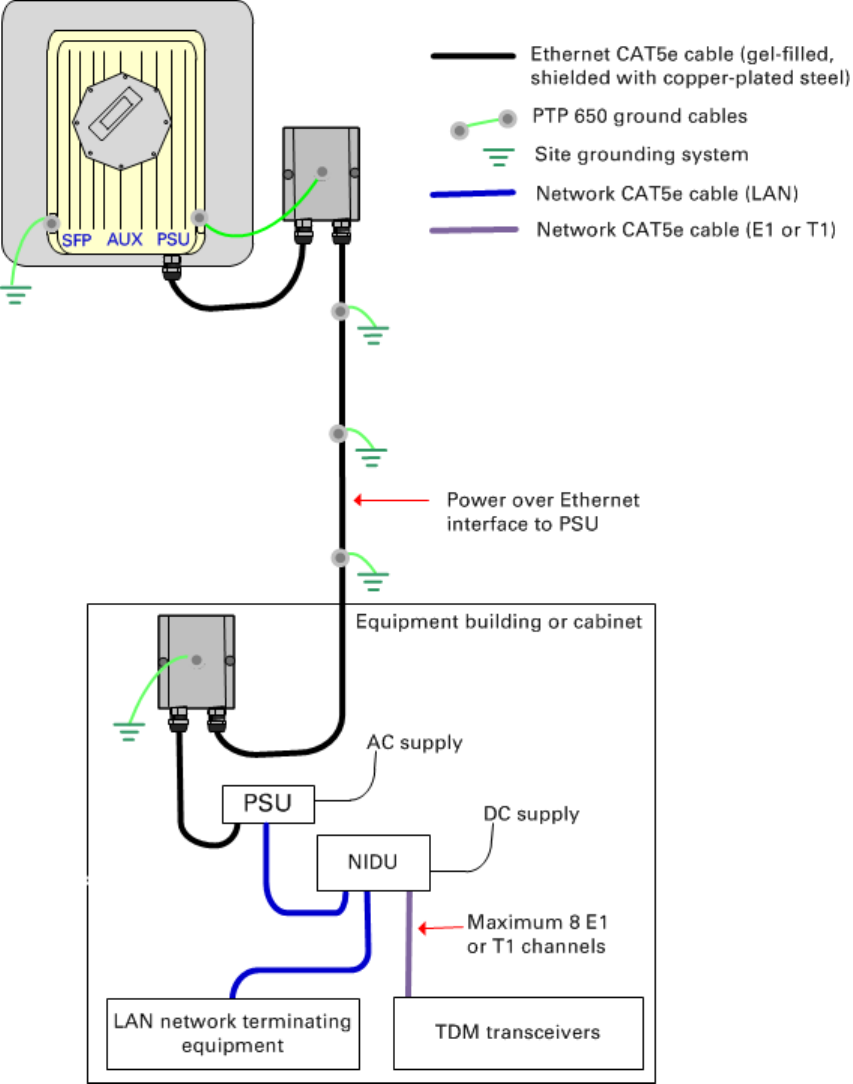Cambium Networks 50650 Wireless Ethernet Bridge User Manual PTP 650 Series User Guide
Cambium Networks Limited Wireless Ethernet Bridge PTP 650 Series User Guide
Contents
User Guide Part 1

F
Cambium
PTP 650 Series
User Guide
System Release 650-01-20
UNDER DEVELOPMENT
Accuracy
While reasonable efforts have been made to assure the accuracy of this document, Cambium Networks
assumes no liability resulting from any inaccuracies or omissions in this document, or from use of the
information obtained herein. Cambium reserves the right to make changes to any products described
herein to improve reliability, function, or design, and reserves the right to revise this document and to
make changes from time to time in content hereof with no obligation to notify any person of revisions
or changes. Cambium does not assume any liability arising out of the application or use of any
product, software, or circuit described herein; neither does it convey license under its patent rights or
the rights of others. It is possible that this publication may contain references to, or information about
Cambium products (machines and programs), programming, or services that are not announced in
your country. Such references or information must not be construed to mean that Cambium intends to
announce such Cambium products, programming, or services in your country.
Copyrights
This document, Cambium products, and 3rd Party software products described in this document may
include or describe copyrighted Cambium and other 3rd Party supplied computer programs stored in
semiconductor memories or other media. Laws in the United States and other countries preserve for
Cambium, its licensors, and other 3rd Party supplied software certain exclusive rights for copyrighted
material, including the exclusive right to copy, reproduce in any form, distribute and make derivative
works of the copyrighted material. Accordingly, any copyrighted material of Cambium, its licensors, or
the 3rd Party software supplied material contained in the Cambium products described in this
document may not be copied, reproduced, reverse engineered, distributed, merged or modified in any
manner without the express written permission of Cambium. Furthermore, the purchase of Cambium
products shall not be deemed to grant either directly or by implication, estoppel, or otherwise, any
license under the copyrights, patents or patent applications of Cambium or other 3rd Party supplied
software, except for the normal non-exclusive, royalty free license to use that arises by operation of
law in the sale of a product.
Restrictions
Software and documentation are copyrighted materials. Making unauthorized copies is prohibited by
law. No part of the software or documentation may be reproduced, transmitted, transcribed, stored in a
retrieval system, or translated into any language or computer language, in any form or by any means,
without prior written permission of Cambium.
License Agreements
The software described in this document is the property of Cambium and its licensors. It is furnished
by express license agreement only and may be used only in accordance with the terms of such an
agreement.
High Risk Materials
Cambium and its supplier(s) specifically disclaim any express or implied warranty of fitness for any
high risk activities or uses of its products including, but not limited to, the operation of nuclear
facilities, aircraft navigation or aircraft communication systems, air traffic control, life support, or
weapons systems (“High Risk Use”). Any High Risk is unauthorized, is made at your own risk and you
shall be responsible for any and all losses, damage or claims arising out of any High Risk Use.
© 2013 - 2014 Cambium Networks Limited. All Rights Reserved.
UNDER DEVELOPMENT
phn-3341_005v002 (July 2014)

Contents
About This User Guide .......................................................................................................................... 1
Contacting Cambium Networks .................................................................................................... 1
Purpose ........................................................................................................................................... 2
Cross references ............................................................................................................................. 2
Feedback ......................................................................................................................................... 2
Important regulatory information........................................................................................................ 3
Radar avoidance ............................................................................................................................. 3
USA and Canada specific information ......................................................................................... 3
Renseignements specifiques aux USA et au Canada ................................................................. 4
Specific expertise and training for professional installers ......................................................... 4
Avoidance of weather radars ........................................................................................................ 4
External antennas ........................................................................................................................... 4
Antennas externes ......................................................................................................................... 5
Ethernet networking skills ............................................................................................................. 5
Lightning protection ....................................................................................................................... 5
Training ........................................................................................................................................... 5
Problems and warranty ........................................................................................................................ 6
Reporting problems ....................................................................................................................... 6
Repair and service .......................................................................................................................... 6
Hardware warranty ........................................................................................................................ 6
Security advice ...................................................................................................................................... 7
Warnings, cautions, and notes ............................................................................................................ 8
Warnings ......................................................................................................................................... 8
Cautions .......................................................................................................................................... 8
Notes ............................................................................................................................................... 8
Caring for the environment .................................................................................................................. 9
In EU countries ............................................................................................................................... 9
In non-EU countries ....................................................................................................................... 9
Chapter 1:
Product description ....................................................................................................... 1-1
Overview of the PTP 650 Series ........................................................................................................ 1-2
Purpose ........................................................................................................................................ 1-2
Key features ................................................................................................................................. 1-2
Frequency bands ......................................................................................................................... 1-3
Typical bridge deployment ........................................................................................................ 1-4
Hardware overview ..................................................................................................................... 1-5
Wireless operation ............................................................................................................................. 1-6
Time division duplexing ............................................................................................................. 1-6
UNDER DEVELOPMENT
Page i
Contents
Link mode optimization .............................................................................................................. 1-8
Link symmetry ............................................................................................................................. 1-9
Licensed maximum link range (PTP 650S) ............................................................................. 1-10
OFDM and channel bandwidth ................................................................................................ 1-11
Spectrum management ............................................................................................................ 1-11
Adaptive modulation ................................................................................................................ 1-13
MIMO .......................................................................................................................................... 1-14
Dynamic spectrum optimization .............................................................................................. 1-15
Radar avoidance ........................................................................................................................ 1-15
Encryption .................................................................................................................................. 1-16
License keys and regulatory bands ......................................................................................... 1-17
PTP networks ............................................................................................................................. 1-18
TDD synchronization (PTP-SYNC) ........................................................................................... 1-19
Ethernet bridging ............................................................................................................................. 1-21
Ethernet ports ............................................................................................................................ 1-21
Customer data network ............................................................................................................ 1-22
Management network ............................................................................................................... 1-25
Ethernet loopback mode........................................................................................................... 1-27
Protocol model .......................................................................................................................... 1-28
Synchronous Ethernet .............................................................................................................. 1-29
IEEE 1588-2008 Transparent Clock .......................................................................................... 1-30
TDM bridging.................................................................................................................................... 1-32
TDM description ........................................................................................................................ 1-32
Lowest TDM modulation mode ............................................................................................... 1-33
Fixed frequency operation ....................................................................................................... 1-33
Ethernet cables for TDM ........................................................................................................... 1-34
Further reading .......................................................................................................................... 1-34
System management ....................................................................................................................... 1-35
Management agent ................................................................................................................... 1-35
Network management .............................................................................................................. 1-36
IPv6 ............................................................................................................................................. 1-38
Web server ................................................................................................................................. 1-39
RADIUS authentication ............................................................................................................. 1-42
SNMP.......................................................................................................................................... 1-42
Simple Network Time Protocol (SNTP) ................................................................................... 1-43
SNMPv3 security ....................................................................................................................... 1-44
System logging (syslog) ........................................................................................................... 1-47
AES license ................................................................................................................................ 1-47
Critical security parameters ..................................................................................................... 1-48
Software upgrade ...................................................................................................................... 1-49
Capability upgrades .................................................................................................................. 1-50
Full capability trial period ......................................................................................................... 1-50
Recovery mode .......................................................................................................................... 1-51
UNDER DEVELOPMENT
Page ii

Contents
Chapter 2:
System hardware .......................................................................................................... 2-1
Outdoor unit (ODU) ........................................................................................................................... 2-2
ODU description .......................................................................................................................... 2-2
PTP 650 Integrated or Connectorized ODU ............................................................................... 2-2
PTP 650S Integrated ODU .......................................................................................................... 2-6
PTP 650L Integrated ODU ........................................................................................................... 2-8
ODU capability upgrades............................................................................................................ 2-9
ODU accessories ....................................................................................................................... 2-10
ODU mounting brackets ........................................................................................................... 2-10
ODU interfaces .......................................................................................................................... 2-13
ODU specifications .................................................................................................................... 2-15
Power supply units (PSU) ................................................................................................................ 2-16
PSU description ......................................................................................................................... 2-16
PSU part numbers ..................................................................................................................... 2-17
AC Power Injector interfaces .................................................................................................... 2-17
AC+DC Enhanced Power Injector interfaces ........................................................................... 2-18
PSU specifications ..................................................................................................................... 2-19
Antennas and antenna cabling ....................................................................................................... 2-21
Antenna requirements .............................................................................................................. 2-21
RF cable and connectors........................................................................................................... 2-21
Antenna accessories ................................................................................................................. 2-22
FCC and IC approved antennas ................................................................................................ 2-22
Antennes approuvées par la FCC et IC .................................................................................... 2-23
Ethernet cabling ............................................................................................................................... 2-36
Ethernet standards and cable lengths ..................................................................................... 2-36
Outdoor copper Cat5e Ethernet cable ..................................................................................... 2-37
Cable grounding kit ................................................................................................................... 2-38
Lightning protection unit (LPU) and grounding kit ................................................................ 2-39
LPU single end kit ...................................................................................................................... 2-40
RJ45 connectors and spare glands .......................................................................................... 2-41
Cable hoisting grip .................................................................................................................... 2-42
Drop cable tester ....................................................................................................................... 2-42
Indoor Cat5e cable .................................................................................................................... 2-42
SFP module kits ......................................................................................................................... 2-43
Optical cable and connectors ................................................................................................... 2-45
PTP-SYNC unit .................................................................................................................................. 2-46
PTP-SYNC unit description ....................................................................................................... 2-46
PTP-SYNC part numbers .......................................................................................................... 2-47
PTP-SYNC unit interfaces ......................................................................................................... 2-48
PTP-SYNC specifications .......................................................................................................... 2-49
GPS receiver ..................................................................................................................................... 2-52
GPS receiver description .......................................................................................................... 2-52
GPS receiver part numbers ...................................................................................................... 2-53
UNDER DEVELOPMENT
Page iii
Contents
Twelve way circular connector ................................................................................................ 2-53
Network indoor unit (NIDU) ............................................................................................................ 2-54
NIDU description ....................................................................................................................... 2-54
NIDU part numbers ................................................................................................................... 2-55
NIDU interfaces ......................................................................................................................... 2-55
NIDU specifications ................................................................................................................... 2-56
Chapter 3:
System planning ........................................................................................................... 3-1
Typical deployment ........................................................................................................................... 3-2
ODU with POE interface to PSU ................................................................................................. 3-2
E1 or T1 interfaces ....................................................................................................................... 3-5
SFP and Aux Ethernet interfaces ............................................................................................... 3-6
GPS receiver interfaces............................................................................................................... 3-9
Site planning..................................................................................................................................... 3-11
Grounding and lightning protection ........................................................................................ 3-11
Lightning protection zones ....................................................................................................... 3-11
Site grounding system.............................................................................................................. 3-12
ODU and external antenna location ........................................................................................ 3-13
ODU ambient temperature limits ............................................................................................ 3-13
ODU wind loading ..................................................................................................................... 3-14
PSU DC power supply............................................................................................................... 3-15
PSU location .............................................................................................................................. 3-15
PTP-SYNC location .................................................................................................................... 3-15
GPS receiver location................................................................................................................ 3-16
NIDU location ............................................................................................................................ 3-17
Drop cable grounding points ................................................................................................... 3-17
LPU location ............................................................................................................................... 3-18
Multiple LPUs ............................................................................................................................ 3-18
Radio spectrum planning ................................................................................................................ 3-21
General wireless specifications ............................................................................................... 3-21
Regulatory limits ....................................................................................................................... 3-22
Conforming to the limits........................................................................................................... 3-22
Available spectrum ................................................................................................................... 3-23
Channel bandwidth ................................................................................................................... 3-23
Frequency selection .................................................................................................................. 3-23
Avoidance of weather radars (USA only) ............................................................................... 3-24
Link planning .................................................................................................................................... 3-25
PTP LINKPlanner ....................................................................................................................... 3-25
Range and obstacles ................................................................................................................. 3-25
PTP LINKPlanner for synchronized networks ......................................................................... 3-26
Path loss ..................................................................................................................................... 3-26
Adaptive modulation ................................................................................................................ 3-26
Calculating data rate capacity .................................................................................................. 3-27
Planning for connectorized units .................................................................................................... 3-29
UNDER DEVELOPMENT
Page iv
Contents
When to install connectorized units ........................................................................................ 3-29
Choosing external antennas .................................................................................................... 3-29
Calculating RF cable length (5.8 GHz FCC only) ..................................................................... 3-30
Configuration options for TDD synchronization ........................................................................... 3-31
Single link configuration with PTP-SYNC ............................................................................... 3-32
Cluster with PTP-SYNC and GPS receiver .............................................................................. 3-33
Cluster with PTP-SYNC and no GPS receiver ......................................................................... 3-34
Data network planning .................................................................................................................... 3-35
Ethernet interfaces .................................................................................................................... 3-35
Layer two control protocols ..................................................................................................... 3-35
Ethernet port allocation ............................................................................................................ 3-36
VLAN membership .................................................................................................................... 3-42
Priority for management traffic ............................................................................................... 3-43
IP interface ................................................................................................................................. 3-43
Quality of service for bridged Ethernet traffic ........................................................................ 3-43
“Daisy-chaining” PTP 650 links ............................................................................................... 3-44
Green Ethernet switches........................................................................................................... 3-45
TDM network planning .................................................................................................................... 3-46
Network management planning ..................................................................................................... 3-47
Planning for SNMP operation .................................................................................................. 3-47
Supported diagnostic alarms ................................................................................................... 3-48
Enabling SNMP ......................................................................................................................... 3-48
Security planning ............................................................................................................................. 3-49
Planning for SNTP operation ................................................................................................... 3-49
Planning for HTTPS/TLS operation .......................................................................................... 3-49
Planning for SNMPv3 operation .............................................................................................. 3-51
Planning for RADIUS operation ............................................................................................... 3-55
System threshold, output power and link loss .............................................................................. 3-57
Data throughput capacity tables ..................................................................................................... 3-68
TDM traffic load ....................................................................................................................... 3-112
Chapter 4:
Legal and regulatory information ................................................................................ 4-1
Cambium Networks end user license agreement ........................................................................... 4-2
Acceptance of this agreement ................................................................................................... 4-2
Definitions .................................................................................................................................... 4-2
Grant of license ........................................................................................................................... 4-2
Conditions of use ........................................................................................................................ 4-3
Title and restrictions ................................................................................................................... 4-4
Confidentiality ............................................................................................................................. 4-4
Right to use Cambium’s name ................................................................................................... 4-5
Transfer ........................................................................................................................................ 4-5
Updates ........................................................................................................................................ 4-5
Maintenance ................................................................................................................................ 4-5
Disclaimer .................................................................................................................................... 4-6
UNDER DEVELOPMENT
Page v
Contents
Limitation of liability ................................................................................................................... 4-6
U.S. government ......................................................................................................................... 4-6
Term of license ............................................................................................................................ 4-7
Governing law ............................................................................................................................. 4-7
Assignment .................................................................................................................................. 4-7
Survival of provisions ................................................................................................................. 4-7
Entire agreement ......................................................................................................................... 4-7
Third party software .................................................................................................................... 4-7
Compliance with safety standards ................................................................................................. 4-22
Electrical safety compliance ..................................................................................................... 4-22
Electromagnetic compatibility (EMC) compliance ................................................................. 4-22
Human exposure to radio frequency energy .......................................................................... 4-23
Compliance with radio regulations ................................................................................................ 4-27
Type approvals .......................................................................................................................... 4-28
FCC/IC compliance .................................................................................................................... 4-29
European Union compliance .................................................................................................... 4-38
Chapter 5:
Installation .................................................................................................................... 5-1
Safety .................................................................................................................................................. 5-2
Power lines .................................................................................................................................. 5-2
Working at heights ...................................................................................................................... 5-2
PSU ............................................................................................................................................... 5-2
Grounding and protective earth ................................................................................................ 5-2
DC supply ..................................................................................................................................... 5-3
Powering down before servicing ............................................................................................... 5-3
Primary disconnect device ......................................................................................................... 5-3
External cables ............................................................................................................................ 5-3
Drop cable tester ......................................................................................................................... 5-3
Grounding PTP-SYNC ................................................................................................................. 5-3
RF exposure near the antenna ................................................................................................... 5-4
Minimum separation distances ................................................................................................. 5-4
Grounding and lightning protection requirements .................................................................. 5-4
Grounding cable installation methods ...................................................................................... 5-4
Siting ODUs and antennas ......................................................................................................... 5-4
Thermal Safety ............................................................................................................................ 5-5
ODU variants and mounting bracket options .................................................................................. 5-6
Installing the ODU and top LPU ........................................................................................................ 5-7
Attach ground cables to the ODU .............................................................................................. 5-7
Mount the ODU on the mast ...................................................................................................... 5-7
Mount the top LPU .................................................................................................................... 5-14
Interconnect and ground the ODU and top LPU .................................................................... 5-14
Install external antennas for a connectorized ODU ...................................................................... 5-16
Installing the copper Cat5e Ethernet interface .............................................................................. 5-18
Install the ODU to top LPU drop cable .................................................................................... 5-18
UNDER DEVELOPMENT
Page vi
Contents
Install the main drop cable ....................................................................................................... 5-20
Install the bottom LPU to PSU drop cable .............................................................................. 5-23
Test resistance in the drop cable ............................................................................................. 5-25
Installing the PSU ............................................................................................................................. 5-26
Installing the AC Power Injector .............................................................................................. 5-26
Installing the AC+DC Enhanced Power Injector ..................................................................... 5-27
Installing a PTP-SYNC unit .............................................................................................................. 5-28
Mounting the PTP-SYNC unit ................................................................................................... 5-28
Connecting up the PTP-SYNC unit .......................................................................................... 5-29
Powering up the PTP-SYNC installation ................................................................................. 5-31
Installing a GPS receiver ................................................................................................................. 5-32
Mounting the GPS receiver ...................................................................................................... 5-32
Preparing the GPS drop cable .................................................................................................. 5-32
Assembling an RJ45 plug and housing for GPS .................................................................... 5-33
Assembling a 12 way circular connector ................................................................................ 5-35
Connecting the GPS drop cable ............................................................................................... 5-39
Top grounding point for GPS adapter cable........................................................................... 5-40
Installing and connecting the GPS LPU .................................................................................. 5-41
Installing a NIDU .............................................................................................................................. 5-42
Mounting the NIDU ................................................................................................................... 5-42
Connecting the NIDU to the PSU, LAN and TDM cables ....................................................... 5-43
Connecting the NIDU to a DC power supply .......................................................................... 5-45
Installing an SFP Ethernet interface ............................................................................................... 5-48
Fitting the long cable gland ...................................................................................................... 5-50
Inserting the SFP module ......................................................................................................... 5-51
Connecting the cable ................................................................................................................ 5-53
Fitting the gland ........................................................................................................................ 5-54
Removing the cable and SFP module ..................................................................................... 5-56
Installing an Aux Ethernet interface ............................................................................................... 5-57
Supplemental installation information .......................................................................................... 5-58
Stripping drop cable ................................................................................................................. 5-58
Creating a drop cable grounding point ................................................................................... 5-59
Weatherproofing an N type connector .................................................................................... 5-62
Replacing PSU fuses ................................................................................................................. 5-65
Chapter 6:
Configuration and alignment ....................................................................................... 6-1
Preparing for configuration and alignment ..................................................................................... 6-2
Safety precautions ...................................................................................................................... 6-2
Regulatory compliance ............................................................................................................... 6-2
Selecting configuration options ................................................................................................. 6-3
Generating license keys .............................................................................................................. 6-3
Connecting to the unit ....................................................................................................................... 6-4
Configuring the management PC .............................................................................................. 6-4
Connecting to the PC and powering up .................................................................................... 6-5
UNDER DEVELOPMENT
Page vii
Contents
Using the web interface ..................................................................................................................... 6-6
Logging into the web interface .................................................................................................. 6-6
Using the menu options ............................................................................................................. 6-7
Installation menu ............................................................................................................................... 6-9
Starting the Installation Wizard ................................................................................................. 6-9
Disarm Installation page ........................................................................................................... 6-10
Current Installation Summary page ........................................................................................ 6-10
Software License Key page ...................................................................................................... 6-11
Interface Configuration page ................................................................................................... 6-14
Wireless Configuration page .................................................................................................... 6-22
TDD synchronization page (optional) ...................................................................................... 6-28
Confirm Installation Configuration page ................................................................................. 6-30
System menu.................................................................................................................................... 6-31
System Configuration page ..................................................................................................... 6-31
LAN Configuration page ........................................................................................................... 6-35
QoS Configuration page ........................................................................................................... 6-43
SFP Configuration page ............................................................................................................ 6-46
TDM Configuration page .......................................................................................................... 6-48
Save and Restore Configuration page .................................................................................... 6-50
Software Upgrade page............................................................................................................ 6-52
Management menu .......................................................................................................................... 6-54
Web-Based Management page ................................................................................................ 6-54
Local User Accounts page ........................................................................................................ 6-57
RADIUS Configuration page .................................................................................................... 6-62
Webpage Properties page ........................................................................................................ 6-64
Email Configuration page ......................................................................................................... 6-67
Diagnostic Alarms page............................................................................................................ 6-69
Time Configuration page .......................................................................................................... 6-70
Syslog Configuration page ....................................................................................................... 6-74
SNMP pages (for SNMPv3) ............................................................................................................. 6-76
Current SNMP Summary (for SNMPv3) .................................................................................. 6-76
Step 1: SNMP Configuration (for SNMPv3) ............................................................................ 6-77
Step 2: SNMP MIB-II System Objects (for SNMPv3) .............................................................. 6-79
Step 3: SNMP User Policy Configuration (for SNMPv3) ........................................................ 6-80
Step 4: SNMP User Accounts Configuration (for SNMPv3) .................................................. 6-82
Step 5: SNMP Trap Configuration (for SNMPv3) ................................................................... 6-84
Confirm SNMP Configuration (for SNMPv3) .......................................................................... 6-85
SNMP pages (for SNMPv1/2c) ........................................................................................................ 6-86
Current SNMP Summary (for SNMPv1/2c) ............................................................................. 6-86
Step 1: SNMP Configuration (for SNMPv1/2c) ....................................................................... 6-86
Step 2: SNMP MIB-II System Objects (for SNMPv1/2c) ......................................................... 6-87
Step 3: SNMP Trap Configuration (for SNMPv1/2c) .............................................................. 6-88
Confirm SNMP Configuration (for SNMPv1/2c) ..................................................................... 6-89
UNDER DEVELOPMENT
Page viii
Contents
Security menu .................................................................................................................................. 6-90
Preparing for HTTPS/TLS.......................................................................................................... 6-90
Security Configuration Wizard page ....................................................................................... 6-91
Step 1: Enter Key of Keys ......................................................................................................... 6-92
Step 2: Enter TLS Private Key and Public Certificate ............................................................. 6-93
Step 3: Enter User Security Banner ......................................................................................... 6-94
Step 4: Enter Login Information Settings................................................................................ 6-95
Step 5: Enter Random Number Entropy Input ....................................................................... 6-96
Step 6: Enter Wireless Link Encryption Key ............................................................................ 6-97
Step 7: Enter HTTP and Telnet Settings .................................................................................. 6-98
Step 8: Commit Security Configuration ................................................................................ 6-100
Zeroize CSPs page ................................................................................................................... 6-101
Aligning antennas .......................................................................................................................... 6-102
Starting up the units ............................................................................................................... 6-102
Checking that the units are armed ......................................................................................... 6-102
Aligning antennas ................................................................................................................... 6-103
Aligning separate antennas for spatial diversity .................................................................. 6-104
ODU installation tones ............................................................................................................ 6-105
Graphical Install page ............................................................................................................. 6-107
Disarming the units ................................................................................................................. 6-108
Comparing actual to predicted performance ....................................................................... 6-109
Other configuration tasks .............................................................................................................. 6-110
Connecting to the network ..................................................................................................... 6-110
Upgrading software using TFTP ............................................................................................ 6-111
Chapter 7:
Operation ...................................................................................................................... 7-1
System summary and status ............................................................................................................ 7-2
System Summary page .............................................................................................................. 7-2
System Status page .................................................................................................................... 7-3
Rebooting and logging out ............................................................................................................. 7-15
Login Information page ............................................................................................................ 7-15
Reboot Wireless Unit page ....................................................................................................... 7-15
Change Password page ............................................................................................................ 7-16
Logging out ................................................................................................................................ 7-16
Alarms, alerts and messages .......................................................................................................... 7-17
Alarms ........................................................................................................................................ 7-17
Email alerts ................................................................................................................................ 7-21
Syslog page ............................................................................................................................... 7-21
Format of syslog server messages .......................................................................................... 7-22
Configuration and status messages ........................................................................................ 7-23
Event messages ......................................................................................................................... 7-23
Spectrum management ................................................................................................................... 7-25
Spectrum Expert and Spectrum Management pages ........................................................... 7-25
Spectrum Expert page .............................................................................................................. 7-26
UNDER DEVELOPMENT
Page ix
Contents
Spectrum Management page .................................................................................................. 7-30
Spectrum Management Settings ............................................................................................. 7-32
Interpreting the receive spectrum plot .................................................................................... 7-34
Barring channels ....................................................................................................................... 7-39
Selecting a Channel and a Time period .................................................................................. 7-40
Interpreting the timeseries plot ............................................................................................... 7-41
Interpreting the Interference Waterfall plot ............................................................................ 7-42
Interpreting the histogram plot ................................................................................................ 7-44
System statistics .............................................................................................................................. 7-45
System Statistics page.............................................................................................................. 7-45
Wireless Port Counters page .................................................................................................... 7-50
Main Port Counters page .......................................................................................................... 7-51
Aux Port Counters page............................................................................................................ 7-53
SFP Port Counters page ............................................................................................................ 7-54
SyncE Status page .................................................................................................................... 7-55
Diagnostics Plotter page ........................................................................................................... 7-58
Generate Downloadable Diagnostics page............................................................................. 7-59
Recovery mode ................................................................................................................................ 7-60
Entering recovery mode ........................................................................................................... 7-60
Upgrading software image....................................................................................................... 7-62
Resetting IP & Ethernet configuration ..................................................................................... 7-63
Erasing configuration ................................................................................................................ 7-64
Zeroize Critical Security Parameters page .............................................................................. 7-66
Rebooting the unit ..................................................................................................................... 7-67
Chapter 8:
Troubleshooting ........................................................................................................... 8-1
Testing link end hardware ................................................................................................................. 8-2
AC Power Injector LED sequence .............................................................................................. 8-2
AC+DC Enhanced power injector LED sequence ..................................................................... 8-2
Ethernet packet test ..................................................................................................................... 8-5
Testing the radio link ......................................................................................................................... 8-8
No activity .................................................................................................................................... 8-8
Some activity ............................................................................................................................... 8-8
Radio and television interference .............................................................................................. 8-9
Testing PTP-SYNC ............................................................................................................................ 8-10
Checking the PTP-SYNC LEDs .................................................................................................. 8-10
LEDs do not illuminate.............................................................................................................. 8-11
STATUS LED is on steady ........................................................................................................ 8-11
STATUS LED double-blinks ...................................................................................................... 8-11
ODU LED does not illuminate within 90 seconds .................................................................. 8-11
ODU LED blinks red ................................................................................................................... 8-11
GPS LED does not illuminate or blink on clustered units ...................................................... 8-12
Testing a TDM link ........................................................................................................................... 8-13
Checking the NIDU LEDs .......................................................................................................... 8-13
UNDER DEVELOPMENT
Page x
Contents
Performing a TDM loopback test ............................................................................................. 8-14
Checking for 1000BASE-T operation ....................................................................................... 8-14
Glossary .................................................................................................................................................. I
UNDER DEVELOPMENT
Page xi

About This User Guide
This guide describes the planning, installation, configuration and operation of the Cambium
PTP 650 Series of point-to-point wireless Ethernet bridges. It is intended for use by the system
designer, system installer and system administrator.
For radio network design, refer to the following chapters:
• Chapter 1: Product description
• Chapter 2: System hardware
• Chapter 3: System planning
• Chapter 4: Legal and regulatory information
For radio equipment installation, refer to the following chapter:
• Chapter 5: Installation
For system configuration, monitoring and fault-finding, refer to the following chapters:
• Chapter 6: Configuration and alignment
• Chapter 7: Operation
• Chapter 8: Troubleshooting
Contacting Cambium Networks
Support website: http://www.cambiumnetworks.com/support
Main website: http://www.cambiumnetworks.com
Sales enquiries: solutions@cambiumnetworks.com
Support enquiries: support@cambiumnetworks.com
Telephone number list: http://www.cambiumnetworks.com/contact
Address: Cambium Networks Limited,
Linhay Business Park,
Eastern Road,
Ashburton,
Devon, UK,
TQ13 7UP
UNDER DEVELOPMENT
Page 1

About This User Guide Important regulatory information
Purpose
Cambium Networks Point-To-Point (PTP) documents are intended to instruct and assist personnel
in the operation, installation and maintenance of the Cambium PTP equipment and ancillary
devices. It is recommended that all personnel engaged in such activities be properly trained.
Cambium disclaims all liability whatsoever, implied or express, for any risk of damage, loss or
reduction in system performance arising directly or indirectly out of the failure of the customer, or
anyone acting on the customer's behalf, to abide by the instructions, system parameters, or
recommendations made in this document.
Cross references
References to external publications are shown in italics. Other cross references, emphasized in
blue text in electronic versions, are active links to the references.
This document is divided into numbered chapters that are divided into sections. Sections are not
numbered, but are individually named at the top of each page, and are listed in the table of
contents.
Feedback
We appreciate feedback from the users of our documents. This includes feedback on the structure,
content, accuracy, or completeness of our documents. Send feedback to
support@cambiumnetworks.com.
UNDER DEVELOPMENT
Page 2

About This User Guide Important regulatory information
Important regulatory information
The PTP 650 product is certified as an unlicensed device in frequency bands where it is not allowed
to cause interference to licensed services (called primary users of the bands).
Radar avoidance
In countries where radar systems are the primary band users, the regulators have mandated
special requirements to protect these systems from interference caused by unlicensed devices.
Unlicensed devices must detect and avoid co-channel operation with radar systems.
The PTP 650 provides detect and avoid functionality for countries and frequency bands requiring
protection for radar systems.
Installers and users must meet all local regulatory requirements for radar detection. To meet these
requirements, users must install a license key for the correct country during commissioning of the
PTP 650. If this is not done, installers and users may be liable to civil and criminal penalties.
Contact the Cambium helpdesk if more guidance is required.
USA and Canada specific information
The USA Federal Communications Commission (FCC) has asked manufacturers to implement
special features to prevent interference to weather radar systems that operate in the band 5600
MHz to 5650 MHz. These features must be implemented in all products able to operate outdoors in
the band 5470 MHz to 5725 MHz.
Manufacturers must ensure that such radio products cannot be configured to operate outside of
FCC rules; specifically it must not be possible to disable or modify the radar protection functions
that have been demonstrated to the FCC.
In order to comply with these FCC requirements, Cambium supplies variants of the PTP 650 for
operation in the USA or Canada. These variants are only allowed to operate with license keys that
comply with FCC/IC rules. In particular, operation of radio channels overlapping the band
5600-5650 MHz is not allowed and these channels are permanently barred.
In addition, other channels may also need to be barred when operating close to weather radar
installations.
To ensure compliance with FCC rules (KDB 443999: Interim Plans to Approve UNII Devices
Operating in the 5470 - 5725 MHz Band with Radar Detection and DFS Capabilities), follow
Avoidance of weather radars (USA only) on page 3-24.
Other variants of the PTP 650 are available for use in the rest of the world, but these variants are
not supplied to the USA or Canada except under strict controls, when they are needed for export
and deployment outside the USA or Canada.
UNDER DEVELOPMENT
Page 3
About This User Guide Important regulatory information
Renseignements specifiques aux USA et au Canada
La Commission Fédérale des Communications des Etats-Unis (FCC) a demandé aux fabricants de
mettre en œuvre des mécanismes spécifiques pour éviter d’interférer avec des systèmes radar
fonctionnant dans la bande 5600 MHz à 5650 MHz. Ces mécanismes doivent être mis en œuvre
dans tous les produits capables de fonctionner à l'extérieur dans la bande 5470 MHz à 5725 MHz.
Les fabricants doivent s'assurer que les produits de radiocommunications ne peuvent pas être
configurés pour fonctionner en dehors des règles de la FCC, en particulier, il ne doit pas être
possible de désactiver ou modifier les fonctions de protection des radars qui ont été démontrés de
la FCC.
Afin de se conformer à ces exigences de la FCC, Cambium fournit des variantes du PTP 650
exclusivement pour les Etats-Unis ou au Canada. Ces variantes sont autorisés à fonctionner avec
des clés de licence qui sont conformes aux règles de la FCC / IC. En particulier, le fonctionnement
des canaux de radio qui chevauchent la bande 5600-5650 MHz est interdite et ces canaux sont
définitivement exclus.
Specific expertise and training for professional installers
To ensure that the PTP 650 is installed and configured in compliance with the requirements of
Industry Canada and the FCC, installers must have the radio engineering skills and training
described in this section. This is particularly important when installing and configuring a PTP 650
system for operation in the 5.1 GHz and 5.4 GHz UNII bands.
Avoidance of weather radars
The installer must be familiar with the requirements in FCC KDB 443999. Essentially, the installer
must be able to:
• Access the FCC data base of weather radar location and channel frequencies.
• Use this information to correctly configure the product (using the GUI) to avoid operation on
channels that should be barred according to the guidelines that are contained in the KDB and
explained in detail in this user guide.
External antennas
When using a connectorized version of the product (as compared to the version with an integrated
antenna), the conducted transmit power may need to be reduced to ensure the regulatory limit on
transmitter EIRP is not exceeded. The installer must have an understanding of how to compute
the effective antenna gain from the actual antenna gain and the feeder cable losses.
UNDER DEVELOPMENT
Page 4
About This User Guide Important regulatory information
The range of permissible values for maximum antenna gain and feeder cable losses are included
in this user guide together with a sample calculation. The product GUI automatically applies the
correct conducted power limit to ensure that it is not possible for the installation to exceed the
EIRP limit, when the appropriate values for antenna gain and feeder cable losses are entered into
the GUI.
Antennas externes
Lorsque vous utilisez une version du produit sans antenne intégrée, il peut être nécessaire de
réduire la puissance d'émission pour garantir que la limite réglementaire de puissance isotrope
rayonnée équivalente (PIRE) n'est pas dépassée. L'installateur doit avoir une bonne
compréhension de la façon de calculer le gain de l'antenne de gain de l'antenne réelle et les pertes
dans les câbles de connections.
La plage de valeurs admissibles pour un gain maximal de l'antenne et des pertes de câbles de
connections sont inclus dans ce guide d'utilisation avec un exemple de calcul. L'interface
utilisateur du produit applique automatiquement la limite de puissance menée correct afin de
s'assurer qu'il ne soit pas possible pour l'installation de dépasser la limite PIRE, lorsque les valeurs
appropriées pour le gain d'antenne et les pertes de câbles d'alimentation sont entrées dans
l’interface utilisateur.
Ethernet networking skills
The installer must have the ability to configure IP addressing on a PC and to set up and control
products using a web browser interface.
Lightning protection
To protect outdoor radio installations from the impact of lightning strikes, the installer must be
familiar with the normal procedures for site selection, bonding and grounding. Installation
guidelines for the PTP 650 can be found in Chapter 2: System hardware and Chapter 5: Installation.
Training
The installer needs to have basic competence in radio and IP network installation. The specific
requirements applicable to the PTP 650 should be gained by reading Chapter 5: Installation and
Chapter 6: Configuration and alignment and by performing sample set ups at base workshop
before live deployments.
UNDER DEVELOPMENT
Page 5

About This User Guide Problems and warranty
Problems and warranty
Reporting problems
If any problems are encountered when installing or operating this equipment, follow this
procedure to investigate and report:
1
Search this document and the software release notes of supported releases.
2
Visit the support website.
3
Ask for assistance from the Cambium product supplier.
4
Gather information from affected units, such as any available diagnostic downloads.
5
Escalate the problem by emailing or telephoning support.
Repair and service
If unit failure is suspected, obtain details of the Return Material Authorization (RMA) process from
the support website.
Hardware warranty
Cambium’s standard hardware warranty is for one (1) year from date of shipment from Cambium
Networks or a Cambium distributor. Cambium Networks warrants that hardware will conform to
the relevant published specifications and will be free from material defects in material and
workmanship under normal use and service. Cambium shall within this time, at its own option,
either repair or replace the defective product within thirty (30) days of receipt of the defective
product. Repaired or replaced product will be subject to the original warranty period but not less
than thirty (30) days.
To register PTP products or activate warranties, visit the support website. For warranty assistance,
contact the reseller or distributor.
Caution
Using non-Cambium parts for repair could damage the equipment or void warranty.
Contact Cambium for service and repair instructions.
Portions of Cambium equipment may be damaged from exposure to electrostatic
discharge. Use precautions to prevent damage.
UNDER DEVELOPMENT
Page 6

About This User Guide Security advice
Security advice
Cambium Networks systems and equipment provide security parameters that can be configured
by the operator based on their particular operating environment. Cambium recommends setting
and using these parameters following industry recognized security practices. Security aspects to
be considered are protecting the confidentiality, integrity, and availability of information and
assets. Assets include the ability to communicate, information about the nature of the
communications, and information about the parties involved.
In certain instances Cambium makes specific recommendations regarding security practices,
however the implementation of these recommendations and final responsibility for the security of
the system lies with the operator of the system.
UNDER DEVELOPMENT
Page 7
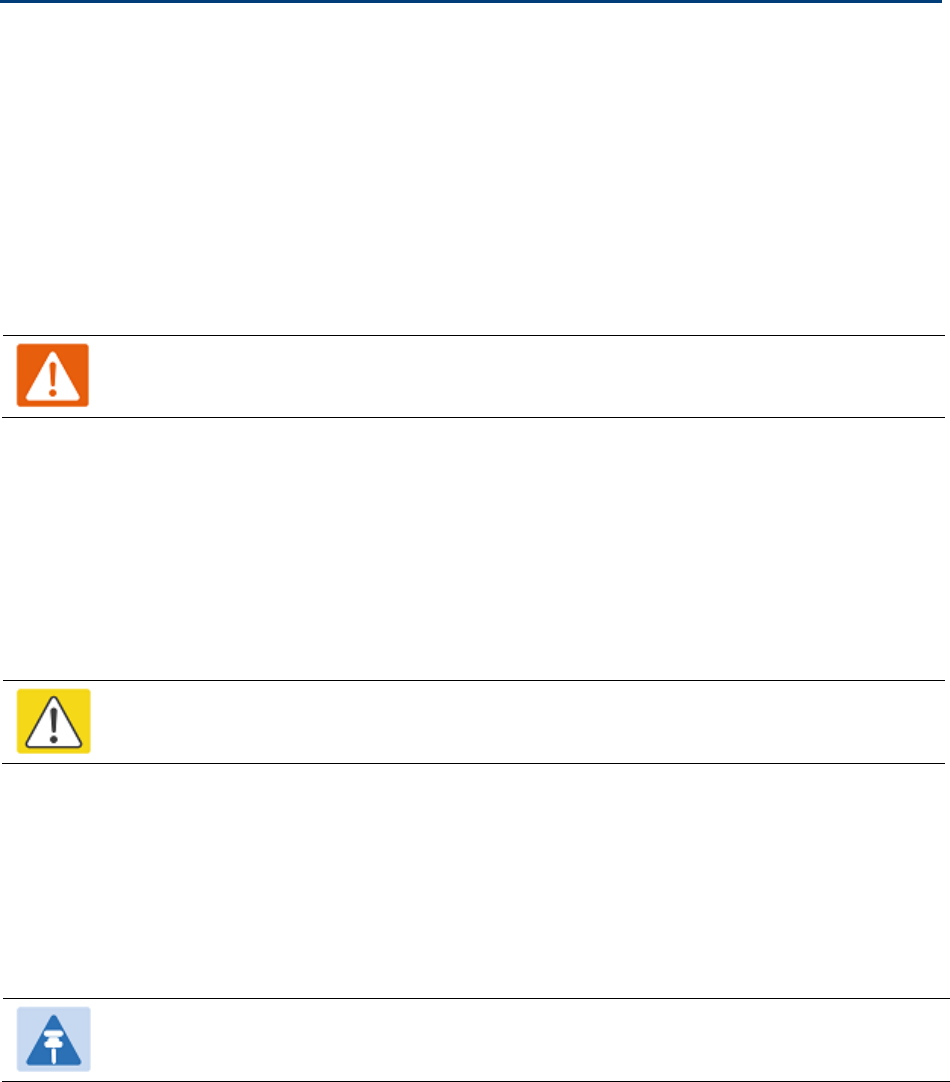
About This User Guide Warnings, cautions, and notes
Warnings, cautions, and notes
The following describes how warnings and cautions are used in this document and in all
documents of the Cambium Networks document set.
Warnings
Warnings precede instructions that contain potentially hazardous situations. Warnings are used to
alert the reader to possible hazards that could cause loss of life or physical injury. A warning has
the following format:
Warning
Warning text and consequence for not following the instructions in the warning.
Cautions
Cautions precede instructions and are used when there is a possibility of damage to systems,
software, or individual items of equipment within a system. However, this damage presents no
danger to personnel. A caution has the following format:
Caution
Caution text and consequence for not following the instructions in the caution.
Notes
A note means that there is a possibility of an undesirable situation or provides additional
information to help the reader understand a topic or concept. A note has the following format:
Note
Note text.
UNDER DEVELOPMENT
Page 8

About This User Guide Caring for the environment
Caring for the environment
The following information describes national or regional requirements for the disposal of
Cambium Networks supplied equipment and for the approved disposal of surplus packaging.
In EU countries
The following information is provided to enable regulatory compliance with the European Union
(EU) directives identified and any amendments made to these directives when using Cambium
equipment in EU countries.
Disposal of Cambium equipment
European Union (EU) Directive 2002/96/EC Waste Electrical and Electronic Equipment (WEEE)
Do not dispose of Cambium equipment in landfill sites. For disposal instructions, refer to
http://www.cambiumnetworks.com/support/weee-compliance
Disposal of surplus packaging
Do not dispose of surplus packaging in landfill sites. In the EU, it is the individual recipient’s
responsibility to ensure that packaging materials are collected and recycled according to the
requirements of EU environmental law.
In non-EU countries
In non-EU countries, dispose of Cambium equipment and all surplus packaging in accordance with
national and regional regulations.
UNDER DEVELOPMENT
Page 9

Chapter 1: Product description
This chapter provides a high level description of products in the PTP 650 series. It describes in
general terms the function of the product, the main product variants and the main hardware
components. The following topics are described in this chapter:
• Overview of the PTP 650 Series on page 1-2 introduces the key features, typical uses, product
variants and components of the PTP 650 series.
• Wireless operation on page 1-6 describes how the PTP 650 wireless link is operated, including
modulation modes, power control and spectrum management.
• Ethernet bridging on page 1-21 describes how the PTP 650 controls Ethernet data, in both the
customer data and system management networks.
• TDM bridging on page 1-32 describes how TDM traffic (E1 or T1) may be carried over PTP 650
links.
• System management on page 1-35 introduces the PTP 650 management system, including the
web interface, installation, configuration, security, alerts and upgrades.
UNDER DEVELOPMENT
Page 1-1

Chapter 1: Product description Overview of the PTP 650 Series
Overview of the PTP 650 Series
This section introduces the key features, typical uses, product variants and components of the
PTP 650 series.
Purpose
Cambium PTP 650 Series Bridge products are designed for Ethernet bridging over point-to-point
microwave links in unlicensed and lightly-licensed frequency bands between 4.9 GHz and 6.0 GHz.
Users must ensure that the PTP 650 Series complies with local operating regulations.
The PTP 650 Series
acts as a transparent bridge between two segments of the operator’s network.
In this sense, it can be treated as a virtual wired connection between two points. The PTP 650
Series
forwards 802.3 Ethernet frames destined for the other part of the network and filters frames
it does not need to forward. The system is transparent to higher-level protocols such as VLANs
and Spanning Tree.
Key features
The PTP 650 is a high performance wireless bridge for Ethernet traffic with a maximum throughput
of 450 Mbps. It is capable of operating in line-of-sight (LOS), near-LOS and non-LOS propagation
condition. Its maximum LOS range is 200 km. The PTP 650 operates in unlicensed and lightly-
licensed frequency bands between 4.9 and 6.0 GHz. It has a very high spectral efficiency of
10 bps/Hz and supports a channel bandwidth of up to 45 MHz. The PTP 650 Integrated ODU has its
own flat plate antenna with antenna gain 23 dBi. The PTP 650S and PTP 650L Integrated ODUs
have their own flat plate antenna with 19 dBi antenna gain. The PTP 650 Connectorized ODU is
designed for use with an external antenna.
The wireless link is TDD based and supports both symmetric and asymmetric TDD configurations.
From an Ethernet point-of-view, the PTP 650 wireless link is a transparent Layer 2 bridge. It
supports up to three Gigabit Ethernet ports. Two ports support twisted pair Gigabit Ethernet. One
of them is capable of providing power via standard 802.3at PoE to an external device such as a
video surveillance camera or a wireless access point. The third port accepts either a twisted pair or
fibre GE SFP module.
The PTP 650 Series supports an optional TDM adaptor that allows E1 or T1 telecoms circuits to be
bridged over the wireless link.
The PTP 650 Series has extensive quality of service (QoS) classification capability and supports up
to eight levels of queues. Management of the unit may be via the same interface as the bridged
traffic (in-band management) or on a separate port (out-of-band local or remote management).
PTP 650 and PTP 650S support both synchronous Ethernet and operation as an IEEE 1588-2008
transparent clock.
Table 1 gives a summary of the main PTP 650 characteristics.
UNDER DEVELOPMENT
Page 1-2

Chapter 1: Product description Overview of the PTP 650 Series
Table 1
Main characteristics of the
PTP 650 Series
Characteristic
Value
Topology PTP
Wireless link condition LOS, near LOS or non-LOS
Range Up to 200 km
Duplexing TDD (symmetric and asymmetric)
Connectivity Ethernet
Synchronous Ethernet ITU-T G.8262/Y.1362 EEC-Option 1 and EEC-Option 2
Transparent clock IEEE 1588-2008 compliant
Operating frequencies 4.9 to 6.0 GHz
Channel bandwidth 5, 10, 15, 20, 30, 40 or 45 MHz
High spectral efficiency Up to 10 bps/Hz
Data rate Up to 450 Mbps (45 MHz channel BW)
Telecommunications (TDM) Up to eight E1 or T1 circuits (NIDU required)
Frequency bands
The PTP 650 ODU can be configured by the user to operate in the following bands:
• 4.9 GHz band: 4940 to 4990 MHz
• 5.1 GHz band: 5150 to 5250 MHz
• 5.2 GHz band: 5250 to 5350 MHz
• 5.4 GHz band: 5470 to 5725 MHz
• 5.8 GHz band: 5725 to 5875 MHz
UNDER DEVELOPMENT
Page 1-3
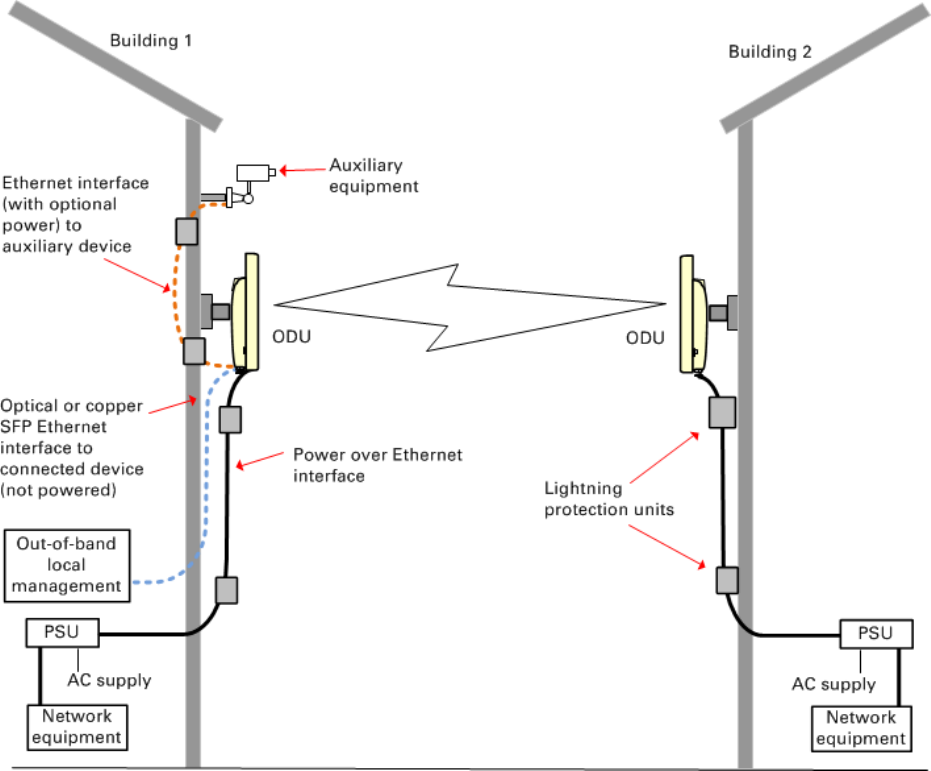
Chapter 1: Product description Overview of the PTP 650 Series
Typical bridge deployment
The PTP 650 is an “all outdoor” solution consisting of a wireless bridge between two sites. Each
site installation consists of a PTP 650 Integrated, PTP 650S Integrated, PTP 650L Integrated or
PTP 650 Connectorized outdoor unit (ODU) and a power injector (PSU) (Figure 1). The ODU
provides the following interfaces:
• PSU port: This provides proprietary power over Ethernet and connection to the management
and/or data networks via 100BASE-TX or 1000BASE-T Ethernet. In the basic configuration, this
is the only Ethernet connection to the ODU.
• SFP port: This provides an optical or copper Gigabit Ethernet interface for out-of-band local
management, user data or user data with in-band management.
• Aux port: This provides an optional power and 100BASE-TX or 1000BASE-T Ethernet
connection to an IEEE803.2at device such as a video camera or wireless access point.
Figure 1
PTP 650 typical bridge deployment
UNDER DEVELOPMENT
Page 1-4
Chapter 1: Product description Overview of the PTP 650 Series
Hardware overview
The main hardware components of the PTP 650 are as follows:
• Outdoor unit (ODU): The ODU is a self-contained transceiver unit that houses both radio and
networking electronics. The PTP 650 ODU is supplied in four configurations:
o A PTP 650 Integrated ODU attached to a 23 dBi flat plate antenna
o A PTP 650S Integrated ODU attached to a 19 dBi flat plate antenna
o A PTP 650L Integrated ODU attached to a 19 dBi flat plate antenna
o A PTP 650 Connectorized ODU intended to work with separately mounted external
antennas.
• The ODU is supplied in the following regional variants:
o FCC, intended for deployment in the USA and Canada
o EU, intended for deployment in countries of the European Union or other countries
following ETSI regulations
o Rest of the World (RoW), intended for deployment in countries other than USA and EU
countries.
• Power supply unit (PSU): There is a choice of two PSUs:
o The AC Power Injector is suitable for installations without an auxiliary device.
o The AC+DC power injector is required when powering from a DC supply or when the PSU
is needed to operate at extreme temperatures.
• Antennas and antenna cabling: Connectorized ODUs require external antennas connected
using RF cable.
• PTP SYNC unit (optional): One PTP SYNC unit is needed for each link in a network with TDD
synchronization. PTP-SYNC must be used with the AC + DC Enhanced Power Injector.
• Network Indoor Unit (NIDU) (optional): The NIDU allows up to eight TDM channels (E1 or T1)
to be bridged over a PTP 650 link.
• Ethernet cabling: All configurations require a copper Ethernet Cat5e connection from the ODU
(PSU port) to the PSU. Advanced configurations may also require one or both of the following:
o A copper or optical Ethernet connection from the ODU (SFP port) to network terminating
equipment or another device.
o A copper Ethernet Cat5e connection from the ODU (Aux port) to an auxiliary device.
• Lightning protection unit (LPU): LPUs are installed in the PSU and Aux copper drop cables to
provide transient voltage surge suppression.
• Ground cables: ODU, LPUs and outdoor copper Ethernet cables are bonded to the site
grounding system using ground cables.
For more information about these components, including interfaces, specifications and Cambium
part numbers, refer to Chapter 2: System hardware.
UNDER DEVELOPMENT
Page 1-5

Chapter 1: Product description Wireless operation
Wireless operation
This section describes how the PTP 650 wireless link is operated, including modulation modes,
power control and security.
Time division duplexing
TDD cycle
PTP 650 links operate using Time Division Duplexing (TDD). They use a TDD cycle in which the
ODUs alternately transmit and receive TDD bursts. The TDD cycle is illustrated in Figure 2. The
steps in the cycle are as follows:
1
The TDD m
aster transmits a burst to the TDD slave.
2
A delay occurs as the
master-slave burst propagates over the link.
3
The s
lave receives the burst from the master.
4
T
he slave processes the master-slave burst.
5
The slave transmits a burst to the
master.
6
A delay occurs as the
slave-master burst propagates over the link.
7
The m
aster receives the burst from the slave.
8
The m
aster transmits the next burst to the slave.
The frame duration must be long enough to allow the master to receive the complete burst in 7
before starting to transmit in 8.
TDD frame parameters
The TDD burst duration varies depending on the following:
• Channel bandwidth
• Link range
• Link optimization mode
• Link symmetry
• Offered traffic loading.
The TDD frame duration varies depending on the following:
• TDD burst duration master-slave.
• TDD burst duration slave-master.
• Link range.
UNDER DEVELOPMENT
Page 1-6
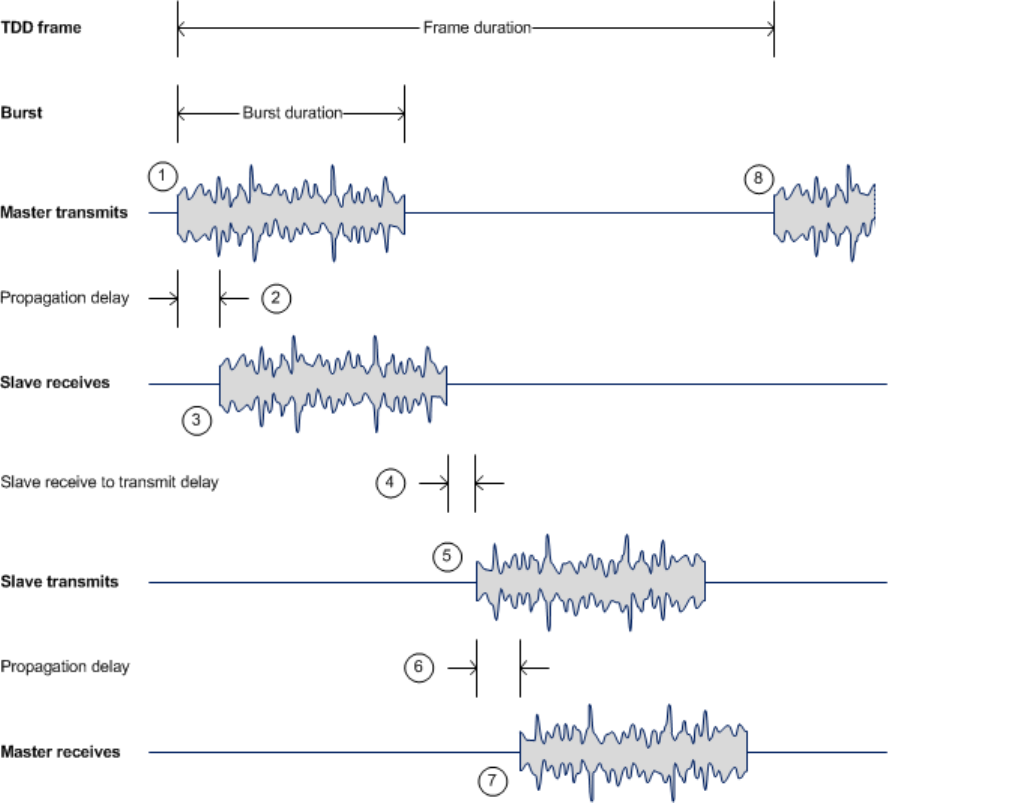
Chapter 1: Product description Wireless operation
The propagation delay in Step 2 is necessarily equal to the propagation delay in Step 6, and is
determined solely by the link range. There may be added delays between rx and tx on the master
and slave to minimize interference, as set up by the link planner or installer.
Figure 2
TDD cycle
Channel selection
The PTP 650 series links are capable of transmitting and receiving on the same channel or on
different channels. In other words, the slave-master direction may use a different channel from the
master-slave direction. Independent selection of transmit and receive frequencies can be useful in
planned networks or for countering interference.
When links operate in radar avoidance regions, each unit monitors its transmit channel for the
presence of radar signals. Therefore, the transmit and receive channels are always identical.
UNDER DEVELOPMENT
Page 1-7

Chapter 1: Product description Wireless operation
Further reading
For information about…
Refer to…
TDD synchronization in PTP networks TDD synchronization on page 1-19
Link mode optimization
Link mode optimization allows the PTP 650 link to be optimized according to the type of traffic that
will be bridged. The link supports two modes, IP Traffic and TDM Traffic.
IP traffic
IP Traffic mode is optimized to provide the maximum possible link capacity. IP Traffic mode is an
appropriate choice where applications in the bridged networks provide some measure of reliable
transmission, and where very low latency is not critical. IP mode supports both fixed and adaptive
link symmetry.
TDM traffic
TDM Traffic mode is optimized to provide the lowest possible latency. TDM Traffic mode
additionally implements a more conservative approach to adaptive modulation, leading to lower
error rates in fading channels at the expense of slightly lower link capacity. TDM Traffic mode is an
appropriate choice for delay intolerant data without reliable transmission (for example voice over
IP data). TDM Traffic mode is selected automatically when TDM interfaces are enabled.
Further reading
For information about…
Refer to…
Effect of IP and TDM modes on link symmetry Link symmetry on page 1-9
Effect of IP and TDM modes on link data
throughput capacity
Calculating data rate capacity on page 3-27
Data throughput capacity tables on page 3-68
Effect of IP and TDM modes on system
threshold, output power and link loss
System threshold, output power and link loss
on page 3-57
How to configure link mode optimization Wireless Configuration page on page 6-22
Link mode optimization alarms Alarms on page 7-17
UNDER DEVELOPMENT
Page 1-8

Chapter 1: Product description Wireless operation
Link symmetry
The PTP 650 series provides four configuration options for apportioning the available capacity
between the two link directions.
•
Symmetric –
The Master and Slave have equal capacity. The PTP 650 series achieves this by
allocating an equal Burst Duration for the Master and the Slave.
•
2:1 –
The capacity in the direction Master to Slave is twice that of the direction Slave to Master.
The PTP 650 series achieves this by setting the Burst Duration of the Master to twice that of the
Slave.
•
1:2 –
The capacity in the direction Slave to Master is twice that of the direction Master to Slave.
The PTP 650 series achieves this by setting the Burst Duration of the Slave to twice that of the
Master.
•
Adaptive –
This is only available on the Full license. The capacity allocated to a given link
direction is dependent on the offered level of network traffic in both link directions. If the level
of offered traffic in both directions is equally high or equally low, the PTP 650 will allocate
equal capacity to both directions. If however the offered level of traffic is greater in one
direction, it is allocated a greater proportion of the overall link capacity. The PTP 650 series
achieves this by increasing (or decreasing) the duration of the Transmit Burst in a given link
direction as the offered level of network traffic increases (or decreases) in this same direction.
This is done independently for the two directions.
Note
The 2:1 and 1:2 modes are not available when TDD synchronization is enabled.
Note
Adaptive mode is not available in the following configurations:
• When link mode optimization is set to TDM Traffic (see Link mode optimization on
page 1-8).
• When TDD synchronization is enabled.
• In regions where radar avoidance is operational (see Radar avoidance on page 1-15).
• When the ODU is not on a Full license.
UNDER DEVELOPMENT
Page 1-9

Chapter 1: Product description Wireless operation
Further reading
For information about…
Refer to…
Link symmetry in synchronized networks TDD synchronization on page 1-19
Effect of link symmetry on link data throughput
capacity
Calculating data rate capacity on page 3-27
Data throughput capacity tables on page 3-68
How to configure link symmetry Wireless Configuration page on page 6-22
Licensed maximum link range (PTP 650S)
The PTP 650S Integrated product variant operates at Full capacity in wireless links with range up to
2.0 km (1.2 miles), reverting to Lite capacity for links with range between 2.0 km and the absolute
maximum range 200 km (124 miles). PTP 650S can be operated at Full capacity at any range by
purchasing and applying the PTP 650S Upgrade Limited Range to Full Range Software License.
Further reading
For information about…
Refer to…
Link range capability upgrade Capability upgrades on page 1-50
Effect of link range on data throughput
capacity
Calculating data rate capacity on page 3-27
Data throughput capacity tables on page 3-68
How to generate a license key for maximum
link range
Generating license keys on page 6-3
How to configure link ranging Wireless Configuration page on page 6-22
Automatic detection of link range ODU installation tones on page 6-105
UNDER DEVELOPMENT
Page 1-10

Chapter 1: Product description Wireless operation
OFDM and channel bandwidth
The PTP 650 series transmits using Orthogonal Frequency Division Multiplexing (OFDM). This
wideband signal consists of many equally spaced sub-carriers. Although each sub carrier is
modulated at a low rate using conventional modulation schemes, the resultant data rate from the
sub-carriers is high. OFDM works exceptionally over a Non-Line-of-Sight (NLoS) channel.
The channel bandwidth of the OFDM signal is configurable to one of the following values: 5, 10,
15, 20, 30, 40 and 45 MHz. Higher bandwidths provide greater link capacity at the expense of using
more bandwidth. Systems configured for a narrower channel bandwidth provide better receiver
sensitivity and can also be an appropriate choice in deployments where the amount of free
spectrum is limited.
Each channel is offset in center frequency from its neighboring channel by 10 or 5 MHz.
Note
The Channel Bandwidth must be configured to the same value at both ends of the
link. Not all channel bandwidths are available in all regulatory bands.
Further reading
For information about…
Refer to…
Channel bandwidths per frequency band General wireless specifications on page 3-21
How to plan for channel bandwidth Channel bandwidth on page 3-23
Effect of channel bandwidth on link data
throughput capacity
Calculating data rate capacity on page 3-27
Data throughput capacity tables on page 3-68
How to generate a license key for greater
bandwidth
Generating license keys on page 6-3
How to configure channel bandwidth Wireless Configuration page on page 6-22
How to monitor channel bandwidth Spectrum management on page 7-25
Spectrum management
The spectrum management feature of the PTP 650 Series monitors the available wireless spectrum
and directs both ends of the wireless link to operate on a channel with a minimum level of co-
channel and adjacent channel interference.
UNDER DEVELOPMENT
Page 1-11

Chapter 1: Product description Wireless operation
Spectrum management measurements
The PTP 650 Series performs two mean signal measurements per TDD cycle, per channel. This
mean measurement represents the mean received signal power for the 40 microsecond
measurement period.
The Spectrum Management algorithm collects measurements equally from all channels in the
operating band. This process is called the Channel Availability Check (CAC). The CAC uses a
round-robin channel selection process to collect an equal amount of measurements from each
channel. The CAC measurement process is not altered by the channel barring process.
Measurements are still collected for all channels irrespective of the number of barred channels.
Measurement analysis
Spectrum Management uses statistical analysis to process the received peak and mean
measurement. The statistical analysis is based on a fixed, one minute, measurement quantization
period. Spectrum Management collects data for the specified quantization period and only at the
end of the period is the statistical analysis performed.
Statistical summary
The display of statistical measurement on the spectrum management page always shows a
statistical summary of all channel measurement. The statistical summary is controlled by the
Statistics Window attribute. This attribute defaults to a value of twenty minutes, which means that
the mean and percentile values displayed for each channel are calculated over the 20 minute
period. All channel decisions are made using the values computed over the statistics window
period.
Spectrum management in fixed frequency mode
The transmit and receive frequencies can be fixed in a PTP 650 wireless link. Once fixed frequency
mode is configured, the spectrum management software will not attempt to move the wireless link
to a channel with lower co-channel and adjacent-channel interference. Therefore this mode of
operation is only recommended for deployments where the installer has a good understanding of
the prevailing interference environment. Care must also be taken to ensure that the frequency
allocations at each end of the link are compatible.
Fixed frequency mode is not available in regions where radar detection is required by the
regulations.
Further reading
For information about…
Refer to…
How to perform spectrum management Spectrum management on page 7-25
UNDER DEVELOPMENT
Page 1-12

Chapter 1: Product description Wireless operation
Adaptive modulation
The PTP 650 series can transport data over the wireless link using a number of different
modulation modes ranging from 256QAM 0.81 to BPSK 0.63. For a given channel bandwidth and
TDD frame structure, each modulation mode transports data at a fixed rate. Also, the receiver
requires a minimum signal to noise ratio in order to successfully demodulate a given modulation
mode. Although the more complex modulations such as 256QAM 0.81 will transport data at a
much higher rate than the less complex modulation modes, the receiver requires a much higher
signal to noise ratio.
The PTP 650 series provides an adaptive modulation scheme where the receiver constantly
monitors the quality of the received signal and notifies the far end of the link of the optimum
modulation mode with which to transmit. In this way, optimum capacity is achieved at all times.
This is one of a number of features which allows the PTP 650 to operate in challenging non-line of
sight radio channels.
Note
PTP LINKPlanner includes an estimate of mean data rate, the data rate provided by
each modulation and the percentage of time spent in each modulation mode.
Further reading
For information about…
Refer to…
Lowest data modulation mode Lowest Data Modulation Mode on page 1-24
Lowest TDM modulation mode Lowest TDM modulation mode on page 1-33
Planning for adaptive modulation Adaptive modulation on page 3-26
Effect of modulation mode on link data
throughput capacity
Calculating data rate capacity on page 3-27
Data throughput capacity tables on page 3-68
Effect of modulation mode on system
threshold, output power and link loss
System threshold, output power and link loss on
page 3-57
How to configure modulation modes Interface Configuration page on page 6-14
Wireless Configuration page on page 6-22
System Configuration page on page 6-31
Modulation mode when the ODU is armed Checking that the units are armed on page 6-102
How to view the transmit and receive
modulation modes
System Status page on page 7-3
System counters on page 7-47
UNDER DEVELOPMENT
Page 1-13

Chapter 1: Product description Wireless operation
MIMO
Multiple-Input Multiple-Output (MIMO) techniques provide protection against fading and increase
the probability that the receiver will decode a usable signal. When the effects of MIMO are
combined with those of OFDM techniques and a high link budget, there is a high probability of a
robust connection over a non-line-of-sight path.
The PTP 650 transmits two signals on the same radio frequency, one of which is vertically
polarized and the other horizontally polarized. Depending on the channel conditions, the PTP 650
will adapt between two modes of operation:
•
Dual Payload
: When the radio channel conditions allow, the PTP 650 will transmit two different
and parallel data streams, one on the vertical channel and one on the horizontal channel. This
doubles the capacity of the PTP 650.
•
Single Payload
: As the radio channel becomes more challenging, the PTP 650 has the ability to
detect this and switch to a mode which transmits the same data stream on both vertical and
horizontal channels. This provides polar diversity and is another key feature which allows the
PTP 650 to operate in challenging non- line of sight radio channels.
Lower order modulations (BPSK 0.63 up to QPSK 0.87) only operate in single payload mode.
Higher order modulations (16QAM 0.63 to 256QAM 0.81) are available in single payload mode and
dual payload mode. The switching between modes is automatically controlled by the adaptive
modulation feature described in Adaptive modulation on page 1-13.
Note
The system automatically chooses between dual and single payload to try to increase
the capacity of a link. However the user can disable the dual payload mode, forcing
the more robust option of single payload.
Further reading
For information about…
Refer to…
How to configure dual or single payload Wireless Configuration page on page 6-22
Single and dual payload modulation modes System threshold, output power and link loss
on page 3-57
TDM single payload lock feature TDM on page 7-13
UNDER DEVELOPMENT
Page 1-14

Chapter 1: Product description Wireless operation
Dynamic spectrum optimization
The PTP 650 series uses an interference mitigation technique known as Dynamic Spectrum
Optimization (DSO). Both the Master and Slave continually monitor for interference on all channels
and then select the best frequency of operation. This is a dynamic process where the PTP 650 can
continually move channels in response to changes in interference. Two modes of operation are
available:
• First mode: the two link directions are forced to select the same frequency, determined by the
Master.
• Second mode: the frequency of operation can be determined independently for each direction.
This mode is not permitted in radar regions.
Further reading
For information about…
Refer to…
Using DSO in PTP networks Using Dynamic Spectrum Optimization on page 1-18
Planning to use DSO Frequency selection on page 3-23
How to configure DSO Wireless Configuration page on page 6-22
Asymmetric DSO in non-radar regions Spectrum Management Settings on page 7-32
Radar avoidance
In regions where protection of radars is part of the local regulations, the PTP 650 must detect
interference from radar-like systems and avoid co-channel operation with these systems.
To meet this requirement, the PTP 650 implements the following features:
• The radar detection algorithm will always scan a usable channel for 60 seconds for radar
interference before making the channel an available channel.
• This compulsory channel scan will mean that there is at least 60 seconds service outage every
time radar is detected and that the installation time is extended by at least 60 seconds even if
no radar is found.
• When operating on a channel, the spectrum management algorithm implements a radar
detection function which looks for impulsive interference on the operating channel. If
impulsive interference is detected, spectrum management will mark the current operating
channel as having detected radar (unavailable channel) and initiate a channel hop to an
available channel. The previous operating channel will remain in the unavailable state for
thirty minutes after the impulsive interference pulse was detected.
• After the thirty minutes have expired the channel will be returned to the usable channel pool.
There is a secondary requirement for bands requiring radar avoidance. Regulators have mandated
that products provide a uniform loading of the spectrum across all devices. In general, this
prevents operation with fixed frequency allocations. However:
UNDER DEVELOPMENT
Page 1-15

Chapter 1: Product description Wireless operation
• ETSI regulations do allow frequency planning of networks (as that has the same effect of
spreading the load across the spectrum).
• The FCC does allow channels to be barred if there is actually interference on them.
Fixed frequency allocation is not recommended in radar avoidance regions, as any radar detection
would cause a system outage of at least 30 minutes.
Further reading
For information about…
Refer to…
Radar avoidance in the country of operation License keys and regulatory bands on page 1-17
Planning for mandatory radar detection Frequency selection on page 3-23
Radar avoidance when aligning antennas ODU installation tones on page 6-105
Effect of radar detection on spectrum
management
Spectrum management in radar avoidance mode
on page 7-37
Encryption
The PTP 650 supports optional encryption for data transmitted over the wireless link. The
encryption algorithm used is the Advanced Encryption Standard (AES) with 128-bit and 256-bit key
size. AES is a symmetric encryption algorithm approved by U.S. Government organizations (and
others) to protect sensitive information. The AES implementation in PTP 650 is approved to FIPS-
197. Encryption is enabled through the purchase of an upgrade.
Further reading
For information about…
Refer to…
AES requirement for HTTPS/TLS Transport layer security on page 1-40
AES requirement for SNMPv3 security User-based security model on page 1-44
Licensing AES encryption AES license on page 1-47
Capability upgrades on page 1-50
Planning to use AES for HTTPS/TLS Planning for HTTPS/TLS operation on page 3-49
How to generate AES license keys Generating license keys on page 6-3
How to configure AES encryption System Configuration page on page 6-31
How to configure AES encryption for
HTTPS/TLS operation
Security menu on page 6-90
UNDER DEVELOPMENT
Page 1-16
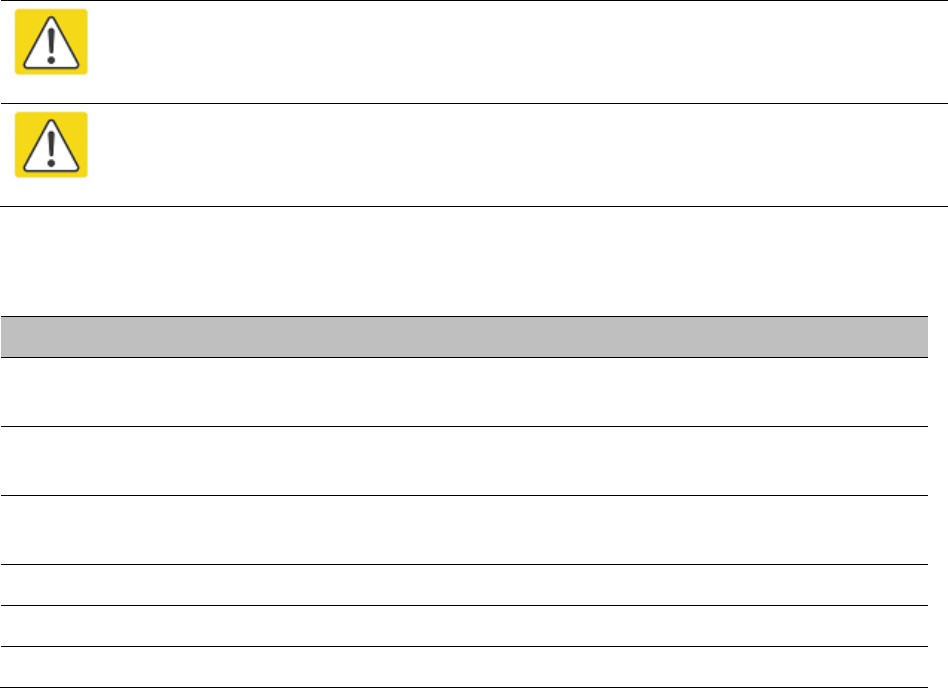
Chapter 1: Product description Wireless operation
License keys and regulatory bands
The PTP 650 license key specifies the country of operation for the ODU, and lists the regulatory
bands that are licensed by regulators in that country. If a license key provides access to more than
one regulatory band, PTP 650 provides a choice between the available bands. In each regulatory
band, PTP 650 sets the following aspects of wireless operation to comply with the applicable
regulations:
• Maximum transmit power
• Radar avoidance
• Transmit power reduction in edge channels
• Frequency range
• Channel plan
The country of operation (and thus the supported regulatory bands) can be changed by generating
a new license key at the License Key Generator page of the Cambium web-site, and entering the
new license key using the Installation Wizard.
Caution
To avoid possible enforcement action by the country regulator, always operate links in
accordance with local regulations.
Attention
Pour éviter une éventuelle sanction par le régulateur du pays, utiliser toujours nos
liaisons radiofréquences conformément à la réglementation locale.
Further reading
For information about…
Refer to…
Planning PTP 650 links to conform to the
regulatory band restrictions
Radio spectrum planning on page 3-21
Radio regulations in the country of operation Compliance with radio regulations on page
4-27
How to generate a license key for the country of
operation
Generating license keys on page 6-3
How to configure the regulatory band Wireless Configuration page on page 6-22
How to view the regulatory band System Status page on page 7-3
Regulatory band alarms Alarms on page 7-17
UNDER DEVELOPMENT
Page 1-17
Chapter 1: Product description Wireless operation
PTP networks
Using Dynamic Spectrum Optimization
The Dynamic Spectrum Optimization (DSO) feature allows a PTP 650 unit to select wireless
channels for a lower level of radio frequency (RF) interference. This approach is appropriate where
the network consists of a small number of PTP links, or where the RF interference is predominantly
from equipment belonging to other operators.
Using frequency planning
Networks will benefit from the use of fixed channel allocations if (a) the network consists of
multiple PTP links, and (b) RF interference predominantly arises from equipment in the same
network.
Frequency planning is the exercise of assigning operating channels to PTP units so as to minimize
RF interference between links. Frequency planning must consider interference from any PTP unit
to any other PTP unit in the network. Low levels of interference normally allow for stable operation
and high link capacity.
The frequency planning task is made more straightforward by use of the following techniques:
• Using several different channels
• Separating units located on the same mast
• Using high performance (directional) external antennas
Synchronized networks
TDD synchronization can be used to relax constraints on the frequency planning of PTP networks.
Synchronization has the following benefits:
• Allows tighter frequency re-use, and thus wider channel bandwidth.
• Allows more convenient collocation of units on a single mast.
• Allows use of smaller or lower performance antennas.
• Reduces inference, resulting in use of more efficient modulation modes.
In a correctly designed synchronised network, all links are configured with the same TDD frame
duration, and the TDD frame contains guard periods longer than the propagation delay between
the most distant interfering units.
Each synchronized unit is assigned to one of two phases. A master ODU can be assigned to either
phase. A slave ODU must be assigned to a different phase from the associated master ODU. The
phase is set by suitable configuration of TDD Frame Offset.
TDD synchronization eliminates RF interference between units in the same phase. This means that
frequency planning in a synchronized network is concerned only with interference between units
in different phases. Frequency planning is still necessary, but the number of potential interference
paths to be considered is halved. Frequency planning in a synchronized TDD network has
approximately the same level of complexity as frequency planning in a Frequency Division Duplex
(FDD) network.
UNDER DEVELOPMENT
Page 1-18

Chapter 1: Product description Wireless operation
Further reading
For information about…
Refer to…
How to plan networks Chapter 3: System planning, or contact your
Cambium distributor or re-seller.
TDD synchronization (PTP-SYNC)
Additional hardware is needed to synchronize PTP 650 links. One PTP-SYNC unit is required for
each master ODU. The PTP-SYNC unit is connected in line in the drop cable between the PSU and
the ODU, and is collocated with the PSU.
Caution
The PTP-SYNC is compatible only with the AC + DC Power Injector.
The AC Power Injector will not work with a PTP-SYNC, and it is likely that a fuse will
be blown in the PTP-SYNC if this is attempted.
Timing references for use with PTP-SYNC
PTP-SYNC requires an external timing reference in all but the simplest networks. Up to ten
PTP-SYNCs can be connected in a chain to share the timing signal from one timing reference. In
the majority of applications, one reference is required for each site that contains PTP 650 master
ODUs.
The timing reference can be from any timing system that provides a 1 Hz signal, accurately
synchronized in frequency and phase with a network-wide master timing reference. GPS timing
receivers are a very practical way of obtaining a suitable reference. The PTP-SYNC is compatible
with the Trimble Acutime™ GG and Trimble Acutime™ Gold GPS receivers.
In simple networks where all master ODUs are at a single site, the external reference can be
omitted. In this case, one ODU acts as a reference for other collocated units.
Configuring the TDD frame
In synchronized operation, frame duration and burst duration must be configured directly in the
web-based management interface. Frame duration must be identical across all links in a
synchronized network.
The PTP Link Planner provides a capability for computing suitable frame parameters in a
synchronized network. Please refer to the Link Planner User Guide for guidance on configuring
TDD synchronization.
Link symmetry is always 1:1 in synchronized networks.
UNDER DEVELOPMENT
Page 1-19

Chapter 1: Product description Wireless operation
Link capacity in synchronized networks
The TDD frame duration is extended in synchronized networks to allow for the propagation delay
of the longest link in the network and to incorporate additional guard periods. These guard periods
protect against delayed interference from distant units in the same network.
The longer frame duration results in slightly lower link capacity than for an equivalent non-
synchronized link with the same channel bandwidth and modulation mode. However, TDD
synchronization also reduces interference, and this may allow operation in higher modulation
modes. The benefit of operating in a higher modulation mode normally outweighs the penalty of
the slightly longer TDD frame.
Further reading
For information about…
Refer to…
The PTP-SYNC unit PTP-SYNC unit on page 2-46
The GPS receiver GPS receiver on page 2-52
Typical deployment diagrams for GPS GPS receiver interfaces on page 3-9
Choosing a site for the PTP-SYNC unit PTP-SYNC location on page 3-15
Choosing a site for the GPS receiver GPS receiver location on page 3-16
Use of PTP LINKPlanner for TDD
synchronization
PTP LINKPlanner for synchronized networks on
page 3-26
TDD synchronization methods that may be
implemented using PTP-SYNC
Configuration options for TDD synchronization
on page 3-31
How to install a PTP-SYNC unit Installing a PTP-SYNC unit on page 5-28
How to install an optional GPS receiver Installing a GPS receiver on page 5-32
How to enable TDD synchronization Wireless Configuration page on page 6-22
How to configure TDD synchronization TDD synchronization page (optional) on page 6-
28
How to view TDD synchronization status System Status page on page 7-3
TDD synchronization alarms Alarms on page 7-17
How to test a PTP-SYNC installation when a
fault is suspected
Testing PTP-SYNC on page 8-10
UNDER DEVELOPMENT
Page 1-20

Chapter 1: Product description Ethernet bridging
Ethernet bridging
This section describes how the PTP 650 processes Ethernet data, in both the customer and system
management networks.
Ethernet ports
The PTP 650 Series ODU has three Ethernet ports:
•
Main PSU
: The Main PSU port provides a copper Ethernet interface for 100BASE-TX and
1000BASE-T, and accepts power from the AC+DC Enhanced Power Injector or the AC Power
Injector to the ODU using a proprietary power over Ethernet (PoE) method.
•
Aux:
The Aux port provides a copper Ethernet interface for 100BASE-TX and 1000BASE-T, and
supplies power from the ODU to external equipment using standards-based power over
Ethernet (PoE) complying with IEEE 802.3at.
•
SFP:
The SFP port is a small format pluggable receptacle accepting copper or optical plug-in
modules supplied as part of the SFP module kit.
Each of the three Ethernet ports can be allocated for customer data or network management in the
following ways:
•
Disabled:
The port is not in use for customer data or network management.
•
Data Only
: The port is connected to the customer data network only.
•
Data and In-Band Management
: The port is connected to the customer data network and to the
management agent of the local ODU
•
Out-of-Band Local Management
: The port is connected directly to the management agent of
the local ODU.
•
Out-of-Band Remote Management
: The port is connected to the management agent of the
local ODU and, via the wireless bridge, to that of the remote ODU.
Note
The PTP 650 provides flexible interconnection of customer data and network
management using several Ethernet ports, but it does not contain a general-purpose
Ethernet switch, and it is not possible to forward traffic between the Ethernet ports of
the same ODU.
UNDER DEVELOPMENT
Page 1-21

Chapter 1: Product description Ethernet bridging
Further reading
For information about…
Refer to…
SFP optical or copper module kits SFP module kits on page 2-43
The PSU, AUX and SFP ports of the ODU ODU interfaces on page 2-13
Diagrams showing Ethernet connections Typical deployment on page 3-2
How to plan the use of Ethernet ports for
customer and management traffic
Ethernet port allocation on page 3-36
How to install the Ethernet interfaces to
the ODU
Installing the copper Cat5e Ethernet interface on
page 5-18
Installing an SFP Ethernet interface on page 5-28
Installing an Aux Ethernet interface on page 5-57
How to configure the ODU Ethernet
ports
Interface Configuration page on page 6-14
LAN Configuration page on page 6-35
Ethernet port status attributes Ethernet / Internet on page 7-6
Ethernet port alarms Alarms on page 7-17
Customer data network
Transparent Ethernet service
The PTP 650 Series provides an Ethernet service between one of the Ethernet ports at a local ODU
and one of the Ethernet ports at an associated remote ODU. The Ethernet service is based on
conventional layer two transparent bridging, and is equivalent to the Ethernet Private Line (EPL)
service defined by the Metro Ethernet Forum (MEF).
The service is transparent to untagged frames, standard VLAN frames, priority-tagged frames,
provider bridged frames, Q-in-Q frames and provider backbone bridged frames. In each case, the
service preserves MAC addresses, VLAN ID, Ethernet priority and Ethernet payload in the
forwarded frame. The maximum frame size for bridged frames in the customer network is
9600 bytes.
There is no requirement for the customer data network to be connected to the same Ethernet port
at both ends of a wireless link. For example, it is possible to connect the Main PSU port to the
customer data network at one end of the link and to connect the Aux port to the customer data
network at the other end of the link.
UNDER DEVELOPMENT
Page 1-22
Chapter 1: Product description Ethernet bridging
Layer two control protocols
The data service in the PTP 650 Series is transparent to layer two control protocols (L2CP)
including:
• Spanning tree protocol (STP), rapid spanning tree protocol (RSTP)
• Multiple spanning tree protocol (MSTP)
• Link aggregation control protocol (LACP)
• Link OAM, IEEE 802.3ah
• Port authentication, IEEE 802.1X
• Ethernet local management interface (E-LMI), ITU-T Q.933.
• Link layer discovery protocol (LLDP)
• Multiple registration protocol (MRP)
• Generic attribute registration protocol (GARP)
The PTP 650 Series does not generate or respond to any L2CP traffic.
Quality of service for bridged Ethernet traffic
The PTP 650 Series supports eight traffic queues in the data service for Ethernet frames waiting for
transmission over the wireless link. Ethernet frames are classified by inspection of the Ethernet
priority code point in the outermost VLAN tag, the Differentiated Services Code Point (DSCP) in an
IPv4 or IPv6 header, or the Traffic Class in an MPLS header.
PTP 650 provides a configurable mapping between Ethernet, IP or MPLS priority and transmission
queue, together with a simple way to restore a default mapping based on the recommended
default in IEEE 802.1Q-2005. Untagged frames, or frames with an unknown network layer protocol,
can be separately classified.
Scheduling for transmission over the wireless link is by strict priority. In other words, a frame at
the head of a given queue is transmitted only when all higher priority queues are empty.
Fragmentation
The PTP 650 Series minimizes latency and jitter for high-priority Ethernet traffic by fragmenting
Ethernet frames before transmission over the wireless link. The fragment size is selected
automatically according to channel bandwidth and modulation mode of the wireless link.
Fragments are reassembled on reception, and incomplete Ethernet frames are discarded.
UNDER DEVELOPMENT
Page 1-23

Chapter 1: Product description Ethernet bridging
Data port wireless link down alert
The PTP 650 Series provides an optional indication of failure of the wireless link by means of a
brief disconnection of the copper or optical data port allocated to the customer data network. The
Wireless link down alert can be used to trigger protection switching by Spanning Tree Protocol
(STP) or Ethernet Automatic Protection Switching (EAPS) and other higher layer protocols in a
redundant network.
If out-of-band remote management is enabled, there is an option to enable wireless down alert
separately at the copper or optical data port allocated to the management network.
Lowest Data Modulation Mode
The PTP 650 ODU can be configured to discard Ethernet frames when the modulation mode is
lower than the configured Lowest Data Modulation Mode.
This feature is likely to be useful in networks that have alternate routes, for example in a ring or
mesh topology where EAPS or RSTP is used to resolve loops. In this application, Lowest Data
Modulation Mode should be set to ensure that an active link will provide at least the minimum
necessary capacity for high-priority constant bit rate traffic such as voice over IP or TDM pseudo
wire. An active link will be blocked when the capacity falls below the minimum required, triggering
a routing change in associated Ethernet switches to bring alternate links into use.
Lowest Data Modulation Mode should normally be set to BPSK 0.63 Single in simply connected
tree networks or other topologies that do not have alternative routes.
Further reading
For information about…
Refer to…
Factors to be considered when planning
PTP 650 customer data networks
Data network planning on page 3-35
How to configure the Ethernet service LAN Configuration page on page 6-35
How to configure Ethernet quality of service QoS Configuration page on page 6-43
How to monitor Ethernet performance System statistics on page 7-45
UNDER DEVELOPMENT
Page 1-24
Chapter 1: Product description Ethernet bridging
Management network
Transparent Ethernet service
The PTP 650 Series provides an optional Ethernet service for out-of-band network management
between one of the Ethernet ports at a local ODU and one of the Ethernet ports at an associated
remote ODU. The Ethernet service is based on conventional layer two transparent bridging. The
PTP 650 maintains complete separation between Ethernet traffic in the customer data service and
the management service.
The service is transparent to untagged frames, standard VLAN frames, priority-tagged frames,
provider bridged frames, Q-in-Q frames and provider backbone bridged frames. In each case, the
service preserves MAC addresses, VLAN ID, Ethernet priority and Ethernet payload in the
forwarded frame. The maximum frame size for bridged frames in the management network is 2000
bytes.
There is no requirement for the management network to be connected to the same Ethernet port at
both ends of a wireless link. For example, it is possible to connect the Main PSU port to the
management network at one end of the link and to connect the Aux port to the management
network at the other end of the link.
Layer two control protocols
The management service in the PTP 650 Series is transparent to layer two control protocols (L2CP)
including:
• Spanning tree protocol (STP), rapid spanning tree protocol (RSTP)
• Multiple spanning tree protocol (MSTP)
• Link aggregation control protocol (LACP)
• Link OAM, IEEE 802.3ah
• Port authentication, IEEE 802.1X
• Ethernet local management interface (E-LMI), ITU-T Q.933.
• Link layer discovery protocol (LLDP)
• Multiple registration protocol (MRP)
• Generic attribute registration protocol (GARP)
The management service in the PTP 650 Series does not generate or respond to any L2CP traffic.
Quality of service for bridged Ethernet traffic
The PTP 650 Series supports a single traffic queue in the management service for Ethernet frames
waiting for transmission over the wireless link. The priority of the queue can be varied with respect
to the eight queues used for the data service. Management traffic takes priority over customer data
in a queue configured with the same priority level. For example, if the management service is
configured with priority Q6, then management traffic has higher priority than customer data in Q6,
but lower priority than customer traffic in Q7.
UNDER DEVELOPMENT
Page 1-25

Chapter 1: Product description Ethernet bridging
Fragmentation
Ethernet frames in the PTP 650 Series management service are always fragmented for
transmission over the wireless link, even when the single queue for the management service has
higher priority than all of the customer data queues.
Management port wireless down alert
The PTP 650 Series provides an optional indication of failure of the wireless link by means of a
brief disconnection of the copper or optical data port allocated to the management network. The
Wireless link down alert can be used to trigger protection switching by Spanning Tree Protocol
(STP) or Ethernet Automatic Protection Switching (EAPS) and other higher layer protocols in a
redundant network.
Lowest Data Modulation Mode
The Lowest Data Modulation Mode attribute does not prevent bridging in the management
service. See Lowest Data Modulation Mode on page 1-24.
Further reading
For information about…
Refer to…
Factors to be considered when planning
PTP 650 management data networks
Data network planning on page 3-35
How to configure the Ethernet service LAN Configuration page on page 6-35
How to configure Ethernet quality of service QoS Configuration page on page 6-43
How to monitor Ethernet performance System statistics on page 7-45
UNDER DEVELOPMENT
Page 1-26

Chapter 1: Product description Ethernet bridging
Ethernet loopback mode
PTP 650 provides a local Ethernet loopback function that can be used to loop traffic between the
Aux Port and one of the other Ethernet ports.
Loopback is intended to assist in the commissioning of a camera or other auxiliary device
collocated with the PTP 650 ODU. For example, when setting up a camera which will ultimately be
connected to the wireless bridge, it may be useful to loop the data back to a second local interface,
to assist in the positioning and alignment of the camera.
When ports are configured for Ethernet local loopback, they are temporarily disconnected from
their allocated function and connected together internally within the PTP 650 ODU. Out-of-band
local management is disconnected from the management agent, and the In-band management
path will also be un-available if one of the loopback ports has been allocated for Data and in-band
management. In this case, it will not be possible to manage the ODU from a local Ethernet port.
For this reason the Ethernet loopback is always disabled when the ODU is rebooted or power-
cycled, restoring the previous port configuration and any associated management paths.
During loopback operation, the same frame size restrictions that apply to management traffic are
present, jumbo frames are not supported and the maximum frame size is restricted to 1536 bytes.
Loopback is able to loop between Ethernet ports operating at different line rates if required, and it
is possible to configure a Loopback between ports operating at 1000BASE-T/LX/SX and
100BASE-TX if needed.
Further reading
For information about…
Refer to…
How to configure Ethernet loopback LAN Configuration page on page 6-35
UNDER DEVELOPMENT
Page 1-27
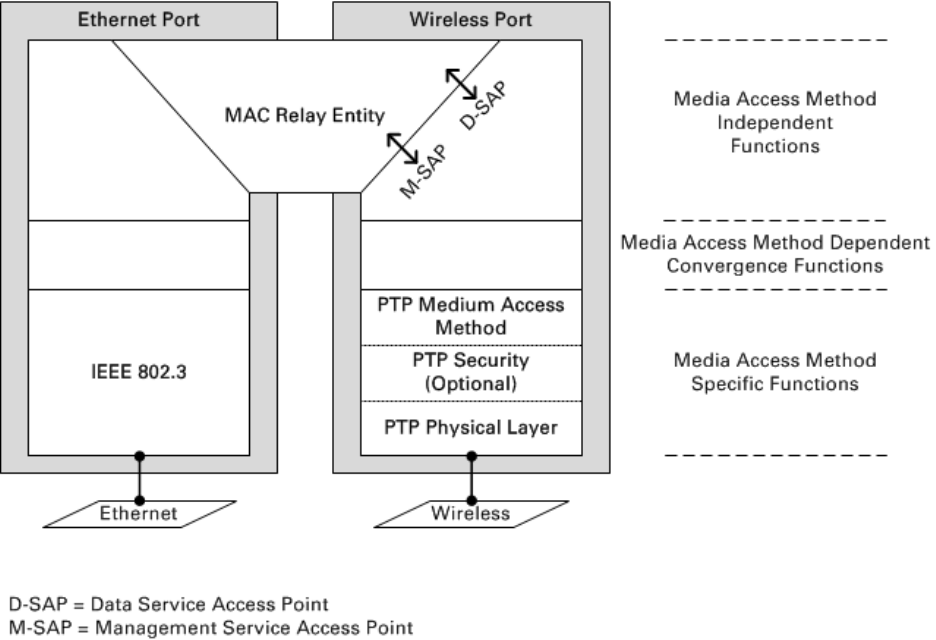
Chapter 1: Product description Ethernet bridging
Protocol model
Ethernet bridging behavior at each end of the wireless link is equivalent to a three-port, managed,
transparent MAC bridge where the three ports are an Ethernet data port, an Ethernet remote
management port, and the Wireless port.
Frames are transmitted at the Wireless port over a proprietary point-to-point circuit-mode link
layer between ends of the PTP 650 link. The Wireless Port provides separate service access ports
(SAPs) for customer data and for remote management. Ethernet frames received at the Ethernet ports,
or generated internally within the management agent, are encapsulated within a lightweight MAC
layer for transmission over the wireless link.
Protocol layers involved in bridging between Ethernet and wireless interfaces are shown in Figure
3. Protocol layers involved in bridging between external interfaces and the management agent are
shown in Figure 4. In these figures, the layers have the meanings defined in IEEE 802.1Q-2005.
Figure 3
Protocol layers between Ethernet and wireless interfaces
UNDER DEVELOPMENT
Page 1-28
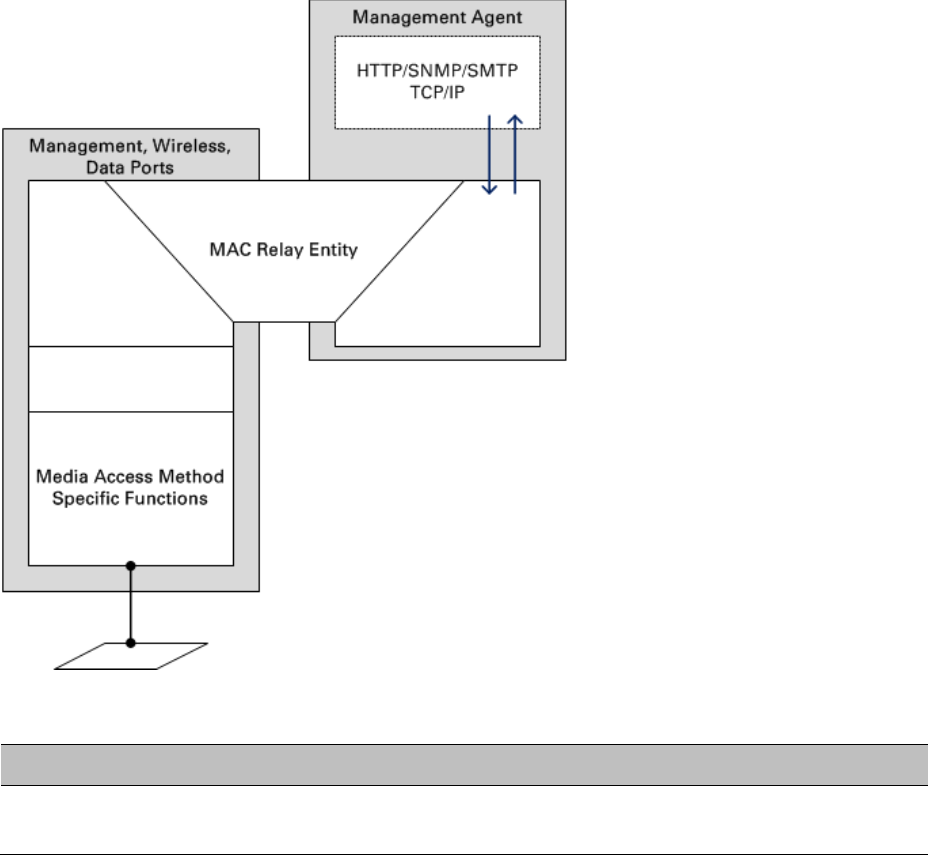
Chapter 1: Product description Ethernet bridging
Figure 4
Protocol layers between external interfaces and the management agent
Further reading
For information about…
Refer to…
Layer two control protocols (L2CPs)
identified by PTP 650
Layer two control protocols on page 3-35
Synchronous Ethernet
PTP 650 provides a Synchronous Ethernet function. When enabled, the frequency and phase of the
Ethernet clock is transferred to the other end of the radio link, enabling operation as part of an
ITU-T G.781 Synchronous Digital Hierarchy.
Synchronisation Status Messages (SSM) are processed and transmitted as specified by ITU-T
G.8264 and in Section 5 of G.781.
UNDER DEVELOPMENT
Page 1-29

Chapter 1: Product description Ethernet bridging
Further reading
For information about…
Refer to…
Relationship between synchronous
Ethernet and TDM
TDM description on page 1-32
Availability of synchronous Ethernet Capability upgrades on page 1-50
Relationship between synchronous
Ethernet and Ethernet port allocation
Ethernet port allocation on page 3-36
How to configure synchronous Ethernet LAN Configuration page on page 6-35
Upgrading to synchronous Ethernet Generating license keys on page 6-3
Synchronous Ethernet status indicators Synchronous Ethernet on page 7-10
Synchronous Ethernet alarms Alarms on page 7-17
IEEE 1588-2008 Transparent Clock
PTP 650 is capable of operating as an IEEE 1588-2008 Transparent Clock. When operational, IEEE
1588-2008 event frames (Sync, Delay_Req, Pdelay_Req, Pdelay_Resp) have their “Correction Field”
adjusted to reflect the residence time of the frame in the system. This results in greatly improved
performance of downstream 1588-2008 slave clocks.
Unicast and multicast addressing models are supported, along with UDP over IPv4 or IPv6, and
Ethernet communication services. The IEEE 1588 messages can be encapsulated in Untagged, C-
tagged, S-tagged, S-C-tagged and C-C-tagged Ethernet frames.
Note
For the most accurate residence time corrections, use Synchronous Ethernet in
conjunction with the Transparent Clock feature. In this configuration, PTP 650 uses the
Synchronous Ethernet clock to increase the accuracy of 1588 residence time
measurements.
UNDER DEVELOPMENT
Page 1-30

Chapter 1: Product description Ethernet bridging
Further reading
For information about…
Refer to…
Relationship between IEEE 1588-2008 Transparent
Clock and TDM
TDM description on page 1-32
Availability of IEEE 1588-2008 Transparent Clock Capability upgrades on page 1-50
Relationship between IEEE 1588-2008 Transparent
Clock and Ethernet port allocation
Ethernet port allocation on page 3-36
Relationship between IEEE 1588-2008 Transparent
Clock and VLAN membership
VLAN membership on page 3-42
Upgrading to IEEE 1588-2008 Generating license keys on page 6-3
How to configure IEEE 1588-2008 Transparent
Clock
LAN Configuration page on page 6-35
IEEE 1588-2008 Transparent Clock status
indicators
Synchronous Ethernet on page 7-10
IEEE 1588-2008 Transparent Clock alarms Alarms on page 7-17
UNDER DEVELOPMENT
Page 1-31

Chapter 1: Product description TDM bridging
TDM bridging
This section describes how TDM traffic (E1 or T1) may be carried over PTP 650 links.
If a NIDU is installed at each link end, the PTP 650 link supports up to eight E1 channels or up to
eight T1 channels. The link relays unstructured E1 or T1 data and provides accurate timing
transfer.
TDM description
PTP 650 Series bridges up to eight E1 or T1 telecoms circuits over a single-hop PTP 650 wireless
link using the optional Network Indoor Unit (NIDU). The NIDU provides the eight TDM interfaces
on individual RJ45/RJ48 connectors, together with an Ethernet interface to the operator’s data
network and a separate Ethernet interface to the PTP 650 Series ODU. One NIDU is required at
each end of the link. It operates from a 48 V DC power supply.
TDM circuits established using the NIDUs are structure agnostic, meaning that the circuits can
bridge framed or unframed data.
The NIDUs are tightly integrated with associated ODUs providing for simple configuration,
accurate timing transfer, low and predictable latency, high efficiency, quick settling time, and a
timing-only mode that maintains timing transfer when the wireless link has insufficient capacity to
bridge the configured TDM data.
Through timing
TDM bridging in the PTP 650 series uses the “through timing” model. In other words, the clock
frequency used for transmitting TDM data is, on average, exactly the same as the clock frequency
received at the corresponding TDM port at the remote end of the link. The wander and jitter in the
transmit clock complies with applicable requirements of ITU-T G.823 and G.824 without additional
external frequency references. Timing transfer is independent between individual circuits, and
between transmit and received directions of the same circuit.
NIDUs and TDM
TDM circuits in PTP 650 span a single wireless link. To transmit TDM data across a network
segment consisting of several wireless links, use one pair of NIDUs for each wireless link, and
interconnect the TDM ports at relay sites.
The NIDU is not a general-purpose TDM multiplexer, and will not interwork with standards-based
products from other manufacturers. The NIDU does not support (and does not need to support)
internal, external or loop timing modes. The NIDU does not accept (or need) an external frequency
reference.
The NIDU is not separately managed, and it does not have an IP address. Instead, the ODU is used
to configure and monitor the associated NIDU through the standard HTTP/HTTPS, SNMP, SMTP
and syslog interfaces already used by the ODU.
UNDER DEVELOPMENT
Page 1-32
Chapter 1: Product description TDM bridging
The NIDU always connects to the ODU using the Main PSU port of the ODU. This constrains the
flexible allocation of ports to services somewhat.
Timing transfer for TDM circuits
Accurate timing transfer for TDM circuits in the PTP 650 Series is based on the same underlying
technology as the IEEE 1588 Transparent Clock and Synchronous Ethernet features. Consequently,
the IEEE 588 and Synchronous Ethernet features are not available when TDM bridging is enabled.
Similarly, TDM bridging is not available if either IEEE 1588 or Sync E is in use. The Adaptive setting
for Link Symmetry is not compatible with TDM bridging.
TDM bridging is a licensed feature, and may require an optional upgrade for the ODU firmware.
Lowest TDM modulation mode
In narrow channel bandwidths and lower modulation modes, the link may have insufficient
capacity to relay the E1/T1 payload; in this case, the wireless link continues to carry timing
information in order to maintain accurate clock synchronization. The relay of TDM data resumes
automatically when the link reaches a suitable modulation mode.
Links that are able to operate consistently in a high modulation mode can take advantage of lower
link latency. This option is configured by setting the "Lowest TDM Modulation Mode" during
installation. Appropriate settings for this control may be determined by using the PTP LINKPlanner
tool. The reduction in latency is achieved by disabling the relay of TDM data in lower modulation
modes, and this necessarily results in somewhat lower availability for the TDM circuit. The loss of
availability can be estimated using the Link Planner.
The unit will override the user setting of Lowest TDM Modulation Mode if the selected mode has
insufficient capacity to carry the TDM data, or if the mode demands very high latency and requires
more buffering than the link can provide.
Fixed frequency operation
In the PTP 650 link, data errors may occur during channel changes on an operational link. It may be
appropriate to minimize channel-change-related errors in a link carrying TDM traffic by preventing
channel changes initiated by DSO. This can be achieved by barring all channels except one in the
Spectrum Management page, or alternatively by selecting Fixed Frequency mode. These steps
unavoidably disable interference avoidance mechanisms, and should not be taken if the risk of
errors due to interference is more severe than the risk due to channel changes.
Fixed frequency operation is not available when radar detection requirements exist in the
frequency band. Channel barring is allowed in radar regions, but it is unwise to bar all channels
except one, as any radar signals detected on that channel will drop the link for up to 30 minutes.
UNDER DEVELOPMENT
Page 1-33

Chapter 1: Product description TDM bridging
Ethernet cables for TDM
The Ethernet cables from the ODU via the PSU to the NIDU must be capable of supporting
operation at 1000BASE-T. If the ODU port has negotiated a link at 100BASE-T, the NIDU will not
send or receive TDM data and will not bridge customer data traffic.
Further reading
For information about…
Refer to…
The hardware required to implement TDM Network indoor unit (NIDU) on page 2-54
A typical E1 or T1 site deployment E1 or T1 interfaces on page 3-5
Where to locate the NIDU NIDU location on page 3-17
TDM interface specifications Ethernet interfaces on page 3-35
The effect of TDM on data throughput TDM traffic load on page 3-112
How to install TDM hardware Installing a NIDU on page 5-42
How to generate TDM (E1 or T1) license keys Generating license keys on page 6-3
How to install TDM license keys (part of the
Installation Wizard)
Software License Key page on page 6-11
How to enable E1 or T1 and configure TDM
channels (part of the Installation Wizard)
Interface Configuration page on page 6-14
How to configure NIDU LAN port auto-
negotiation
LAN Configuration page on page 6-35
How to configure TDM channels and initiate
loopback tests (after installation)
TDM Configuration page on page 6-48
How to enable TDM alarms Diagnostic Alarms page on page 6-69
The meaning of TDM status attributes System Status page on page 7-3
The meaning of TDM alarms Alarms on page 7-17
How to check the NIDU LEDs, perform a TDM
loopback test, and check for 1000BASE-T
Testing a TDM link on page 8-13
To find the latency of a TDM link System Status page, TDM Latency attribute
(Table 162)
Alternatively, use PTP LINKPlanner
UNDER DEVELOPMENT
Page 1-34

Chapter 1: Product description System management
System management
This section introduces the PTP 650 management system, including the web interface, installation,
configuration, alerts and upgrades.
Management agent
PTP 650 equipment is managed through an embedded management agent. Management
workstations, network management systems or PCs can be connected to this agent using a choice
of in-band or out-of-band local modes. These modes are described in detail in Network
management on page 1-36.
The management agent includes a dual IPv4/IPv6 interface at the management agent. The IP
interface operates in the following modes:
• IPv4 only (default)
• IPv6 only
• Dual IPv4/IPv6
In the dual IPv4/IPv6 mode, the IP interface is configured with an IPv4 address and an IPv6 address
and can operate using both IP versions concurrently. This dual mode of operation is useful when a
network is evolving from IPv4 to IPv6.
The management agent supports the following application layer protocols (regardless of the
management agent IP mode):
• Hypertext transfer protocol (HTTP)
• HTTP over transport layer security (HTTPS/TLS)
• RADIUS authentication
• TELNET
• Simple network management protocol (SNMP)
• Simple mail transfer protocol (SMTP)
• Simple network time protocol (SNTP)
• System logging (syslog)
Note
PTP 650 supports a single public key certificate for HTTPS. This certificate must be
based on an IPv4 or IPv6 address as the Common Name. The Dual IPv4/IPv6 interface
should not normally be used when HTTPS is required.
UNDER DEVELOPMENT
Page 1-35
Chapter 1: Product description System management
Network management
IPv4 and IPv6 interfaces
The PTP 650 ODU contains an embedded management agent with IPv4 and IPv6 interfaces.
Network management communication is exclusively based on IP and associated higher layer
transport and application protocols. The default IPv4 address of the management agent is
169.254.1.1. There is no default IPv6 address. The PTP 650 does not require use of supplementary
serial interfaces.
MAC address
The management agent end-station MAC address is recorded on the enclosure and is displayed on
the Status web page. The MAC address is not configurable by the user.
VLAN membership
The management agent can be configured to transmit and receive frames of one of the following
types: untagged, priority-tagged, C-tagged (IEEE 802.1Q) or S-tagged (IEEE 802.1ad). C-tagged and
S-tagged frames must be single tagged. The VLAN ID can be 0 (priority tagged) or in the range 1 to
4094.
Ethernet and DSCP priority
The management agent transmits IPv4 and IPv6 management packets with a configurable DSCP
value in the range 0 to 63. If the management agent is configured to operate in a management
VLAN, the Ethernet frames will be transmitted with a configurable Ethernet priority in the range 0
to 7. The same DSCP and Ethernet priorities are assigned to all management packets generated by
the agent. Management frames are multiplexed with customer data frames of the same priority for
transmission at the wireless port.
Access to the management agent
The management agent can be reached from any Ethernet port at the local ODU that is allocated to
either Data and In-Band Management, Out-of-Band Remote Management or Out-of-Band Local
Management.
If the wireless link is established, the management agent can also be reached from the remote
ODU via an Ethernet port that is allocated to Data and In-Band Management or or Out-of-Band
Remote Management.
Management frames are processed by the management agent if (a) the destination MAC address
in the frame matches the ODU MAC address, and (b) the VLAN ID in the frame matches the VLAN
configuration of the management agent.
If Local Packet Filtering is enabled, unicast frames forwarded to the management agent are
filtered, that is, not forwarded in the customer data network or the management network.
UNDER DEVELOPMENT
Page 1-36

Chapter 1: Product description System management
MAC address and IP address of the management agent
The MAC address and IP address used by the management agent will be the same at each port
that is allocated to In-Band Management or Out-Of-Band Local Management. The management
agent does not provide the function of a dual-homed or multi-homed host. Network designers
should take care to ensure that the ODU will not be connected to more than one IP network.
Further examples of useful port allocation schemes are provided in Chapter 3: System planning.
Source address learning
If Local Packet Filtering is enabled, the PTP 650 learns the location of end stations from the source
addresses in received management frames. The agent filters transmitted management frames to
ensure that the frame is transmitted at the appropriate Ethernet port, or over the wireless link as
required to reach the reach the correct end station. If the end station address is unknown, then
management traffic is transmitted at each of Ethernet port enabled for management and over the
wireless link.
Further reading
For information about…
Refer to…
Planning the IP interface IP interface on page 3-43
How to configure the IP interface Interface Configuration page on page 6-14
How to configure the target MAC address Wireless Configuration page on page 6-22
Planning VLAN membership VLAN membership on page 3-42
How to configure VLAN for the management
interface
Interface Configuration page on page 6-14
LAN Configuration page on page 6-35
Planning the Ethernet and IP (DSCP) priority Priority for management traffic on page 3-43
Planning the use of Ethernet ports for customer
and management traffic
Ethernet port allocation on page 3-36
UNDER DEVELOPMENT
Page 1-37
Chapter 1: Product description System management
IPv6
The PTP 650 management agent supports the following IPv6 features:
Neighbor discovery
PTP 650 supports neighbor discovery for IPv6 as specified in RFC 4861 including:
• Neighbor un-reachability detection (NUD),
• Sending and receiving of neighbor solicitation (NS) and neighbor advertisement (NA)
messages,
• Processing of redirect functionality.
PTP 650 sends router solicitations, but does not process router advertisements.
Path MTU discovery and packet size
PTP 650 supports path MTU discovery as specified in RFC 1981, and packet fragmentation and
reassembly as specified in RFC 2460 and RFC 5722.
ICMP for IPv6
PTP 650 supports ICMPv6 as specified in RFC 4443. PTP 650 does not support RFC 4884 (multi-part
messages).
Addressing
The PTP 650 management agent is compatible with the IPv6 addressing architecture specified in
RFC 4291. PTP 650 allows static configuration of the following:
• Global unicast address
• IPv6 prefix length
• IPv6 default router.
PTP 650 additionally assigns an automatically configured Link Local address using stateless
address auto-configuration (SLAAC) as specified in RFC 4862. PTP 650 does not assign a global
unicast IP address using SLAAC.
PTP 650 responds on the standard management agent interfaces (HTTP, HTTPS, syslog, Telnet,
SNMP, SMTP, SNTP) using the global unicast address.
Privacy extensions
PTP 650 does not support the privacy extensions specified in RFC 4941.
DHCPv6
PTP 650 does not support address assignment using DHCPv6. The address of the management
agent must be configured statically.
UNDER DEVELOPMENT
Page 1-38

Chapter 1: Product description System management
Multicast listener discovery for IPv6
The PTP 650 management agent supports Multicast Listener Discovery version 1 (MLDv1) as
specified in RFC 2710.
PTP 650 does not support Multicast Listener Discovery version 2 (MLDv2).
Textual representation of IPv6 addresses
PTP 650 allows users to input text-based IP addresses in any valid format defined in RFC 5952. IPv6
addresses are automatically converted by PTP 650 to the preferred compressed form, apart from
those using the prefix length on the same line as the address, such as
2000::1/64
.
Security
PTP 650 does not support IP security (IPsec).
Further reading
For information about…
Refer to…
Planning the IPv6 interface IP interface on page 3-43
How to enable IPv6 capability Software License Key page on page 6-11
How to configure IPv6 Interface Configuration page on page 6-14
LAN Configuration page on page 6-35
Web server
The PTP 650 management agent contains a web server. The web server supports the HTTP and
HTTPS/TLS interfaces.
Web-based management offers a convenient way to manage the PTP 650 equipment from a locally
connected computer or from a network management workstation connected through a
management network, without requiring any special management software. The web-based
interfaces are the only interfaces supported for installation of PTP 650.
Web pages
The web-based management interfaces provide comprehensive web-based fault, configuration,
performance and security management functions organized into the following web-pages and
groups:
•
Home:
The Home web-page reports Wireless Link Status and basic information needed to
identify the link. The Home page additionally lists all active alarm conditions.
•
Status:
The Status web-page reports the detailed status of the PTP 650.
UNDER DEVELOPMENT
Page 1-39

Chapter 1: Product description System management
•
System:
These web-pages are used for configuration management, including IP and Ethernet,
AES encryption keys, quality of service and software upgrade. The System pages additionally
provide detailed counters and diagnostic measurements used for performance management.
•
Installation:
The Installation Wizard is used to install license keys, configure the PTP 650
wireless interface and to arm the unit ready for alignment.
•
Management:
These web-pages are used to configure the network management interfaces.
•
Security:
The Security Wizard is used to configure the HTTPS/TLS interface and other security
parameters such as the AES wireless link encryption key and the key of keys for encrypting
CSPs on the ODU. The Security Wizard is disabled until AES encryption is enabled by license
key.
•
Change Password
: The Change Password web page changes the web interface password of
the active user. The User Accounts page is also used to change passwords.
•
Logout:
Allows a user to log out from the web-based interface.
Transport layer security
The HTTPS/TLS interface provides the same set of web-pages as the HTTP interface, but allows
HTTP traffic to be encrypted using Transport Layer Security (TLS). PTP 650 uses AES encryption
for HTTPS/TLS. Operation of HTTPS/TLS is enabled by purchase of an optional AES upgrade.
HTTPS/TLS requires installation of a private key and a public key certificate where the common
name of the subject in the public key certificate is the IP address or host name of the PTP 650 unit.
PTP 650 supports certificates with 2048-bit key size.
HTTPS/TLS operation is configured through the web-based interfaces using the Security Wizard.
Note
The PTP 650 has no default public key certificate, and Cambium Networks is not able
to generate private keys or public key certificates for specific network applications.
Note
PTP 650 supports a single public key certificate for HTTPS. This certificate must be
based on an IPv4 or IPv6 address as the Common Name. Any attempt to use HTTPS
without a certificate for the associated IP address will not be secure, and will trigger
browser security warnings. It follows from this that the Dual IPv4/IPv6 interface should
not normally be used when HTTPS is required.
User account management
PTP 650 allows a network operator to configure a policy for login attempts, the period of validity of
passwords and the action taken on expiry of passwords.
UNDER DEVELOPMENT
Page 1-40

Chapter 1: Product description System management
Identity-based user accounts
The PTP 650 web-based interface provides two methods of authenticating users:
• Role-based user authentication allows the user, on entry of a valid password, to access all
configuration capabilities and controls. This is the default method.
• Identity-based user authentication supports up to 10 users with individual usernames and
passwords.
When identity-based user accounts are enabled, a security officer can define from one to ten user
accounts, each of which may have one of the three possible roles:
• Security officer.
• System administrator.
• Read only.
Identity-based user accounts are enabled in the Local User Accounts page of the web-based
interface.
Password complexity
PTP 650 allows a network operator to enforce a configurable policy for password complexity.
Password complexity configuration additionally allows a pre-determined best practice
configuration to be set.
SNMP control of passwords
PTP 650 allows the role-based and identity-based passwords for the web-based interface to be
updated using the proprietary SNMP MIB. This capability is controlled by the SNMP Control of
Passwords, and is disabled by default.
SNMP Control of Passwords can be used together with SNMPv3 to provide a secure means to
update passwords from a central network manager. However, password complexity rules are not
applied.
Further reading
For information about…
Refer to…
How to log in and use the menu Using the web interface on page 6-6
Planning the security material needed for
HTTPS/TLS.
Security planning on page 3-49
How to configure user accounts Local User Accounts page on page 6-57
UNDER DEVELOPMENT
Page 1-41

Chapter 1: Product description System management
RADIUS authentication
PTP 650 supports remote authentication for users of the web interface using the Remote
Authentication Dial-In User Service (RADIUS) with one of the following authentication methods:
• Challenge Handshake Authentication Protocol (CHAP)
• Microsoft CHAP Version 2 (MS-CHAPv2)
PTP 650 supports connections to primary and secondary RADIUS servers. The RADIUS interface is
configured through the RADIUS Authentication page of the web-based interfaces.
PTP 650 RADIUS supports the standard Service Type attribute to indicate authentication roles of
System Administrator and Read Only together with a vendor specific attribute to indicate
authentication roles of Security Officer, System Administrator, and Read Only.
Remote authentication can be used in addition to local authentication, or can be used as a
replacement for local authentication. If remote and local authentications are used together, PTP
650 checks log in attempts against locally stored user credentials before submitting a challenge
and response for remote authentication. Remote authentication is not attempted if the username
and password match locally stored credentials, or fails against the local database.
RADIUS is only available when PTP 650 is configured for Identity-based User Accounts.
Further reading
For information about…
Refer to…
How to plan the use of RADIUS Planning for RADIUS operation on page 3-55
How to configure RADIUS. RADIUS Configuration page on page 6-62
SNMP
The management agent supports fault and performance management by means of an SNMP
interface. The management agent is compatible with SNMP v1, SNMP v2c, and SNMPv3 using the
following Management Information Bases (MIBs):
• RFC-1493. BRIDGE-MIB. dot1dBase group.
• RFC-2233. IF-MIB. Interfaces group, and ifXTable table.
• RFC-3411. SNMP-FRAMEWORK-MIB. snmpEngine group.
• RFC-3412. SNMP-MPD-MIB. snmpMPDStats group.
• RFC-3413. SNMP-TARGET-MIB. snmpTargetObjects group and SNMP-NOTIFICATION-MIB
snmpNotifyTable table.
• RFC-3414. SNMP-USER-BASED-SM-MIB. usmStats group and usmUser group.
• RFC-3415. SNMP-VIEW-BASED-ACM-MIB vacmMIBObjects group.
• RFC-3418. SNMPv2-MIB. System group, SNMP group, and set group.
• RFC-3826. SNMP-USM-AES-MIB. usmAesCfb128Protocol OID.
UNDER DEVELOPMENT
Page 1-42

Chapter 1: Product description System management
• RFC-4293 IP-MIB, ipForwarding, ipAdEntAddr, ipAdEntIfIndex, ipAdEntNetMask
• PTP 650 Series proprietary MIB.
Further reading
For information about…
Refer to…
How to plan for SNMPv1/2c Planning for SNMP operation on page 3-47
How to enable SNMP control of HTTP, Telnet
and passwords
Web-Based Management page on page 6-54
Step 7: Enter HTTP and Telnet Settings on page
6-98
How to configure SNMPv1 or SNMPv2c SNMP pages (for SNMPv1/2c) on page 6-86
How to upgrade software remotely using
Trivial FTP (TFTP) triggered by SNMP
Upgrading software using TFTP on page 6-111
Simple Network Time Protocol (SNTP)
The clock supplies accurate date and time information to the system. It can be set to run with or
without a connection to a network time server (SNTP). It can be configured to display local time by
setting the time zone and daylight saving in the Time web page.
If an SNTP server connection is available, the clock can be set to synchronize with the server time
at regular intervals. For secure applications, the PTP 650 can be configured to authenticate
received NTP messages using an MD5 signature.
Further reading
For information about…
Refer to…
How to plan for SNTP operation Planning for SNTP operation on page 3-49
How to configure SNTP Time Configuration page on page 6-70
UNDER DEVELOPMENT
Page 1-43
Chapter 1: Product description System management
SNMPv3 security
SNMP Engine ID
PTP 650 supports four different formats for SNMP Engine ID:
• MAC address
• IPv4 address
• Configurable text string
• IPv6 address
SNMPv3 security configuration is re-initialized when the SNMP Engine ID is changed.
User-based security model
PTP 650 supports the SNMPv3 user-based security model (USM) for up to 10 users, with MD5,
SHA-1, DES and (subject to the license key) AES protocols in the following combinations:
• No authentication, no privacy,
• MD5, no privacy,
• SHA-1, no privacy,
• MD5, DES,
• SHA-1, DES,
• MD5, AES,
• SHA-1, AES.
Use of AES privacy requires the PTP 650 AES upgrade described in AES license on page 1-47.
View-based access control model
PTP 650 supports the SNMPv3 view-based access control model (VACM) with a single context. The
context name is the empty string. The context table is read-only, and cannot be modified by users.
Access to critical security parameters
The SNMPv3 management interface does not provide access to critical security parameters (CSPs)
of PTP 650. It is not possible to read or modify AES keys used to encrypt data transmitted at the
wireless interface. Neither is it possible to read or modify security parameters associated with TLS
protection of the web-based management interface. The recovery mode option to zeroize CSPs
does not affect SNMPv3 configuration.
MIB-based management of SNMPv3 security
PTP 650 supports a standards-based approach to configuring SNMPv3 users and views through
the SNMP MIB. This approach provides maximum flexibility in terms of defining views and
security levels appropriate for different types of user.
PTP 650 provides a default SNMPv3 configuration. This initial configuration is not secure, but it
provides the means by which a secure configuration can be created using SNMPv3.
UNDER DEVELOPMENT
Page 1-44

Chapter 1: Product description System management
The secure configuration should be configured in a controlled environment to prevent disclosure
of the initial security keys necessarily sent as plaintext, or sent as encrypted data using a
predictable key. The initial security information should not be configured over an insecure
network.
The default configuration is restored when any of the following occurs:
• All ODU configuration data is erased.
• All SNMP users are deleted using the SNMP management interface.
• The SNMP Engine ID Format has been changed.
• The SNMP Engine ID Format is Internet Address AND the Internet Address has been changed.
• The SNMP Engine ID Format is Text String AND the text string has been changed.
• The SNMP Engine ID Format is MAC Address AND configuration has been restored using a file
saved from a different unit.
• SNMPv3 Security Management is changed from web-based to MIB-based.
The default user configuration is specified in SNMPv3 default configuration (MIB-based) on page
3-53.
PTP 650 creates the initial user and template users with localized authentication and privacy
keys derived from the passphrase string 123456789. Authentication keys for the templates users
are fixed and cannot be changed. Any or all of the template users can be deleted.
The default user initial is created with a view of the entire MIB, requiring authentication for SET
operations. There is no access for template users.
Note
VACM grants access for requests sent with more than the configured security level.
The default user initial will have read/write access to the whole of the MIB. This is described in
further detail in View-based access control model on page 1-44. The template users have no access
to the MIB in the default configuration. User initial will normally be used to create one or more
additional users with secret authentication and privacy keys, and with appropriate access to the
whole of the MIB or to particular views of the MIB according to the operator’s security policy. New
users must be created by cloning template users. The user initial may then be deleted to prevent
access using the well-known user name and keys. Alternatively, the keys associated with initial
may be set to some new secret value.
Web-based management of SNMPv3 security
PTP 650 supports an alternative, web-based approach for configuring SNMPv3 security. In this
case, the web-based interface allows users to specify SNMPv3 users, security levels, privacy and
authentication protocols, and passphrases. Web-based management will be effective for many
network applications, but the capabilities supported are somewhat less flexible than those
supported using the MIB-based security management.
Selection of web-based management for SNMPv3 security disables the MIB-based security
management.
UNDER DEVELOPMENT
Page 1-45

Chapter 1: Product description System management
Web-based management of SNMPv3 security allows for two security roles:
• Read Only
• System Administrator
Read Only and System Administrator users are associated with fixed views allowing access to the
whole of the MIB, excluding the objects associated with SNMPv3 security. System Administrators
have read/write access as defined in the standard and proprietary MIBs.
Web-based management of SNMPv3 security allows an operator to define the security levels and
protocols for each of the security roles; all users with the same role share a common selection of
security level and protocols.
Web-based security configuration is re-initialized when any of the following occurs:
• All ODU configuration data is erased.
• The SNMP Engine ID Format has been changed.
• The SNMP Engine ID Format is Internet Address and the Internet Address has been changed.
• The SNMP Engine ID Format is Text String and the text string has been changed.
• The SNMP Engine ID Format is MAC Address and configuration has been restored using a file
saved from a different unit.
• SNMPv3 Security Management is changed from MIB-based to web-based.
Additionally, all SNMP user accounts are disabled when the authentication protocol, the privacy
protocol, or the security level is changed.
Downgrade of the license key
A possible lockout condition exists if a user downgrades the PTP 650 license key so as to disable
the AES capability when SNMPv3 users are configured with AES privacy and VACM is configured
to require privacy. In this case, recovery is by either (a) restoring the correct license key, or (b)
using recovery mode to erase all configuration and entering new configuration.
Option (b) will cause default users and access configuration to be re-created.
Further reading
For information about…
Refer to…
How to plan for SNMPv3 operation Planning for SNMPv3 operation on page 3-51
How to configure SNMPv3 SNMP pages (for SNMPv3) on page 6-76
UNDER DEVELOPMENT
Page 1-46

Chapter 1: Product description System management
System logging (syslog)
PTP 650 supports the standard syslog protocol to log important configuration changes, status
changes and events. The protocol complies with RFC 3164.
PTP 650 creates syslog messages for configuration changes to any attribute that is accessible via
the web-based interface, or via the enterprise MIB at the SNMP interface.
PTP 650 additionally creates syslog messages for changes in any status variable displayed in the
web-based interface.
PTP 650 creates syslog messages on a number of events (for example successful and unsuccessful
attempts to log in to the web-based interface).
PTP 650 can be configured to send syslog messages to one or two standard syslog servers.
Additionally, PTP 650 logs event notification messages locally. Locally-stored event messages
survive reboot of the unit, and are overwritten only when the storage capacity is exhausted
(approximately 2000 messages). The locally stored events can be reviewed using the web-based
user interface.
Only users with Security Officer role are permitted to configure the syslog client. Users with
Security Officer, System Administrator or Read Only roles are permitted to review the locally
logged event messages.
Further reading
For information about…
Refer to…
Configuring system logging Syslog Configuration page on page 6-74
Syslog alarms Alarms on page 7-17
How to view the local log of event messages Syslog page on page 7-21
How to interpret syslog messages Format of syslog server messages on page 7-22
AES license
PTP 650 provides optional encryption using the Advanced Encryption Standard (AES). Encryption
is not available in the standard PTP 650 system.
AES upgrades are supplied as an access key purchased from your Cambium Point-to-Point
distributor or solutions provider. The access key authorizes AES operation for one ODU. Two
access keys are needed to operate AES on a link.
AES encryption may be used in the following ways:
• At the wireless port to encrypt data transmitted over the wireless link.
• At the SNMP management interface in the SNMPv3 mode.
• At the HTTPS/TLS management interface.
• At the RADIUS interface when PEAP (MS-CHAPv2) is used as the authentication method.
UNDER DEVELOPMENT
Page 1-47

Chapter 1: Product description System management
Two levels of encryption are available to purchase:
• 128-bit: This allows an operator to encrypt all traffic sent over the wireless link using 128-bit
encryption.
• 256-bit: This allows an operator to encrypt traffic using either 128-bit or 256-bit encryption.
Encryption must be configured with the same size key in each direction.
AES encryption at the PTP 650 wireless port is based on pre-shared keys. An identical key must be
entered at each end of the link.
AES encryption for SNMPv3 or TLS is always based on a 128-bit key, regardless of level enabled in
the PTP 650 license key.
Further reading
For information about…
Refer to…
Capability upgrades for AES Capability upgrades on page 1-50
AES and HTTPS/TLS operation Planning for HTTPS/TLS operation on page 3-49
AES and SNMPv3 operation Planning for SNMPv3 operation on page 3-51
How to generate an AES license key Generating license keys on page 6-3
How to enable AES capability Software License Key page on page 6-11
How to configure AES encryption System Configuration page on page 6-31
How to configure security with AES Security menu on page 6-90
Critical security parameters
The critical security parameters (CSPs) are as follows:
• Key of keys.
• AES encryption keys for the wireless interface.
• Private key for the HTTPS/TLS interface.
• Entropy value for the HTTPS/TLS interface.
• User account passwords for the web-based interface.
CSPs can be erased (zeroized) using the web-based interface.
Further reading
For information about…
Refer to…
How to zeroise CSPs Zeroize CSPs page on page 6-101
How to zeroise CSPs (recovery mode) Zeroize Critical Security Parameters page on page 7-66
UNDER DEVELOPMENT
Page 1-48
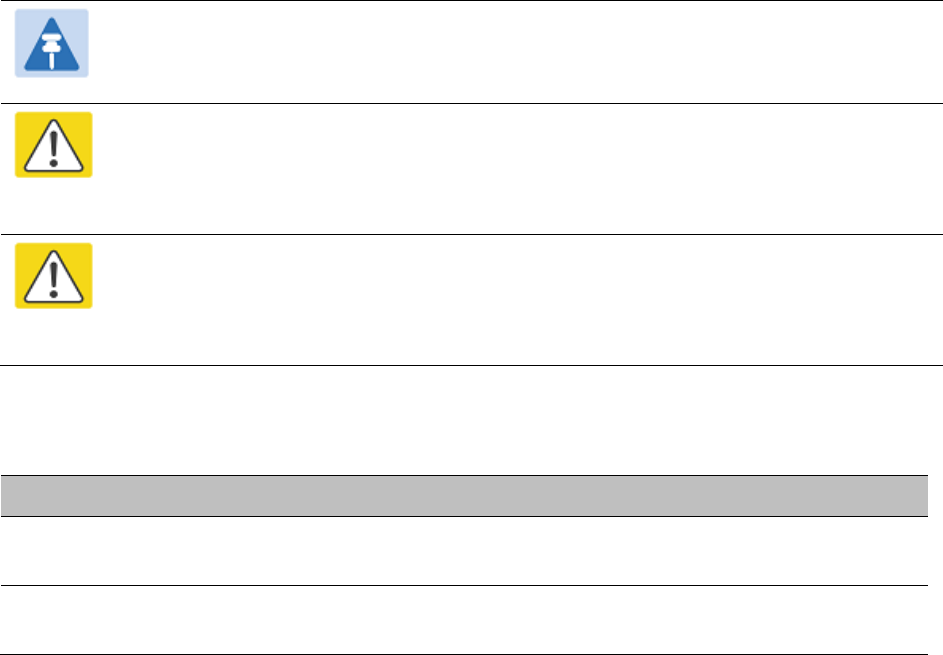
Chapter 1: Product description System management
Software upgrade
The management agent supports application software upgrade using either the web-based
interface or the SNMP interface.
PTP 650 software images are digitally signed, and the ODU will accept only images that contain a
valid Cambium Networks digital signature. The ODU always requires a reboot to complete a
software upgrade.
Note
Obtain the application software and this user guide from the support website BEFORE
warranty expires.
Caution
ODU software version must be the same at both ends of the link. Limited operation
may sometimes be possible with dissimilar software versions, but such operation is
not supported by Cambium Networks.
Caution
Take care when upgrading ODU software using the wireless link to a remote ODU.
Upgrade the remote unit first, reboot the remote ODU, and then upgrade the local
unit to the same software version.
Further reading
For information about…
Refer to…
How to upgrade the software using the web
interface
Software Upgrade page on page 6-52
How to upgrade software remotely using
Trivial FTP (TFTP) triggered by SNMP
Upgrading software using TFTP on page 6-111
UNDER DEVELOPMENT
Page 1-49

Chapter 1: Product description System management
Capability upgrades
ODUs are shipped with a default License Key factory-installed. The default license key enables a
limited set of capabilities which depend upon the ODU variant.
Capability upgrades are purchased from Cambium and supplied as access keys. The user then
enters the access key into the PTP License Key Generator web page on the support website.
The License Key Generator creates a new license key and delivers it by email. The user then
installs the license key using the ODU web interface. License keys are bound to a single ODU and
are not transferrable.
Further reading
For information about…
Refer to…
Capabilities of the PTP 650 PTP 650 Integrated or Connectorized ODU on page 2-2
Capabilities of the PTP 650S PTP 650S Integrated ODU on page 2-6
Capabilities of the PTP 650L PTP 650L Integrated ODU on page 2-8
Ordering capability upgrades ODU capability upgrades on page 2-9
How to obtain License Keys Generating license keys on page 6-3
How to install capability upgrades Software License Key page on page 6-11
Full capability trial period
A full capability trial period is available for PTP 650 Integrated and PTP 650 Connectorized units
that are licensed for “Lite” (up to 125 Mbps) or “Mid” (up to 250 Mbps) data throughput capability.
This trial allows the ODU to operate with “Full” capability (up to 450 Mbps) during a 60 day period,
reverting to the Lite or Mid capability afterwards. The trial period can be started, paused and
resumed from the web interface.
The PTP 650S Integrated ODU always has “Full” capability in a link with range less than 2 km (1.25
miles). The trial period can be used to operate a PTP 650S ODU at “Full” capacity in longer links
during the 60 day period.
The PTP 650L Integrated ODU always has Full capability, therefore the trial period is not available.
Further reading
For information about…
Refer to…
How to control the trial period Software License Key page on page 6-11
UNDER DEVELOPMENT
Page 1-50

Chapter 1: Product description System management
Recovery mode
The PTP 650 recovery mode provides a means to recover from serious configuration errors
including lost or forgotten passwords and unknown IP addresses.
Recovery mode also allows new main application software to be loaded even when the integrity of
the existing main application software image has been compromised. The most likely cause of an
integrity problem with the installed main application software is where the power supply has been
interrupted during an earlier software upgrade.
The ODU operates in recovery mode in the following circumstances:
• When a checksum error occurs for the main application software image.
• When a power on, power off, power on cycle is applied to the ODU with the power off period
being around 5sec.
Recovery mode supports a single IPv4 interface, with IP address 169.254.1.1. Recovery mode does
not support IPv6.
Note
When Recovery has been entered through a power on/off/on cycle, the ODU will revert
to normal operation if no web access has been made to the unit within 30 seconds.
This prevents the unit remaining inadvertently in recovery following a power outage.
Recovery mode options
Options in recovery mode (IPv4 only) are as follows:
• Load new main application software.
• Reset all configuration data. This option resets IP and Ethernet configuration, and erases
(zeroizes) critical security parameters.
• Reset IP and Ethernet configuration.
• Erase (zeroize) critical security parameters.
• Reboot with existing software and configuration.
If recovery mode has been entered because of a checksum error, after a 30 second wait the ODU
will attempt to reboot with existing software and configuration.
The recovery software image is installed during manufacture of the ODU and cannot be upgraded
by operators.
Further reading
For information about…
Refer to…
How to recover from configuration errors or
software image corruption
Recovery mode on page 7-60
UNDER DEVELOPMENT
Page 1-51

Chapter 2: System hardware
This chapter describes the hardware components of a PTP 650 link.
The following topics are described in this chapter:
• Outdoor unit (ODU) on page 2-2
• Power supply units (PSU) on page 2-16
• Antennas and antenna cabling on page 2-21
• Ethernet cabling on page 2-36
• PTP-SYNC unit on page 2-46
• GPS receiver on page 2-52
• Network indoor unit (NIDU) on page 2-54
UNDER DEVELOPMENT
Page 2-1

Chapter 2: System hardware Outdoor unit (ODU)
Outdoor unit (ODU)
ODU description
One ODU is required for each link end. The ODU is a self-contained transceiver unit that houses
both radio and networking electronics. There are three main types of ODU (described below):
• The standard PTP 650 Integrated or Connectorized ODU.
• The PTP 650S Integrated ODU.
• The PTP 650L Integrated ODU.
All PTP 650, PTP 650S and PTP 650L ODUs are available in three regional variants. Each regional
variant is factory-installed to operate in different regulatory bands as follows:
• FCC/IC: regulatory bands 1 (5.8 GHz USA), 13 (5.4 GHz USA), 38 (5.2 GHz USA) and 84 (5.1 GHz
USA).
• RoW: regulatory bands 8 (5.4 GHz unrestricted) and 35 (5.8 GHz unrestricted).
• EU: regulatory band 26 (5.4 GHz ETSI).
For details of how to configure the ODUs to operate in other regulatory bands, refer to Generating
license keys on page 6-3 and Software License Key page on page 6-11. The list of available bands
depends upon the regional variant.
PTP 650 Integrated or Connectorized ODU
The standard PTP 650 Integrated or Connectorized ODU is intended for long-range difficult links
and traditional backhaul requirements where high capacity and high link budget are required. It is
supplied in two configurations:
• The PTP 650 Integrated ODU is attached to a 23 dBi flat plate antenna (Figure 5)
• The PTP 650 Connectorized ODU is intended to work with separately mounted external
antennas (Figure 6). External antennas generally have higher gains than the integrated
antennas, allowing the PTP 650 to cope with more difficult radio conditions.
The standard PTP 650 Integrated or Connectorized ODU is factory-installed with “Lite” data
throughput capability (up to 125 Mbps). It supports the following capability upgrades (see ODU
capability upgrades on page 2-9):
• Data throughput above 125 Mbps
• SFP port operation
• AES encryption
• Synchronous Ethernet and 1588 Transparent Clock
• TDM (E1 or T1) operation
• Group access
UNDER DEVELOPMENT
Page 2-2
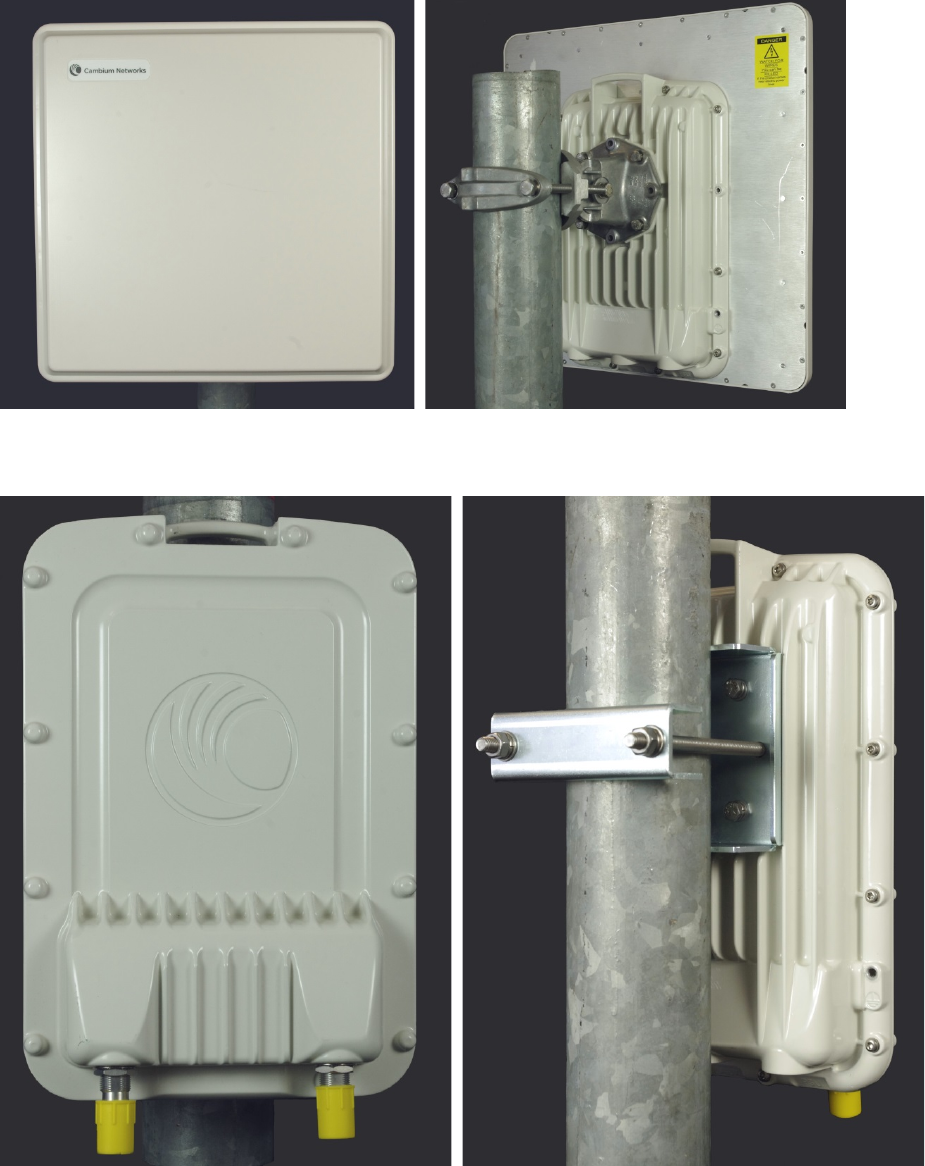
Chapter 2: System hardware Outdoor unit (ODU)
Figure 5
PTP 650 Integrated ODU (front and rear views)
Figure 6
PTP 650 Connectorized ODU (front and rear views)
UNDER DEVELOPMENT
Page 2-3

Chapter 2: System hardware Outdoor unit (ODU)
Note
To determine when to install connectorized units and to calculate their impact on link
performance and regulatory limits, see Planning for connectorized units on page 3-29.
To select antennas, RF cables and connectors for connectorized units, see Antennas and
antenna cabling on page 2-21.
Attention
Pour déterminer si il est nécessaire d’installer une liaison radiofréquence avec des
antennes externes et pour calculer leur impact sur les performances de la liaison et les
limites réglementaires, voir Planning for connectorized units page 3-29.
Pour sélectionner les antennes, câbles et connecteurs RF pour les liaisons
radiofréquence sans antenne intégrée, voir Antennas and antenna cabling page 2-21.
Full capability trial period
A full capability trial period is available for PTP 650 Integrated or Connectorized ODUs that are
licensed for “Lite” (up to 125 Mbps) or “Mid” (up to 250 Mbps) data throughput capability. This
trial allows the ODU to operate with “Full” capability (up to 450 Mbps) during a 60 day period,
reverting to Lite or Mid capability afterwards. The trial period can be started, paused and resumed
from the web interface (Software License Key page on page 6-11).
Individual ODU part numbers
Order PTP 650 Integrated or Connectorized ODUs from Cambium Networks (Table 2). Each of the
parts listed in Table 2 includes the following items:
• One 23 dBi integrated ODU or one connectorized ODU.
• With connectorized ODUs only: one connectorized ODU mounting bracket (Figure 8).
Integrated ODUs, when sold individually, are supplied without mounting brackets.
Table 2
PTP 650 Integrated or Connectorized individual
ODU part numbers
Cambium description
Cambium part number
PTP 650 (4.9 to 6.05 GHz) Integrated ODU (FCC/IC) C050065B001
PTP 650 (4.9 to 6.05 GHz) Connectorized ODU (FCC/IC) C050065B002
PTP 650 (4.9 to 6.05 GHz) Integrated ODU (RoW) C050065B003
PTP 650 (4.9 to 6.05 GHz) Connectorized ODU (RoW) C050065B004
PTP 650 (4.9 to 6.05 GHz) Integrated ODU (EU) C050065B005
PTP 650 (4.9 to 6.05 GHz) Connectorized ODU (EU) C050065B006
UNDER DEVELOPMENT
Page 2-4

Chapter 2: System hardware Outdoor unit (ODU)
ODU kit part numbers
Order PTP 650 Integrated or Connectorized ODU kits from Cambium Networks (Table 3).
Each of the parts listed in Table 3 includes the following items:
• One 23 dBi integrated ODU or one connectorized ODU.
• One integrated ODU mounting bracket (Figure 8) with a PTP 650 Integrated End kit.
• The PTP 650 Connectorized ODU already includes the connectorized bracket, so this is not
included separately in the kit.
• One PSU of the type stated in the Cambium description.
• One line cord, either US (FCC/IC) or EU (EU and RoW).
Table 3
ODU kit part numbers
Cambium description
Cambium part number
PTP 650 Connectorized END with AC Supply (FCC/IC) C050065H007
PTP 650 Connectorized END with AC+DC Enhanced Supply (FCC/IC) C050065H008
PTP 650 Integrated END with AC Supply (FCC/IC) C050065H009
PTP 650 Integrated END with AC+DC Enhanced Supply (FCC/IC) C050065H010
PTP 650 Connectorized END with AC Supply (RoW) C050065H011
PTP 650 Connectorized END with AC+DC Enhanced Supply (RoW) C050065H012
PTP 650 Integrated END with AC Supply (RoW) C050065H013
PTP 650 Integrated END with AC+DC Enhanced Supply (RoW) C050065H014
PTP 650 Connectorized END with AC Supply (EU) C050065H017
PTP 650 Connectorized END with AC+DC Enhanced Supply (EU) C050065H018
PTP 650 Integrated END with AC Supply (EU) C050065H019
PTP 650 Integrated END with AC+DC Enhanced Supply (EU) C050065H020
UNDER DEVELOPMENT
Page 2-5
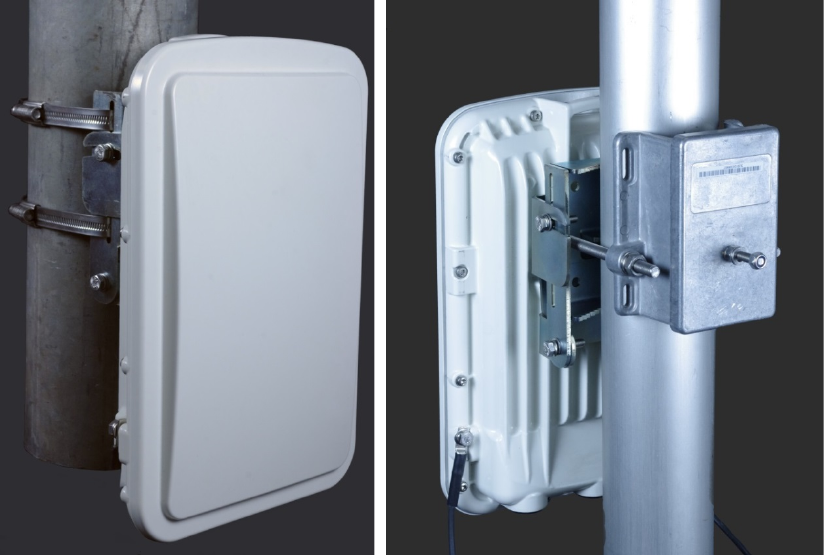
Chapter 2: System hardware Outdoor unit (ODU)
PTP 650S Integrated ODU
The PTP 650S Integrated ODU is intended for short range high capacity links. The ODU is fitted
with a small form-factor 19 dBi flat-plate integrated antenna (Figure 7). It is factory-installed with
the following capabilities:
• “Full” data throughput capability (up to 450 Mbps) for links at ranges up to 2.0 km (1.2 miles).
• “Lite” capability (up to 125 Mbps) for ranges between 2.0 km and 200 km (124 miles).
• Synchronous Ethernet.
• IEEE 1588 Transparent Clock.
The PTP 650S Integrated ODU supports the following capability upgrades upgrades (see ODU
capability upgrades on page 2-9):
• “Full” (up to 450 Mbps) data throughput capability in links at ranges above 2.0 km (1.2 miles)
• SFP port operation
• AES encryption
• TDM (E1 or T1) operation
• Group access
Figure 7
PTP 650S or PTP 650L Integrated ODU (front and rear views)
UNDER DEVELOPMENT
Page 2-6

Chapter 2: System hardware Outdoor unit (ODU)
Full capability trial period
A full capability trial period is available for PTP 650S Integrated ODUs. This trial allows the ODU to
operate with “Full” capability (up to 450 Mbps) in links at ranges above 2.0 km (1.2 miles) during a
60 day period, reverting to the default capability afterwards. The trial period can be started, paused
and resumed from the web interface (Software License Key page on page 6-11).
Individual ODU part numbers
Order PTP 650S Integrated ODUs from Cambium Networks (Table 4). Each of the parts listed in
Table 4 includes one 19 dBi integrated ODU without mounting brackets.
Table 4
PTP 650S Integrated individual
ODU part numbers
Cambium description
Cambium part number
PTP 650S (4.9 to 6.05 GHz) Integrated ODU (FCC/IC) C050065B015
PTP 650S (4.9 to 6.05 GHz) Integrated ODU (RoW) C050065B016
PTP 650S (4.9 to 6.05 GHz) Integrated ODU (EU) C050065B021
ODU kit part numbers
Order PTP 650S Integrated ODU kits from Cambium Networks (Table 5). Each of the parts listed in
Table 5 includes the following items:
• One 19 dBi integrated ODU.
• One integrated ODU mounting bracket (Figure 8).
• One PSU of the type stated in the Cambium description.
• One line cord, either US (FCC/IC) or EU (EU and RoW).
Table 5
PTP 650S Integrated ODU kit part numbers
Cambium description
Cambium part number
PTP 650S Integrated END with AC Supply (FCC/IC) C050065H022
PTP 650S Integrated END with AC+DC Enhanced Supply (FCC/IC) C050065H023
PTP 650S Integrated END with AC Supply (RoW) C050065H024
PTP 650S Integrated END with AC+DC Enhanced Supply (RoW) C050065H025
PTP 650S Integrated END with AC Supply (EU) C050065H026
PTP 650S Integrated END with AC+DC Enhanced Supply (EU) C050065H027
UNDER DEVELOPMENT
Page 2-7

Chapter 2: System hardware Outdoor unit (ODU)
PTP 650L Integrated ODU
The PTP 650L Integrated ODU is intended for enterprise access and video surveillance applications
that require data throughput up to 100 Mbps. The ODU is fitted with a small form-factor 19 dBi
flat-plate integrated antenna. Its external appearance is the same as the PTP 650S Integrated ODU
(Figure 7). Although the 650L has the Full capacity variant, capacity is necessarily limited because
of the restricted bandwidth.
It is factory-installed with the following capabilities:
• Limited to channel bandwidths of 5 MHz or 10 MHz.
• Data throughput capability up to 100 Mbps.
The PTP 650L Integrated ODU supports the following capability upgrades upgrades (see ODU
capability upgrades on page 2-9):
• Operation in channel bandwidths greater than 10 MHz
• SFP port operation
• 128-bit AES encryption (the PTP 650L does not support 256-bit AES Encryption)
• TDM (E1 or T1) operation
Full capability trial period
A full capability trial period is not available for PTP 650L Integrated ODUs.
Individual ODU part numbers
Order PTP 650L Integrated ODUs from Cambium Networks (Table 6). Each of the parts listed in
Table 6 includes one 19 dBi integrated ODU without mounting brackets.
Table 6
PTP 650L Integrated individual
ODU part numbers
Cambium description
Cambium part number
PTP 650L (4.9 to 6.05 GHz) ODU (FCC) C050065B029
PTP 650L (4.9 to 6.05 GHz) ODU (RoW) C050065B030
PTP 650L (4.9 to 6.0 GHz) ODU (EU) C050065B031
ODU kit part numbers
Order PTP 650L Integrated ODU kits from Cambium Networks (Table 7). Each of the parts listed in
Table 7 includes the following items:
• One 19 dBi integrated ODU.
• One integrated ODU mounting bracket (Figure 8).
• One PSU of the type stated in the Cambium description.
• One line cord, either US (FCC/IC) or EU (EU and RoW).
UNDER DEVELOPMENT
Page 2-8

Chapter 2: System hardware Outdoor unit (ODU)
Table 7
PTP 650L Integrated ODU kit part numbers
Cambium description
Cambium part number
PTP 650L END with AC Supply (FCC) C050065H035
PTP 650L END with AC Supply (RoW-EU Line Cord) C050065H036
PTP 650L END with AC Supply (RoW-US Line Cord) C050065H037
PTP 650L END with AC Supply (EU) C050065H038
ODU capability upgrades
To upgrade a PTP 650, PTP 650S or PTP 650L ODU to one or more new capabilities, order the
necessary access keys from Cambium Networks (Table 8). For details of how to install the
capability upgrades, refer to Generating license keys on page 6-3 and Software License Key page
on page 6-11.
Table 8
Capability upgrades available for PTP 650 Series ODUs
Cambium description (*1)
Access key
part number
PTP
650
PTP
650S
PTP
650L
SFP port enabled: access key provided in the SFP module kit
(SFP module kits on page 2-43)
n/a Yes Yes Yes
PTP 650 128-bit AES Encryption – per ODU (*2) C000065K018 Yes Yes Yes
PTP 650 256-bit AES Encryption – per ODU (*2) C000065K019 Yes Yes
PTP 650 Lite (Up to 125Mbps) to Mid (Up to 250Mbps) Link
Capacity upgrade license per ODU
C000065K021 Yes
PTP 650 Lite (Up to 125Mbps) to Full (Up to 450Mbps) Link
Capacity upgrade license per ODU
C000065K022 Yes
PTP 650 Mid (Up to 250Mbps) to Full (Up to 450Mbps) Link
Capacity upgrade license per ODU
C000065K023 Yes
PTP 650 Precise Network Timing Software License (per end)
(*3)
C000065K040 Yes
PTP 650S Upgrade Limited Range to Full Range Software
License (per end) (*4)
C000065K041 Yes
PTP 650 8-Port T1/E1 Software License (per END) C000065K049 Yes Yes Yes
PTP 650 Group Access License per END C000065K053 Yes Yes
PTP 650L 10MHz to 30MHz Upgrade License per END C000065K058 Yes
UNDER DEVELOPMENT
Page 2-9

Chapter 2: System hardware Outdoor unit (ODU)
Cambium description (*1)
Access key
part number
PTP
650
PTP
650S
PTP
650L
PTP 650L 30MHz to 45MHz Upgrade License per END C000065K059 Yes
(*1) If the Cambium description contains the words “per ODU” or “per end”, then order two
upgrades per link.
(*2) Cambium Networks will supply AES upgrades only if there is official permission to export AES
encryption to the country of operation.
(*3) This upgrade provides the Synchronous Ethernet and 1588 Transparent Clock features in
PTP 650 Integrated or PTP 650 Connectorized ODUs. These features are enabled by default in the
PTP 650S Integrated ODU.
(*4) This upgrade provides “Full” (up to 450 Mbps) throughput capability at any range up to
200 km.
ODU accessories
Spare ODU port blanking plugs are available from Cambium Networks (Table 9).
Table 9
ODU accessory part numbers
Cambium description
Cambium part number
PTP 650 Series Blanking Plug Pack (Qty 10) N000065L036
ODU mounting brackets
The integrated mounting bracket (Figure 8) and connectorized mounting bracket (Figure 9) are
used to mount the PTP 650 or PTP 650S or PTP 650L ODUs on poles with diameters in the range 50
to 75 mm (2 to 3 inches). The extended integrated mounting bracket (Figure 10) is used for
mounting an integrated or connectorized ODU on poles with a diameter of either 90 mm
(3.5 inches) or 115 mm (4.5 inches).
The large diameter extension kit (Figure 11) is be used with the integrated bracket to mount an
ODU on a pole with diameter up to 229 mm (9.0 inches). The low profile bracket (Figure 12) is used
to mount a PTP 650S or PTP 650L ODU on a pole of diameter 40 mm to 82 mm (1.6 inches to 3.2
inches) or 89 mm to 229 mm ((3.5 inches to 9.0 inches).
Before ordering ODU mounting brackets, be aware of the following:
• Individual integrated ODUs are supplied without a mounting bracket (Table 2).
• Individual connectorized ODUs are supplied with a connectorized mounting bracket (Table 2).
• ODUs in kits are supplied with an integrated or connectorized bracket, as appropriate (Table 3).
If separate ODU mounting brackets are required, order them from Cambium Networks (Table 10).
UNDER DEVELOPMENT
Page 2-10

Chapter 2: System hardware Outdoor unit (ODU)
Figure 8
ODU mounting bracket (integrated)
Figure 9
ODU mounting bracket (connectorized)
UNDER DEVELOPMENT
Page 2-11

Chapter 2: System hardware Outdoor unit (ODU)
Figure 10
ODU extended integrated mounting bracket
Figure 11
ODU large diameter extension kit
Figure 12
ODU low profile bracket
UNDER DEVELOPMENT
Page 2-12

Chapter 2: System hardware Outdoor unit (ODU)
Table 10
ODU mounting bracket part numbers
Bracket
Pole diameter
ODU variants
Bracket part
number
Mounting bracket
(integrated)
40 mm to 82 mm
(1.6 inches to 3.2 inches)
PTP 650 Integrated
PTP 650S Integrated
PTP 650L Integrated
N000065L031
Mounting bracket
(connectorized)
40 mm to 82 mm
(1.6 inches to 3.2 inches)
PTP 650 Connectorized N000065L032
Extended integrated
mounting bracket
89 mm OR 114 mm
(3.5 inches OR 4.5 inches)
PTP 650 Integrated
PTP 650S Integrated
PTP 650L Integrated
PTP 650 Connectorized
N000065L030
Mounting bracket
(integrated) with large
diameter extension kit
89 mm to 229 mm
(3.5 inches to 9.0 inches)
PTP 650 Integrated
PTP 650S Integrated
PTP 650L Integrated
PTP 650 Connectorized
N000065L031
with
N000065L042
Low profile bracket 40 mm to 82 mm
(1.6 inches to 3.2 inches)
PTP 650S Integrated
PTP 650L Integrated
N000065L039
89 mm to 229 mm
(3.5 inches to 9.0 inches)
The low profile bracket provides elevation adjustment with the PTP 650S Integrated or PTP 650L
Integrated ODU of +10° to –5° or +5° to –10°. A larger adjustment range is available using the
standard integrated mounting bracket. The connectorized mounting bracket does not provide
elevation adjustment.
ODU interfaces
The PSU, AUX and SFP ports are on the rear of the integrated and connectorized ODUs (Figure 13).
These interfaces are described in
Table 11. Each of the PSU, AUX and SFP ports can be configured to disable Ethernet traffic or to
carry the following Ethernet traffic:
• Wireless bridge data
• Wireless bridge data and in-band management
• Out-of-band local management
• Local loop-back between any two ports
UNDER DEVELOPMENT
Page 2-13
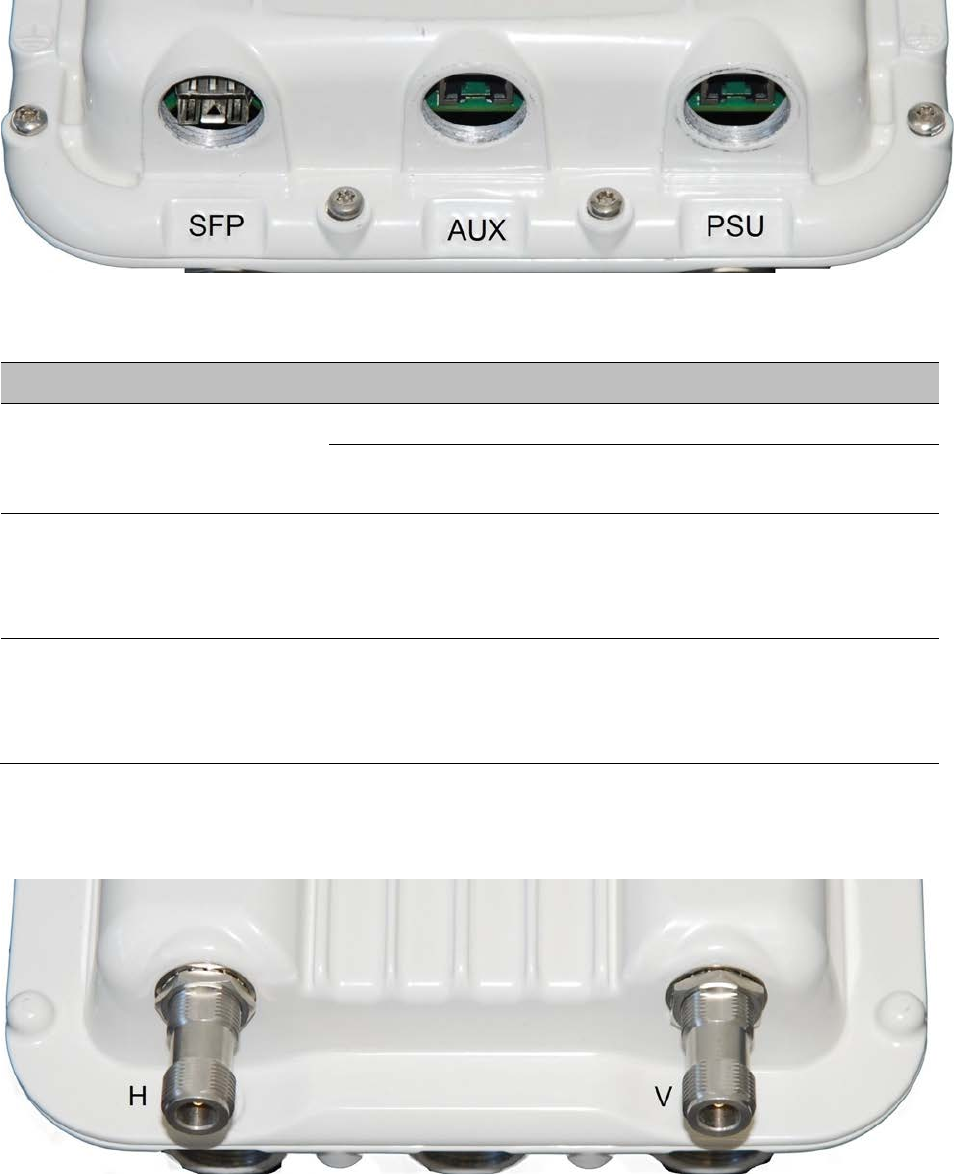
Chapter 2: System hardware Outdoor unit (ODU)
Figure 13
ODU rear interfaces
Table 11
ODU rear interfaces
Port name
Connector
Interface
Description
Main PSU RJ45 POE input Proprietary power over Ethernet (POE).
100/1000BASE-T
Ethernet
Management and/or data.
AUX RJ45 100/1000BASE-T
Ethernet with
802.3at compliant
POE out capability
Auxiliary Ethernet port which can be
used, for example, to connect and
power a video camera or wireless
access point.
SFP SFP Optical or Copper
Gigabit Ethernet
OOB management, user data, user data
with IB management, ODU-to-ODU.
Plug-in SFP module must be purchased
separately.
The front of the connectorized ODU (Figure 14) provides N type female connectors for RF cable
interfaces to antennas with horizontal (H) and vertical (V) polarization.
Figure 14
Connectorized ODU antenna interfaces
UNDER DEVELOPMENT
Page 2-14

Chapter 2: System hardware Outdoor unit (ODU)
ODU specifications
The PTP 650 ODU conforms to the specifications listed in Table 13. 12
Table 13
ODU specifications
Category
Specification
Dimensions 23 dBi integrated: 371 mm (14.6 in) x 371 mm (14.6 in) x 81 mm (3.2 in)
19 dBi integrated:
Connectorized: 204 mm (8.0 in) x 318 mm (12.5 in) x 90 mm (3.5 in)
Weight 23 dBi integrated: 4.1 Kg (9.0 lbs) including bracket
19 dBi integrated:
Connectorized: 3.1 Kg (6.8 lbs) including bracket
Temperature -40°C (-40°F) to +60°C (140°F)
Wind loading 200 mph (323 kph) maximum. See ODU wind loading on page 3-14.
Humidity 100% condensing
Liquid and particle
ingress
IP66, IP67
UV exposure 10 year operational life (UL746C test evidence)
Static discharge See Electromagnetic compatibility (EMC) compliance on page 4-22
UNDER DEVELOPMENT
Page 2-15
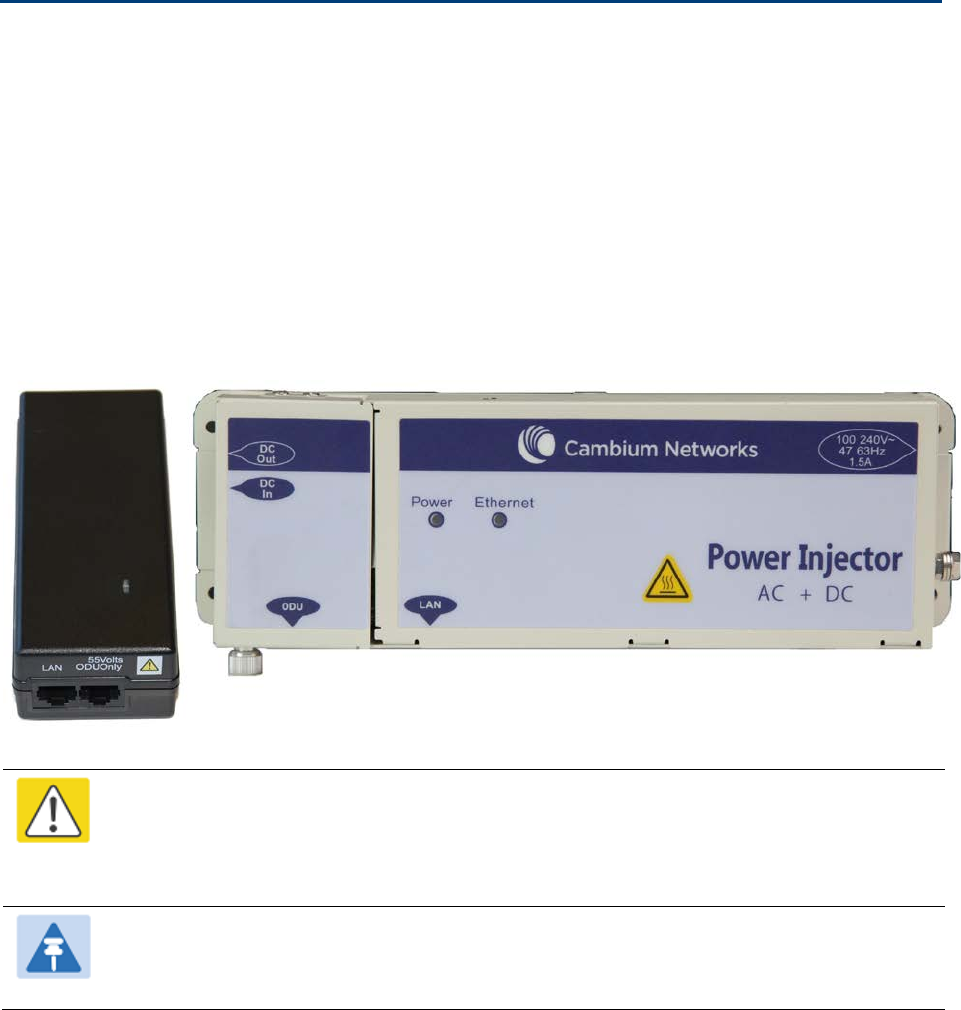
Chapter 2: System hardware Power supply units (PSU)
Power supply units (PSU)
PSU description
The PSU is an indoor unit that is connected to the ODU and network terminating equipment using
Cat5e cable with RJ45 connectors. It is also plugged into an AC or DC power supply so that it can
inject Power over Ethernet (POE) into the ODU. Choose one of the following PSUs (Figure 15):
• The AC Power Injector (left) accepts an AC input supply only.
• The AC+DC Enhanced Power Injector (right) accepts both AC and DC input, tolerates a greater
temperature range, and allows the ODU to support a device on the Aux port, such as a video
camera or wireless access point. It also allows the ODU to provide DC power output.
Figure 15
PSU 650 PSUs
Caution
The PSU ODU ports are designed to connect only to PTP 650 ODUs, PTP-SYNC units,
NIDUs or LPUs. Do not connect any other equipment, as damage may occur.
Do not connect the PIDU Plus PTP 300/500/600 Series to the PTP 650 ODU or LPU.
Note
Each of the ODU kits listed in Table 3 includes one PSU and one US or EU line cord as
stated in the Cambium description.
UNDER DEVELOPMENT
Page 2-16
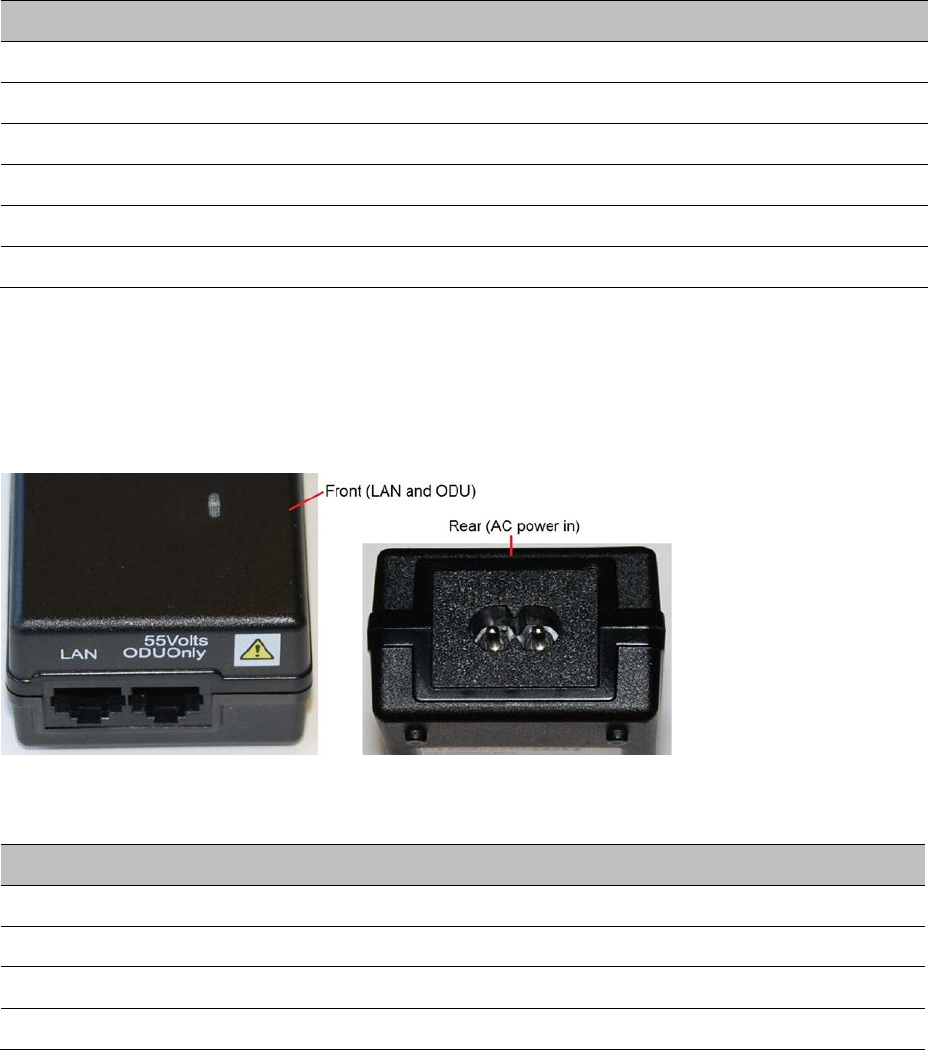
Chapter 2: System hardware Power supply units (PSU)
PSU part numbers
Order PSUs and (for AC power) line cords from Cambium Networks (Table 14).
Table 14
Power supply component part numbers
Cambium description
Cambium part number
PTP 650 AC Power Injector N000065L001
PTP 650 AC+DC Enhanced Power Injector C000065L002
US Line Cord Fig 8 N000065L003
UK Line Cord Fig 8 N000065L004
EU Line Cord Fig 8 N000065L005
Australia Line Cord Fig 8 N000065L006
AC Power Injector interfaces
The AC Power Injector interfaces are shown in Figure 16 and described in Table 15.
Figure 16
AC Power Injector interfaces
Table 15
AC Power Injector interface functions
Interface
Function
AC power in AC power input (main supply).
ODU RJ45 socket for connecting Cat5e cable to ODU.
LAN RJ45 socket for connecting Cat5e cable to network.
Power (green) LED Power supply detection
UNDER DEVELOPMENT
Page 2-17
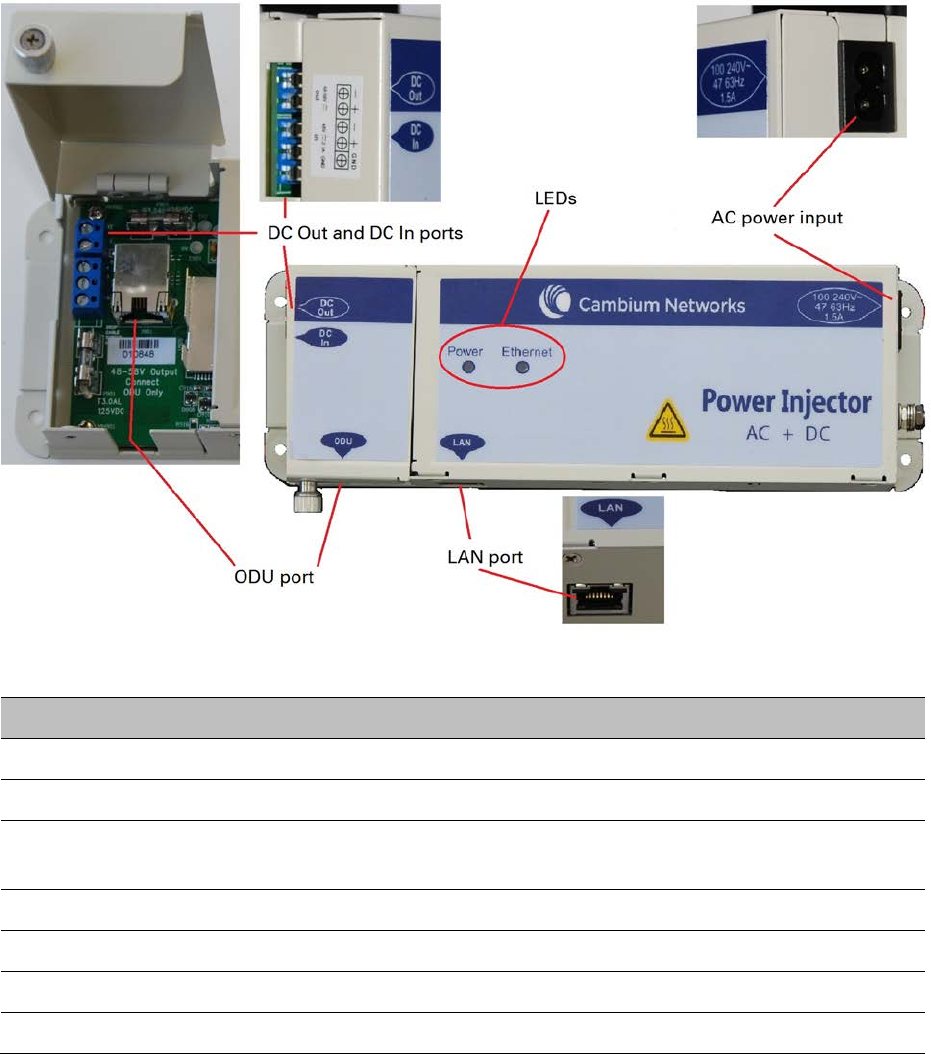
Chapter 2: System hardware Power supply units (PSU)
AC+DC Enhanced Power Injector interfaces
The AC+DC Enhanced Power Injector interfaces are shown in Figure 17 and described in Table 16.
Figure 17
AC+DC Enhanced Power Injector interfaces
Table 16
AC+DC Enhanced Power Injector interface functions
Interface
Function
100-240V 47-63Hz 1.5A AC power input (main supply).
DC In Alternative DC power supply input.
DC Out DC power output to a second PSU (for power supply redundancy) or
to a NIDU.
ODU RJ45 socket for connecting Cat5e cable to ODU.
LAN RJ45 socket for connecting Cat5e cable to network.
Power (green) LED Power supply detection
Ethernet (yellow) LED Ethernet traffic detection
UNDER DEVELOPMENT
Page 2-18

Chapter 2: System hardware Power supply units (PSU)
PSU specifications
The PTP 650 AC Power Injector conforms to the specifications listed in Table 17.
The PTP 650 AC+DC Enhanced Power Injector conforms to the specifications listed in Table 18.
Table 17
AC Power Injector
specifications
Category
Specification
Dimensions 137 mm (5.4 in) x 56 mm (2.2 in) x 38 mm (1.5 in)
Weight 0.240 Kg (0.5 lbs)
Temperature 0°C to +40°C
Humidity 90% non-condensing
Waterproofing Not waterproof
Altitude Sea level to 5000 meters (16000 ft)
AC Input Min 90 V AC, 57 – 63 Hz, max 264 V AC, 47 – 53 Hz.
DC output voltage to the ODU 55V +/- 5%
AC connector IEC-320-C8
Efficiency Better than 85%, efficiency level ‘V’
Over Current Protection Hiccup current limiting, trip point set between 120% to
150% of full load current
Hold up time At least 10 milliseconds
UNDER DEVELOPMENT
Page 2-19

Chapter 2: System hardware Power supply units (PSU)
Table 18
AC+DC Enhanced Power Injector
specifications
Category
Specification
Dimensions 250 mm (9.75 in) x 40 mm (1.5 in) x 80 mm (3 in)
Weight 0.864 Kg (1.9 lbs)
Temperature -40°C (-40°F) to +60°C (140°F)
Humidity 0 to 90% non-condensing
Waterproofing Not waterproof
AC Input 90-264 V AC, 47-60 Hz
Alternative DC Input 37-60 V DC
DC Output Voltage
For mains input: 58 V, +2V, -0V
For DC input: Output voltage at maximum rated output
current, not more than 1.5 V below the DC input voltage.
Maximum length of DC output cable: 3 meters.
AC Input connector IEC-320-C8
DC Output current 1.7A
Efficiency Better than 84%
Over Current Protection Hiccup current limiting, trip point set between 120% to
150% of full load current
Hold up time At least 20 milliseconds
Power factor Better than 0.9
UNDER DEVELOPMENT
Page 2-20

Chapter 2: System hardware Antennas and antenna cabling
Antennas and antenna cabling
Antenna requirements
Each connectorized ODU requires one external antenna (normally dual-polar), or if spatial diversity
is required, each ODU requires two antennas. These antennas are not supplied by Cambium
Networks.
For connectorized units operating in the USA or Canada 4.9 GHz, 5.1 GHz, 5.2 GHz, 5.4 GHz or
5.8 GHz bands, choose external antennas from those listed in FCC and IC approved antennas on
page 2-22. Do not install any other antennas. For links in other countries, the listed antennas are
advisory, not mandatory.
Note
To determine when to install connectorized units and to calculate their impact on link
performance and regulatory limits, see Planning for connectorized units on page 3-29.
RF cable and connectors
RF cable of generic type LMR-400 is required for connecting the ODU to the antenna. N type male
connectors are required for connecting the RF cables to the connectorized ODU. Two connectors
are required per ODU. Use weatherproof connectors, preferably ones that are supplied with
adhesive lined heat shrink sleeves that are fitted over the interface between the cable and
connector. Order CNT-400 RF cable and N type male connectors from Cambium Networks (Table
19).
Table 19
RF cable and connector part numbers
Cambium description
Cambium part number
50 Ohm Braided Coaxial Cable - 75 meter 30010194001
50 Ohm Braided Coaxial Cable - 500 meter 30010195001
RF Connector, N, Male, Straight for CNT-400 Cable 09010091001
Note
To select the correct connectors for the antenna end of the RF cable, refer to the
antenna manufacturer’s instructions.
UNDER DEVELOPMENT
Page 2-21

Chapter 2: System hardware Antennas and antenna cabling
Antenna accessories
Connectorized ODUs require the following additional components:
• Cable grounding kits: Order one cable grounding kit for each grounding point on the antenna
cables. Refer to Cable grounding kit on page 2-38 for specifications and part numbers.
• Self-amalgamating and PVC tape: Order these items to weatherproof the RF connectors.
• Lightning arrestors: When the connectorized ODU is mounted indoors, lightning arrestors (not
PTP 650 LPUs) are required for protecting the antenna RF cables at building entry. One arrestor
is required per antenna cable. One example of a compatible lightning arrestor is the
Polyphaser LSXL-ME or LSXL (not supplied by Cambium Networks).
FCC and IC approved antennas
For connectorized units operating in the USA or Canada, choose external antennas from Table 20
(4.9 GHz), Table 21 (5.1 GHz – USA only), Table 22 (5.2 GHz), Table 23 (5.4 GHz) or Table 24
(5.8 GHz). These are approved by the FCC for use with the product and are constrained by the
following limits for single- or dual-polarization parabolic dish antennas:
• 4.9 GHz – 36.0 dBi per polarization or antenna.
• 5.1 GHz - 34.5 dBi per polarization or antenna.
• 5.2 GHz - 34.9 dBi per polarization or antenna.
• 5.4 GHz - 34.9 dBi per polarization or antenna.
• 5.8 GHz - 37.7 dBi per polarization or antenna.
Details of the regulatory bands are provided in Table 55 on page 3-22.
Caution
Antennas not included in these tables are strictly prohibited for use with the PTP 650
in the specified bands.
Caution
This radio transmitter (IC certification number 109AO-50650) has been approved by
Industry Canada to operate with the antenna types listed below with the maximum
permissible gain and required antenna impedance for each antenna type indicated.
Antenna types not included in this list, having a gain greater than the maximum gain
indicated for that type, are strictly prohibited for use with this device.
UNDER DEVELOPMENT
Page 2-22
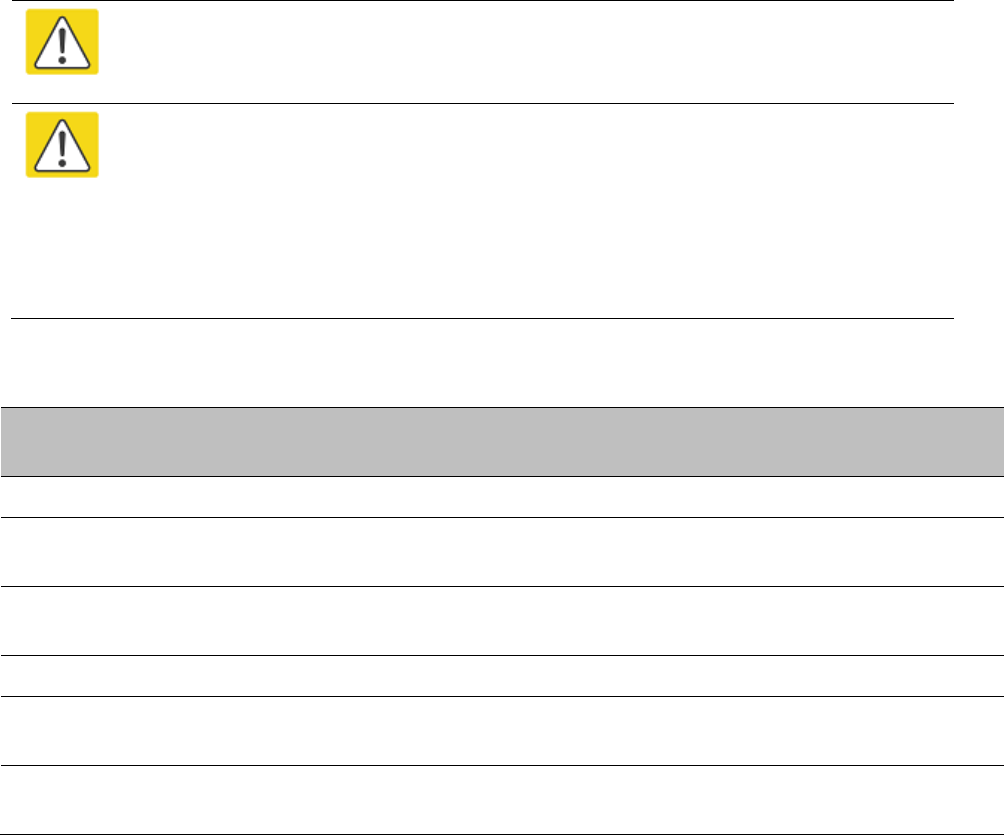
Chapter 2: System hardware Antennas and antenna cabling
Antennes approuvées par la FCC et IC
Pour les unités sans antenne intégrée destinées aux Etats-Unis ou au Canada, choisissez des
antennes externes dans la Table 20 (4.9 GHz), Table 21 (5.1 GHz – Etats-Unis), Table 22 (5.2 GHz),
Table 23 (5.4 GHz) ou la Table 24 (5.8 GHz). Celles-ci sont approuvées par la FCC pour une
utilisation avec le produit et sont limitées pour les antennes paraboliques a polarisation simple ou
double comme suit:
• 4.9 GHz – 36.0 dBi par polarisation ou l'antenne.
• 5.1 GHz - 34.5 dBi par polarisation ou l'antenne.
• 5.2 GHz - 34.9 dBi par polarisation ou l'antenne.
• 5.4 GHz - 34.9 dBi par polarisation ou l'antenne.
• 5.8 GHz - 37.7 dBi par polarisation ou l'antenne.
Attention
Les antennes qui ne sont pas listées dans ces tableaux sont strictement interdites
d’utilisation avec le PTP 650 dans les bandes spécifiées
Attention
Le présent émetteur radio (Numéro de certification IC 109AO-50650) a été approuvé
par Industrie Canada pour fonctionner avec les types d'antenne énumérés ci-dessous
et ayant un gain admissible maximal et l'impédance requise pour chaque type
d'antenne. Les types d'antenne non inclus dans cette liste, ou dont le gain est
supérieur au gain maximal indiqué, sont strictement interdits pour l'exploitation de
l'émetteur.
Table 20
Antennas permitted for deployment in USA/Canada – 4.9 GHz
Manufacturer
Antenna type
Nominal
gain (dBi)
Parabolic
dish
Cambium part
number
RadioWaves Radio Waves 6-foot Parabolic, SP6-5.2 36 Y
RadioWaves Radio Waves 6-foot Dual-Pol Parabolic,
SPD6-5.2
35.7 Y RDH4506B
RadioWaves Radio Waves 6-foot Dual-Pol Parabolic,
SPD6-4.7
35.6 Y RDH4502A
RadioWaves Radio Waves 6-foot Parabolic, SP6-4.7 35.6 Y
RadioWaves Radio Waves 6-foot Dual-Pol Parabolic,
HPD6-5.2NS
35.6 Y RDH4511B
RadioWaves Radio Waves 6-foot Dual-Pol Parabolic,
HPD6-4.7
35.4 Y RDH4515A
UNDER DEVELOPMENT
Page 2-23

Chapter 2: System hardware Antennas and antenna cabling
Manufacturer
Antenna type
Nominal
gain (dBi)
Parabolic
dish
Cambium part
number
RadioWaves Radio Waves 4-foot Dual-Pol Parabolic,
SPD4-4.7
32.6 Y RDH4501A
RadioWaves Radio Waves 4-foot Parabolic, SP4-4.7 32.6 Y N000000D002A
RadioWaves Radio Waves 4-foot Dual-Pol Parabolic,
SPD4-5.2
32.6 Y RDH4505B
RadioWaves Radio Waves 4-foot Dual-Pol Parabolic,
HPD4-5.2NS
32.6 Y RDH4510B
RadioWaves Radio Waves 4-foot Parabolic, SP4-5.2 32.6 Y
RadioWaves Radio Waves 4-foot Dual-Pol Parabolic,
HPD4-4.7
32.4 Y RDH4516A
RadioWaves Radio Waves 3-foot Dual-Pol Parabolic,
HPD3-5.2NS
32.3 Y RDH4509B
RadioWaves Radio Waves 3-foot Parabolic, SP3-5.2 31.4 Y RDH4513B
RadioWaves Radio Waves 3-foot Dual-Pol Parabolic,
SPD3-5.2
31.1 Y RDH4504B
RadioWaves Radio Waves 3-foot Dual-Pol Parabolic,
SPD3-4.7
30 Y RDH4500A
RadioWaves Radio Waves 3-foot Parabolic, SP3-4.7 30 Y N000000D005A
RadioWaves Radio Waves 3-foot Dual-Pol Parabolic,
HPD3-4.7
29.8 Y RDH4517A
Gabriel Gabriel 2.5-foot Standard Dual QuickFire
Parabolic, QFD2.5-49-N
29.7 Y
Gabriel Gabriel 2.5-foot Standard QuickFire
Parabolic, QF2.5-49-N
29.7 Y
RadioWaves Radio Waves 2-foot Parabolic, SP2-5.2 29 Y
RadioWaves Radio Waves 2-foot Dual-Pol Parabolic,
HPD2-5.2NS
28.8 Y RDH4508B
MTI MTI 2-foot Dual-Pol, MT-486013/N 28.5 Y
MTI MTI 2-foot Single-Pol, MT-466009/N 28.5 Y
RadioWaves Radio Waves 2-foot Dual-Pol Parabolic,
SPD2-5.2
28.1 Y RDH4503B
Gabriel Gabriel 2-foot Standard Dual QuickFire
Parabolic, QFD2-49-N
27.7 Y
UNDER DEVELOPMENT
Page 2-24

Chapter 2: System hardware Antennas and antenna cabling
Manufacturer
Antenna type
Nominal
gain (dBi)
Parabolic
dish
Cambium part
number
Gabriel Gabriel 2-foot Standard QuickFire
Parabolic, QF2-49-N
27.7 Y
RadioWaves Radio Waves 2-foot Dual-Pol Parabolic,
SPD2-4.7
26.6 Y RDH4499A
RadioWaves Radio Waves 2-foot Parabolic, SP2-4.7 26.6 Y N000000D001A
RadioWaves Radio Waves 2-foot Dual-Pol Parabolic,
HPD2-4.7
26.4 Y RDH4518A
MARS MA-WS54-50R Flat Plate (Dual-Pol) 23 N Integrated
Andrew Andrew 1.25-foot Flat Panel Dual,
UBXP375-4-1
21 N
Andrew Andrew 1-foot Flat Panel Single, UBP300-
4-1
21 N
RadioWaves Radio Waves 1-foot Dual-Pol Parabolic,
HPLPD1-4.7
20.8 Y RDH4519A
MARS Small Form Factor Flat Plate Antenna MA-
EM56-DP19CM.
19 N Integrated
Laird 60 Sectorized (Dual-Pol) 17 N
Laird 90 Sectorized (Dual-Pol) 17 N
RadioWaves Radio Waves 90 Sectorized (Dual-Pol),
SEC-47D-90-16
16 N N000000D003
KPPA OMNI (Dual-Pol) 13 N
RadioWaves Radio Waves Omni Dual-Pol, OMND-4.8-9 9 N
UNDER DEVELOPMENT
Page 2-25

Chapter 2: System hardware Antennas and antenna cabling
Table 21
Antennas permitted for deployment in USA only – 5.1 GHz
Manufacturer
Antenna type
Nominal
gain (dBi)
Parabolic
dish
Cambium
part number
Andrew Andrew 4-foot Dual-Pol Parabolic, PX4F-
52 34.5 Y RDG4453B
Andrew Andrew 4-foot Parabolic, P4F-52 34.5 Y RDH4524A
Gabriel Gabriel 4-foot Standard QuickFire
Parabolic, QF4-52-N 34.4 Y
Gabriel Gabriel 4-foot Standard QuickFire
Parabolic, QF4-52-N-RK 34.4 Y
RadioWaves Radio Waves 4-foot Parabolic, SP4-5.2 34.4 Y
Gabriel Gabriel 4-foot Standard Dual QuickFire
Parabolic, QFD4-52-N 34.3 Y
Gabriel Gabriel 4-foot Standard Dual QuickFire
Parabolic, QFD4-52-N-RK 34.3 Y
RadioWaves Radio Waves 4-foot Dual-Pol Parabolic,
HPD4-5.2NS 34.3 Y RDH4510B
Gabriel Gabriel 4-foot High Performance
QuickFire Parabolic, HQF4-52-N 34 Y
RadioWaves Radio Waves 4-foot Dual-Pol Parabolic,
SPD4-5.2 34 Y RDH4505B
Gabriel Gabriel 4-foot High Performance Dual
QuickFire Parabolic, HQFD4-52-N 33.9 Y
RFS RFS 4-foot HP Parabolic, SDF4-52AN 33.5 Y
RFS RFS 4-foot Parabolic, SPF4-52AN 33.5 Y
Andrew Andrew 3-foot Dual-Pol Parabolic, PX3F-
52 33 Y
Andrew Andrew 3-foot Parabolic, P3F-52 33 Y
StellaDoradus StellaDoradus 4-foot Single-Pol, 56
PSD113 32 Y
RadioWaves Radio Waves 3-foot Dual-Pol Parabolic,
HPD3-5.2NS 31.9 Y RDH4509B
RadioWaves Radio Waves 3-foot Parabolic, SP3-5.2 31 Y RDH4513B
Gabriel Gabriel 2.5-foot Standard QuickFire
Parabolic, QF2.5-52-N 30.8 Y
UNDER DEVELOPMENT
Page 2-26

Chapter 2: System hardware Antennas and antenna cabling
Manufacturer
Antenna type
Nominal
gain (dBi)
Parabolic
dish
Cambium
part number
Gabriel Gabriel 2.5-foot Standard Dual QuickFire
Parabolic, QFD2.5-52-N 30.7 Y
RadioWaves Radio Waves 3-foot Dual-Pol Parabolic,
SPD3-5.2 30.7 Y RDH4504B
Andrew Andrew 2-foot Dual-Pol Parabolic, PX2F-
52 29 Y
Andrew Andrew 2-foot Parabolic, P2F-52 29 Y
MTI MTI 3-foot Single-Pol, MT-487000/N 28.6 Y
RadioWaves Radio Waves 2-foot Parabolic, SP2-5.2 28.6 Y
RadioWaves Radio Waves 2-foot Dual-Pol Parabolic,
HPD2-5.2NS 28.4 Y RDH4508B
Gabriel Gabriel 2-foot Standard QuickFire
Parabolic, QF2-52-N 28.1 Y
Gabriel Gabriel 2-foot Standard QuickFire
Parabolic, QF2-52-N-RK 28.1 Y
MTI MTI 2-foot Dual-Pol, MT-486013/N 28.1 Y
MTI MTI 2-foot Single-Pol, MT-466009/N 28.1 Y
Gabriel Gabriel 2-foot Standard Dual QuickFire
Parabolic, QFD2-52-N 28 Y
Gabriel Gabriel 2-foot Standard Dual QuickFire
Parabolic, QFD2-52-N-RK 28 Y
Gabriel Gabriel 2-foot High Performance
QuickFire Parabolic, HQF2-52-N 27.8 Y
Gabriel Gabriel 2-foot High Performance Dual
QuickFire Parabolic, HQFD2-52-N 27.7 Y
RadioWaves Radio Waves 2-foot Dual-Pol Parabolic,
SPD2-5.2 27.7 Y RDH4503B
RFS RFS 2-foot Parabolic, SPF2-52AN 27.5 Y
StellaDoradus StellaDoradus 2-foot Single-Pol, 56
PSD61 26.6 Y
MARS MA-WS54-50R Flat Plate (Dual-Pol) 23 N Integrated
MTI MTI 15 inch Dual-Pol Flat Panel, MT-
485025/NVH 23 N
UNDER DEVELOPMENT
Page 2-27

Chapter 2: System hardware Antennas and antenna cabling
Manufacturer
Antenna type
Nominal
gain (dBi)
Parabolic
dish
Cambium
part number
Andrew Andrew 1.25-foot Flat Panel Dual,
UBXP375-4-1 20.6 N
Andrew Andrew 1-foot Flat Panel Single,
UBP300-4-1 20.6 N
MARS Small Form Factor Flat Plate Antenna
Part # MA-EM56-DP19CM. 19 N Integrated
Laird 60 Sectorized (Dual-Pol) 17 N
Laird 90 Sectorized (Dual-Pol) 17 N
KPPA OMNI (Dual-Pol) 13 N
Table 22
Antennas permitted for deployment in USA/Canada – 5.2 GHz
Manufacturer
Antenna type
Nominal
gain (dBi)
Parabolic
dish
Cambium
part number
Andrew Andrew 4-foot Dual-Pol Parabolic, PX4F-
52
34.9 Y RDG4453B
Andrew Andrew 4-foot Parabolic, P4F-52 34.9 Y RDH4524A
Gabriel Gabriel 4-foot Standard QuickFire
Parabolic, QF4-52-N
34.8 Y
Gabriel Gabriel 4-foot Standard QuickFire
Parabolic, QF4-52-N-RK
34.8 Y
RadioWaves Radio Waves 4-foot Parabolic, SP4-5.2 34.8 Y
Gabriel Gabriel 4-foot Standard Dual QuickFire
Parabolic, QFD4-52-N
34.7 Y
Gabriel Gabriel 4-foot Standard Dual QuickFire
Parabolic, QFD4-52-N-RK
34.7 Y
RadioWaves Radio Waves 4-foot Dual-Pol Parabolic,
HPD4-5.2NS
34.7 Y RDH4510B
Gabriel Gabriel 4-foot High Performance
QuickFire Parabolic, HQF4-52-N
34.4 Y
RadioWaves Radio Waves 4-foot Dual-Pol Parabolic,
SPD4-5.2
34.4 Y RDH4505B
Gabriel Gabriel 4-foot High Performance Dual
QuickFire Parabolic, HQFD4-52-N
34.3 Y
UNDER DEVELOPMENT
Page 2-28

Chapter 2: System hardware Antennas and antenna cabling
Manufacturer
Antenna type
Nominal
gain (dBi)
Parabolic
dish
Cambium
part number
RFS RFS 4-foot HP Parabolic, SDF4-52AN 33.9 Y
RFS RFS 4-foot Parabolic, SPF4-52AN 33.9 Y
Andrew Andrew 3-foot Dual-Pol Parabolic, PX3F-
52
33.4 Y
Andrew Andrew 3-foot Parabolic, P3F-52 33.4 Y
StellaDoradus StellaDoradus 4-foot Single-Pol, 56
PSD113
32.4 Y
RadioWaves Radio Waves 3-foot Dual-Pol Parabolic,
HPD3-5.2NS
32.3 Y RDH4509B
RadioWaves Radio Waves 3-foot Parabolic, SP3-5.2 31.4 Y RDH4513B
Gabriel Gabriel 2.5-foot Standard QuickFire
Parabolic, QF2.5-52-N
31.2 Y
Gabriel Gabriel 2.5-foot Standard Dual QuickFire
Parabolic, QFD2.5-52-N
31.1 Y
RadioWaves Radio Waves 3-foot Dual-Pol Parabolic,
SPD3-5.2
31.1 Y RDH4504B
Andrew Andrew 2-foot Dual-Pol Parabolic, PX2F-
52
29.4 Y
Andrew Andrew 2-foot Parabolic, P2F-52 29.4 Y
MTI MTI 3-foot Single-Pol, MT-487000/N 29 Y
RadioWaves Radio Waves 2-foot Parabolic, SP2-5.2 29 Y
RadioWaves Radio Waves 2-foot Dual-Pol Parabolic,
HPD2-5.2NS
28.8 Y RDH4508B
Gabriel Gabriel 2-foot Standard QuickFire
Parabolic, QF2-52-N
28.5 Y
Gabriel Gabriel 2-foot Standard QuickFire
Parabolic, QF2-52-N-RK
28.5 Y
MTI MTI 2-foot Dual-Pol, MT-486013/N 28.5 Y
MTI MTI 2-foot Single-Pol, MT-466009/N 28.5 Y
Gabriel Gabriel 2-foot Standard Dual QuickFire
Parabolic, QFD2-52-N
28.4 Y
Gabriel Gabriel 2-foot Standard Dual QuickFire
Parabolic, QFD2-52-N-RK
28.4 Y
UNDER DEVELOPMENT
Page 2-29

Chapter 2: System hardware Antennas and antenna cabling
Manufacturer
Antenna type
Nominal
gain (dBi)
Parabolic
dish
Cambium
part number
Gabriel Gabriel 2-foot High Performance
QuickFire Parabolic, HQF2-52-N
28.2 Y
Gabriel Gabriel 2-foot High Performance Dual
QuickFire Parabolic, HQFD2-52-N
28.1 Y
RadioWaves Radio Waves 2-foot Dual-Pol Parabolic,
SPD2-5.2
28.1 Y RDH4503B
RFS RFS 2-foot Parabolic, SPF2-52AN 27.9 Y
StellaDoradus StellaDoradus 2-foot Single-Pol, 56
PSD61
27 Y
MARS MA-WS54-50R Flat Plate (Dual-Pol) 23 N Integrated
MTI MTI 15 inch Dual-Pol Flat Panel, MT-
485025/NVH
23 N
Andrew Andrew 1.25-foot Flat Panel Dual,
UBXP375-4-1
21 N
Andrew Andrew 1-foot Flat Panel Single,
UBP300-4-1
21 N
MARS Small Form Factor Flat Plate Antenna
MA-EM56-DP19CM.
19 N Integrated
Laird 60 Sectorized (Dual Pol) 17 N
Laird 90 Sectorized (Dual Pol) 17 N
KPPA OMNI (Dual-Pol) 13 N
Table 23
Antennas permitted for deployment in USA/Canada – 5.4 GHz
Manufacturer
Antenna type
Nominal
gain (dBi)
Parabolic
dish
Cambium
part number
Andrew Andrew 4-foot Dual-Pol Parabolic, PX4F-
52
34.9 Y RDG4453B
Andrew Andrew 4-foot Parabolic, P4F-52 34.9 Y RDH4524A
Gabriel Gabriel 4-foot Standard QuickFire
Parabolic, QF4-52-N
34.8 Y
Gabriel Gabriel 4-foot Standard QuickFire
Parabolic, QF4-52-N-RK
34.8 Y
RadioWaves Radio Waves 4-foot Parabolic, SP4-5.2 34.8 Y
UNDER DEVELOPMENT
Page 2-30

Chapter 2: System hardware Antennas and antenna cabling
Manufacturer
Antenna type
Nominal
gain (dBi)
Parabolic
dish
Cambium
part number
Gabriel Gabriel 4-foot Standard Dual QuickFire
Parabolic, QFD4-52-N
34.7 Y
Gabriel Gabriel 4-foot Standard Dual QuickFire
Parabolic, QFD4-52-N-RK
34.7 Y
RadioWaves Radio Waves 4-foot Dual-Pol Parabolic,
HPD4-5.2NS
34.7 Y RDH4510B
Gabriel Gabriel 4-foot High Performance QuickFire
Parabolic, HQF4-52-N
34.4 Y
RadioWaves Radio Waves 4-foot Dual-Pol Parabolic,
SPD4-5.2
34.4 Y RDH4505B
Gabriel Gabriel 4-foot High Performance Dual
QuickFire Parabolic, HQFD4-52-N
34.3 Y
RFS RFS 4-foot HP Parabolic, SDF4-52AN 33.9 Y
RFS RFS 4-foot Parabolic, SPF4-52AN 33.9 Y
Andrew Andrew 3-foot Dual-Pol Parabolic, PX3F-52
33.4 Y
Andrew Andrew 3-foot Parabolic, P3F-52 33.4 Y
StellaDoradus StellaDoradus 4-foot Single-Pol, 56
PSD113
32.4 Y
RadioWaves Radio Waves 3-foot Dual-Pol Parabolic,
HPD3-5.2NS
32.3 Y RDH4509B
RadioWaves Radio Waves 3-foot Parabolic, SP3-5.2 31.4 Y RDH4513B
Gabriel Gabriel 2.5-foot Standard QuickFire
Parabolic, QF2.5-52-N
31.2 Y
Gabriel Gabriel 2.5-foot Standard Dual QuickFire
Parabolic, QFD2.5-52-N
31.1 Y
RadioWaves Radio Waves 3-foot Dual-Pol Parabolic,
SPD3-5.2
31.1 Y RDH4504B
Andrew Andrew 2-foot Dual-Pol Parabolic, PX2F-52 29.4 Y
Andrew Andrew 2-foot Parabolic, P2F-52 29.4 Y
MTI MTI 3-foot Single-Pol, MT-487000/N 29 Y
RadioWaves Radio Waves 2-foot Parabolic, SP2-5.2 29 Y
RadioWaves Radio Waves 2-foot Dual-Pol Parabolic,
HPD2-5.2NS
28.8 Y RDH4508B
UNDER DEVELOPMENT
Page 2-31

Chapter 2: System hardware Antennas and antenna cabling
Manufacturer
Antenna type
Nominal
gain (dBi)
Parabolic
dish
Cambium
part number
Gabriel Gabriel 2-foot Standard QuickFire
Parabolic, QF2-52-N
28.5 Y
Gabriel Gabriel 2-foot Standard QuickFire
Parabolic, QF2-52-N-RK
28.5 Y
MTI MTI 2-foot Dual-Pol, MT-486013/N 28.5 Y
MTI MTI 2-foot Single-Pol, MT-466009/N 28.5 Y
Gabriel Gabriel 2-foot Standard Dual QuickFire
Parabolic, QFD2-52-N
28.4 Y
Gabriel Gabriel 2-foot Standard Dual QuickFire
Parabolic, QFD2-52-N-RK
28.4 Y
Gabriel Gabriel 2-foot High Performance QuickFire
Parabolic, HQF2-52-N
28.2 Y
Gabriel Gabriel 2-foot High Performance Dual
QuickFire Parabolic, HQFD2-52-N
28.1 Y
RadioWaves Radio Waves 2-foot Dual-Pol Parabolic,
SPD2-5.2
28.1 Y RDH4503B
RFS RFS 2-foot Parabolic, SPF2-52AN 27.9 Y
StellaDoradus StellaDoradus 2-foot Single-Pol, 56 PSD61
27 Y
MARS MA-WS54-50R Flat Plate (Dual-Pol) 23 N Integrated
MTI MTI 15 inch Dual-Pol Flat Panel, MT-
485025/NVH
23 N
Andrew Andrew 1.25-foot Flat Panel Dual,
UBXP375-4-1
21 N
Andrew Andrew 1-foot Flat Panel Single, UBP300-
4-1
21 N
MARS Small Form Factor Flat Plate Antenna MA-
EM56-DP19CM.
19 N Integrated
Laird 60 Sectorized (Dual-Pol) 17 N
Laird 90 Sectorized (Dual-Pol) 17 N
KPPA OMNI (Dual-Pol) 13 N
UNDER DEVELOPMENT
Page 2-32

Chapter 2: System hardware Antennas and antenna cabling
Table 24
Antennas permitted for deployment in USA/Canada – 5.8 GHz
Manufacturer
Antenna type
Nominal
gain (dBi)
Parabolic
dish
Cambium
part number
Gabriel Gabriel 6-foot Standard Dual QuickFire
Parabolic, QFD6-52-N
37.7 Y
Gabriel Gabriel 6-foot Standard QuickFire
Parabolic, QF6-52-N
37.7 Y
RadioWaves Radio Waves 6-foot Dual-Pol Parabolic,
HPD6-5.2NS
37.7 Y RDH4511B
RadioWaves Radio Waves 6-foot Parabolic, SP6-2/5 37.7 Y
RadioWaves Radio Waves 6-foot Parabolic, SP6-5.2 37.7 Y
Andrew Andrew 6-foot Dual-Pol Parabolic, PX6F-52
37.6 Y
Andrew Andrew 6-foot Parabolic, P6F-52 37.6 Y RDH4525A
RadioWaves Radio Waves 6-foot Dual-Pol Parabolic,
SPD6-5.2
37.5 Y RDH4506B
Gabriel Gabriel 6-foot High Performance QuickFire
Parabolic, HQF6-52-N
37.4 Y
RFS RFS 6-foot HP Parabolic, SDF6-52AN 37.4 Y
RFS RFS 6-foot Parabolic, SPF6-52AN 37.4 Y
Gabriel Gabriel 6-foot High Performance Dual
QuickFire Parabolic, HQFD6-52-N
37.3 Y
Andrew Andrew 4-foot Dual-Pol Parabolic, PX4F-52 34.9 Y RDG4453B
Andrew Andrew 4-foot Parabolic, P4F-52 34.9 Y RDH4524A
Gabriel Gabriel 4-foot Standard QuickFire
Parabolic, QF4-52-N
34.8 Y
Gabriel Gabriel 4-foot Standard QuickFire
Parabolic, QF4-52-N-RK
34.8 Y
RadioWaves Radio Waves 4-foot Parabolic, SP4-5.2 34.8 Y
Gabriel Gabriel 4-foot Standard Dual QuickFire
Parabolic, QFD4-52-N
34.7 Y
Gabriel Gabriel 4-foot Standard Dual QuickFire
Parabolic, QFD4-52-N-RK
34.7 Y
RadioWaves Radio Waves 4-foot Dual-Pol Parabolic,
HPD4-5.2NS
34.7 Y RDH4510B
UNDER DEVELOPMENT
Page 2-33

Chapter 2: System hardware Antennas and antenna cabling
Manufacturer
Antenna type
Nominal
gain (dBi)
Parabolic
dish
Cambium
part number
RadioWaves Radio Waves 4-foot Parabolic, SP4-2/5 34.6 Y
Gabriel Gabriel 4-foot High Performance QuickFire
Parabolic, HQF4-52-N
34.4 Y
RadioWaves Radio Waves 4-foot Dual-Pol Parabolic,
SPD4-5.2
34.4 Y RDH4505B
Gabriel Gabriel 4-foot High Performance Dual
QuickFire Parabolic, HQFD4-52-N
34.3 Y
RFS RFS 4-foot HP Parabolic, SDF4-52AN 33.9 Y
RFS RFS 4-foot Parabolic, SPF4-52AN 33.9 Y
Andrew Andrew 3-foot Dual-Pol Parabolic, PX3F-52 33.4 Y
Andrew Andrew 3-foot Parabolic, P3F-52 33.4 Y
StellaDoradus StellaDoradus 4-foot Single-Pol, 56
PSD113
32.4 Y
RadioWaves Radio Waves 3-foot Dual-Pol Parabolic,
HPD3-5.2NS
32.3 Y RDH4509B
RadioWaves Radio Waves 3-foot Parabolic, SP3-2/5 31.4 Y
RadioWaves Radio Waves 3-foot Parabolic, SP3-5.2 31.4 Y RDH4513B
Gabriel Gabriel 2.5-foot Standard QuickFire
Parabolic, QF2.5-52-N
31.2 Y
Gabriel Gabriel 2.5-foot Standard Dual QuickFire
Parabolic, QFD2.5-52-N
31.1 Y
RadioWaves Radio Waves 3-foot Dual-Pol Parabolic,
SPD3-5.2
31.1 Y RDH4504B
Andrew Andrew 2-foot Dual-Pol Parabolic, PX2F-52 29.4 Y
Andrew Andrew 2-foot Parabolic, P2F-52 29.4 Y
MTI MTI 3-foot Single-Pol, MT-487000/N 29 Y
RadioWaves Radio Waves 2-foot Parabolic, SP2-5.2 29 Y
RadioWaves Radio Waves 2-foot Dual-Pol Parabolic,
HPD2-5.2NS
28.8 Y RDH4508B
Gabriel Gabriel 2-foot Standard QuickFire
Parabolic, QF2-52-N
28.5 Y
Gabriel Gabriel 2-foot Standard QuickFire
Parabolic, QF2-52-N-RK
28.5 Y
UNDER DEVELOPMENT
Page 2-34

Chapter 2: System hardware Antennas and antenna cabling
Manufacturer
Antenna type
Nominal
gain (dBi)
Parabolic
dish
Cambium
part number
MTI MTI 2-foot Dual-Pol, MT-486013/N 28.5 Y
MTI MTI 2-foot Single-Pol, MT-466009/N 28.5 Y
Gabriel Gabriel 2-foot Standard Dual QuickFire
Parabolic, QFD2-52-N
28.4 Y
Gabriel Gabriel 2-foot Standard Dual QuickFire
Parabolic, QFD2-52-N-RK
28.4 Y
RadioWaves Radio Waves 2-foot Parabolic, SP2-2/5 28.3 Y
Gabriel Gabriel 2-foot High Performance QuickFire
Parabolic, HQF2-52-N
28.2 Y
Gabriel Gabriel 2-foot High Performance Dual
QuickFire Parabolic, HQFD2-52-N
28.1 Y
RadioWaves Radio Waves 2-foot Dual-Pol Parabolic,
SPD2-5.2
28.1 Y RDH4503B
RFS RFS 2-foot Parabolic, SPF2-52AN 27.9 Y
StellaDoradus StellaDoradus 2-foot Single-Pol, 56 PSD61 27 Y
MARS MA-WS54-50R Flat Plate (Dual-Pol) 23 N Integrated
MTI MTI 15 inch Dual-Pol Flat Panel, MT-
485025/NVH
23 N
RFS RFS 1-foot Flat Panel, MA0528-23AN 23 N
Andrew Andrew 1.25-foot Flat Panel Dual,
UBXP375-4-1
21 N
Andrew Andrew 1-foot Flat Panel Single, UBP300-
4-1
21 N
MARS Small Form Factor Flat Plate Antenna MA-
EM56-DP19CM.
19 N Integrated
Laird 60 Sectorized (Dual-Pol) 17 N
Laird 90 Sectorized (Dual-Pol) 17 N
KPPA OMNI (Dual-Pol) 13 N
UNDER DEVELOPMENT
Page 2-35

Chapter 2: System hardware Ethernet cabling
Ethernet cabling
Ethernet standards and cable lengths
All configurations require a copper Ethernet connection from the ODU (PSU port) to the PSU.
Advanced configurations may also require one or both of the following:
• A copper Ethernet connection from the ODU (Aux port) to an auxiliary device.
• An optical or copper Ethernet connection from the ODU (SFP port) to network terminating
equipment or a linked ODU.
Table 25 specifies, for each type of PSU and power supply, the maximum permitted PSU drop
cable length.
Table 26 specifies, for Aux and copper SFP interfaces, the Ethernet standards supported and the
maximum permitted drop cable lengths.
Note
For optical SFP interfaces, refer to SFP module kits on page 2-43 for details of the
Ethernet standards supported and maximum permitted cable lengths.
Table 25
PSU drop cable length restrictions
Type of PSU
installed
Power supply
to PSU
Ethernet
supported (*1)
Power output to
auxiliary device
Maximum cable
length (*2)
AC Power
Injector
AC mains 100BASE-TX
1000BASE-T
No 100 m (330 ft)
AC+DC
Enhanced
power injector
AC mains No (*3) No 300 m (990 ft)
48 V dc No (*3) No 300 m (990 ft)
AC mains 100BASE-TX
1000BASE-T
Yes 100 m (330 ft)
48 V dc 100BASE-TX
1000BASE-T
Yes 100 m (330 ft)
(*1) 10BASE-T is not supported by PTP 650.
(*2) Maximum length of Ethernet cable from ODU to network terminating equipment via PSU.
(*3) Ethernet is provided via optical SFP interface.
UNDER DEVELOPMENT
Page 2-36
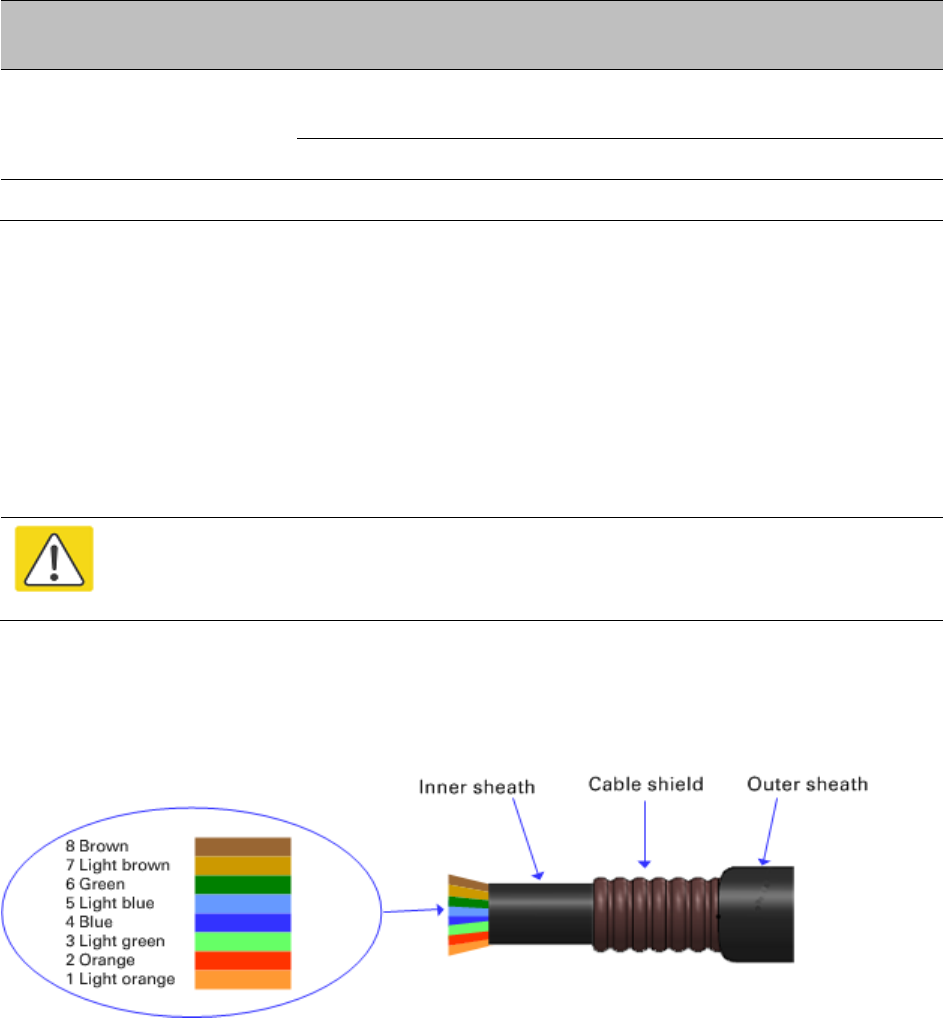
Chapter 2: System hardware Ethernet cabling
Table 26
Aux and copper SFP Ethernet standards and cable length restrictions
ODU drop cable
Power over Ethernet
Ethernet supported
(*1)
Maximum cable
length (*2)
Aux – auxiliary device
POE to auxiliary
device
100BASE-TX
1000BASE-T
100 m (330 ft)
None 100BASE-TX 100 m (330 ft)
SFP (copper) – linked device None 100BASE-TX 100 m (330 ft)
(*1) 10BASE-T is not supported by PTP 650.
(*2) Maximum length of Ethernet cable from the ODU to the linked device.
Outdoor copper Cat5e Ethernet cable
For copper Cat5e Ethernet connections from the ODU to the PSU, LPUs and other devices, use
Cat5e cable that is gel-filled and shielded with copper-plated steel, for example Superior Essex
type BBDGe. This is known as “drop cable” (Figure 18).
Caution
Always use Cat5e cable that is gel-filled and shielded with copper-plated steel.
Alternative types of drop cable are not supported by Cambium Networks.
Order Superior Essex type BBDGe cable from Cambium Networks (Table 27). Other lengths of this
cable are available from Superior Essex.
Figure 18
Outdoor drop cable
UNDER DEVELOPMENT
Page 2-37
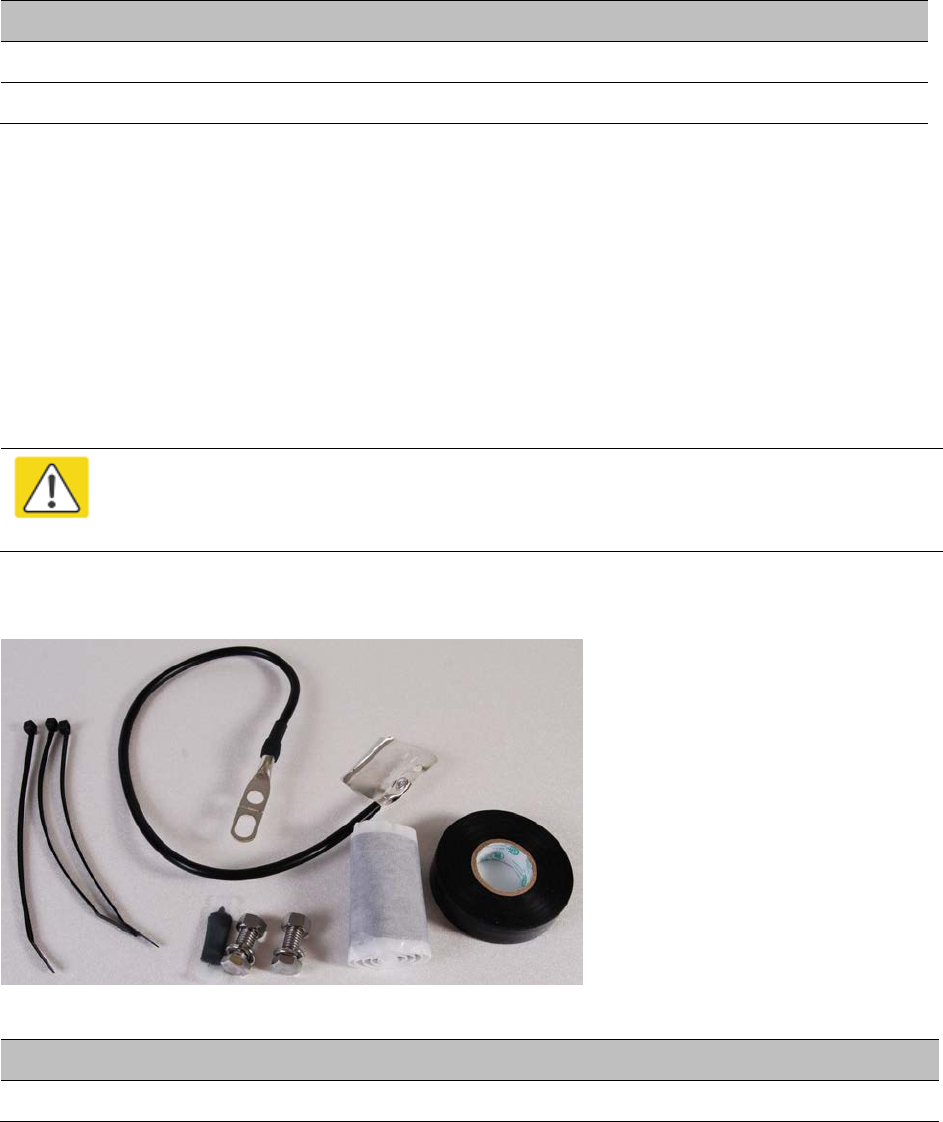
Chapter 2: System hardware Ethernet cabling
Table 27
Drop cable part numbers
Cambium description
Cambium part number
1000 ft Reel Outdoor Copper Clad CAT5E WB3175
328 ft (100 m) Reel Outdoor Copper Clad CAT5E WB3176
Cable grounding kit
Copper drop cable shields must be bonded to the grounding system in order to prevent lightning
creating a potential difference between the structure and cable, which could cause arcing, resulting
in fire risk and damage to equipment. Optical cables do not require grounding.
One grounding kit (Figure 19) is required for each grounding point on the PSU, Aux and copper
SFP drop cables. Order cable grounding kits from Cambium Networks (Table 28).
Caution
To provide adequate protection, all grounding cables must be a minimum size of 10
mm2 csa (8AWG), preferably 16 mm2 csa (6AWG), or 25 mm2 csa (4AWG).
Figure 19
Cable grounding kit
Table 28
Cable grounding kit part numbers
Cambium description
Cambium part number
Cable Grounding Kits For 1/4" And 3/8" Cable 01010419001
UNDER DEVELOPMENT
Page 2-38
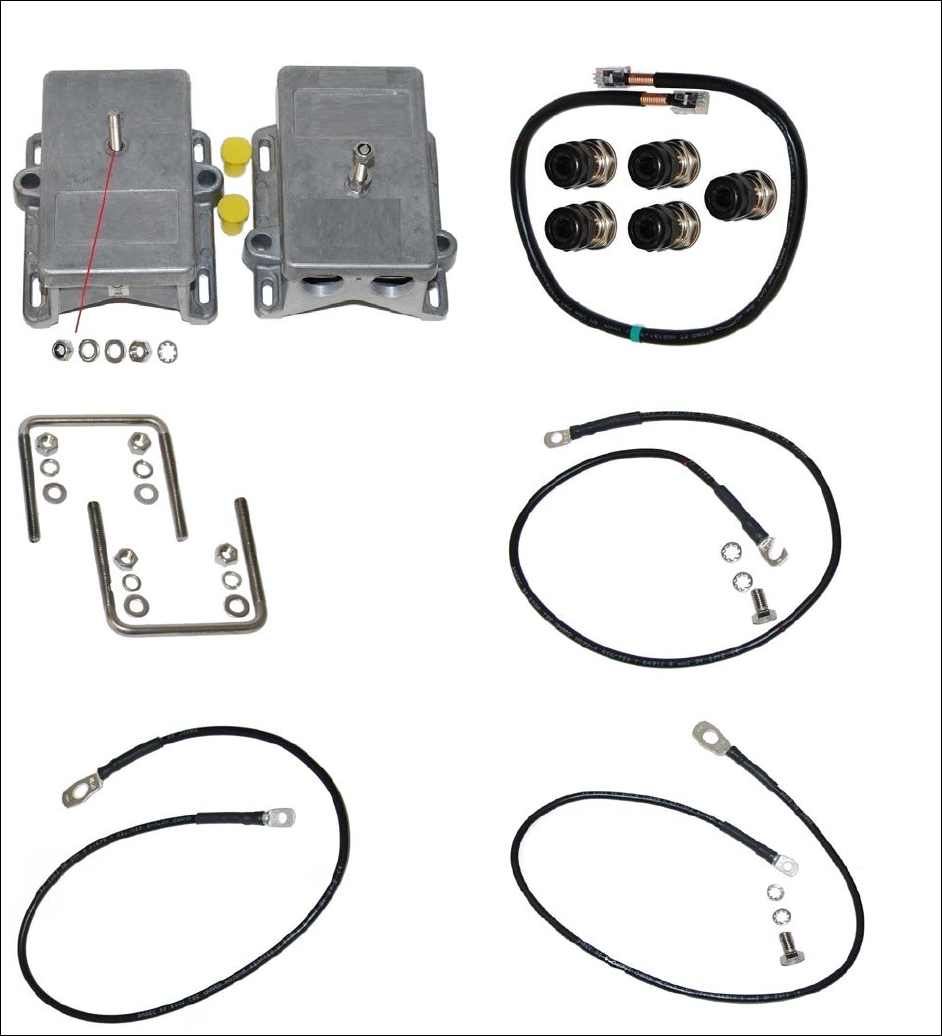
Chapter 2: System hardware Ethernet cabling
Lightning protection unit (LPU) and grounding kit
PTP 650 LPUs provide transient voltage surge suppression for PTP 650 installations. Each PSU or
Aux drop cable requires two LPUs, one near the ODU and the other near the linked device, usually
at the building entry point (Table 29).
Table 29
LPU and grounding kit contents
Lightning protection units (LPUs)
LPU grounding point nuts and washers
ODU to top LPU drop cable (600 mm)
EMC strain relief cable glands
U-bolts, nuts and washers for mounting LPUs
ODU to top LPU ground cable (M6-M6)
Bottom LPU ground cable (M6-M10)
ODU to ground cable (M6-M10
UNDER DEVELOPMENT
Page 2-39
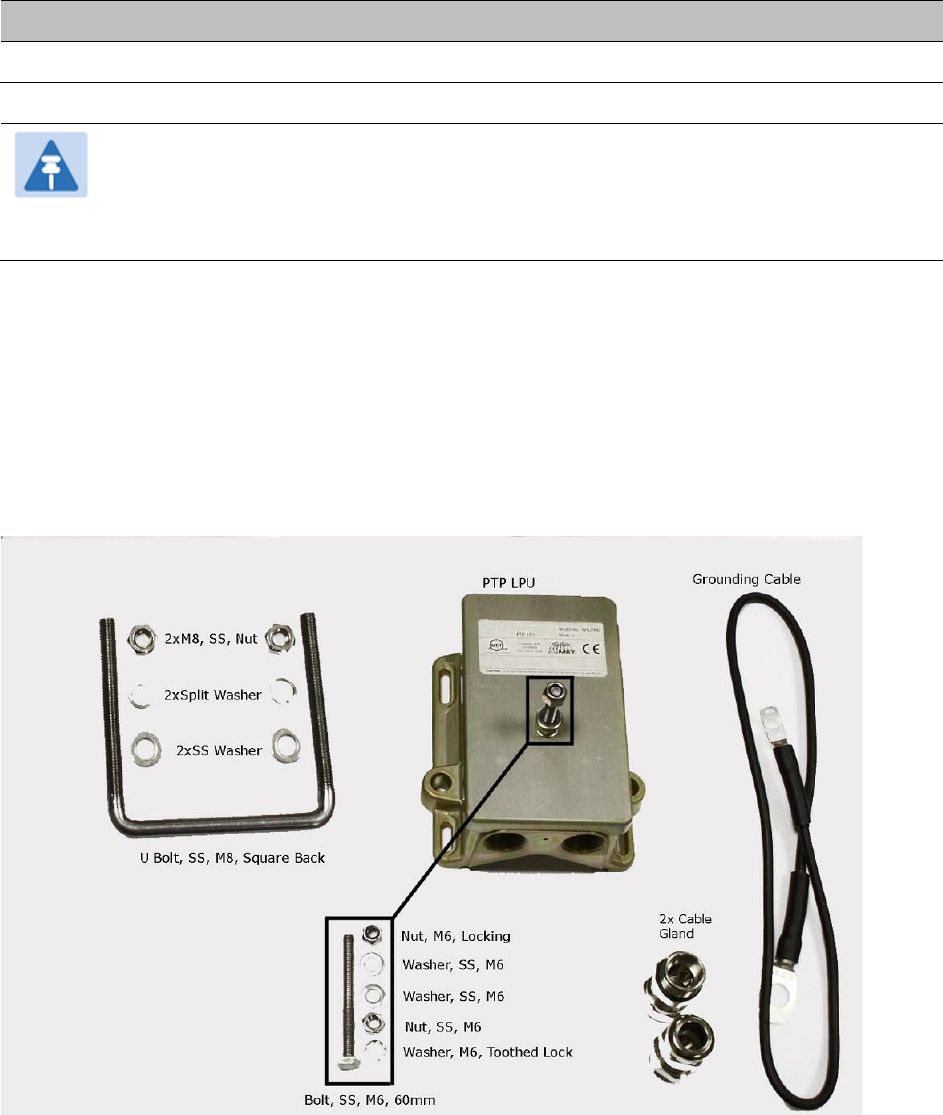
Chapter 2: System hardware Ethernet cabling
One LPU and grounding kit (Table 29) is required for the PSU drop cable connection to the ODU. If
the ODU is to be connected to an auxiliary device, one additional LPU and grounding kit is
required for the Aux drop cable. Order the kits from Cambium Networks (Table 30).
Table 30
LPU and grounding kit part number
Cambium description
Cambium part number
PTP 650 LPU and Grounding Kit C000065L007
Note
PTP 650 LPUs are not suitable for installation on SFP copper Cat5e Ethernet interfaces.
For SFP drop cables, obtain suitable surge protectors from a specialist supplier.
SFP optical Ethernet interfaces do not require surge protectors.
LPU single end kit
The LPU single end kit (Figure 20) is required for GPS drop cables, when GPS is the timing
reference source for PTP-SYNC (optional). The LPU is installed near the point at which the drop
cable enters the building.
Figure 20
LPU single end kit
UNDER DEVELOPMENT
Page 2-40
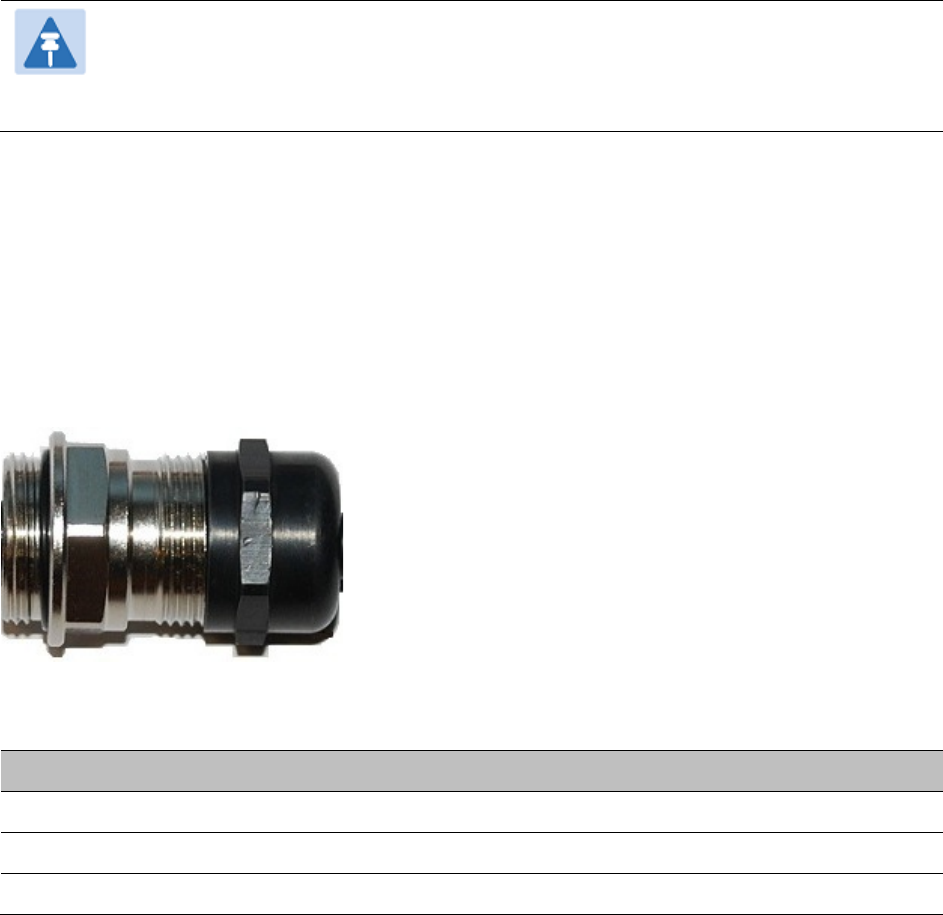
Chapter 2: System hardware Ethernet cabling
RJ45 connectors and spare glands
RJ45 connectors are required for plugging Cat5e cables into ODUs, LPUs, PSUs and other devices.
Order RJ45 connectors and crimp tool from Cambium Networks (Table 31).
Note
The RJ45 connectors and crimp tool listed in Table 31 work with Superior Essex type
BBDGe cable (as supplied by Cambium Networks). They may not work with other
types of cable.
The ODU is supplied with one environmental sealing gland for the drop cable. However, this is not
suitable when surge protection is required: EMC glands must be used instead. EMC strain relief
cable glands (quantity 5) are included in the LPU and grounding kit (Figure 21). These are identified
with a black sealing nut. If extra glands are required, order them from Cambium Networks (in
packs of 10) (Table 31).
One long EMC strain relief gland (Figure 25) is included in each SFP module kit. This is longer than
the standard cable gland as it must house an SFP module plugged into the ODU.
Figure 21
Cable gland
Table 31
RJ45 connector and spare gland part numbers
Cambium description
Cambium part number
Tyco/AMP, Mod Plug RJ45, 100 pack WB3177
Tyco/AMP Crimp Tool WB3211
RJ-45 Spare Grounding Gland - PG16 size (Qty. 10) N000065L033
UNDER DEVELOPMENT
Page 2-41
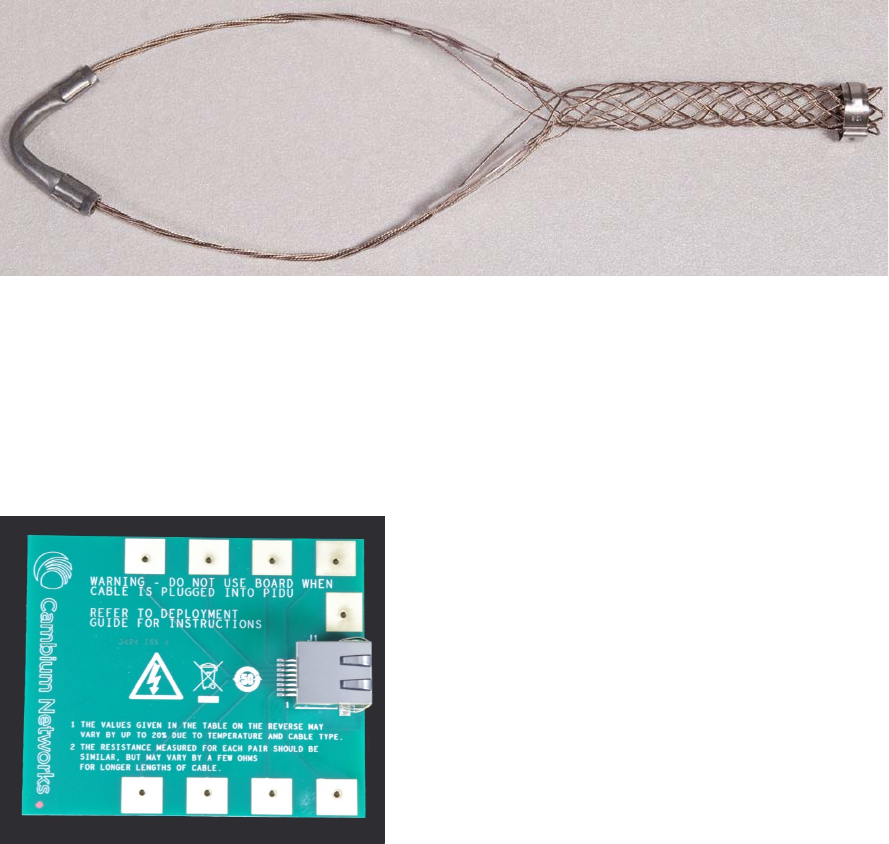
Chapter 2: System hardware Ethernet cabling
Cable hoisting grip
One or more grips are required for hoisting the drop cable up to the ODU without damaging the
gland or RJ45 plug (Figure 22). They are not supplied by Cambium Networks.
Figure 22
Cable hoisting grip
Drop cable tester
The drop cable tester is an optional item for testing the resistances between the RJ45 pins of the
drop cable (Figure 23). Order it by completing the order form on the support website (see
Contacting Cambium Networks on page 1).
Figure 23
Drop cable tester
Indoor Cat5e cable
To connect the PSU to network terminating equipment, use indoor Cat5e cable. The ODU network
connection implements automatic MDI/MDI-X sensing and pair swapping, allowing connection to
networking equipment that requires cross-over cables (MDI-X networks) or straight-through cables
(MDI Networks).
UNDER DEVELOPMENT
Page 2-42

Chapter 2: System hardware Ethernet cabling
SFP module kits
SFP module kits allow connection of a PTP 650 Series ODU to a network over a Gigabit Ethernet
interface in one of the following full-duplex modes:
• Optical Gigabit Ethernet: 1000BASE-LX or 1000BASE-SX
• Copper Gigabit Ethernet: 100BASE-TX or 1000BASE-T
Order SFP module kits from Cambium Networks (Table 32).
Table 32
SFP module kit part numbers
Cambium description
Cambium part number
PTP 650 Optical 1000BASE-LX Ethernet SFP Module C000065L008
PTP 650 Optical 1000BASE-SX Ethernet SFP Module C000065L009
PTP 650 Twisted Pair 1000BASE-T Ethernet SFP Module C000065L010
To compare the capabilities of the two optical SFP modules, refer to Table 33 and Table 34.
Table 33
Optical 1000BASE-LX Ethernet SFP Module (part number C000065L008)
Core/
cladding
(microns)
Mode
Bandwidth at
1310 nm
(MHz/km)
Maximum
length of optical
interface
Insertion loss
(dB)
62.5/125 Multi 500 550 m (1800 ft) 1.67
50/125 Multi 400 550 m (1800 ft) 0.07
50/125 Multi 500 550 m (1800 ft) 1.19
10/125 Single N/A 5000 m (16400 ft) 0.16
Table 34
Optical 1000BASE-SX Ethernet SFP Module (part number C000065L009)
Core/
cladding
(microns)
Mode
Bandwidth at
850 nm (MHz/km)
Maximum
length of optical
interface
Insertion loss
(dB)
62.5/125 Multi 160 220 m (720 ft) 2.38
62.5/125 Multi 200 275 m (900 ft) 2.6
50/125 Multi 400 500 m (1640 ft) 3.37
50/125 Multi 500 550 m (1800 ft) 3.56
UNDER DEVELOPMENT
Page 2-43
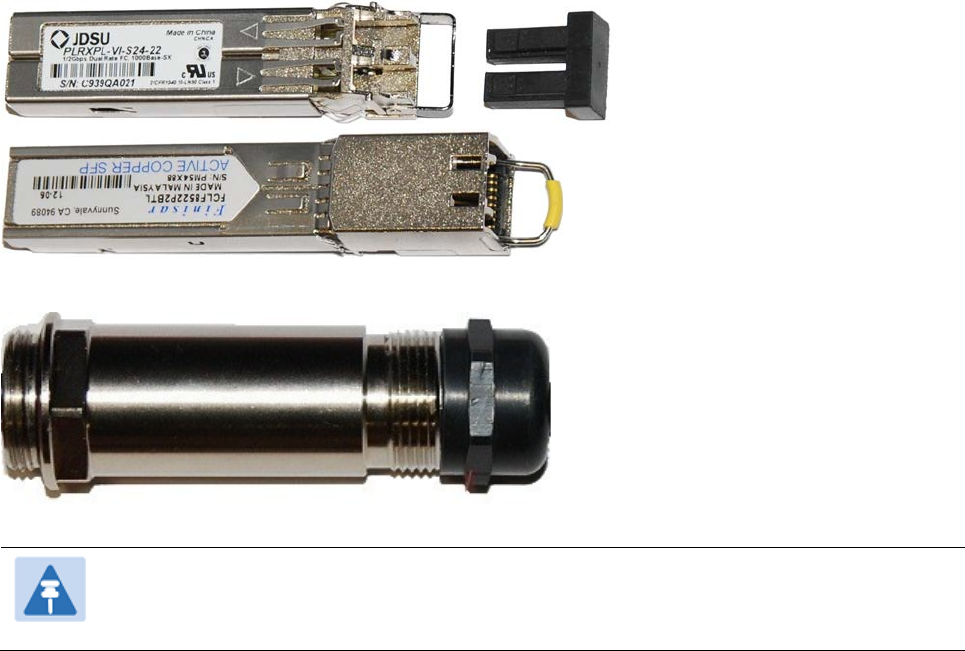
Chapter 2: System hardware Ethernet cabling
The upgrade kits contain the following components:
• Optical or copper SFP transceiver module (Figure 24)
• Long EMC strain relief cable gland (Figure 25)
• The PTP 650 Series SFP Interface Upgrade Guide
• License key instructions and unique Access Key
Figure 24
Optical or copper SFP transceiver module
Figure 25
Long cable gland
Note
PTP 650 does not support the Synchronous Ethernet or 1588 Transparent Clock features
using copper SFP transceivers.
UNDER DEVELOPMENT
Page 2-44
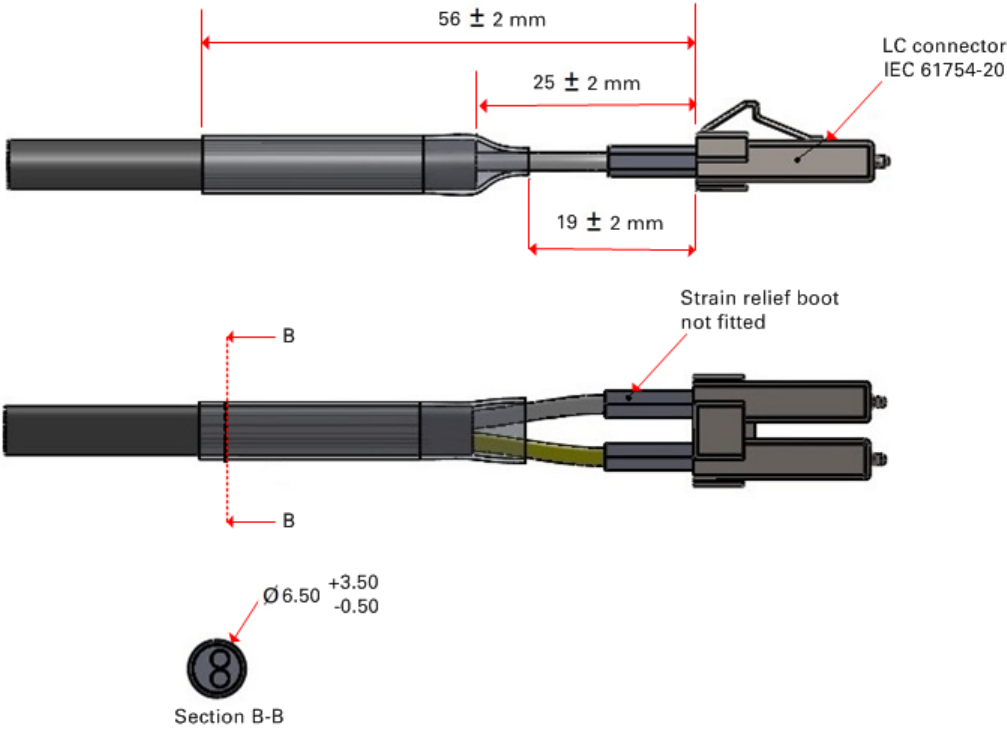
Chapter 2: System hardware Ethernet cabling
Optical cable and connectors
Order an optical cable with LC connectors from a specialist fabricator, quoting the specification
shown in Figure 26. It must be the correct length to connect the ODU to the other device. LC
connectors should be supplied with dust caps to prevent dust build up.
Figure 26
Optical optic cable and connector specification
UNDER DEVELOPMENT
Page 2-45
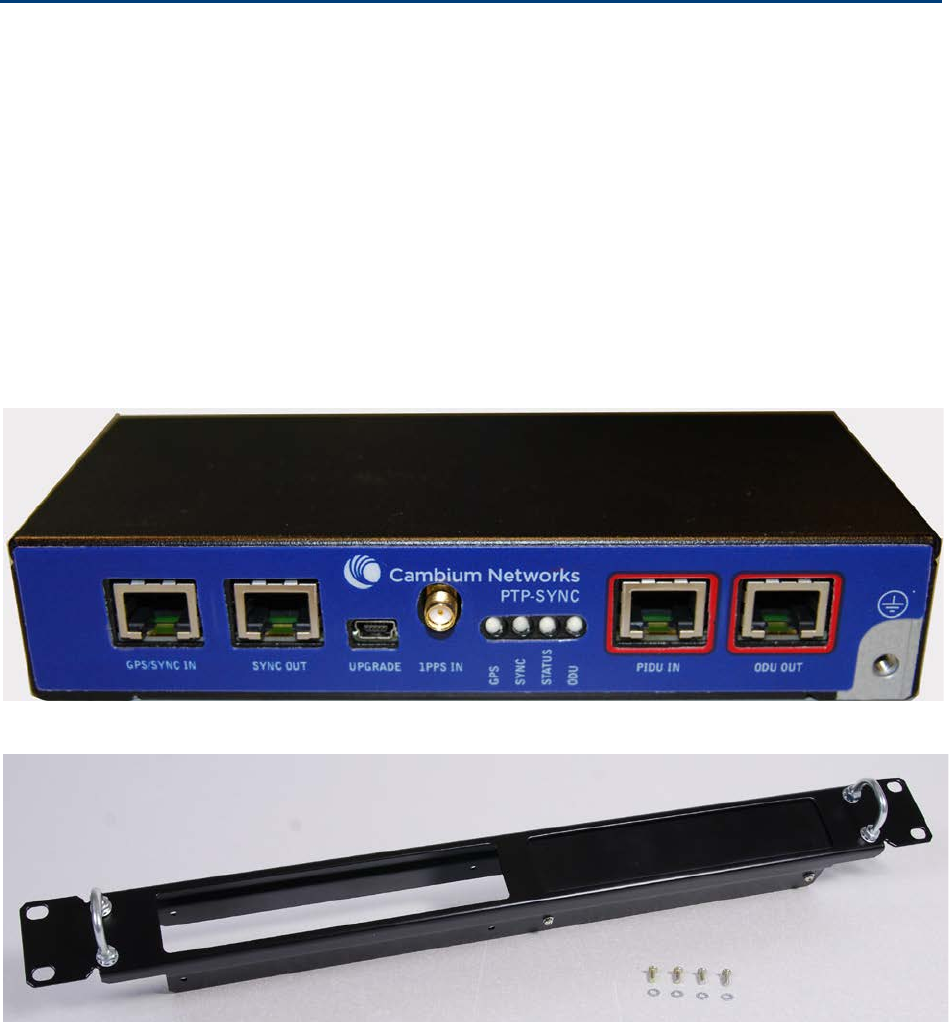
Chapter 2: System hardware PTP-SYNC unit
PTP-SYNC unit
PTP-SYNC unit description
The PTP-SYNC unit (Figure 27) is an optional component. It is required when TDD synchronization
is implemented using PTP-SYNC. It measures the difference between the TDD frame timing and a
1 Hz timing reference, and signals this time difference to the ODU. For more information on this
feature, refer to TDD synchronization on page 1-19.
The PTP-SYNC unit is powered using standard power-over-Ethernet from the PSU. One PTP-SYNC
unit is required for each synchronized link.
The PTP-SYNC unit is a compact indoor unit mounted on a wall, shelf or (using an optional rack
mounting adaptor) in a standard 19 inch rack (Figure 28).
Figure 27
PTP-SYNC kit
Figure 28
PTP-SYNC rack mounting adapter
UNDER DEVELOPMENT
Page 2-46

Chapter 2: System hardware PTP-SYNC unit
PTP-SYNC part numbers
Order PTP-SYNC kits and associated components from Cambium Networks (Table 35).
Table 35
PTP-SYNC component part numbers
Cambium description
Cambium part number
PTP-SYNC kit WB3665
PTP800 CMU / PTP-SYNC 19” rack mount installation kit WB3486
The PTP-SYNC kit contains:
• 1 x PTP-SYNC unit
• 1 x M4 pan screw
• 2 x M4 washers
• 2 x M3 (6mm) torx drive screws
• 1 x lug for unit ground (cable not supplied)
• 1 x Cat5e cable (length 1 meter)
• Installation guide
If the 1 meter Cat5e cable supplied with the PTP-SYNC kit is not long enough, order a longer length
of Cat5e cable, up to 2 meters long.
The PTP-SYNC rack mount kit contains:
• 1 x rack bracket
• 8 x M3 washers
• 8 x M3 screws
• 1 x rack mount blank plate
• 8 x M5 nuts
• 8 x M5 washers
• 2 x rack handles
UNDER DEVELOPMENT
Page 2-47
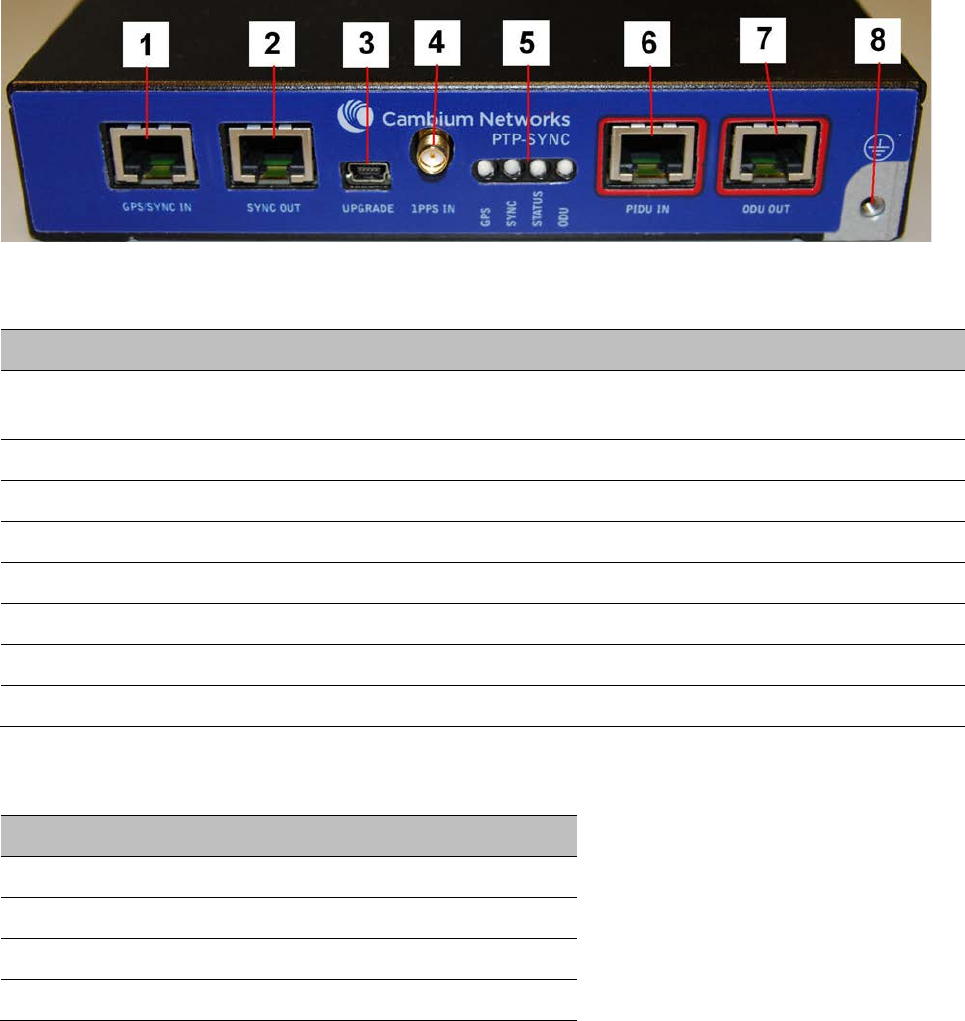
Chapter 2: System hardware PTP-SYNC unit
PTP-SYNC unit interfaces
The PTP-SYNC front panel is illustrated in Figure 29. The annotated interfaces are described in
Table 36 and Table 37.
Figure 29
PTP-SYNC front panel
Table 36
PTP-SYNC interface functions
#
Description
Function
1 GPS/SYNC IN Input from GPS receiver or from the daisy-chained SYNC OUT signal of
another PTP-SYNC.
2 SYNC OUT Output to daisy-chained PTP-SYNC units.
3 USB Input for software upgrades. Contact Cambium for instructions.
4 1PPS IN Coaxial alternative to GPS/SYNC IN. Peak input voltage must not exceed 5 V.
5 LED bank LEDs and their functions are described in Table 37.
6 PIDU IN Input from PSU.
7 ODU OUT Output to ODU.
8 Ground stud For connecting to a ground point.
Table 37
PTP-SYNC LED functions
LED
Function
GPS GPS satellite data detection.
SYNC SYNC OUT port data detection.
STATUS Power and satellite lock detection.
ODU ODU signal detection.
For a full list of LED states and fault-finding actions, refer to Testing PTP-SYNC on page 8-10.
UNDER DEVELOPMENT
Page 2-48

Chapter 2: System hardware PTP-SYNC unit
PTP-SYNC specifications
The PTP-SYNC unit conforms to the specifications listed in Table 38, Table 39 and Table 40.
Table 38
PTP-SYNC unit physical specifications
Category
Specification
Dimensions Width excluding ears 174 mm (6.69 in)
Width including ears 196 mm (7.54 in)
Height 31.5 mm (1.21 in)
Depth 79 mm (3.04 in)
Weight 0.485 Kg (1.1 lbs)
Table 39
PTP-SYNC unit environmental specifications
Category
Specification
Temperature -40°C (-40°F) to +60°C (140°F)
Suitable for use indoors, or outdoors within a
weatherproofed cabinet.
Humidity 0 to 95% non-condensing
Waterproofing Not waterproof
Table 40
PTP-SYNC unit electrical specifications
Category
Specification
Power supply Integrated with PSU
Power
consumption
1.5 W max
(extra power is required to supply a GPS receiver)
UNDER DEVELOPMENT
Page 2-49

Chapter 2: System hardware PTP-SYNC unit
There are two timing inputs to the PTP-SYNC unit: GPS/SYNC IN (RJ-45) (Table 41) and 1PPS IN
(SMA) (Table 42).
Table 41
PTP-SYNC unit timing specifications - GPS/SYNC IN (RJ-45)
Category
Specification
Signal type Differential 1 Hz signal
Common mode range –7 V to +7 V, relative to GPS/SYNC IN pin 2 (ground)
Maximum differential voltage ±5 V
Threshold ±0.4 V
Impedance 90 ohms to 110 ohms
Pulse width 1 μs to 500 ms
Polarity Reference edge is when pin 3 (PPSA) is positive with
respect to pin 6 (PPSB)
Table 42
PTP-SYNC unit timing specifications - 1PPS IN (SMA)
Category
Specification
Signal type 1 Hz signal
Pulse Positive pulse, reference edge is rising edge
Maximum voltage 5 V
Threshold 0.4 V to 0.6 V
Input impedance 45 ohms to 55 ohms
Pulse width 1μs to 500ms
UNDER DEVELOPMENT
Page 2-50

Chapter 2: System hardware PTP-SYNC unit
The pinouts of the PTP-SYNC unit GPS/SYNC IN port are specified in Table 43.
Table 43
GPS/SYNC IN port pinouts
Pin no.
Connector pinout signal name
Signal description
Pin 1 12VGPS 12 V output to GPS receiver module, 250 mA max
Pin 2 GND Ground
Pin 3 GPS_1PPSA 1 Hz pulse input
Pin 4 GPS_RXDA GPS receive data
Pin 5 GPS_RXDB GPS receive data
Pin 6 GPS_1PPSB 1 Hz pulse input
Pin 7 GPS_TXDA GPS transmit data
Pin 8 GPS_TXDB GPS transmit data
Note
The GPS_1PPS, GPS_RXD and GPS_TXD signals conform to International
Telecommunication Union (ITU) recommendation V.11 (RS422)
Signal polarities
A 1 PPS timing datum is detected when GPS_1PPSA goes positive relative to GPS_1PPSB. A serial
data start bit is detected when GPS_RXDA (or GPS_TXDA) goes positive relative to GPS_RXDB (or
GPS_TXDB).
UNDER DEVELOPMENT
Page 2-51
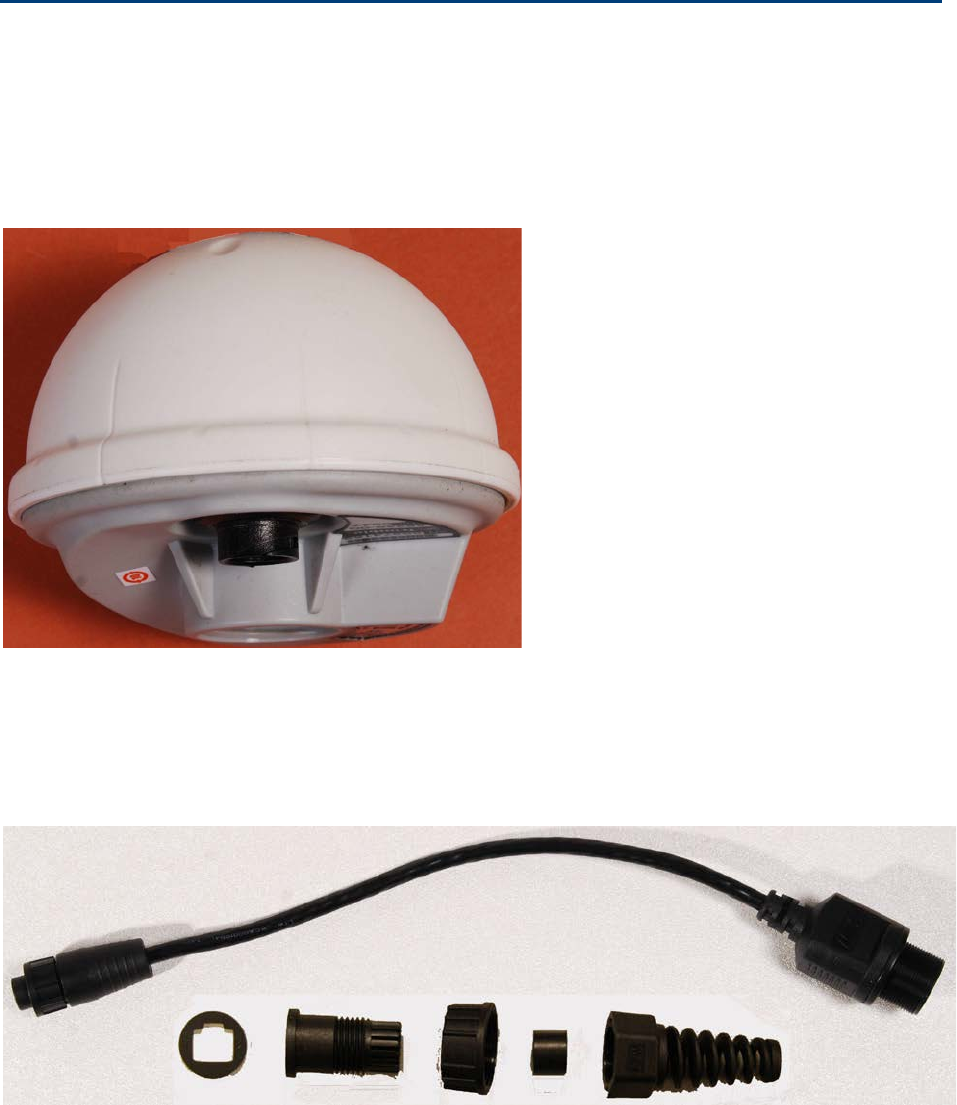
Chapter 2: System hardware GPS receiver
GPS receiver
GPS receiver description
The GPS receiver (Figure 30) is an optional timing reference source for PTP-SYNC. It provides a
1 Hz signal, accurately synchronized in frequency and phase across the network.
Figure 30
GPS receiver
The GPS receiver is supplier with a GPS adapter cable kit (Figure 31). This avoids the need to fit a
12 way circular connector to the GPS drop cable. The kit contains one adapter cable (GPS receiver
circular connector to RJ45 socket) and one RJ45 plug housing.
Figure 31
GPS adapter cable kit
UNDER DEVELOPMENT
Page 2-52

Chapter 2: System hardware GPS receiver
GPS receiver part numbers
Order GPS receivers and associated components from Cambium Networks (Table 44).
Table 44
GPS receiver component part numbers
Cambium description
Cambium part number
Trimble Acutime™GG GPS receiver WB4141
PTP-SYNC <-> Trimble Adapter Cable (*1) WB3961
1000 ft Reel Outdoor Copper Clad CAT5E (*2) WB3175
328 ft (100 m) Reel Outdoor Copper Clad CAT5E (*2) WB3176
Tyco/AMP, Mod Plug RJ45, 100 pack (*3) WB3177
Tyco/AMP Crimp Tool (*3) WB3211
Cable Grounding Kits For 1/4" And 3/8" Cable (*4) 01010419001
LPU End Kit PTP 250/300/500 (*5) WB2978D
(*1) This adapter cable is included with the GPS receiver (part number WB4141).
(*2) Other lengths of this BBDGe drop cable are available from Superior Essex.
(*3) The RJ45 connectors and crimp tool only work with Superior Essex type BBDGe cable.
(*4) One grounding kit is required per drop cable grounding point.
(*5) One LPU kit is required per GPS receiver.
Twelve way circular connector
As an alternative to the GPS adapter cable, the drop cable can be connected directly to the GPS
unit via a 12 way circular connector, using the components and tools listed in Table 45.
Table 45
Recommended outdoor connectors for Trimble GPS receiver
Item
Manufacturer
Part number
12 way circular connector Deutsch IMC26-2212X
Size 22 crimp socket Deutsch 6862-201-22278
Crimp tool Daniels Manufacturing Corp MH860
Positioner Daniels Manufacturing Corp 86-5
Insertion / extraction tool Deutsch 6757-201-2201
Adaptor Deutsch IMC2AD
Self amalgamating tape
UNDER DEVELOPMENT
Page 2-53
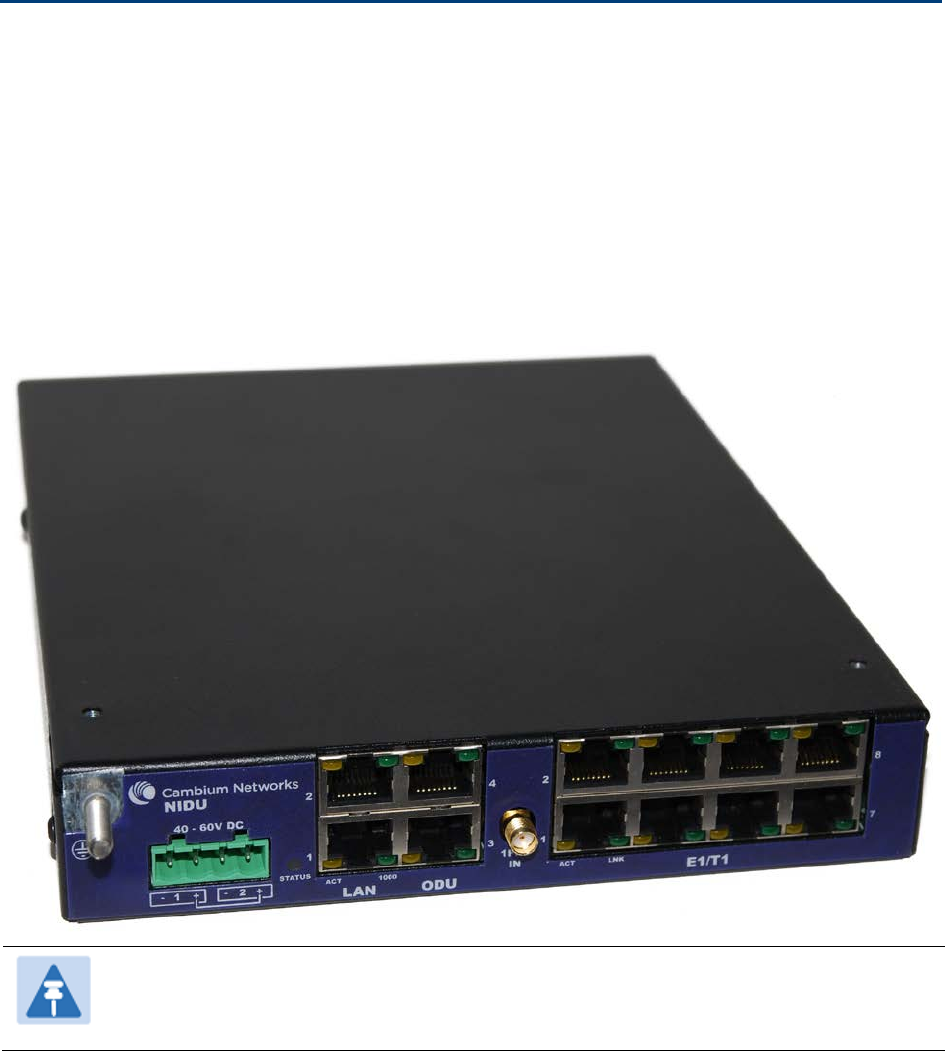
Chapter 2: System hardware Network indoor unit (NIDU)
Network indoor unit (NIDU)
NIDU description
The NIDU (Figure 32) is an optional component that adds up to eight TDM channels (E1 or T1) to a
PTP 650 link. It multiplexes and demultiplexes E1, T1 and Ethernet data over the wireless bridge.
The NIDU is an indoor unit that is connected to the PSU (via the ODU port), to network terminating
equipment (via the LAN port) and to up to eight E1 or T1 channels (via the E1/T1 ports) using Cat5e
cable with RJ45 connectors. It requires a 48V to 60V DC power supply, either from the PTP 650
AC+DC Enhanced Power Injector, the PTP 800 AC-DC Power Supply Converter or another source.
Figure 32
NIDU
Note
To enable E1 or T1 capability over a PTP 650 link, purchase one access key for each
link end from Cambium Networks (ODU capability upgrades on page 2-9).
UNDER DEVELOPMENT
Page 2-54
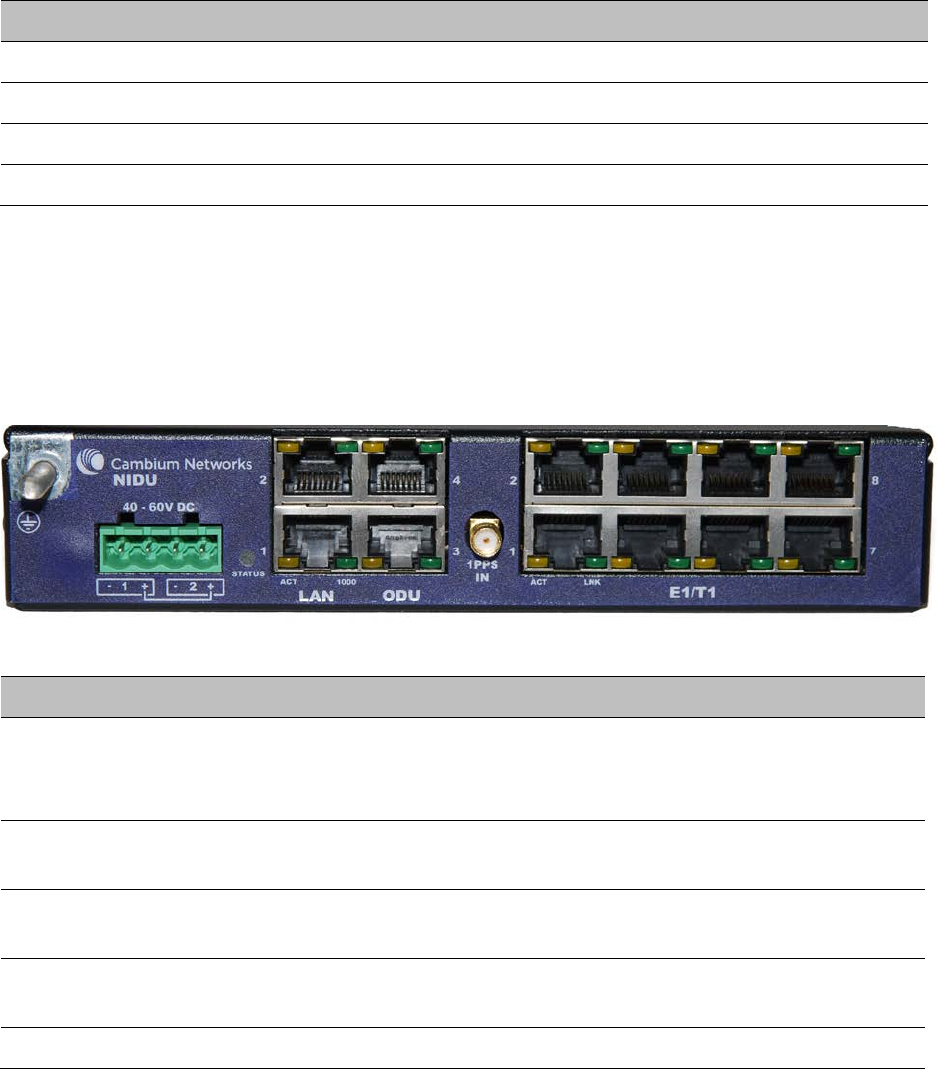
Chapter 2: System hardware Network indoor unit (NIDU)
NIDU part numbers
Order NIDUs and associated components from Cambium Networks (Table 46).
Table 46
NIDU component part numbers
Cambium description
Cambium part number
Network Indoor Unit (One per END) C000065L043
NIDU - DC Power Connector Spare (10 pack) C000065L044
CMU/PTP-SYNC/NIDU 19inch Rack Mount Installation Kit WB3486
PTP 800 AC-DC Power Supply Converter (*) WB3622
(*) Optional DC power supply for the NIDU.
NIDU interfaces
The NIDU interfaces are shown in Figure 33 and described in Table 47.
Figure 33
NIDU interfaces
Table 47
NIDU interface functions
Interface
Function
40 – 60V DC Port 1: DC power input from an independent source or from the
AC+DC Enhanced Power Injector. Port 2: Backup power input.
The kit includes one four-pin DC connector.
LAN Gigabit Ethernet RJ45 socket for connecting to network terminating
equipment. Use LAN port 1; port 2 is provided for future expansion.
ODU Gigabit Ethernet RJ45 socket for connecting to the PSU (and so on to
the ODU). Use ODU port 3; port 4 is provided for future expansion.
E1/T1 RJ45 sockets for connecting to up to eight E1 or T1 channels. Allocate
ports to channels in ascending order (1 to 8).
1PPS IN Not used. Provided for future expansion.
For a full list of LED states and fault-finding actions, refer to Testing a TDM link on page 8-13.
UNDER DEVELOPMENT
Page 2-55

Chapter 2: System hardware Network indoor unit (NIDU)
NIDU specifications
The NIDU conforms to the specifications listed in Table 48.
Table 48
NIDU
specifications
Category
Specification
Dimensions Width 172 mm (6.8 in)
Height 32 mm (1.3 in)
Depth 218 mm (8.6 in)
Weight 0.88 kg (1.95 lb)
Temperature -40°C (-40°F) to +60°C (+140°F)
Suitable for use indoors, or outdoors within a
weatherproofed cabinet.
Humidity 0 to 95%, non
‐
condensing
Waterproofing Not waterproof
DC Input +48 V to +60 V DC
Power consumption <8 W
The NIDU TDM interface conforms to the standards listed in TDM network planning on page 3-46.
The pinouts of the NIDU ports are specified in Table 49, Table 50 and Table 51.
Table 49
NIDU LAN port pinouts
Pin no.
Connector pinout
signal name (*)
Signal description
Pin 1 LAN_PHYn_PAIR1+ Gigabit tx/rx pair 1
Pin 2 LAN_PHYn_PAIR1- Gigabit tx/rx pair 1
Pin 3 LAN_PHYn_PAIR2+ Gigabit tx/rx pair 2
Pin 4 LAN_PHYn_PAIR3+ Gigabit tx/rx pair 3
Pin 5 LAN_PHYn_PAIR3- Gigabit tx/rx pair 3
Pin 6 LAN_PHYn_PAIR2- Gigabit tx/rx pair 2
Pin 7 LAN_PHYn_PAIR4+ Gigabit tx/rx pair 4
Pin 8 LAN_PHYn_PAIR4- Gigabit tx/rx pair 4
(*) “n” refers to the LAN port number (1 or 2).
UNDER DEVELOPMENT
Page 2-56

Chapter 2: System hardware Network indoor unit (NIDU)
Table 50
NIDU ODU port pinouts
Pin no.
Connector pinout
signal name (*)
Signal description
Pin 1 ODU_PHYn_PAIR1+ Gigabit tx/rx pair 1
Pin 2 ODU_PHYn_PAIR1- Gigabit tx/rx pair 1
Pin 3 ODU_PHYn_PAIR2+ Gigabit tx/rx pair 2
Pin 4 ODU_PHYn_PAIR3+ Gigabit tx/rx pair 3
Pin 5 ODU_PHYn_PAIR3- Gigabit tx/rx pair 3
Pin 6 ODU_PHYn_PAIR2- Gigabit tx/rx pair 2
Pin 7 ODU_PHYn_PAIR4+ Gigabit tx/rx pair 4
Pin 8 ODU_PHYn_PAIR4- Gigabit tx/rx pair 4
(*) “n” refers to the ODU port number (3 or 4).
Table 51
NIDU E1/T1 port pinouts
Pin no.
Connector pinout
signal name (*)
Signal description
Pin 1 RJ_RRINGn Receive signal
Pin 2 RJ_RTIPn Receive signal
Pin 3 Not used
Pin 4 RJ_TRINGn Transmit signal
Pin 5 RJ_TTIPn Transmit signal
Pin 6 Not used
Pin 7 Not used
Pin 8 Not used
(*) “n” refers to the E1/T1 port number (1 to 8).
UNDER DEVELOPMENT
Page 2-57

Chapter 3: System planning
This chapter provides information to help the user to plan a PTP 650 link.
The following topics are described in this chapter:
• Typical deployment on page 3-2 contains diagrams illustrating typical PTP 650 site
deployments.
• Site planning on page 3-11 describes factors to be considered when planning the proposed link
end sites, including grounding, lightning protection and equipment location.
• Radio spectrum planning on page 3-21 describes how to plan PTP 650 links to conform to the
regulatory restrictions that apply in the country of operation.
• Link planning on page 3-25 describes factors to be taken into account when planning links,
such as range, path loss and throughput.
• Planning for connectorized units on page 3-29 describes factors to be taken into account when
planning to use connectorized ODUs with external antennas in PTP 650 links.
• Configuration options for TDD synchronization on page 3-31 describes the different
configuration options that may be used for implementing TDD synchronization in the PTP 650
Series.
• Data network planning on page 3-35 describes factors to be considered when planning PTP 650
data networks.
• TDM network planning on page 3-46 describes factors to be considered when planning
PTP 650 TDM networks.
• Network management planning on page 3-47 describes how to plan for PTP 650 links to be
managed remotely using SNMP.
• Security planning on page 3-49 describes how to plan for PTP 650 links to operate in secure
mode.
• System threshold, output power and link loss on page 3-57 contains tables that specify the
system threshold (dBm), output power (dBm) and maximum link loss (dB) per channel
bandwidth and modulation mode.
• Data throughput capacity tables on page 3-68 contains tables and graphs to support
calculation of the data rate capacity that can be provided by PTP 650 configurations.
UNDER DEVELOPMENT
Page 3-1
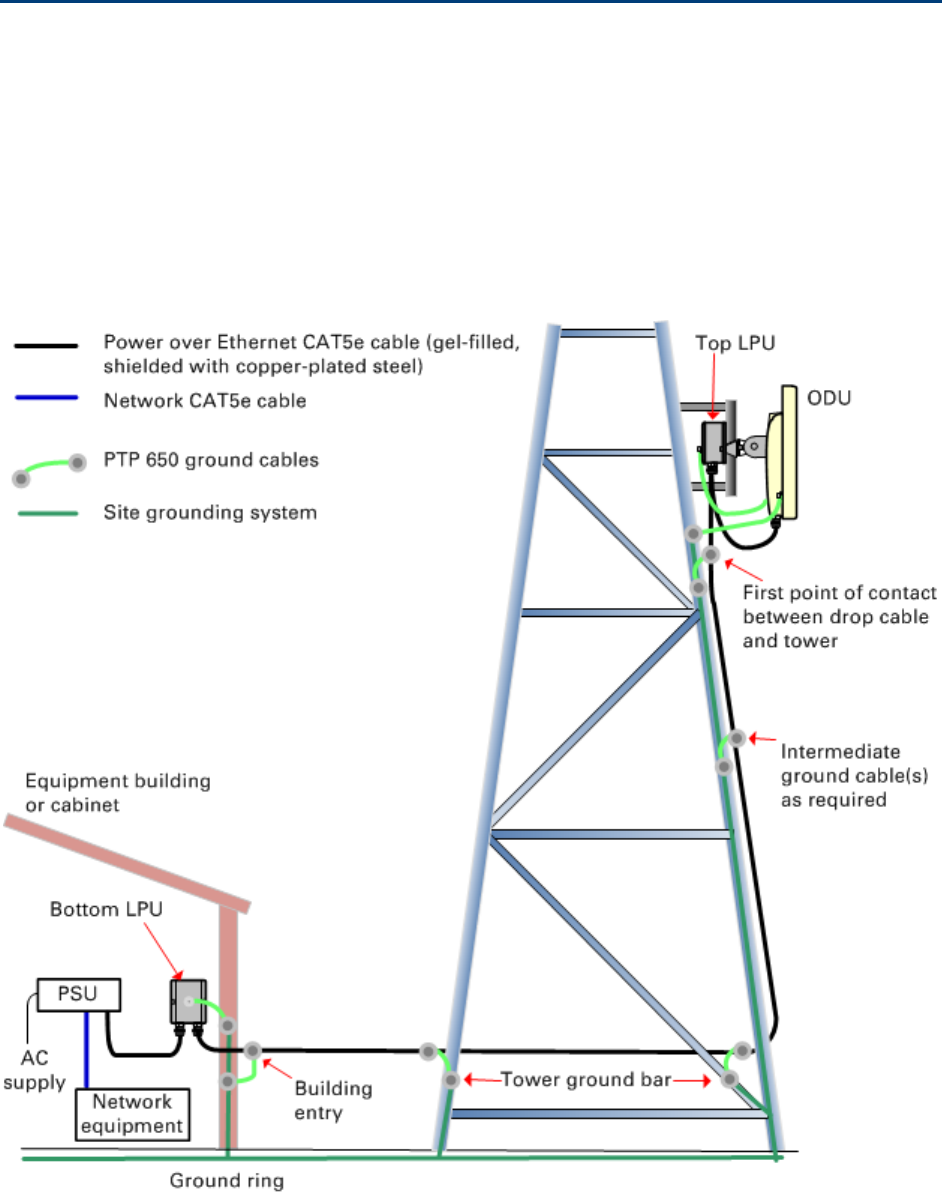
Chapter 3: System planning Typical deployment
Typical deployment
This section contains diagrams illustrating typical PTP 650 site deployments.
ODU with POE interface to PSU
In the basic configuration, there is only one Ethernet interface, a copper Cat5e power over Ethernet
(POE) from the PSU to the ODU (PSU port), as shown in the following diagrams: mast or tower
installation (Figure 34 ), wall installation (Figure 35) and roof installation (Figure 36).
Figure 34
Mast or tower installation
UNDER DEVELOPMENT
Page 3-2
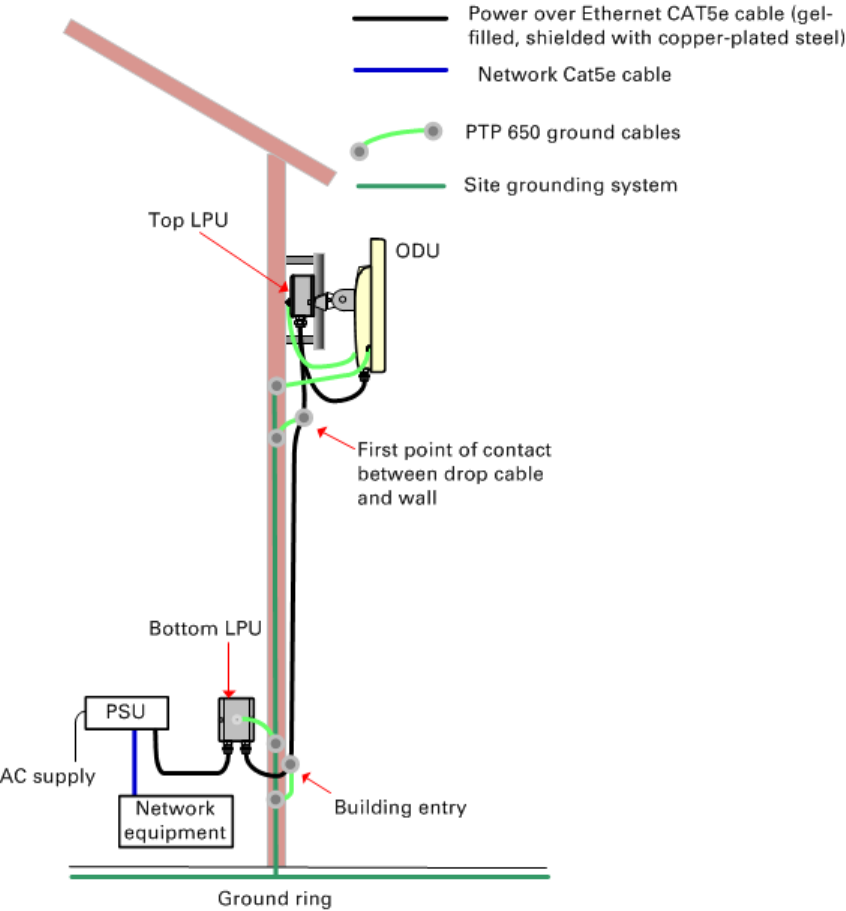
Chapter 3: System planning Typical deployment
Figure 35
Wall installation
UNDER DEVELOPMENT
Page 3-3
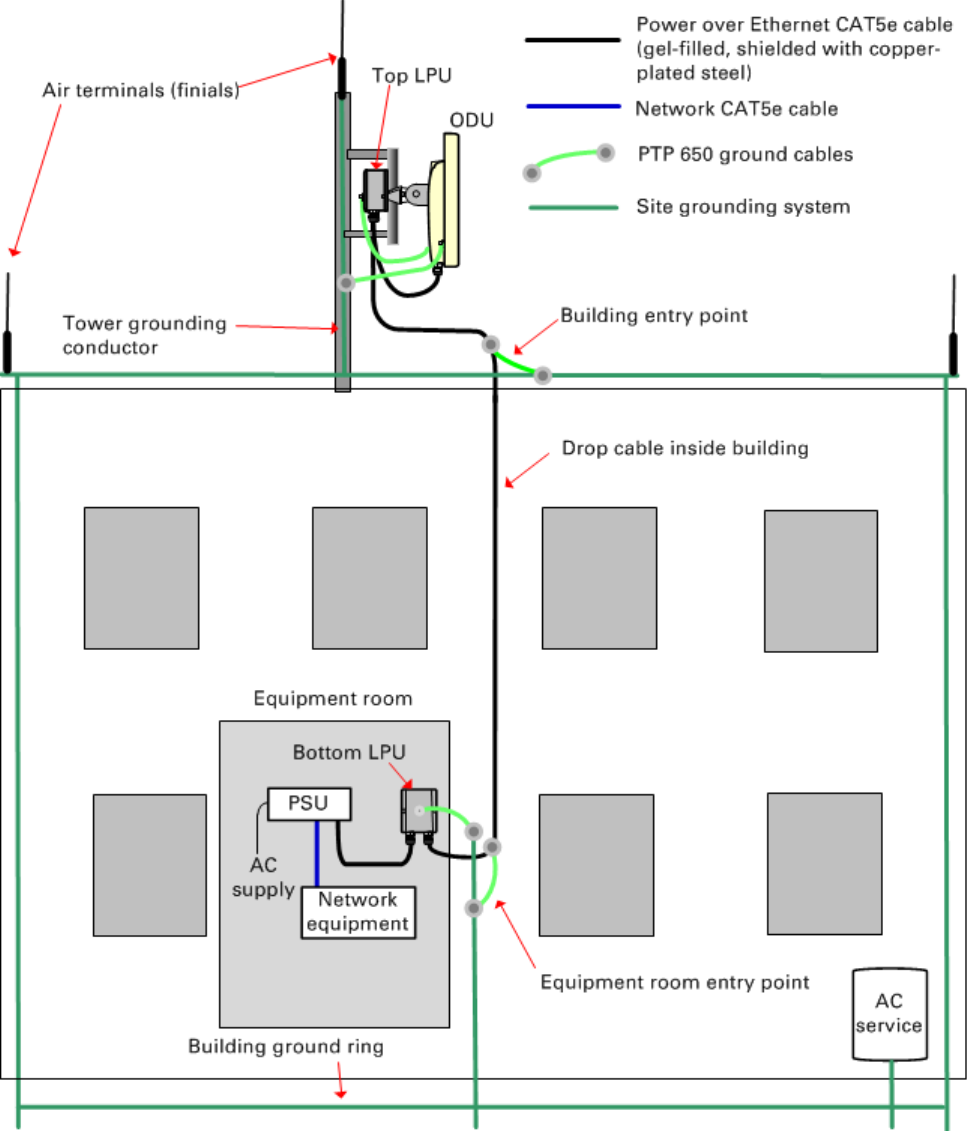
Chapter 3: System planning Typical deployment
Figure 36
Roof installation
UNDER DEVELOPMENT
Page 3-4
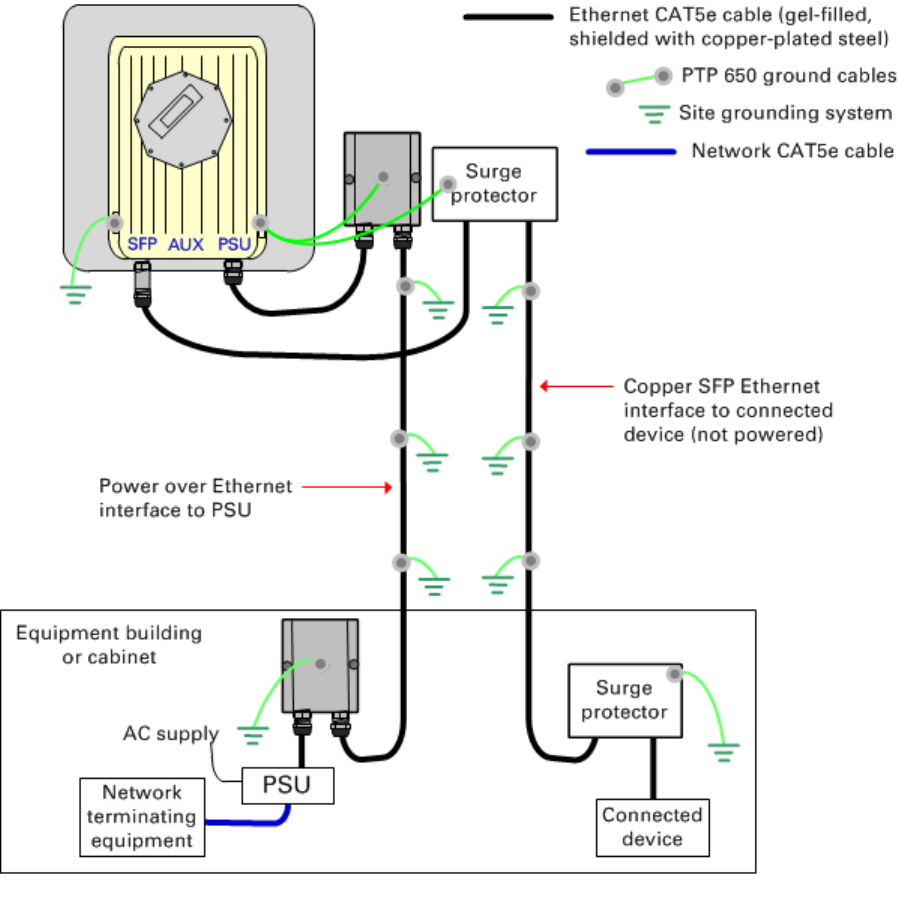
Chapter 3: System planning Typical deployment
SFP and Aux Ethernet interfaces
There may be one or two additional Ethernet interfaces connected to the ODU: one to the SFP port
(copper or optical) and one to the Aux port, as shown in the following diagrams:
• ODU with copper SFP and PSU interfaces – Figure 38
• ODU with optical SFP and PSU interfaces – Figure 39
• ODU with Aux and PSU interfaces – Figure 40
Figure 38
ODU with copper SFP and PSU interfaces
UNDER DEVELOPMENT
Page 3-6
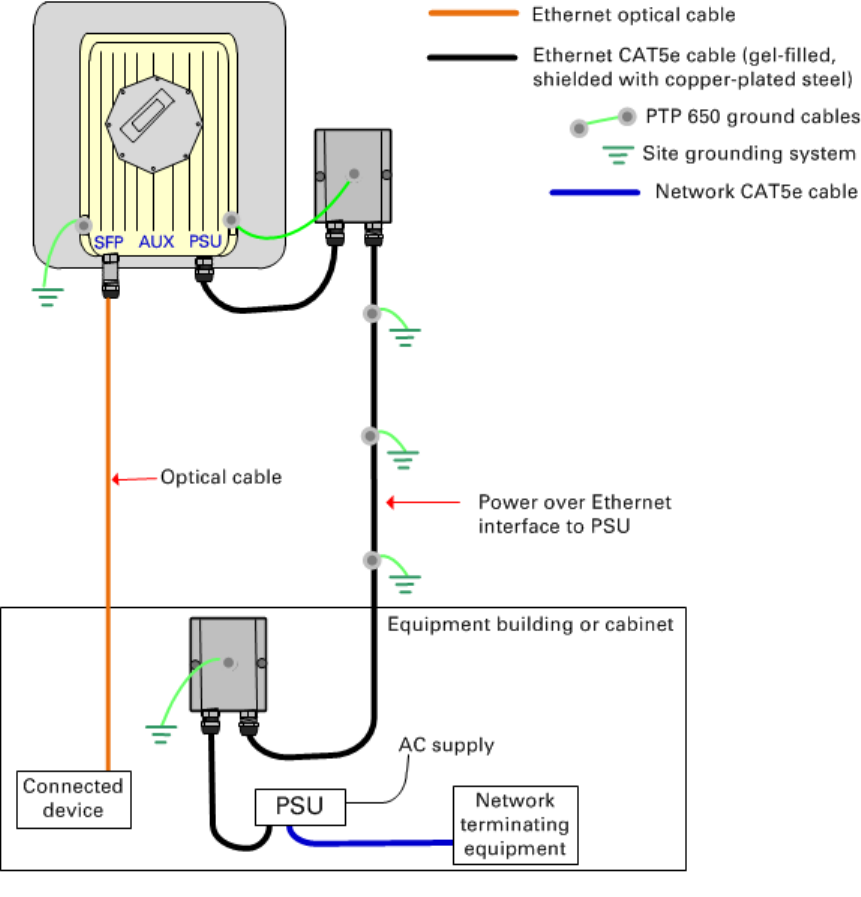
Chapter 3: System planning Typical deployment
Figure 39
ODU with optical SFP and PSU interfaces
UNDER DEVELOPMENT
Page 3-7
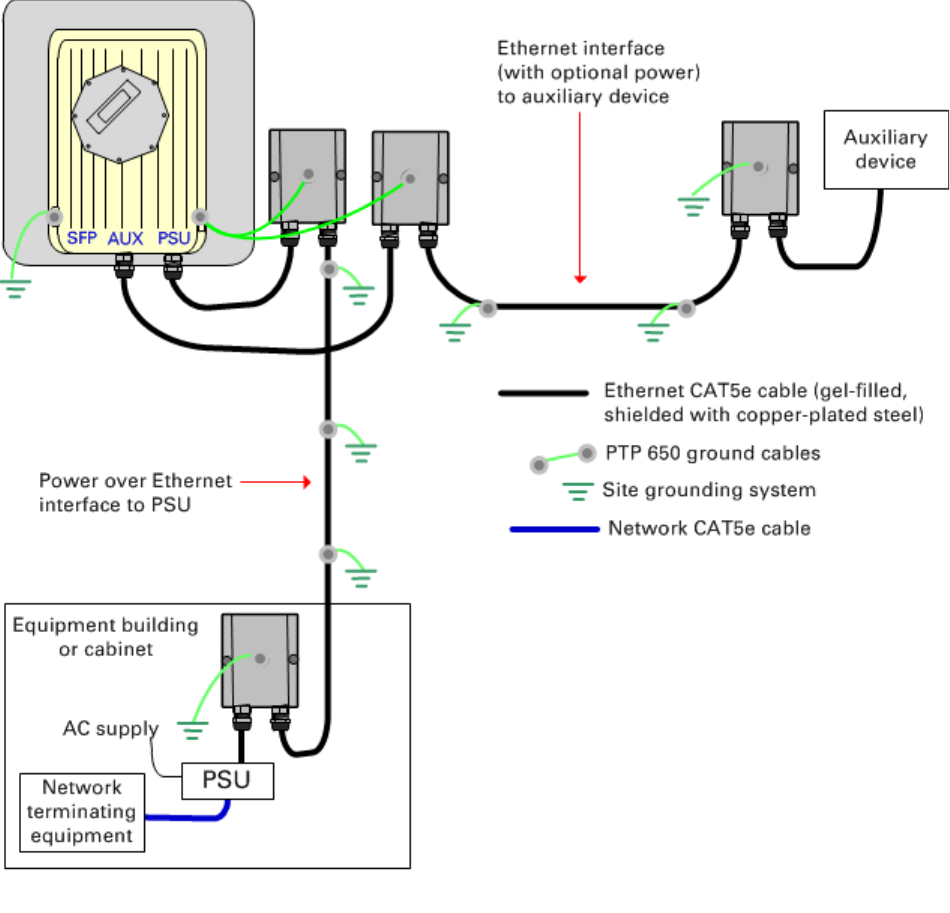
Chapter 3: System planning Typical deployment
Figure 40
ODU with Aux and PSU interfaces
UNDER DEVELOPMENT
Page 3-8
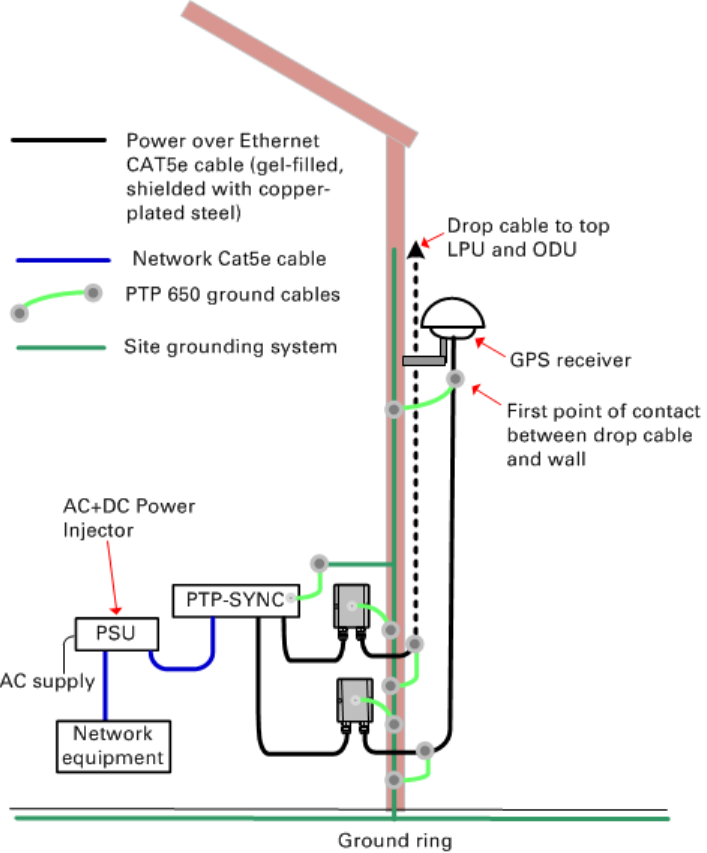
Chapter 3: System planning Typical deployment
GPS receiver interfaces
If a GPS receiver is deployed for PTP-SYNC, it may be mounted on the wall of the equipment
building (Figure 41) (preferred option), or on a metal tower or mast (Figure 42).
Figure 41
GPS receiver wall installation
UNDER DEVELOPMENT
Page 3-9
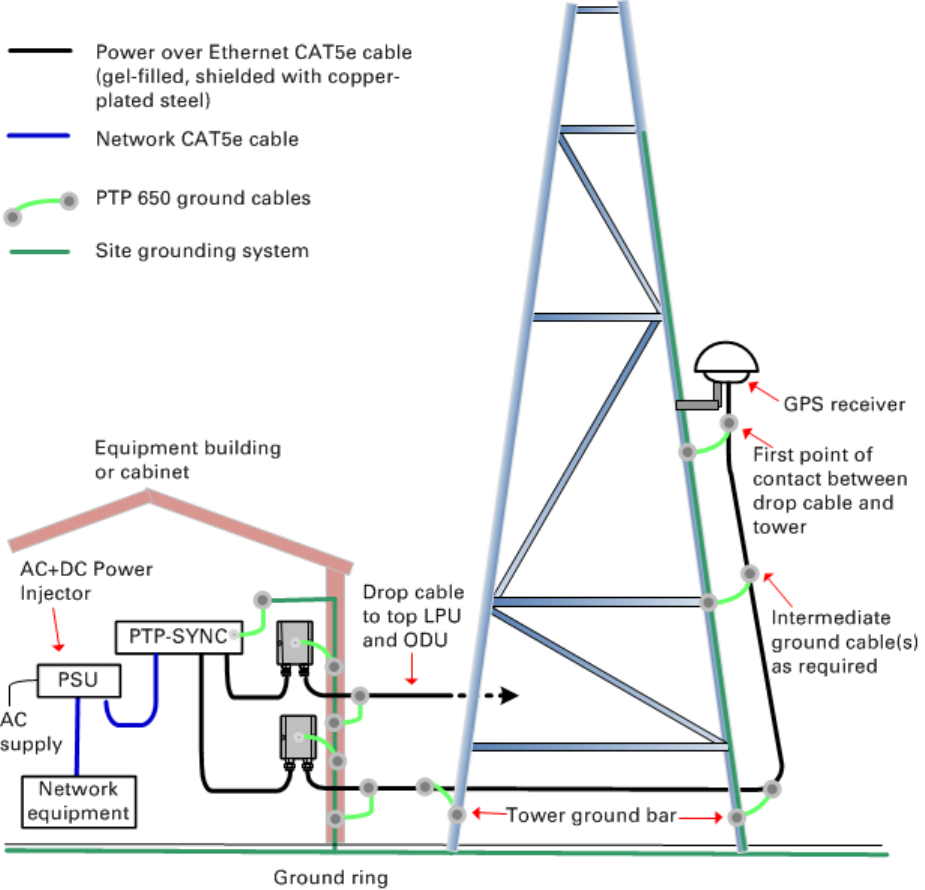
Chapter 3: System planning Typical deployment
Figure 42
GPS receiver tower or mast installation
UNDER DEVELOPMENT
Page 3-10

Chapter 3: System planning Site planning
Site planning
This section describes factors to be considered when planning the proposed link end sites,
including grounding, lightning protection and equipment location for the ODU, PSU and PTP-
SYNC unit (if installed).
Grounding and lightning protection
Warning
Electro-magnetic discharge (lightning) damage is not covered under warranty. The
recommendations in this guide, when followed correctly, give the user the best
protection from the harmful effects of EMD. However 100% protection is neither
implied nor possible.
Structures, equipment and people must be protected against power surges (typically caused by
lightning) by conducting the surge current to ground via a separate preferential solid path. The
actual degree of protection required depends on local conditions and applicable local regulations.
To adequately protect a PTP 650 installation, both ground bonding and transient voltage surge
suppression are required.
Full details of lightning protection methods and requirements can be found in the international
standards IEC 61024-1 and IEC 61312-1, the U.S. National Electric Code ANSI/NFPA No. 70-1984 or
section 54 of the Canadian Electric Code.
Note
International and national standards take precedence over the requirements in this
guide.
Lightning protection zones
Use the rolling sphere method (Figure 43) to determine where it is safe to mount equipment. An
imaginary sphere, typically 50 meters in radius, is rolled over the structure. Where the sphere rests
against the ground and a strike termination device (such as a finial or ground bar), all the space
under the sphere is considered to be in the zone of protection (Zone B). Similarly, where the
sphere rests on two finials, the space under the sphere is considered to be in the zone of
protection.
UNDER DEVELOPMENT
Page 3-11
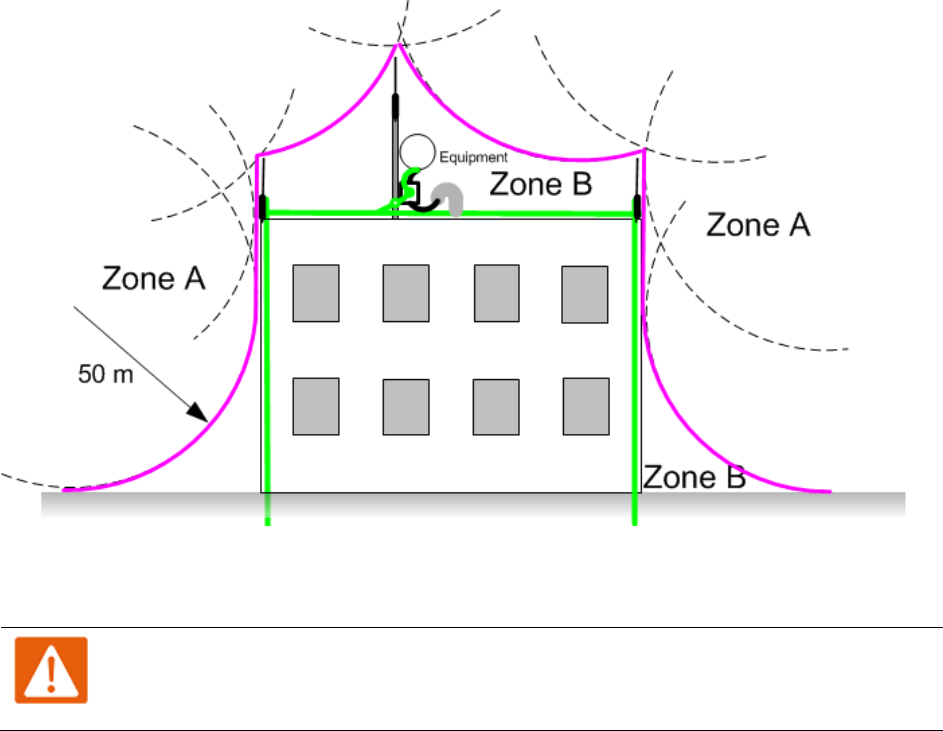
Chapter 3: System planning Site planning
Figure 43
Rolling sphere method to determine the lightning protection zones
Zone A: In this zone a direct lightning strike is possible. Do not mount equipment in this zone.
Zone B: In this zone, direct EMD (lightning) effects are still possible, but mounting in this zone
significantly reduces the possibility of a direct strike. Mount equipment in this zone.
Warning
Never mount equipment in Zone A. Mounting in Zone A may put equipment,
structures and life at risk.
Site grounding system
Confirm that the site has a correctly installed grounding system on a common ground ring with
access points for grounding PTP 650 equipment.
If the outdoor equipment is to be installed on the roof of a high building (Figure 36), confirm that
the following additional requirements are met:
• A grounding conductor is installed around the roof perimeter to form the main roof perimeter
lightning protection ring.
• Air terminals are installed along the length of the main roof perimeter lightning protection
ring, typically every 6.1m (20ft).
• The main roof perimeter lightning protection ring contains at least two down conductors
connected to the grounding electrode system. The down conductors should be physically
separated from one another, as far as practical.
UNDER DEVELOPMENT
Page 3-12

Chapter 3: System planning Site planning
ODU and external antenna location
Find a location for the ODU (and external antenna for connectorized units) that meets the following
requirements:
• The equipment is high enough to achieve the best radio path.
• People can be kept a safe distance away from the equipment when it is radiating. The safe
separation distances are defined in Calculated distances on page 4-24.
• The equipment is lower than the top of the supporting structure (tower, mast or building) or its
lightning air terminal.
• If the ODU is connectorized, select a mounting position that gives it maximum protection from
the elements, but still allows easy access for connecting and weatherproofing the cables. To
minimize cable losses, select a position where the antenna cable lengths can be minimized. If
diverse or two external antennas are being deployed, it is not necessary to mount the ODU at
the midpoint of the antennas.
ODU ambient temperature limits
Select a location where the ODU can operate within safe ambient temperature limits.
The ODU must be mounted in a Restricted Access Location (as defined in EN 60950-1) if the
operating ambient temperature may exceed 40°C, including solar radiation.
If the ambient temperature never exceeds 40°C, the temperature of the external metal case parts of
the ODU will not exceed the touch temperature limit of 70°C.
If the ambient temperature never exceeds 60°C, the temperature of the external metal case parts of
the ODU will not exceed the touch temperature limit of 90°C.
Note
A restricted access location is defined (in EN 60950-1) as one where access may only
be gained by use of a tool or lock and key, or other means of security, and access is
controlled by the authority responsible for the location. Access must only be gained
by persons who have been instructed about the reasons for the restrictions applied to
the location and about any precautions that must be taken. Examples of permissible
restricted access locations are a lockable equipment room or a lockable cabinet.
UNDER DEVELOPMENT
Page 3-13

Chapter 3: System planning Site planning
ODU wind loading
Ensure that the ODU and the structure on which it is mounted are capable of withstanding the
prevalent wind speeds at a proposed PTP 650 site. Wind speed statistics should be available from
national meteorological offices.
The ODU and its mounting bracket are capable of withstanding wind speeds of up to 323 kph
(200 mph).
Wind blowing on the ODU will subject the mounting structure to significant lateral force. The
magnitude of the force depends on both wind strength and surface area of the ODU. Wind loading
is estimated using the following formulae:
• Force (in kilogrammes) = 0.1045aV2
where:
o “a” is the surface area in square meters, and
o “V” is the wind speed in meters per second.
• Force (in pounds) = 0.0042Av2
where:
o “A” is the surface area in square feet, and
o “v” is the wind speed in miles per hour.
Applying these formulae to the PTP 650 ODU at different wind speeds, the resulting wind loadings
are shown in Table 52 and Table 53.
Table 52
ODU wind loading (Kg)
Type of ODU
Max surface area
(square meters)
Wind speed (meters per second)
30
40
50
60
70
Integrated 0.130 12 Kg 22 Kg 34 Kg 49 Kg 66 Kg
Connectorized 0.093 9 Kg 16 Kg 24 Kg 35 Kg 48 Kg
Table 53
ODU wind loading (lb)
Type of ODU
Max surface area
(square feet)
Wind speed (miles per hour)
80
100
120
140
150
Integrated 1.36 37 lb 57 lb 82 lb 146 lb 229 lb
Connectorized 1.00 27 lb 42 lb 61 lb 108 lb 168 lb
For a connectorized ODU, add the wind loading of the external antenna to that of the ODU. The
antenna manufacturer should be able to quote wind loading.
UNDER DEVELOPMENT
Page 3-14
Chapter 3: System planning Site planning
PSU DC power supply
If using the DC input on the AC+DC power injector, ensure that the DC power supply meets the
following requirements:
• The voltage and polarity must be correct and must be applied to the correct PSU terminals.
• The power source must be rated as Safety Extra Low Voltage (SELV).
• The power source must be rated to supply at least 1.5A continuously.
• The power source cannot provide more than the Energy Hazard Limit as defined by
IEC/EN/UL60950-1, Clause 2.5, Limited Power (The Energy Hazard Limit is 240VA).
PSU location
Find a location for the PSU (AC Power Injector or AC+DC Enhanced Power Injector) that meets the
following requirements:
• The AC+DC Enhanced Power Injector can be mounted on a wall or other flat surface. The AC
Power Injector can be mounted on a flat surface.
• The PSU is kept dry, with no possibility of condensation, flooding or rising damp.
• The PSU is located in an environment where it is not likely to exceed its operational
temperature rating, allowing for natural convection cooling.
• The PSU can be connected to the ODU drop cable and network terminating equipment.
• The PSU can be connected to a compatible power supply. AC+DC Enhanced Power Injector:
the use of DC supplies of less than 55V will reduce the usable distance between the PSU and
ODU.
PTP-SYNC location
If PTP-SYNC is to be installed, consider the following factors when selecting a site:
• Indoor location with no possibility of condensation.
• Accessibility for viewing status indicators.
• The maximum cable length between the PSU and the PTP-SYNC is 2 m (6 ft).
UNDER DEVELOPMENT
Page 3-15
Chapter 3: System planning Site planning
GPS receiver location
Mount the GPS receiver for PTP-SYNC at a location that meets the following requirements:
• It must be possible to protect the installation as described in Grounding and lightning
protection on page 3-11.
• It must have an un-interrupted view of at least half of the sky. For a receiver mounted on a wall
there must be no other significant obstructions in the view of the sky.
• It must be mounted at least 1 m (3 ft), preferably 2 m (6 ft), away from other GPS receiving
equipment.
• It must not be sited in the field of radiation of co-located radio communications equipment and
should be positioned at a distance of at least 3 m (10 ft) away.
Mount the GPS receiver on the wall of the equipment building, if there is a suitable location on the
wall that can meet these requirements. Failing that, mount it on a metal tower or mast.
Mounting the GPS receiver module on the equipment building
If mounting the GPS receiver for PTP-SYNC on the equipment building (Figure 41), select a
position on the wall that meets the following requirements:
• It must be below the roof height of the equipment building or below the height of any roof-
mounted equipment (such as air conditioning plant).
• It must be below the lightning air terminals.
• It must not project more than 600mm (24 inches) from the wall of the building.
If these requirements cannot all be met, then the module must be mounted on a metal tower or
mast.
Mounting the GPS receiver module on a metal tower or mast
If mounting the GPS receiver module on a metal tower or mast (Figure 42), select a position that
meets the following requirements:
• It must not be mounted any higher than is necessary to receive an adequate signal from four
GPS satellites.
• It must be protected by a nearby lightning air terminal that projects farther out from the tower
than the GPS receiver module.
UNDER DEVELOPMENT
Page 3-16
Chapter 3: System planning Site planning
NIDU location
Find a location for the NIDU that meets the following requirements:
• The NIDU can be mounted in a cabinet rack or on a flat surface.
• The NIDU is kept dry, with no possibility of condensation, flooding or rising damp.
• The NIDU is located in an environment where it is not likely to exceed its operational
temperature rating, allowing for natural convection cooling.
• The NIDU can be connected to the PSU, LAN network terminating equipment and TDM
transceivers.
• The NIDU can be connected to a compatible DC power supply.
Drop cable grounding points
To estimate how many grounding kits are required for each drop cable, refer to the site installation
diagrams (Figure 34 , Figure 35 and Figure 36) and use the following criteria:
• The drop cable shield must be grounded near the ODU at the first point of contact between the
drop cable and the mast, tower or building.
• The drop cable shield must be grounded at the building entry point.
For mast or tower installations (Figure 34), use the following additional criteria:
• The drop cable shield must be grounded at the bottom of the tower, near the vertical to
horizontal transition point. This ground cable must
be bonded to the tower or tower ground
bus bar (TGB), if installed.
• If the tower is greater than 61 m (200 ft) in height, the drop cable shield must be grounded at
the tower midpoint, and at additional points as necessary to reduce the distance between
ground cables to 61 m (200 ft) or less.
• In high lightning-prone geographical areas, the drop cable shield must be grounded at spacing
between 15 to 22 m (50 to 75 ft). This is especially important on towers taller than 45 m (150 ft).
For roof installations (Figure 36), use the following additional criteria:
• The drop cable shield must be bonded to the building grounding system at its top entry point
(usually on the roof).
• The drop cable shield must be bonded to the building grounding system at the entry point to
the equipment room.
UNDER DEVELOPMENT
Page 3-17
Chapter 3: System planning Site planning
LPU location
Find a location for the top LPU that meets the following requirements:
• There is room to mount the LPU, either on the ODU mounting bracket or on the mounting pole
below the ODU.
• The drop cable length between the ODU and top LPU must not exceed 600 mm.
• There is access to a metal grounding point to allow the ODU and top LPU to be bonded in the
following ways: top LPU to ODU; ODU to grounding system.
Find a location for the bottom LPU that meets the following requirements:
• The bottom LPU can be connected to the drop cable from the ODU.
• The bottom LPU is within 600 mm (24 in) of the point at which the drop cable enters the
building, enclosure or equipment room within a larger building.
• The bottom LPU can be bonded to the grounding system.
Multiple LPUs
If two or three drop cables are connected to the ODU, the PSU and Aux drop cables each require
their own top LPU, and the copper SFP drop cable requires a top surge protector, not a PTP 650
LPU (Figure 44). Optical cables do not require LPUs or ground cables (Figure 45).
The copper SFP drop cable requires a bottom surge protector, not a PTP 650 LPU (Figure 46).
The Aux drop cable may require an LPU near the auxiliary device.
UNDER DEVELOPMENT
Page 3-18
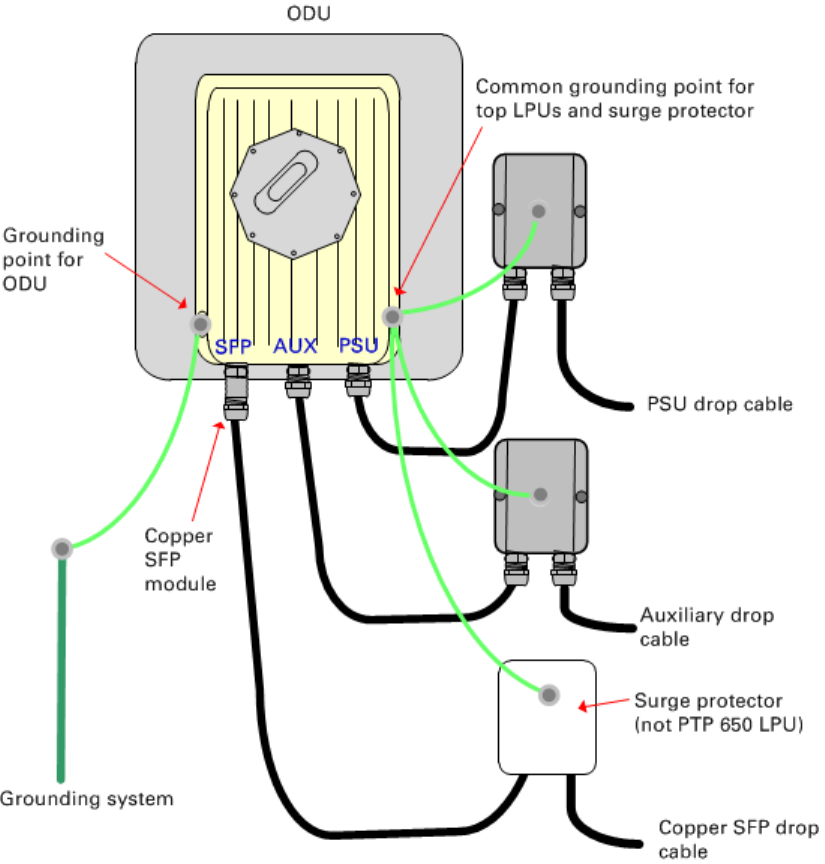
Chapter 3: System planning Site planning
Figure 44
ODU with PSU, Aux and copper SFP interfaces
UNDER DEVELOPMENT
Page 3-19
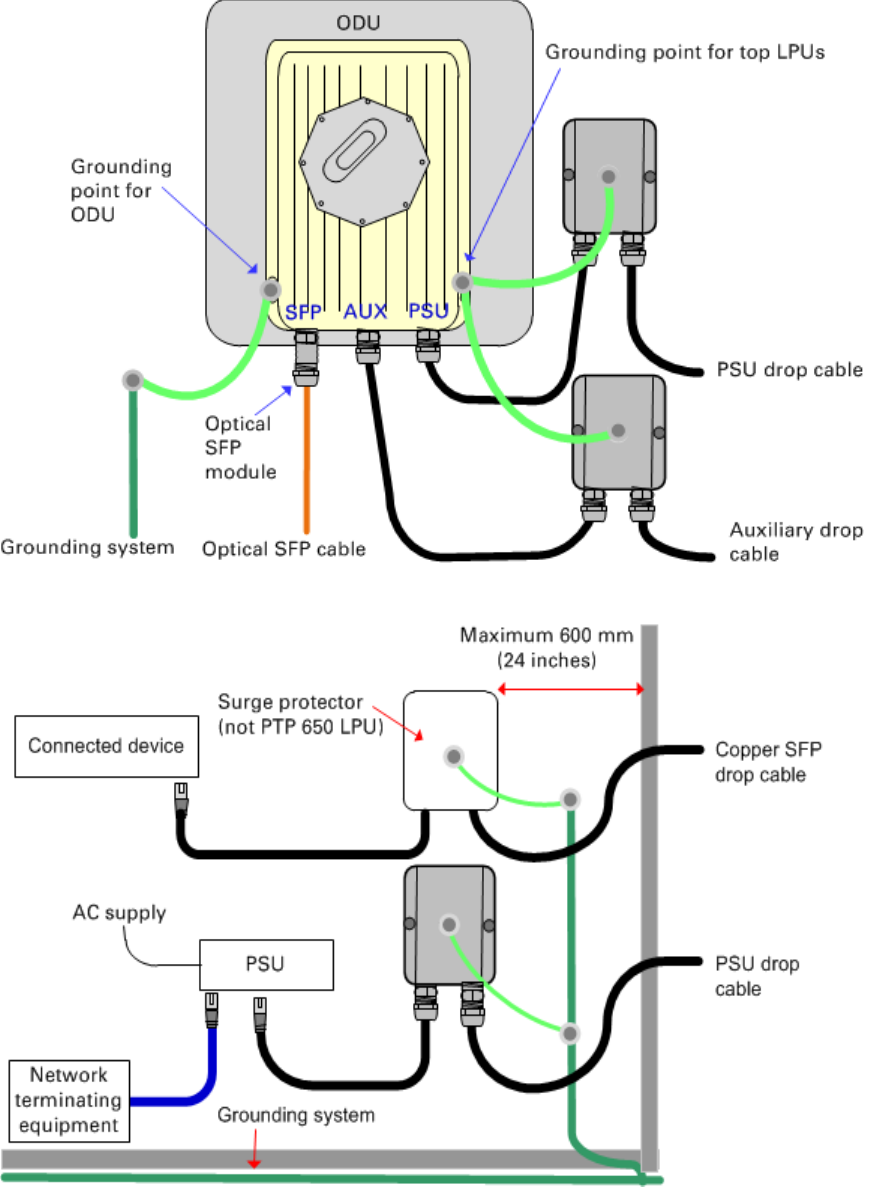
Chapter 3: System planning Site planning
Figure 45
ODU with PSU, Aux and optical SFP interfaces
Figure 46
Bottom LPU and surge protector
UNDER DEVELOPMENT
Page 3-20
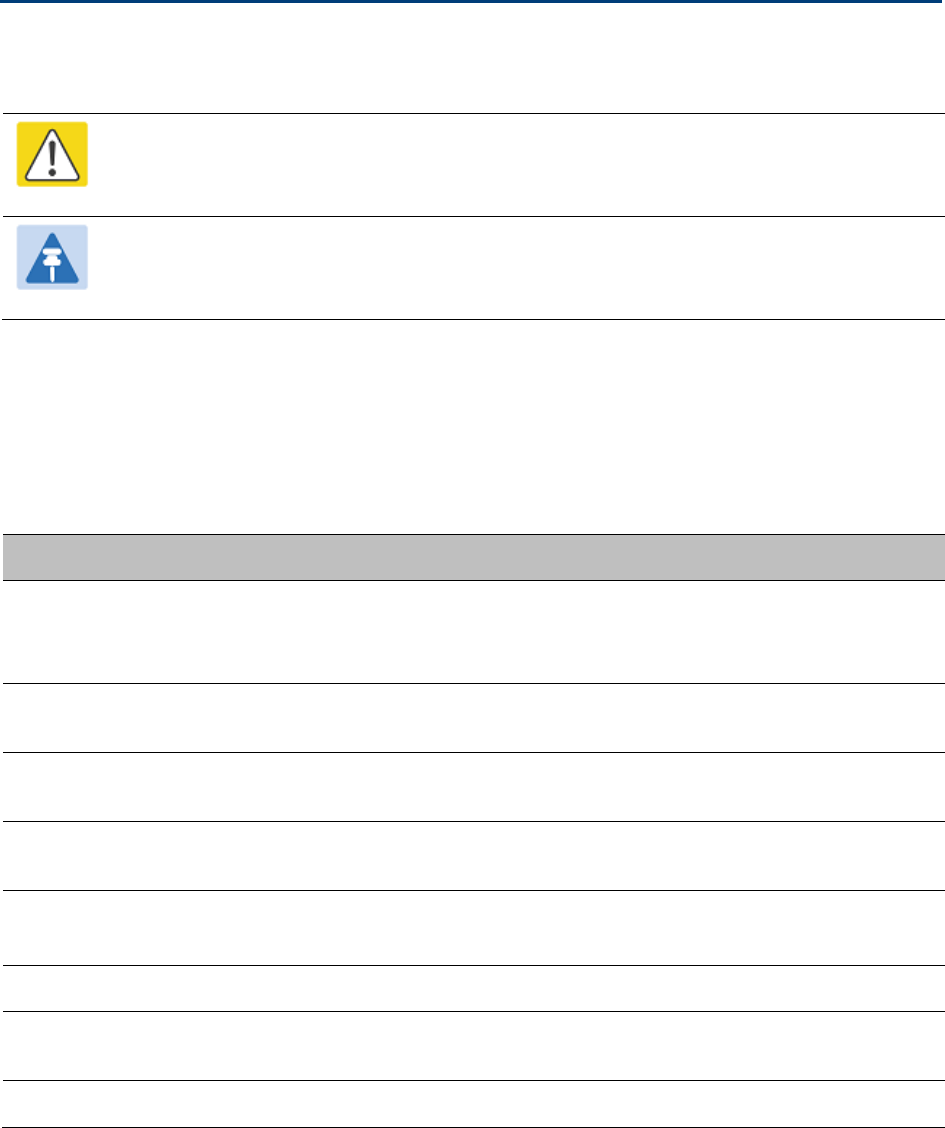
Chapter 3: System planning Radio spectrum planning
Radio spectrum planning
This section describes how to plan PTP 650 links to conform to the regulatory restrictions that
apply in the country of operation.
Caution
It is the responsibility of the user to ensure that the PTP product is operated in
accordance with local regulatory limits.
Note
Contact the applicable radio regulator to find out whether or not registration of the
PTP 650 link is required.
General wireless specifications
Table 54 lists the wireless specifications that apply to all PTP 650 frequency bands. Table 55 lists
the wireless specifications that are specific to a single frequency band.
Table 54
PTP 650 wireless specifications (all variants)
Item
Specification
Channel selection Manual selection (fixed frequency).
Dynamic frequency selection (DFS or DFS with DSO) is available
in radar avoidance regions.
Manual power control To avoid interference to other users of the band, maximum
power can be set lower than the default power limit.
Integrated antenna type 23 dBi Flat plate antenna (PTP 650) or 19 dBi Flat plate antenna
(PTP 650S or PTP 650L).
Duplex schemes Symmetric fixed, asymmetric fixed and, for the Full license only,
adaptive TDD.
Range Line-of-Sight: 200 km (125 miles).
Non-Line-of-Sight: 10 km (6 miles).
Over-the-air encryption AES 128-bit or 256-bit.
Weather sensitivity Sensitivity at higher modes may be reduced by adjusting the
Adaptive Modulation Threshold.
Error Correction FEC
UNDER DEVELOPMENT
Page 3-21

Chapter 3: System planning Radio spectrum planning
Table 55
PTP 650 wireless specifications (per frequency band)
Item
4.9 GHz
5.1 GHz
5.2 GHz
5.4 GHz
5.8 GHz
RF band (MHz) 4900–4990 5150–5250 5250–5350 5470–5725 5725–5875
Channel bandwidth
(MHz)
5, 10, 15, 20 5, 10, 15, 20,
30, 40, 45
5, 10, 15, 20,
30, 40, 45
5, 10, 15, 20,
30, 40, 45
5, 10, 15, 20,
30, 40, 45
Typical receiver noise 6 dB 6 dB 6 dB 6 dB 6 dB
Typical antenna gain
(integrated)
23 dBi 23 dBi 23 dBi 23 dBi 23 dBi
Antenna beamwidth
(integrated)
8° 8° 8° 8° 8°
Regulatory limits
Many countries impose EIRP limits (Allowed EIRP) on products operating in the bands used by the
PTP 650 Series. For example, in the 5.4 GHz and 5.8 GHz bands, these limits are calculated as
follows:
• In the 5.4 GHz band (5470 MHz to 5725 MHz), the EIRP must not exceed the lesser of 30 dBm or
(17 + 10 x Log Channel width in MHz) dBm.
• In the 5.8 GHz band (5725 MHz to 5875 MHz), the EIRP must not exceed the lesser of 36 dBm or
(23 + 10 x Log Channel width in MHz) dBm.
Some countries (for example the USA) impose conducted power limits on products operating in
the 5.8 GHz band.
Conforming to the limits
Ensure the link is configured to conform to local regulatory requirements by installing license keys
for the correct country. In the following situations, the license key does not prevent operation
outside the regulations:
• When using connectorized ODUs with external antennas, the regulations may require the
maximum transmit power to be reduced.
• When installing 5.2 GHz or 5.4 GHz links in the USA, it may be necessary to avoid frequencies
used by Terminal Doppler Weather Radar (TDWR) systems. For more information, refer to
Avoidance of weather radars (USA only) on page 3-24.
UNDER DEVELOPMENT
Page 3-22
Chapter 3: System planning Radio spectrum planning
Available spectrum
The available spectrum for operation depends on the regulatory band. When configured with the
appropriate license key, the unit will only allow operation on those channels which are permitted
by the regulations.
Certain regulations have allocated certain channels as unavailable for use:
• ETSI has allocated part of the 5.4 GHz band to weather radar.
• UK and some other European countries have allocated part of the 5.8 GHz band to Road
Transport and Traffic Telematics (RTTT) systems.
The number and identity of channels barred by the license key and regulatory band is dependent
on the channel bandwidth and channel raster selected.
Barred channels are indicated by a “No Entry” symbol displayed on the Spectrum Management
web page (Spectrum management in radar avoidance mode on page 7-37).
Channel bandwidth
Select the required channel bandwidth for the link. The selection depends upon the regulatory
band selected.
The wider the channel bandwidth, the greater the capacity. As narrower channel bandwidths take
up less spectrum, selecting a narrow channel bandwidth may be a better choice when operating in
locations where the spectrum is very busy.
Both ends of the link must be configured to operate on the same channel bandwidth.
Frequency selection
Regions without mandatory radar detection
In regions that do not mandate DFS, choose
DSO
or
Fixed Frequency
:
•
Dynamic Spectrum Optimization (DSO)
: In this mode, the unit monitors the spectrum looking
for the channel with the lowest level of interference. Statistical techniques are used to select
the most appropriate transmit and receive channels. The unit can be configured such that it
operates in DSO mode, but does not operate on selected channels. This allows a frequency
plan to be implemented in cases where multiple links are installed in close proximity.
•
Fixed Frequency
: In this mode, the unit must be configured with a single fixed transmit
frequency and a single fixed receive frequency. These may set to the same value or to different
values. This mode should only be considered in exceptional circumstances, for example where
it is known that are no sources of interference on the selected channels.
UNDER DEVELOPMENT
Page 3-23

Chapter 3: System planning Radio spectrum planning
Regions with mandatory radar detection
In regions that mandate DFS, the unit first ensures that there is no radar activity on a given
channel for a period of 60 seconds before radiating on that channel. Once a channel has been
selected for operation, the unit will continually monitor for radar activity on the operating channel.
If detected, it will immediately cease radiating and attempt to find a new channel. In DFS regions,
choose
DFS
or
DFS with DSO
:
•
Dynamic Frequency Selection (DFS)
: Once a channel is selected, the unit will only attempt to
find an alternative channel if radar activity has been detected on the operating channel.
•
DFS with DSO
: In addition to switching channels on detection of radar, the unit will also switch
to a channel which has a significantly lower level of interference than the current channel of
operation. Before radiating on the newly selected channel, the unit must again ensure that
there is no radar activity on the new channel for a period of 60 seconds. This mode therefore
provides the benefit of switching to a channel with lower interference but at the expense of an
outage of approximately 60 to 120 seconds. For this reason, the threshold for switching
channels is greater than when DSO is operating in a non-radar region.
Radar avoidance requirements in the 5.4 GHz band are defined as follows:
• For the EU: in specification EN 301-893.
• For the US: in the specification FCC part 15.407 plus the later requirements covered in
Important Regulatory Information in this User Guide.
• For Canada: in the specification RSS210 Annex 9.
Radar avoidance at 5.8 GHz is applicable to EU operation (not FCC/IC) and the requirements are
defined in EN 302 502 v1.2.1.
Avoidance of weather radars (USA only)
To comply with FCC rules (KDB 443999: Interim Plans to Approve UNII Devices Operating in the
5470 - 5725 MHz Band with Radar Detection and DFS Capabilities), units which are installed within
35 km (22 miles) of a Terminal Doppler Weather Radar (TDWR) system (or have a line of sight
propagation path to such a system) must be configured to avoid any frequency within +30 MHz or
–30 MHz of the frequency of the TDWR device. This requirement applies even if the master is
outside the 35 km (22 miles) radius but communicates with outdoor clients which may be within
the 35 km (22 miles) radius of the TDWRs. If interference is not eliminated, a distance limitation
based on line-of-sight from TDWR will need to be used. Devices with bandwidths greater than 20
MHz may require greater frequency separation.
When planning a link in the USA, visit http://spectrumbridge.com/udia/home.aspx, enter the
location of the planned link and search for TDWR radars. If a TDWR system is located within 35 km
(22 miles) or has line of sight propagation to the PTP device, perform the following tasks:
• Register the installation on http://spectrumbridge.com/udia/home.aspx.
• Make a list of channel center frequencies that must be barred, that is, those falling within
+30 MHz or –30 MHz of the frequency of the TDWR radars.
The affected channels must be barred as described in Barring channels on page 7-39.
UNDER DEVELOPMENT
Page 3-24

Chapter 3: System planning Link planning
Link planning
This section describes factors to be taken into account when planning links, such as range,
obstacles path loss and throughput. PTP LINKPlanner is recommended.
PTP LINKPlanner
The Cambium PTP LINKPlanner software and user guide may be downloaded from the support
website (see Contacting Cambium Networks on page 1).
PTP LINKPlanner imports path profiles and predicts data rates and reliability over the path. It
allows the system designer to try different antenna heights and RF power settings. It outputs an
installation report that defines the parameters to be used for configuration, alignment and
operation. Use the installation report to compare predicted and actual link performance.
Range and obstacles
Calculate the range of the link and identify any obstacles that may affect radio performance.
Perform a survey to identify all the obstructions (such as trees or buildings) in the path and to
assess the risk of interference. This information is necessary in order to achieve an accurate link
feasibility assessment.
The PTP 650 Series is designed to operate in Non-Line-of-Sight (NLoS) and Line-of-Sight (LoS)
environments. An NLOS environment is one in which there is no optical line-of-sight, that is, there
are obstructions between the antennas.
The PTP 650 Series will operate at ranges from 100 m (330 ft) to 200 km (125 miles), within 3
modes: 0-40 km (0-25 miles), 0-100 km (0-62 miles) and 0-200 km (0-124 miles). Operation of the
system will depend on obstacles in the path between the units. Operation at 40 km (25 miles) or
above will require a near line-of-sight path. Operation at 100 m (330 ft) could be achieved with one
unit totally obscured from the other unit, but with the penalty of transmitting at higher power in a
non-optimal direction, thereby increasing interference in the band.
LoS links in radar regions
When planning an LoS link to operate in a radar detection region, ensure that receiver signal level
is low enough to allow the PTP 650 to detect radar signals:
• With integrated antennas, the recommended minimum LoS operating range is 110 meters
(360 ft) for 5.2 GHz or 5.4 GHz, and 185 meters (610 ft) for 5.8 GHz. Shorter operating ranges
will lead to excessive receiver signal levels.
• With higher gain connectorized antennas, ensure the predicted receiver signal level (from
LINKPlanner) is below -53 dBm (for 5.2 GHz or 5.4 GHz) or below -58 dBm (for 5.8 GHz).
UNDER DEVELOPMENT
Page 3-25
Chapter 3: System planning Link planning
PTP LINKPlanner for synchronized networks
TDD synchronization should be planned using PTP LINKPlanner. This will provide the necessary
TDD frame parameter values which are required to complete a synchronized installation. Please
refer to the PTP LINKPlanner User Guide.
Path loss
Path loss is the amount of attenuation the radio signal undergoes between the two ends of the
link. The path loss is the sum of the attenuation of the path if there were no obstacles in the way
(Free Space Path Loss), the attenuation caused by obstacles (Excess Path Loss) and a margin to
allow for possible fading of the radio signal (Fade Margin). The following calculation needs to be
performed to judge whether a particular link can be installed:
capabilityseasonal
fadeexcessspace
free L
LL
LL <
+++
_
Where: Is:
space
free
L
_
Free Space Path Loss (dB)
excess
L
Excess Path Loss (dB)
fade
L
Fade Margin Required (dB)
seasonal
L
Seasonal Fading (dB)
capability
L
Equipment Capability (dB)
Adaptive modulation
Adaptive modulation ensures that the highest throughput that can be achieved instantaneously
will be obtained, taking account of propagation and interference. When the link has been installed,
web pages provide information about the link loss currently measured by the equipment, both
instantaneously and averaged. The averaged value will require maximum seasonal fading to be
added, and then the radio reliability of the link can be computed. For minimum error rates on TDM
links, the maximum modulation mode should be limited to 64QAM 0.75.
For details of the system threshold, output power and link loss for each frequency band in all
modulation modes for all available channel bandwidths, refer to System threshold, output power
and link loss on page 3-57.
UNDER DEVELOPMENT
Page 3-26

Chapter 3: System planning Link planning
Calculating data rate capacity
The data rate capacity of a PTP link is defined as the maximum end-to-end Ethernet throughput
(including Ethernet headers) that it can support. It is assumed that Ethernet frames are 1518 octet.
Data rate capacity is determined by the following factors:
• Licensed data throughput capability (ODU license: Lite, Mid or Full; for PTP 650L, use Full)
• Link Symmetry
• Link Mode Optimization (IP or TDM)
• Modulation Mode
• Channel Bandwidth
• Link Range
• Capacity reserved for TDM operation
Calculation procedure
To calculate the data rate capacity of a PTP 650 link, proceed as follows:
1
Use the tables in
Data throughput capacity tables on page 3-68
to look up the data throughput
capacity rates (Tx, Rx and Both) for the required combination of:
•
Link Symmetry
•
Link Mode Optimization
•
Modulation Mode
•
Channel Bandwidth
The tables contain data rates for
PTP 650 Full only.
2
The tables
contain data rates for links of zero range. Use the range adjustment graphs in Data
throughput capacity tables
on page 3-68 to look up the Throughput Factor that must be
applied to adjust the data rates for the actual range of the link.
3
Multiply the data rates by the Throughput Factor to give the throughput
capacity of the link.
4
Subtract capacity reserved for TDM operation. See
TDM traffic load on page 3-112.
Note
The data rates for adaptive symmetry apply to the most asymmetric case where the
link has significant offered traffic in one direction only. The data rates for adaptive
symmetry with bidirectional offered traffic are the same as those for link symmetry 1:1
with link optimization IP.
UNDER DEVELOPMENT
Page 3-27
Chapter 3: System planning Link planning
Calculation example
Suppose that the link characteristics are:
• PTP 650 variant = Mid
• Link Symmetry = 1:1
• Link Mode Optimization = TDM
• Modulation Mode = 64QAM 0.92 Dual
• Channel Bandwidth = 10 MHz
• Link Range = 60 km
The calculation procedure for this example is as follows:
1
Use Table 92 to look up the data throughput capacity rates:
Tx = 23 Mbits/s
Rx = 23 Mbits/s
Aggregated = 46 Mbits/s
2
Use Figure 70 to look up the Throughput Factor for 1:1, TDM, 10 MHz, Mid and Link Range
60 km. The factor is 0.86.
3
Multiply the rates from Step 1 by the Throughput Factor from Step 2 to give the throughput
capacity of the link:
Tx = 19.8 Mbits/s
Rx = 19.8 Mbits/s
Aggregated = 39.6 Mbits/s
UNDER DEVELOPMENT
Page 3-28

Chapter 3: System planning Planning for connectorized units
Planning for connectorized units
This section describes factors to be taken into account when planning to use connectorized ODUs
with external antennas in PTP 650 links.
When to install connectorized units
The majority of radio links can be successfully deployed with the integrated ODU. However the
integrated units may not be sufficient in some areas, for example:
• Where the path is heavily obscured by dense woodland on an NLOS link.
• Where long LOS links (>23 km or >14 miles) are required.
• Where there are known to be high levels of interference.
PTP LINKPlanner can be used to identify these areas of marginal performance.
In these areas, connectorized ODUs and external antennas should be used.
Choosing external antennas
When selecting external antennas, consider the following factors:
• The required antenna gain.
• Ease of mounting and alignment.
• Antenna polarization:
o For a simple installation process, select one dual-polarization antenna (as the integrated
antenna) at each end.
o To achieve spatial diversity, select two single-polarization antennas at each end. Spatial
diversity provides additional fade margin on very long LOS links where there is evidence of
correlation of the fading characteristics on Vertical and Horizontal polarizations.
Note
Enter the antenna gain and cable loss into the Installation Wizard, if the country
selected has an EIRP limit, the corresponding maximum transmit power will be
calculated automatically by the unit.
UNDER DEVELOPMENT
Page 3-29

Chapter 3: System planning Planning for connectorized units
Note
Under Industry Canada regulations, this radio transmitter may only operate using an
antenna of a type and maximum (or lesser) gain approved for the transmitter by
Industry Canada. To reduce potential radio interference to other users, the antenna
type and its gain should be so chosen that the equivalent isotropically radiated power
(EIRP) is not more than that necessary for successful communication.
Conformément à la réglementation d'Industrie Canada, le présent émetteur radio peut
fonctionner avec une antenne d'un type et d'un gain maximal (ou inférieur) approuvé
pour l'émetteur par Industrie Canada. Dans le but de réduire les risques de brouillage
radioélectrique à l'intention des autres utilisateurs, il faut choisir le type d'antenne et
son gain de sorte que la puissance isotrope rayonnée équivalente (p.i.r.e.) ne dépasse
pas l'intensité nécessaire à l'établissement d'une communication satisfaisante.
Calculating RF cable length (5.8 GHz FCC only)
The 5.8 GHz band FCC approval for the product is based on tests with a cable loss between the
ODU and antenna of not less than 1.2 dB. If cable loss is below 1.2 dB with a 1.3 m (4 ft) diameter
external antenna, the connectorized PTP 650 may exceed the maximum radiated spurious
emissions allowed under FCC 5.8 GHz rules.
Cable loss depends mainly upon cable type and length. To meet or exceed the minimum loss of
1.2 dB, use cables of the type and length specified in Table 56 (source: Times Microwave). This
data excludes connector losses.
Table 56
RF cable lengths required to achieve 1.2 dB loss at 5.8 GHz
RF cable type
Minimum cable length
LMR100 0.6 m (1.9 ft)
LMR200 1.4 m (4.6 ft)
LMR300 2.2 m (7.3 ft)
LMR400 3.4 m (11.1 ft)
LMR600 5.0 m (16.5 ft)
UNDER DEVELOPMENT
Page 3-30

Chapter 3: System planning Configuration options for TDD synchronization
Configuration options for TDD synchronization
This section describes the different configuration options that may be used for implementing TDD
synchronization in the PTP 650 Series. Schematic diagrams are included.
The PTP 650 supports the following TDD synchronization configurations:
• Single link configuration with PTP-SYNC on page 3-32.
• Cluster with PTP-SYNC and GPS receiver on page 3-33.
• Cluster with PTP-SYNC and no GPS receiver on page 3-34.
Caution
The PTP-SYNC is compatible only with the AC + DC Power Injector.
The AC Power Injector will not work with a PTP-SYNC, and it is likely that a fuse will
be blown in the PTP-SYNC if this is attempted.
UNDER DEVELOPMENT
Page 3-31
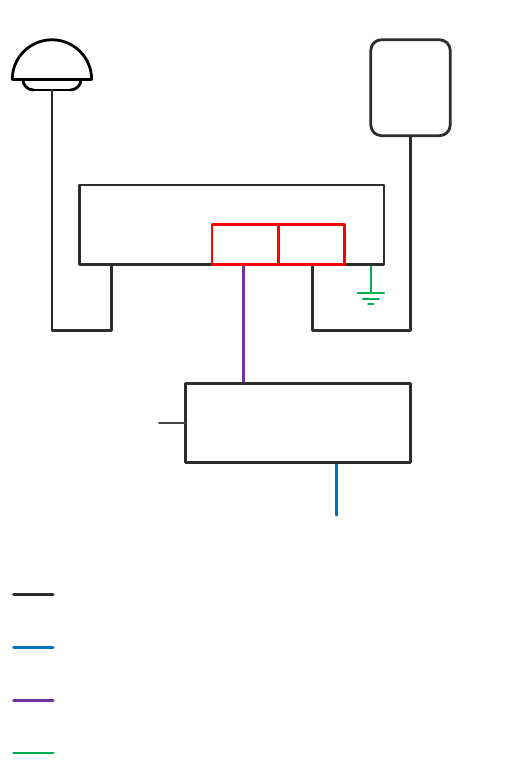
Chapter 3: System planning Configuration options for TDD synchronization
Single link configuration with PTP-SYNC
Each link requires one PTP-SYNC unit connected to the master ODU and one compatible GPS
receiver. Use this configuration where a site contains only one TDD master ODU. The GPS receiver
and LPU can be replaced by an alternative compatible 1 Hz timing reference (Figure 47).
The wireless configuration settings are:
• Master Slave Mode =
Master
.
• TDD Sync Device =
PTPSYNC
.
• Cluster Master Slave =
Cluster Master
.
• PTP Sync Site Reference =
GPS/1PPS External
.
Figure 47
TDD synchronization configuration – single link with PTP-SYNC
ODU
GPS
receiver
PTP-SYNC
GPS/
SYNC IN
SYNC
OUT
PIDU
IN
ODU
OUT
ODU
LAN
AC+DC Power
Injector
AC In
Customer
LAN
AC supply
Outdoor CAT5e cable, gel-filled,
shielded with copper-plated steel.
CAT5e cable, foil or braid screened,
with screened connectors.
CAT5e cable, unscreened or
screened.
Ground cable.
UNDER DEVELOPMENT
Page 3-32
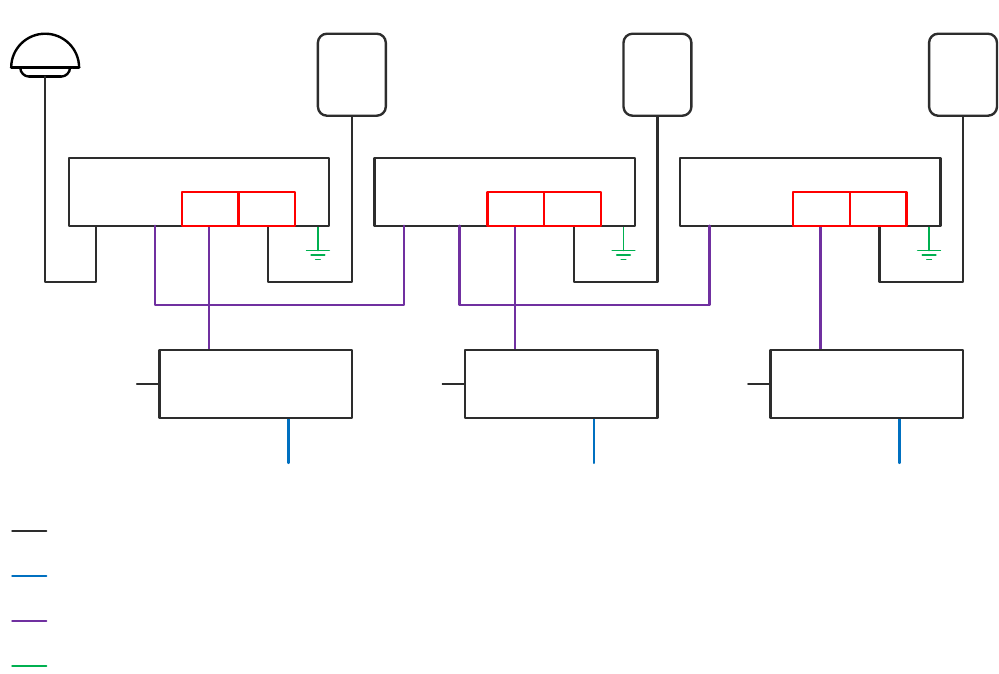
Chapter 3: System planning Configuration options for TDD synchronization
Cluster with PTP-SYNC and GPS receiver
Each link requires one PTP-SYNC unit. Each site requires one compatible GPS receiver. Collocated
PTP-SYNC units are connected together in a daisy-chain. Between two and ten PTP-SYNCs may be
chained in this way. Use this configuration where a site contains collocated TDD master ODUs in
an extended network and where multiple sites have TDD master ODUs (Figure 48).
The wireless configuration settings are:
• Master Slave Mode =
Master
(all ODUs in cluster).
• TDD Sync Device =
PTPSYNC
(all ODUs in cluster).
• Cluster Master Slave =
Cluster Master
(first ODU) and
Cluster Slave
(others).
• PTP Sync Site Reference =
GPS/1PPS External
(all ODUs in cluster).
Figure 48
TDD synchronization configuration – cluster with PTP-SYNC and GPS
Cluster
Master
ODU
GPS
receiver
PTP-SYNC
GPS/
SYNC IN
SYNC
OUT
PIDU
IN
ODU
OUT
ODU
LAN
AC+DC Power
Injector
AC In
Customer
LAN
AC supply
Outdoor CAT5e cable, gel-filled,
shielded with copper-plated steel.
CAT5e cable, foil or braid screened,
with screened connectors.
CAT5e cable, unscreened or
screened.
Ground cable.
Cluster
Slave
ODU
PTP-SYNC
GPS/
SYNC IN
SYNC
OUT
PIDU
IN
ODU
OUT
ODU
LAN
AC+DC Power
Injector
AC In
Customer
LAN
AC supply
Cluster
Slave
ODU
PTP-SYNC
GPS/
SYNC IN
SYNC
OUT
PIDU
IN
ODU
OUT
ODU
LAN
AC+DC Power
Injector
AC In
Customer
LAN
AC supply
UNDER DEVELOPMENT
Page 3-33
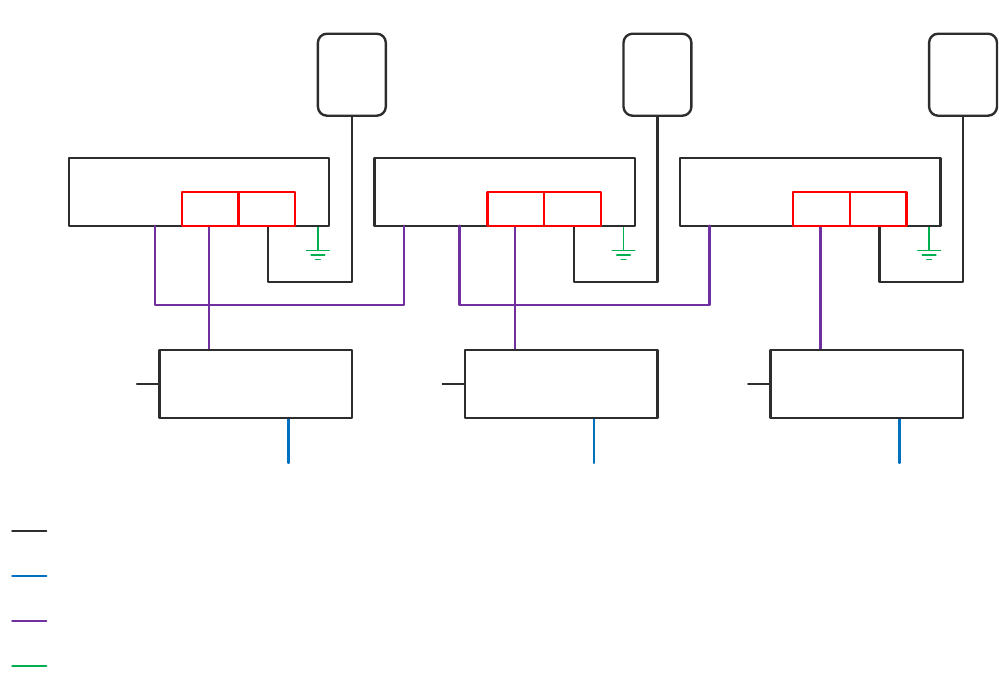
Chapter 3: System planning Configuration options for TDD synchronization
Cluster with PTP-SYNC and no GPS receiver
Each link requires one PTP-SYNC unit. PTP-SYNC units are connected together in a daisy-chain.
Between two and ten PTP-SYNCs may be chained in this way. One ODU is designated as a cluster
master. Use this configuration where all master ODUs are collocated at a single site. As this
configuration does not require a GPS receiver, it provides additional flexibility, particularly in
applications requiring rapid deployment (Figure 49).
The wireless configuration settings are:
• Master Slave Mode =
Master
(all ODUs in cluster).
• TDD Sync Device =
PTPSYNC
(all ODUs in cluster).
• Cluster Master Slave =
Cluster Master
(first ODU) and
Cluster Slave
(others).
• PTP Sync Site Reference =
Internal
(all ODUs in cluster).
Figure 49
TDD synchronization configuration – cluster with PTP-SYNC and no GPS
Cluster
Master
ODU
PTP-SYNC
GPS/
SYNC IN
SYNC
OUT
PIDU
IN
ODU
OUT
ODU
LAN
AC+DC Power
Injector
AC In
Customer
LAN
AC supply
Outdoor CAT5e cable, gel-filled,
shielded with copper-plated steel.
CAT5e cable, foil or braid screened,
with screened connectors.
CAT5e cable, unscreened or
screened.
Ground cable.
Cluster
Slave
ODU
PTP-SYNC
GPS/
SYNC IN
SYNC
OUT
PIDU
IN
ODU
OUT
ODU
LAN
AC+DC Power
Injector
AC In
Customer
LAN
AC supply
Cluster
Slave
ODU
PTP-SYNC
GPS/
SYNC IN
SYNC
OUT
PIDU
IN
ODU
OUT
ODU
LAN
AC+DC Power
Injector
AC In
Customer
LAN
AC supply
UNDER DEVELOPMENT
Page 3-34

Chapter 3: System planning Data network planning
Data network planning
This section describes factors to be considered when planning PTP 650 data networks.
Ethernet interfaces
The PTP 650 Ethernet ports conform to the specifications listed in Table 59.
Table 57
PTP 650 Ethernet bridging specifications
Ethernet Bridging
Specification
Protocol IEEE802.1; IEEE802.1p; IEEE802.3 compatible
QoS Eight wireless interface priority queues based on these
standards: IEEE 802.1p, IEEE 802.1Q, IEEE 802.1ah, IEEE
802.1ad, DSCP IPv4, DSCP IPv6, MPLS TC
Interfaces 100BASE-TX, 1000BASE-T, 1000BASE-SX, 1000BASE-LX
MDI/MDIX auto crossover supported
Max Ethernet frame size 9600 bytes
Service classes for traffic 8 classes
Practical Ethernet rates depend on network configuration and higher layer protocols. Over the air
throughput is capped to the rate of the Ethernet interface at the receiving end of the link.
Layer two control protocols
PTP 650 identifies layer two control protocols (L2CPs) from the Ethernet destination address of
bridged frames. The QoS classification can be separately configured for these protocols.
Table 58
Destination address in layer two control protocols
Destination address
Protocol
01-80-c2-00-00-00 to 01-80-c2-00-00-0f IEEE 802.1 bridge protocols
01-80-c2-00-00-20 to 01-80-c2-00-00-2f IEEE 802.1 Multiple Registration Protocol (MRP)
01-80-c2-00-00-30 to 01-80-c2-00-00-3f IEEE 802.1ag, Connectivity Fault Management (CFM)
01-19-a7-00-00-00 to 01-19-a7-00-00-ff Ring Automatic Protection Switching (R-APS)
00-e0-2b-00-00-04 Ethernet Automatic Protection Switching (EAPS)
UNDER DEVELOPMENT
Page 3-35

Chapter 3: System planning Data network planning
Ethernet port allocation
Port allocation rules
Decide how the three ODU Ethernet ports will be allocated to customer data, in-band management
and out-of-band management, based on the following rules:
• Ensure that exactly one ODU port is allocated to the end-to-end customer data service. Allocate
this port to
Data Only
or
Data and In-Band Management
.
• Ensure that no more than one ODU port is allocated to the end-to-end management service.
Allocate this port (if required) to
Out-of-Band Remote Management
.
• Ensure that the management agent is not simultaneously connected to the customer data
service and the end-to-end management service. If any port is set to
Data and In-Band
Management
then do not set any of the remaining ports to
Out-of-Band Remote Management
.
• Ensure that the local management agent can be accessed from at least one ODU port. This port
may be set to
Data and In-Band Management
,
Out-of-Band Local Management
or
Out-of-Band
Remote Management
.
Apply the following additional rules, if appropriate:
• If the TDM interface (E1 or T1) is enabled, ensure that only the Main PSU port is allocated to
Data Only
or
Data and In-Band Management
.
• If the system is to be used in a Synchronous Ethernet hierarchy, ensure that the upstream
timing source is connected to the Main PSU port (downstream devices can be connected to
any port)
• If the system is operating as an IEEE 1588-2008 Transparent Clock, ensure the data path
traverses only the Main PSU ports at both ends of the link.
Note
The Main PSU port is always used to supply power to the ODU, even when it is
Disabled for the purpose of Ethernet port allocation.
Note
The procedure for configuring these ports at the web interface is decribed in
Configuring the ODU ports for customer and management traffic on page 6-20.
UNDER DEVELOPMENT
Page 3-36
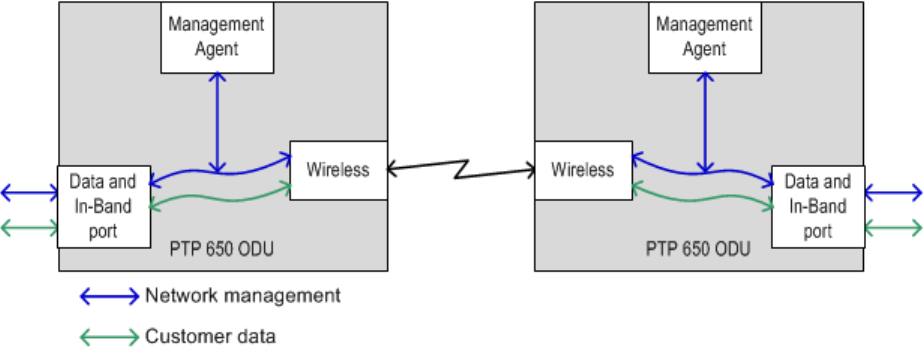
Chapter 3: System planning Data network planning
In-band management
Figure 50 shows two linked ODUs, each with a single port allocated to Data and In-Band
Management. The in-band management might be connected to a network management center or
to a management terminal of an installer or technician.
Management frames are not forwarded over the wireless link. Both management agents can be
accessed through the data ports at either end of the link.
Figure 50
In-band management (at both link ends)
UNDER DEVELOPMENT
Page 3-37
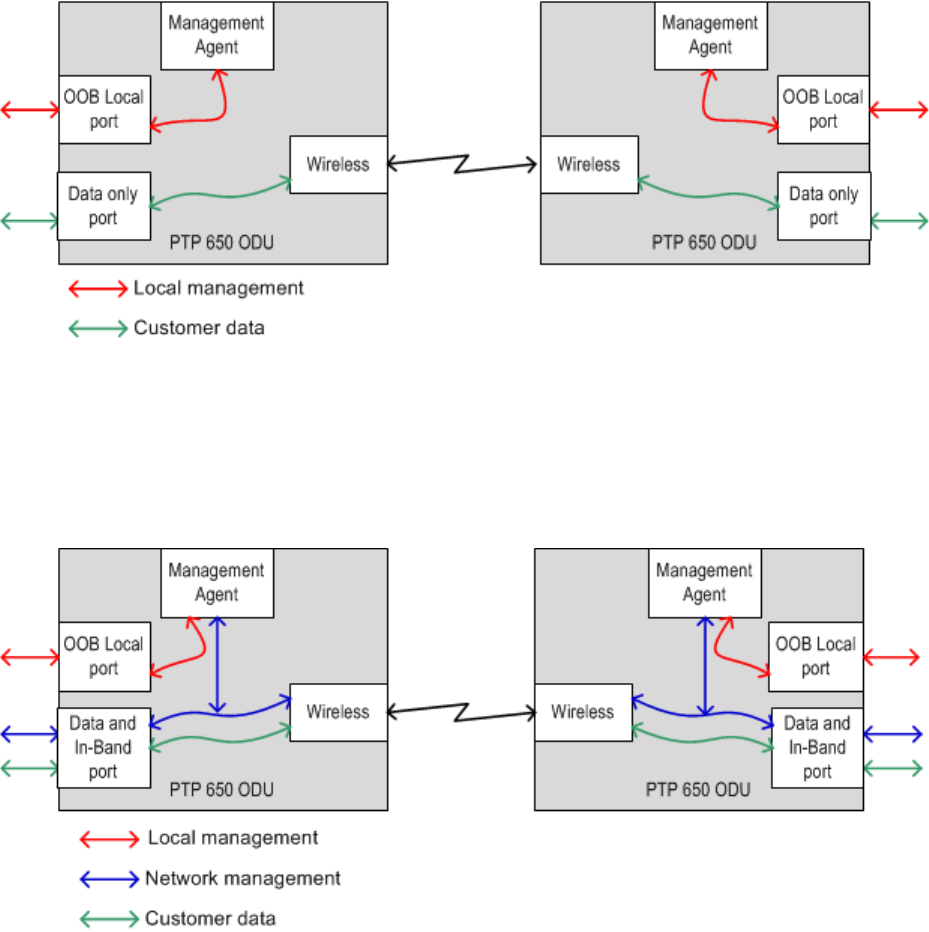
Chapter 3: System planning Data network planning
Out-of-band local management
Figure 51 shows shows two linked ODUs, each with one port allocated to Data Only and one
allocated to Out-of-Band Local Management. The local management network is isolated from the
customer data network. Management frames are not forwarded over the wireless link. The
management agents can be accessed only through the OOB Local ports at the respective ODUs.
Figure 51
Out-of-band local management (at both link ends)
Figure 52 shows shows two linked ODUs, each with a combination of in-band and out-of-band
local management. The out-of-band local port may be used to connect a management terminal of
an installer or technician, whilst the in-band management is connected to a network management
center.
Figure 52
IB and OOB local management (at both link ends)
UNDER DEVELOPMENT
Page 3-38
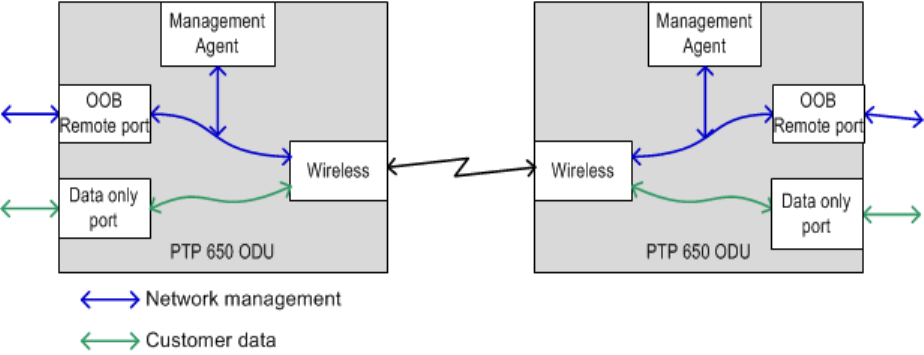
Chapter 3: System planning Data network planning
Out-of-band remote management
Figure 53 shows two linked ODUs, each with one port allocated to Data Only and one allocated to
Out-of-Band Remote Management. The management network is isolated from the customer data
network. Management frames are forwarded over the wireless link. Both management agents can
be accessed through the OOB Remote ports at either end of the link.
Figure 53
Out-of-band remote management (at both link ends)
There may be a security requirement to prevent the customer from accessing the remote
management network from an ODU that is located in the customer’s premises. If this requirement
is in force, use the Management Network Access Enabled control. Before leaving the customer’s
premises, the operator’s employee may change Management Network Access Enabled to
Disabled
(Figure 54), with the following results:
• An ODU located at the customer’s premises can be managed from the network core (over the
wireless link) in the normal way.
• A management station in the customer’s premises can access the management agent of the
local ODU, but this is protected by the standard password mechanism. The access provided at
the customer’s premises is effectively the same as in the out-of-band-local management mode.
• A management station in the customer’s premises cannot access the management agent of
the remote ODU (that is, the ODU closer to the core of the network), nor any part of the
management network that is reached via the wireless link.
UNDER DEVELOPMENT
Page 3-39
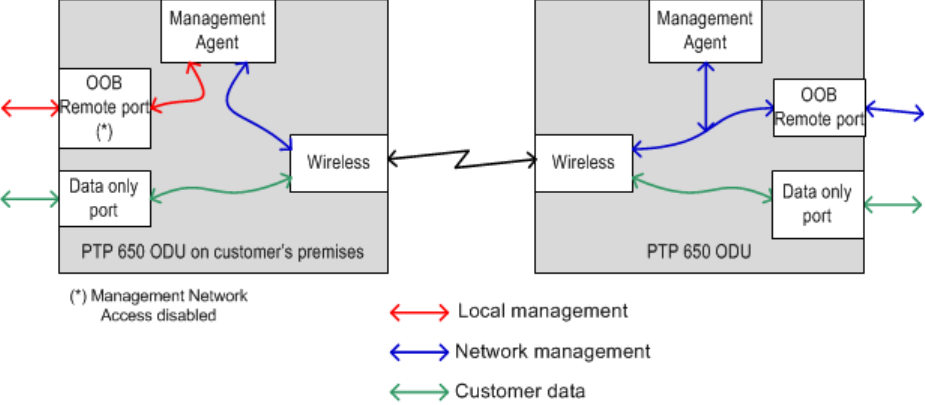
Chapter 3: System planning Data network planning
Figure 54
Out-of-band remote management with network access disabled
UNDER DEVELOPMENT
Page 3-40
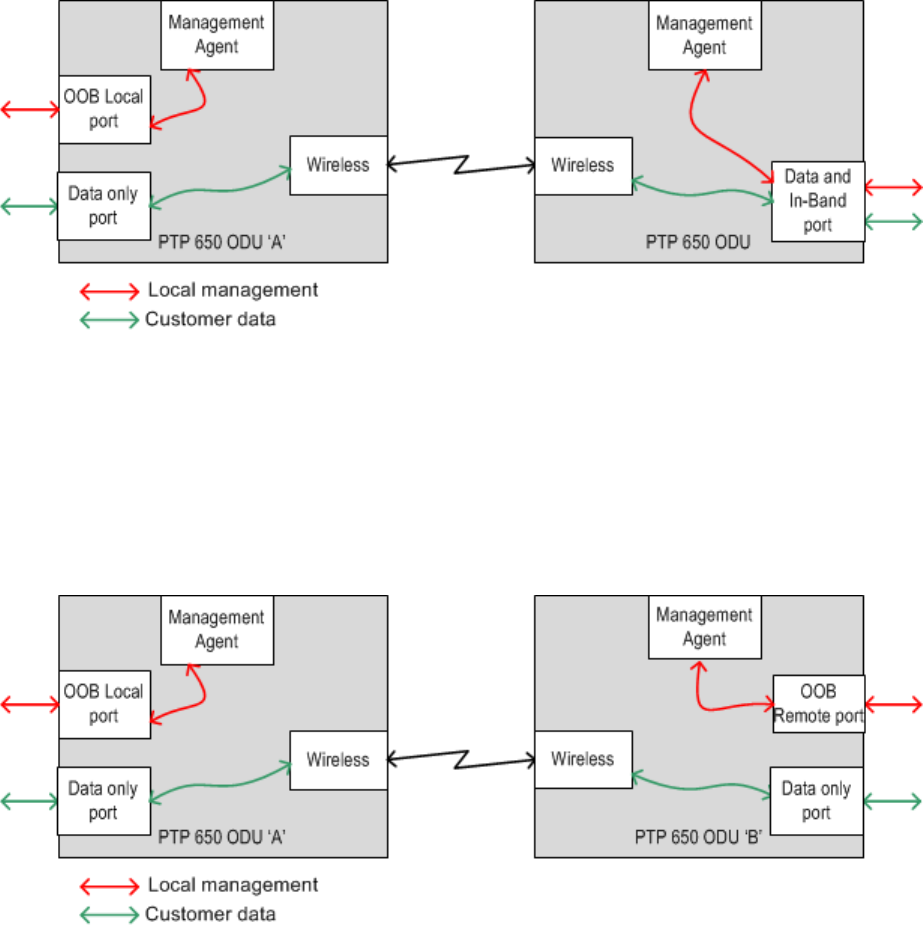
Chapter 3: System planning Data network planning
Linked ODUs with different management modes
It is possible to select different management modes at the two ends of the link.
Figure 55 shows a link in which end A is configured for OOB local management and end B is
configured for in-band management. Management frames are not forwarded over the wireless
link. The management agent at end A is only accessed through the OOB Local port at end A. The
management agent at end B is only accessed through the data port at end B.
Figure 55
OOB local management (end A) with IB management (end B)
Figure 56 shows a link in which end A is configured for OOB local management and end B is
configured for OOB remote management. Management frames are forwarded over the wireless
link from end B to end A, but these are discarded by end A. The management agent at end A is
only accessed through the OOB Local port at end A. The management agent at end B is only
accessed through the OOB Remote port at end B. In effect, the OOB Remote port at end B provides
the same level of access as an OOB Local port.
Figure 56
OOB local management (end A) with OOB remote management (end B)
UNDER DEVELOPMENT
Page 3-41
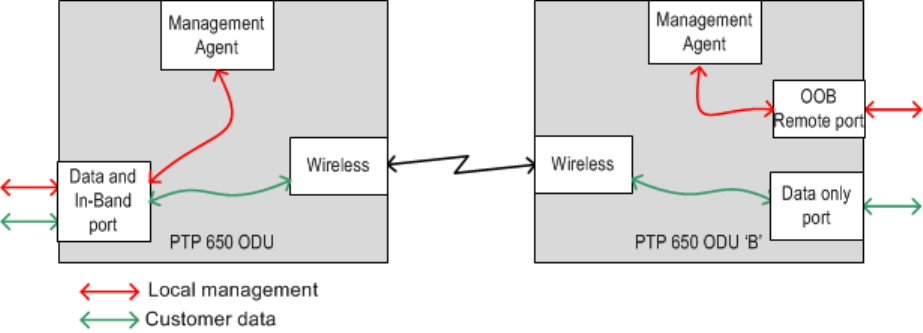
Chapter 3: System planning Data network planning
Figure 57 shows a link in which end A is configured for in-band management and end B is
configured for OOB remote management. Management frames are forwarded over the wireless
link from end B to end A, but these are discarded by end A. The management agent at end A is
only accessed through the data port at end A. The management agent at end B is only accessed
through the OOB Remote port at end B. In effect, the OOB Remote port at end B provides the same
level of access as an OOB Local port.
Figure 57
In-band management (end A) with OOB remote management (end B)
VLAN membership
Decide if the IP interface of the ODU management agent will be connected in a VLAN. If so, decide
if this is a standard (IEEE 802.1Q) VLAN or provider bridged (IEEE 802.1ad) VLAN, and select the
VLAN ID for this VLAN.
Use of a separate management VLAN is strongly recommended. Use of the management VLAN
helps to ensure that the ODU management agent cannot be accessed by customers.
If the system is to operate as an IEEE 1588-2008 Transparent Clock, decide if residence time
corrections should be made to:
• All 1588 event frames, regardless of VLAN membership, or
• Only 1588 event frames in a specific customer bridged VLAN, or
• Only 1588 event frames in a specific provider bridged VLAN
UNDER DEVELOPMENT
Page 3-42
Chapter 3: System planning Data network planning
Priority for management traffic
Choose the Ethernet and IP (DSCP) priority for management traffic generated within the ODU
management agent. The priority should be selected so as to be consistent with existing policy on
priority of management traffic in the network. Use of a high priority is strongly recommended to
ensure that management traffic is not discarded if the link is overloaded.
Ensure that the priority assigned to management traffic is consistent with the quality of service
scheme configured for bridged Ethernet traffic. If QoS for bridged traffic is based on the IP/MPLS
scheme, set the DSCP management priority to map to a high priority queue. If QoS for bridged
traffic is based on the Ethernet scheme, set the VLAN management priority to map to a high
priority queue.
IP interface
Select the IP version for the IP interface of the ODU management agent. PTP 650 can operate in
IPv4 mode, IPv6 mode, or in a dual IPv4/IPv6 mode. Choose one IPv4 address and/or one IPv6
address for the IP interface of the ODU management agent. The IP address or addresses must be
unique and valid for the connected network segment and VLAN.
Find out the correct subnet mask (IPv4) or prefix length (IPv6) and gateway IP address for this
network segment and VLAN.
Ensure that the design of the data network permits bidirectional routing of IP datagrams between
network management systems and the ODUs. For example, ensure that the gateway IP address
identifies a router or other gateway that provides access to the rest of the data network.
Quality of service for bridged Ethernet traffic
Decide how quality of service will be configured in PTP 650 to minimize frame loss and latency for
high priority traffic. Wireless links often have lower data capacity than wired links or network
equipment like switches and routers, and quality of service configuration is most critical at network
bottlenecks.
PTP 650 provides eight queues for traffic waiting for transmission over the wireless link. Q0 is the
lowest priority queue and Q7 is the highest priority queue. Traffic is scheduled using strict priority;
in other words, traffic in a given queue is transmitted when all higher-priority queues are empty.
Layer 2 control protocols
Select the transmission queue for each of the recognised layer 2 control protocols (L2CP). These
protocols are essential to correct operation of the Ethernet network, and are normally mapped to a
high priority queue. Ethernet frames that match one of the recognized L2CPs are not subject to the
Ethernet and IP/MPLS classification described below.
UNDER DEVELOPMENT
Page 3-43
Chapter 3: System planning Data network planning
Priority schemes
Select the priority scheme based on Ethernet priority or IP/MPLS priority to match QoS policy in
the rest of the data network. Ethernet priority is also known as Layer 2 or link layer priority.
IP/MPLS priority is also known as Layer 3 or network layer priority.
Ethernet priority scheme
Ethernet priority is encoded in a VLAN tag. Use the Ethernet priority scheme if the network carries
traffic in customer or service provider VLANs, and the priority in the VLAN tag has been set to
indicate the priority of each type of traffic. Select a suitable mapping from the Ethernet priority to
the eight PTP 650 queues.
An advantage of Ethernet priority is that any VLAN-tagged frame can be marked with a priority,
regardless of the higher-layer protocols contained within the frame. A disadvantage of Ethernet
priority is that the priority in the frame must be regenerated whenever traffic passes through a
router.
IP/MPLS priority scheme
IP priority is encoded in the DSCP value encoded in the ToS field in IPv4 and Traffic Class in IPv6.
The DSCP field provides 64 levels of priority. Determine the DSCP values used in the network and
select a suitable mapping from these DSCP values to the eight PTP 650 queues.
The advantages of IP priority are that priority in the IP header is normally propagated transparently
through a router, also the DSCP field supports a large number of distinct priority code points. A
disadvantage of DSCP is that frames receive a single default classification if they contain a network
layer protocol other than IPv4 or IPv6. This is controlled by the user setting the Unknown Network
Layer Protocol queue value in the same QoS Configuration page under IP/MPLS QoS.
MPLS priority is encoded in the traffic class (TC) field in the outermost MPLS label. Select a
suitable mapping from MPLS TC to the eight PTP 650 queues.
“Daisy-chaining” PTP 650 links
When connecting two or more PTP 650 links together in a network (daisy-chaining), do not install
direct copper Cat5e connections between the PSUs. Each PSU must be connected to the network
terminating equipment using the LAN port. To daisy-chain PTP 650 links, install each ODU-to-ODU
link using one of the following solutions:
• A copper Cat5e connection between the Aux ports of two ODUs. For details of the Ethernet
standards supported and maximum permitted cable lengths, see Ethernet standards and cable
lengths on page 2-36.
• A copper Cat5e connection between the Aux port of one ODU and the SFP port of the next
ODU (using a copper SFP module). For details of the Ethernet standards supported and
maximum permitted cable lengths, see Ethernet standards and cable lengths on page 2-36.
• Optical connections between the ODUs (SFP ports) using optical SFP modules at each ODU.
For details of the Ethernet standards supported and maximum permitted cable lengths, see
SFP module kits on page 2-43.
UNDER DEVELOPMENT
Page 3-44
Chapter 3: System planning Data network planning
Green Ethernet switches
Do not connect PTP 650 units to Ethernet networking products that control the level of the
transmitted Ethernet signal based on the measured length of the Ethernet link, for example Green
Ethernet products manufactured by D-Link Corporation. The Ethernet interfaces in these
networking products do not work correctly when connected directly to the PTP 650 PSU.
UNDER DEVELOPMENT
Page 3-45

Chapter 3: System planning TDM network planning
TDM network planning
This section describes factors to be considered when planning PTP 650 TDM networks.
Caution
If the ODU port has negotiated a link at 100BASE-T, the NIDU will not send or receive
TDM data, and will not bridge customer data traffic. Ensure that the Ethernet drop
cable between the ODU and the PSU, and the network cable between the PSU and the
NIDU, will reliably support operation at 1000BASE-T.
The PTP 650 TDM ports conform to the specifications listed in Table 59.
Table 59
PTP 650 TDM interface specifications (if NIDU installed)
TDM Bridging
Specification
TDM ports 8 E1 or 8 T1
ITU-T Recommendation G.703 (10/1998) – Series G:
“Transmission Systems and Media, Digital Systems and
Networks; “Physical/electrical characteristics of hierarchical
digital Interfaces”.
Timing ITU-T Recommendation G.823 (03/2000) – Series G:
“Transmission Systems and Media, Digital Systems and
Networks; The control of jitter and wander within digital
networks which are based on the 2048 kbits/s hierarchy”.
ITU-T Recommendation G.824 (03/2000) – Series G:
“Transmission Systems and Media, Digital Systems and
Networks; The control of jitter and wander within digital
networks which are based on the 1544 kbit/s hierarchy”.
Ethernet IEEE 802.3 2012 – IEEE Standard for Information technology –
Telecommunications and information – exchange between
systems – Local and metropolitan area networks – Specific
requirements.
Line coding AMI, B8ZS/HDB3
Line resistance 100 / 120 Ohm
E1/T1 latency (one way) Typically 1 to 3 ms depending on range, bandwidth,
modulation mode and number of E1/T1 port.
Use PTP LinkPlanner to calculate E1/T1 latency.
UNDER DEVELOPMENT
Page 3-46

Chapter 3: System planning Network management planning
Network management planning
This section describes how to plan for PTP 650 links to be managed remotely using SNMP.
Planning for SNMP operation
The supported notifications are as follows:
• Cold start
• Wireless Link Up/Down
• Channel Change
• DFS Impulse Interference
• Authentication Failure
• Main PSU Port Up Down
• Aux Port Up Down
• SFP Port Up Down
Ensure that the following MIBs are loaded on the network management system.
• RFC-1493. BRIDGE-MIB
• RFC-2233. IF-MIB
• RFC-3411. SNMP-FRAMEWORK-MIB
• RFC-3412. SNMP-MPD-MIB
• RFC-3413. SNMP-TARGET-MIB
• RFC-3414. SNMP-USER-BASED-SM-MIB
• RFC-3415. SNMP-VIEW-BASED-ACM-MIB
• RFC-3418. SNMPv2-MIB
• RFC-3826. SNMP-USM-AES-MIB
• RFC-4293 IP-MIB
• PTP 650 Series proprietary MIB
Note
The proprietary MIBs are provided in the PTP 650 Series software download files in
the support website (see Contacting Cambium Networks on page 1).
UNDER DEVELOPMENT
Page 3-47
Chapter 3: System planning Network management planning
Supported diagnostic alarms
PTP 650 supports the diagnostic alarms listed in Table 164.
The web-based interface may be used to enable or disable generation of each supported SNMP
notification or diagnostic alarm.
Enabling SNMP
Enable the SNMP interface for use by configuring the following attributes in the SNMP
Configuration page:
• SNMP State (default disabled)
• SNMP Version (default SNMPv1/2c)
• SNMP Port Number (default 161)
UNDER DEVELOPMENT
Page 3-48

Chapter 3: System planning Security planning
Security planning
This section describes how to plan for PTP 650 links to operate in secure mode.
Planning for SNTP operation
Note
PTP 650 does not have a battery-powered clock, so the set time is lost each time the
ODU is powered down. To avoid the need to manually set the time after each reboot,
use SNTP server synchronization.
Before starting to configure Simple Network Time Protocol (SNTP):
• Identify the time zone and daylight saving requirements that apply to the system.
• If SNTP server synchronization is required, identify the details of one or two SNTP servers: IP
address, port number and server key.
• Decide whether or not to authenticate received NTP messages using an MD5 signature.
Planning for HTTPS/TLS operation
Before starting to configure HTTPS/TLS operation, ensure that the cryptographic material listed in
Table 60 is available.
Table 60
HTTPS/TLS security material
Item
Description
Quantity required
Key of Keys An encryption key generated using a cryptographic
key generator. The key length is dictated by the
installed license key. License keys with AES-128
will require a key of keys of 128-bits. License keys
with AES-256 will require a key of keys of 256-bits.
The key output should be in ASCII hexadecimal
characters.
Two per link. For greater
security, each link end
should be allocated a
unique Key of Keys.
UNDER DEVELOPMENT
Page 3-49

Chapter 3: System planning Security planning
Item
Description
Quantity required
TLS Private Key
and Public
Certificates
An RSA private key of size 2048 bits, generated in
either PKCS#1 or PKCS#5 format, unencrypted, and
encoded in the ASN.1 DER format.
An X.509 certificate containing an RSA public key,
generated in either PKCS#1 or PKCS#5 format,
unencrypted, and encoded in the ASN.1 DER
format.
The public key certificate must have Common
Name equal to the IPv4 or IPv6 address of the
ODU.
The public key certificate must form a valid pair
with the private key.
Two pairs per link. These
items are unique to IP
address.
User Defined
Security Banner
The banner provides warnings and notices to be
read by the user before logging in to the ODU. Use
text that is appropriate to the network security
policy.
Normally one per link.
This depends upon
network policy.
Entropy Input This must be of size 512 bits (128 hexadecimal
characters), output from a random number
generator.
Two per link. For greater
security, each link end
should be allocated a
unique Entropy Input.
Wireless Link
Encryption Key
for AES
An encryption key generated using a cryptographic
key generator. The key length is dictated by the
selected AES encryption algorithm (128 or 256
bits).
One per link. The same
encryption key is
required at each link end.
Port numbers
for HTTP,
HTTPS and
Telnet
Port numbers allocated by the network. As allocated by network.
UNDER DEVELOPMENT
Page 3-50
Chapter 3: System planning Security planning
Planning for SNMPv3 operation
SNMP security mode
Decide how SNMPv3 security will be configured.
MIB-based security management uses standard SNMPv3 MIBs to configure the user-based
security model and the view-based access control model. This approach provides considerable
flexibility, allowing a network operator to tailor views and security levels appropriate for different
types of user. MIB-based security management may allow a network operator to take advantage of
built-in security management capabilities of existing network managers.
Web-based security management allows an operator to configure users, security levels, privacy
and authentication protocols, and passphrases using the PTP 650 web-based management
interface. The capabilities supported are somewhat less flexible than those supported using the
MIB-based security management, but will be sufficient in many applications. Selection of web-
based management for SNMPv3 security disables the MIB-based security management. PTP 650
does not support concurrent use of MIB-based and web-based management of SNMPv3 security.
Web-based management of SNMPv3 security
Initial configuration of SNMPv3 security is available only to HTTP or HTTPS/TLS user accounts
with security role of Security Officer.
Identify the minimum security role of HTTP or HTTPS/TLS user accounts that will be permitted
access for web-based management of SNMPv3 security. The following roles are available:
• System Administrator
• Security Officer
Identify the format used for SNMP Engine ID. The following formats are available:
• MAC address (default)
• IPv4 address
• Text string
• IPv6 address
If SNMP Engine ID will be based on a text string, identify the text string required by the network
management system. This is often based on some identifier that survives replacement of the PTP
hardware.
Identify the user names and security roles of initial SNMPv3 users. Two security roles are
available:
• Read Only
• System Administrator
Identify the security level for each of the security roles. Three security levels are available: (a) No
authentication, no privacy; (b) Authentication, no privacy; (c) Authentication, privacy.
If authentication is required, identify the protocol. Two authentication protocols are available: MD5
or SHA.
UNDER DEVELOPMENT
Page 3-51

Chapter 3: System planning Security planning
If privacy will be used, identify the protocol. Two privacy protocols are available: DES or AES (an
AES 128-bit or 256-bit capability upgrade must be purchased).
If authentication or authentication and privacy protocols are required, identify passphrases for
each protocol for each SNMP user. It is considered good practice to use different passphrases for
authentication and privacy. Passphrases must have length between 8 and 32 characters, and may
contain any of the characters listed in Table 61.
Table 61
Permitted character set for SNMPv3 passphrases
Character
Code
Character
Code
<space> 32 ; 59
! 33 < 60
“ 34 = 61
# 35 > 62
$ 36 ? 63
% 37 @ 64
& 38 A..Z 65..90
' 39 [ 91
( 40 \ 92
) 41 ] 93
* 42 ^ 94
+ 43 _ 95
, 44 ` 96
- 45 a..z 97..122
. 46 { 123
/ 47 | 124
0..9 48..57 } 125
: 58 ~ 126
Identify up to two SNMP users that will be configured to receive notifications (traps). Identify the
Internet address (IPv4 or IPv6) and UDP port number of the associated SNMP manager.
UNDER DEVELOPMENT
Page 3-52

Chapter 3: System planning Security planning
SNMPv3 default configuration (MIB-based)
When SNMPv3 MIB-based Security Mode is enabled, the default configuration for the
usmUserTable table is based on one initial user and four template users as listed in Table 62.
Table 62
Default SNMPv3 users
Object
Entry 1
Name initial
SecurityName initial
AuthProtocol usmHMACMD5AuthProtocol
PrivProtocol usmDESPrivProtocol
StorageType nonVolatile
Object
Entry 2
Entry 3
Name templateMD5_DES templateSHA_DES
SecurityName templateMD5_DES templateSHA_DES
AuthProtocol usmHMACMD5AuthProtocol usmHMACSAHAuthProtocol
PrivProtocol usmDESPrivProtocol usmDESPrivProtocol
StorageType nonVolatile nonVolatile
Object
Entry 4
Entry 5
Name templateMD5_AES templateSHA_AES
SecurityName templateMD5_AES templateSHA_AES
AuthProtocol usmHMACMD5AuthProtocol usmHMACSHAAuthProtocol
PrivProtocol usmAESPrivProtocol usmAESPrivProtocol
StorageType nonVolatile nonVolatile
UNDER DEVELOPMENT
Page 3-53

Chapter 3: System planning Security planning
VACM default configuration
The default user initial is assigned to VACM group initial in the vacmSecurityToGroupTable
table. The template users are not assigned to a group.
PTP 650 creates default view trees and access as shown in Table 63 and Table 64.
Table 63
Default VACM view trees
Object
Entry 1
Entry 2
ViewName internet restricted
Subtree 1.3.6.1 1.3.6.1
Mask “” “”
Type included included
StorageType nonVolatile nonvolatile
Table 64
Default data fill for access table
Object
Entry 1
Entry 2
GroupName initial initial
ContextPrefix “” “”
SecurityLevel authNoPriv noAuthNoPriv
ContextMatch exact exact
ReadViewName internet restricted
WriteViewName internet “”
NotifyViewName internet restricted
StorageType nonVolatile nonVolatile
UNDER DEVELOPMENT
Page 3-54
Chapter 3: System planning Security planning
Planning for RADIUS operation
Configure RADIUS where remote authentication is required for users of the web-based interface.
Remote authentication has the following advantages:
• Control of passwords can be centralized.
• Management of user accounts can be more sophisticated. For example; users can be prompted
by a network manager to change passwords at regular intervals. As another example,
passwords can be checked for inclusion of dictionary words and phrases.
• Passwords can be updated without reconfiguring multiple network elements.
• User accounts can be disabled without reconfiguring multiple network elements.
Remote authentication has one significant disadvantage in a wireless link product such as PTP 650.
If the wireless link is down, a unit on the remote side of the broken link may be prevented from
contacting a RADIUS Server, with the result that users are unable to access the web-based
interface.
One useful strategy would be to combine RADIUS authentication for normal operation with a
single locally-authenticated user account for emergency use.
PTP 650 provides a choice of the following authentication methods:
• CHAP
• MS-CHAPv2
Ensure that the authentication method selected in PTP 650 is supported by the RADIUS server.
RADIUS attributes
If the standard RADIUS attribute session-timeout (Type 27) is present in a RADIUS response, PTP
650 sets a maximum session length for the authenticated user. If the attribute is absent, the
maximum session length is infinite.
If the standard RADIUS attribute idle-timeout (Type 28) is present in a RADIUS response, PTP 650
overrides the Auto Logout Timer with this value in the authenticated session.
If the vendor-specific RADIUS attribute auth-role is present in a RADIUS response, PTP 650 selects
the role for the authenticated user according to auth-role. The supported values of auth-role are as
follows:
• 0: Invalid role. The user is not admitted.
• 1: Read Only
• 2: System Administrator
• 3: Security Officer
UNDER DEVELOPMENT
Page 3-55

Chapter 3: System planning Security planning
If the vendor-specific auth-role attribute is absent, but the standard service-type (Type 6) attribute
is present, PTP 650 selects the role for the authenticated user according to service-type. The
supported values of service-type are as follows:
• Login(1): Read Only
• Administrative(6): System Administrator
• NAS Prompt(7): Read Only
If the auth-role and service-type attributes are absent, PTP 650 selects the Read Only role.
The auth-role vendor-specific attribute is defined in Table 65.
Table 65
Definition of auth-role vendor-specific attribute
Field
Length
Value
Notes
Type 1 26 Vendor-specific attribute.
Length 1 12 Overall length of the attribute.
Vendor ID 4 17713 The same IANA code used for the SNMP enterprise
MIB.
Vendor Type 1 1 auth-role
Vendor Length 1 4 Length of the attribute specific part.
Attribute-
Specific
4 0..3 Integer type (32-bit unsigned). Supported values:
invalid-role(0), readonly-role(1), system-admin-role(2),
security-officer-role(3).
UNDER DEVELOPMENT
Page 3-56

Chapter 3: System planning System threshold, output power and link loss
System threshold, output power and link loss
Use the following tables to look up the system threshold (dBm), output power (dBm) and
maximum link loss (dB) per channel bandwidth and modulation mode:
Band
Mode
System threshold and output power (dBm)
Maximum link loss (dB)
4.9 GHz IP Table 66 Table 67
TDM Table 68 Table 69
5.1 GHz and
5.2 GHz
IP Table 70 Table 71
TDM Table 72 Table 73
5.4 GHz IP Table 74 Table 75
TDM Table 76 Table 77
5.8 GHz IP Table 78 Table 79
TDM Table 80 Table 81
5.9 GHz IP Table 82 Table 83
TDM Table 84 Table 85
Note
Maximum link loss has been calculated assuming use of the integrated antenna in
PTP 650 Integrated ODUs. Adjust the maximum link loss for alternative antennas by
adding (G – 23) for each antenna, where G is the antenna gain.
UNDER DEVELOPMENT
Page 3-57

Chapter 3: System planning System threshold, output power and link loss
Table 66
4.9 GHz IP mode: system threshold per channel bandwidth and output power (P) (dBm)
Modulation mode
5 MHz
10 MHz
15 MHz
20 MHz
P (all bands)
BPSK 0.63 single -96.6 -95.1 -93.3 -92.0 27
QPSK 0.63 single -93.5 -92.0 -90.2 -88.9 26
QPSK 0.87 single -89.4 -87.9 -86.2 -84.9 26
16QAM 0.63 single -87.1 -85.6 -83.8 -82.6 25
16QAM 0.63 dual -83.2 -81.7 -79.9 -78.7 25
16QAM 0.87 single -82.6 -81.1 -79.4 -78.1 25
16QAM 0.87 dual -79.6 -78.1 -76.3 -75.0 25
64QAM 0.75 single -79.6 -78.1 -76.3 -75.1 24
64QAM 0.75 dual -76.5 -75.0 -73.2 -71.9 24
64QAM 0.92 single -75.7 -74.2 -72.4 -71.2 24
64QAM 0.92 dual -72.4 -70.9 -69.2 -67.9 24
256QAM 0.81 single -72.4 -70.9 -69.1 -67.9 23
256QAM 0.81 dual -68.9 -67.3 -65.6 -64.3 23
Table 67
4.9 GHz IP mode: maximum link loss per channel bandwidth (dB)
Modulation mode
5 MHz
10 MHz
15 MHz
20 MHz
BPSK 0.63 single 169.6 168.1 166.3 165.0
QPSK 0.63 single 165.5 164.0 162.2 160.9
QPSK 0.87 single 161.4 159.9 158.2 156.9
16QAM 0.63 single 158.1 156.6 154.8 153.6
16QAM 0.63 dual 154.2 152.7 150.9 149.7
16QAM 0.87 single 153.6 152.1 150.4 149.1
16QAM 0.87 dual 150.6 149.1 147.3 146.0
64QAM 0.75 single 149.6 148.1 146.3 145.1
64QAM 0.75 dual 146.5 145.0 143.2 141.9
64QAM 0.92 single 145.7 144.2 142.4 141.2
64QAM 0.92 dual 142.4 140.9 139.2 137.9
256QAM 0.81 single 141.4 139.9 138.1 136.9
256QAM 0.81 dual 137.9 136.3 134.6 133.3
UNDER DEVELOPMENT
Page 3-58

Chapter 3: System planning System threshold, output power and link loss
Table 68
4.9 GHz TDM mode:system threshold per channel bandwidth and output power (P) (dBm)
Modulation mode
5 MHz
10 MHz
15 MHz
20 MHz
P (all bands)
BPSK 0.63 single -96.6 -95.1 -93.3 -92.0 27
QPSK 0.63 single -90.4 -88.9 -87.2 -85.9 26
QPSK 0.87 single -86.4 -84.9 -83.1 -81.9 26
16QAM 0.63 single -84.1 -82.6 -80.8 -79.5 25
16QAM 0.63 dual -80.1 -78.6 -76.8 -75.6 25
16QAM 0.87 single -79.5 -78.0 -76.2 -75.0 25
16QAM 0.87 dual -76.4 -74.8 -73.1 -71.8 25
64QAM 0.75 single -76.3 -74.8 -73.0 -71.7 24
64QAM 0.75 dual -73.0 -71.5 -69.8 -68.5 24
64QAM 0.92 single -73.9 -72.3 -70.6 -69.3 24
64QAM 0.92 dual -70.5 -69.0 -67.2 -65.9 24
256QAM 0.81 single -72.4 -70.9 -69.1 -67.9 23
256QAM 0.81 dual -68.9 -67.3 -65.6 -64.3 23
Table 69
4.9 GHz TDM mode: maximum link loss per channel bandwidth (dB)
Modulation mode
5 MHz
10 MHz
15 MHz
20 MHz
BPSK 0.63 single 169.6 168.1 166.3 165.0
QPSK 0.63 single 162.4 160.9 159.2 157.9
QPSK 0.87 single 158.4 156.9 155.1 153.9
16QAM 0.63 single 155.1 153.6 151.8 150.5
16QAM 0.63 dual 151.1 149.6 147.8 146.6
16QAM 0.87 single 150.5 149.0 147.2 146.0
16QAM 0.87 dual 147.4 145.8 144.1 142.8
64QAM 0.75 single 146.3 144.8 143.0 141.7
64QAM 0.75 dual 143.0 141.5 139.8 138.5
64QAM 0.92 single 143.9 142.3 140.6 139.3
64QAM 0.92 dual 140.5 139.0 137.2 135.9
256QAM 0.81 single 141.4 139.9 138.1 136.9
256QAM 0.81 dual 137.9 136.3 134.6 133.3
UNDER DEVELOPMENT
Page 3-59

Chapter 3: System planning System threshold, output power and link loss
Table 70
5.1/5.2 GHz IP mode: system threshold per channel bandwidth and o/p power (P) (dBm)
Modulation mode
5 MHz
10 MHz
15 MHz
20 MHz
30 MHz
40 MHz
45 MHz
P (all bands)
BPSK 0.63 single -95.8 -94.3 -92.5 -91.3 -89.5 -88.3 -87.8 27
QPSK 0.63 single -92.7 -91.2 -89.4 -88.2 -86.4 -85.2 -84.7 26
QPSK 0.87 single -88.7 -87.2 -85.4 -84.2 -82.4 -81.2 -80.7 26
16QAM 0.63 single -86.4 -84.9 -83.1 -81.9 -80.1 -78.8 -78.3 25
16QAM 0.63 dual -82.4 -80.9 -79.2 -77.9 -76.2 -74.9 -74.4 25
16QAM 0.87 single -81.9 -80.4 -78.6 -77.4 -75.6 -74.4 -73.8 25
16QAM 0.87 dual -78.8 -77.3 -75.6 -74.3 -72.6 -71.3 -70.8 25
64QAM 0.75 single -78.9 -77.4 -75.6 -74.3 -72.6 -71.3 -70.8 24
64QAM 0.75 dual -75.8 -74.3 -72.5 -71.2 -69.5 -68.2 -67.7 24
64QAM 0.92 single -75.0 -73.5 -71.7 -70.5 -68.7 -67.5 -67.0 24
64 QAM 0.92 dual -71.8 -70.3 -68.5 -67.3 -65.5 -64.3 -63.7 24
256QAM 0.81 single -71.8 -70.3 -68.6 -67.3 -65.6 -64.3 -63.8 23
256QAM 0.81 dual -68.4 -66.9 -65.1 -63.8 -62.1 -60.8 -60.3 23
Table 71
5.1 GHz and 5.2 GHz IP mode: maximum link loss per channel bandwidth (dB)
Modulation mode
5 MHz
10 MHz
15 MHz
20 MHz
30 MHz
40 MHz
45 MHz
BPSK 0.63 single 168.8 167.3 165.5 164.3 162.5 161.3 160.8
QPSK 0.63 single 164.7 163.2 161.4 160.2 158.4 157.2 156.7
QPSK 0.87 single 160.7 159.2 157.4 156.2 154.4 153.2 152.7
16QAM 0.63 single 157.4 155.9 154.1 152.9 151.1 149.8 149.3
16QAM 0.63 dual 153.4 151.9 150.2 148.9 147.2 145.9 145.4
16QAM 0.87 single 152.9 151.4 149.6 148.4 146.6 145.4 144.8
16QAM 0.87 dual 149.8 148.3 146.6 145.3 143.6 142.3 141.8
64QAM 0.75 single 148.9 147.4 145.6 144.3 142.6 141.3 140.8
64QAM 0.75 dual 145.8 144.3 142.5 141.2 139.5 138.2 137.7
64QAM 0.92 single 145.0 143.5 141.7 140.5 138.7 137.5 137.0
64 QAM 0.92 dual 141.8 140.3 138.5 137.3 135.5 134.3 133.7
256QAM 0.81 single 140.8 139.3 137.6 136.3 134.6 133.3 132.8
256QAM 0.81 dual 137.4 135.9 134.1 132.8 131.1 129.8 129.3
UNDER DEVELOPMENT
Page 3-60

Chapter 3: System planning System threshold, output power and link loss
Table 72
5.1/5.2 GHz TDM mode: system threshold per channel bandwidth and o/p pwr (P) (dBm)
Modulation mode
5 MHz
10 MHz
15 MHz
20 MHz
30 MHz
40 MHz
45 MHz
P (all bands)
BPSK 0.63 single -95.8 -94.3 -92.5 -91.3 -89.5 -88.3 -87.8 27
QPSK 0.63 single -89.7 -88.2 -86.4 -85.2 -83.4 -82.2 -81.7 26
QPSK 0.87 single -85.7 -84.2 -82.4 -81.1 -79.4 -78.1 -77.6 26
16QAM 0.63 single -83.3 -81.8 -80.1 -78.8 -77.0 -75.8 -75.3 25
16QAM 0.63 dual -79.4 -77.8 -76.1 -74.8 -73.1 -71.8 -71.3 25
16QAM 0.87 single -78.8 -77.2 -75.5 -74.2 -72.5 -71.2 -70.7 25
16QAM 0.87 dual -75.7 -74.1 -72.4 -71.1 -69.4 -68.1 -67.6 25
64QAM 0.75 single -75.6 -74.1 -72.3 -71.1 -69.3 -68.1 -67.5 24
64QAM 0.75 dual -72.4 -70.9 -69.1 -67.9 -66.1 -64.9 -64.3 24
64QAM 0.92 single -73.2 -71.7 -70.0 -68.7 -66.9 -65.7 -65.2 24
64 QAM 0.92 dual -69.9 -68.4 -66.6 -65.4 -63.6 -62.4 -61.8 24
256QAM 0.81 single -71.8 -70.3 -68.6 -67.3 -65.6 -64.3 -63.8 23
256QAM 0.81 dual -68.4 -66.9 -65.1 -63.8 -62.1 -60.8 -60.3 23
Table 73
5.1 GHz and 5.2 GHz TDM mode: maximum link loss per channel bandwidth (dB)
Modulation mode
5 MHz
10 MHz
15 MHz
20 MHz
30 MHz
40 MHz
45 MHz
BPSK 0.63 single 168.8 167.3 165.5 164.3 162.5 161.3 160.8
QPSK 0.63 single 161.7 160.2 158.4 157.2 155.4 154.2 153.7
QPSK 0.87 single 157.7 156.2 154.4 153.1 151.4 150.1 149.6
16QAM 0.63 single 154.3 152.8 151.1 149.8 148.0 146.8 146.3
16QAM 0.63 dual 150.4 148.8 147.1 145.8 144.1 142.8 142.3
16QAM 0.87 single 149.8 148.2 146.5 145.2 143.5 142.2 141.7
16QAM 0.87 dual 146.7 145.1 143.4 142.1 140.4 139.1 138.6
64QAM 0.75 single 145.6 144.1 142.3 141.1 139.3 138.1 137.5
64QAM 0.75 dual 142.4 140.9 139.1 137.9 136.1 134.9 134.3
64QAM 0.92 single 143.2 141.7 140.0 138.7 136.9 135.7 135.2
64 QAM 0.92 dual 139.9 138.4 136.6 135.4 133.6 132.4 131.8
256QAM 0.81 single 140.8 139.3 137.6 136.3 134.6 133.3 132.8
256QAM 0.81 dual 137.4 135.9 134.1 132.8 131.1 129.8 129.3
UNDER DEVELOPMENT
Page 3-61

Chapter 3: System planning System threshold, output power and link loss
Table 74
5.4 GHz IP mode: system threshold per channel bandwidth and output power (P) (dBm)
Modulation mode
5 MHz
10 MHz
15 MHz
20 MHz
30 MHz
40 MHz
45 MHz
P (all bands)
BPSK 0.63 single -96.6 -94.6 -92.8 -91.5 -89.8 -88.5 -88.0 27
QPSK 0.63 single -93.5 -91.5 -89.7 -88.4 -86.7 -85.4 -84.9 26
QPSK 0.87 single -89.4 -87.4 -85.7 -84.4 -82.7 -81.4 -80.9 26
16QAM 0.63 single -87.1 -85.1 -83.4 -82.1 -80.3 -79.1 -78.6 25
16QAM 0.63 dual -83.2 -81.2 -79.4 -78.2 -76.4 -75.2 -74.6 25
16QAM 0.87 single -82.6 -80.6 -78.9 -77.6 -75.9 -74.6 -74.1 25
16QAM 0.87 dual -79.6 -77.6 -75.8 -74.6 -72.8 -71.6 -71.0 25
64QAM 0.75 single -79.6 -77.6 -75.8 -74.6 -72.8 -71.6 -71.1 24
64QAM 0.75 dual -76.5 -74.5 -72.7 -71.5 -69.7 -68.5 -68.0 24
64QAM 0.92 single -75.8 -73.8 -72.0 -70.7 -69.0 -67.7 -67.2 24
64 QAM 0.92 dual -72.5 -70.5 -68.8 -67.5 -65.8 -64.5 -64.0 24
256QAM 0.81 single -72.6 -70.6 -68.8 -67.6 -65.8 -64.6 -64.0 23
256QAM 0.81 dual -69.1 -67.1 -65.3 -64.1 -62.3 -61.1 -60.6 23
Table 75
5.4 GHz IP mode: maximum link loss per channel bandwidth (dB)
Modulation mode
5 MHz
10 MHz
15 MHz
20 MHz
30 MHz
40 MHz
45 MHz
BPSK 0.63 single 169.6 167.6 165.8 164.5 162.8 161.5 161.0
QPSK 0.63 single 165.5 163.5 161.7 160.4 158.7 157.4 156.9
QPSK 0.87 single 161.4 159.4 157.7 156.4 154.7 153.4 152.9
16QAM 0.63 single 158.1 156.1 154.4 153.1 151.3 150.1 149.6
16QAM 0.63 dual 154.2 152.2 150.4 149.2 147.4 146.2 145.6
16QAM 0.87 single 153.6 151.6 149.9 148.6 146.9 145.6 145.1
16QAM 0.87 dual 150.6 148.6 146.8 145.6 143.8 142.6 142.0
64QAM 0.75 single 149.6 147.6 145.8 144.6 142.8 141.6 141.1
64QAM 0.75 dual 146.5 144.5 142.7 141.5 139.7 138.5 138.0
64QAM 0.92 single 145.8 143.8 142.0 140.7 139.0 137.7 137.2
64 QAM 0.92 dual 142.5 140.5 138.8 137.5 135.8 134.5 134.0
256QAM 0.81 single 141.6 139.6 137.8 136.6 134.8 133.6 133.0
256QAM 0.81 dual 138.1 136.1 134.3 133.1 131.3 130.1 129.6
UNDER DEVELOPMENT
Page 3-62

Chapter 3: System planning System threshold, output power and link loss
Table 76
5.4 GHz TDM mode:system threshold per channel bandwidth and output power (P) (dBm)
Modulation mode
5 MHz
10 MHz
15 MHz
20 MHz
30 MHz
40 MHz
45 MHz
P (all bands)
BPSK 0.63 single -96.6 -94.6 -92.8 -91.5 -89.8 -88.5 -88.0 27
QPSK 0.63 single -90.5 -88.4 -86.7 -85.4 -83.7 -82.4 -81.9 26
QPSK 0.87 single -86.4 -84.4 -82.6 -81.4 -79.6 -78.4 -77.9 26
16QAM 0.63 single -84.1 -82.1 -80.3 -79.1 -77.3 -76.0 -75.5 25
16QAM 0.63 dual -80.1 -78.1 -76.3 -75.1 -73.3 -72.1 -71.6 25
16QAM 0.87 single -79.5 -77.5 -75.7 -74.5 -72.7 -71.5 -71.0 25
16QAM 0.87 dual -76.4 -74.4 -72.6 -71.4 -69.6 -68.4 -67.9 25
64QAM 0.75 single -76.3 -74.3 -72.6 -71.3 -69.6 -68.3 -67.8 24
64QAM 0.75 dual -73.1 -71.1 -69.4 -68.1 -66.4 -65.1 -64.6 24
64QAM 0.92 single -74.0 -72.0 -70.2 -69.0 -67.2 -65.9 -65.4 24
64 QAM 0.92 dual -70.6 -68.6 -66.9 -65.6 -63.9 -62.6 -62.1 24
256QAM 0.81 single -72.6 -70.6 -68.8 -67.6 -65.8 -64.6 -64.0 23
256QAM 0.81 dual -69.1 -67.1 -65.3 -64.1 -62.3 -61.1 -60.6 23
Table 77
5.4 GHz TDM mode: maximum link loss per channel bandwidth (dB)
Modulation mode
5 MHz
10 MHz
15 MHz
20 MHz
30 MHz
40 MHz
45 MHz
BPSK 0.63 single 169.6 167.6 165.8 164.5 162.8 161.5 161.0
QPSK 0.63 single 162.5 160.4 158.7 157.4 155.7 154.4 153.9
QPSK 0.87 single 158.4 156.4 154.6 153.4 151.6 150.4 149.9
16QAM 0.63 single 155.1 153.1 151.3 150.1 148.3 147.0 146.5
16QAM 0.63 dual 151.1 149.1 147.3 146.1 144.3 143.1 142.6
16QAM 0.87 single 150.5 148.5 146.7 145.5 143.7 142.5 142.0
16QAM 0.87 dual 147.4 145.4 143.6 142.4 140.6 139.4 138.9
64QAM 0.75 single 146.3 144.3 142.6 141.3 139.6 138.3 137.8
64QAM 0.75 dual 143.1 141.1 139.4 138.1 136.4 135.1 134.6
64QAM 0.92 single 144.0 142.0 140.2 139.0 137.2 135.9 135.4
64 QAM 0.92 dual 140.6 138.6 136.9 135.6 133.9 132.6 132.1
256QAM 0.81 single 141.6 139.6 137.8 136.6 134.8 133.6 133.0
256QAM 0.81 dual 138.1 136.1 134.3 133.1 131.3 130.1 129.6
UNDER DEVELOPMENT
Page 3-63

Chapter 3: System planning System threshold, output power and link loss
Table 78
5.8 GHz IP mode: system threshold per channel bandwidth and output power (P) (dBm)
Modulation mode
5 MHz
10 MHz
15 MHz
20 MHz
30 MHz
40 MHz
45 MHz
P (all bands)
BPSK 0.63 single -96.8 -94.8 -93.0 -91.8 -90.0 -88.8 -88.3 27
QPSK 0.63 single -93.7 -91.7 -89.9 -88.7 -86.9 -85.7 -85.2 26
QPSK 0.87 single -89.7 -87.7 -85.9 -84.7 -82.9 -81.7 -81.1 26
16QAM 0.63 single -87.4 -85.4 -83.6 -82.3 -80.6 -79.3 -78.8 25
16QAM 0.63 dual -83.4 -81.4 -79.6 -78.4 -76.6 -75.4 -74.9 25
16QAM 0.87 single -82.9 -80.8 -79.1 -77.8 -76.1 -74.8 -74.3 25
16QAM 0.87 dual -79.8 -77.8 -76.0 -74.8 -73.0 -71.8 -71.2 25
64QAM 0.75 single -79.8 -77.8 -76.0 -74.8 -73.0 -71.8 -71.2 24
64QAM 0.75 dual -76.7 -74.7 -72.9 -71.6 -69.9 -68.6 -68.1 24
64QAM 0.92 single -75.8 -73.8 -72.1 -70.8 -69.1 -67.8 -67.3 24
64 QAM 0.92 dual -72.5 -70.5 -68.8 -67.5 -65.8 -64.5 -64.0 24
256QAM 0.81 single -72.5 -70.5 -68.7 -67.4 -65.7 -64.4 -63.9 23
256QAM 0.81 dual -68.8 -66.8 -65.0 -63.8 -62.0 -60.8 -60.3 23
Table 79
5.8 GHz IP mode: maximum link loss per channel bandwidth (dB)
Modulation mode
5 MHz
10 MHz
15 MHz
20 MHz
30 MHz
40 MHz
45 MHz
BPSK 0.63 single 169.8 167.8 166.0 164.8 163.0 161.8 161.3
QPSK 0.63 single 165.7 163.7 161.9 160.7 158.9 157.7 157.2
QPSK 0.87 single 161.7 159.7 157.9 156.7 154.9 153.7 153.1
16QAM 0.63 single 158.4 156.4 154.6 153.3 151.6 150.3 149.8
16QAM 0.63 dual 154.4 152.4 150.6 149.4 147.6 146.4 145.9
16QAM 0.87 single 153.9 151.8 150.1 148.8 147.1 145.8 145.3
16QAM 0.87 dual 150.8 148.8 147.0 145.8 144.0 142.8 142.2
64QAM 0.75 single 149.8 147.8 146.0 144.8 143.0 141.8 141.2
64QAM 0.75 dual 146.7 144.7 142.9 141.6 139.9 138.6 138.1
64QAM 0.92 single 145.8 143.8 142.1 140.8 139.1 137.8 137.3
64 QAM 0.92 dual 142.5 140.5 138.8 137.5 135.8 134.5 134.0
256QAM 0.81 single 141.5 139.5 137.7 136.4 134.7 133.4 132.9
256QAM 0.81 dual 137.8 135.8 134.0 132.8 131.0 129.8 129.3
UNDER DEVELOPMENT
Page 3-64

Chapter 3: System planning System threshold, output power and link loss
Table 80
5.8 GHz TDM mode:system threshold per channel bandwidth and output power (P) (dBm)
Modulation mode
5 MHz
10 MHz
15 MHz
20 MHz
30 MHz
40 MHz
45 MHz
P (all bands)
BPSK 0.63 single -96.8 -94.8 -93.0 -91.8 -90.0 -88.8 -88.3 27
QPSK 0.63 single -90.7 -88.7 -86.9 -85.7 -83.9 -82.7 -82.2 26
QPSK 0.87 single -86.7 -84.6 -82.9 -81.6 -79.9 -78.6 -78.1 26
16QAM 0.63 single -84.3 -82.3 -80.5 -79.3 -77.5 -76.3 -75.8 25
16QAM 0.63 dual -80.3 -78.3 -76.5 -75.3 -73.5 -72.3 -71.8 25
16QAM 0.87 single -79.7 -77.7 -75.9 -74.7 -72.9 -71.7 -71.1 25
16QAM 0.87 dual -76.6 -74.5 -72.8 -71.5 -69.8 -68.5 -68.0 25
64QAM 0.75 single -76.4 -74.4 -72.7 -71.4 -69.6 -68.4 -67.9 24
64QAM 0.75 dual -73.2 -71.2 -69.4 -68.2 -66.4 -65.1 -64.6 24
64QAM 0.92 single -74.0 -72.0 -70.2 -68.9 -67.2 -65.9 -65.4 24
64 QAM 0.92 dual -70.5 -68.5 -66.7 -65.5 -63.7 -62.5 -62.0 24
256QAM 0.81 single -72.5 -70.5 -68.7 -67.4 -65.7 -64.4 -63.9 23
256QAM 0.81 dual -68.8 -66.8 -65.0 -63.8 -62.0 -60.8 -60.3 23
Table 81
5.8 GHz TDM mode: maximum link loss per channel bandwidth (dB)
Modulation mode
5 MHz
10 MHz
15 MHz
20 MHz
30 MHz
40 MHz
45 MHz
BPSK 0.63 single 169.8 167.8 166.0 164.8 163.0 161.8 161.3
QPSK 0.63 single 162.7 160.7 158.9 157.7 155.9 154.7 154.2
QPSK 0.87 single 158.7 156.6 154.9 153.6 151.9 150.6 150.1
16QAM 0.63 single 155.3 153.3 151.5 150.3 148.5 147.3 146.8
16QAM 0.63 dual 151.3 149.3 147.5 146.3 144.5 143.3 142.8
16QAM 0.87 single 150.7 148.7 146.9 145.7 143.9 142.7 142.1
16QAM 0.87 dual 147.6 145.5 143.8 142.5 140.8 139.5 139.0
64QAM 0.75 single 146.4 144.4 142.7 141.4 139.6 138.4 137.9
64QAM 0.75 dual 143.2 141.2 139.4 138.2 136.4 135.1 134.6
64QAM 0.92 single 144.0 142.0 140.2 138.9 137.2 135.9 135.4
64 QAM 0.92 dual 140.5 138.5 136.7 135.5 133.7 132.5 132.0
256QAM 0.81 single 141.5 139.5 137.7 136.4 134.7 133.4 132.9
256QAM 0.81 dual 137.8 135.8 134.0 132.8 131.0 129.8 129.3
UNDER DEVELOPMENT
Page 3-65

Chapter 3: System planning System threshold, output power and link loss
Table 82
5.9 GHz IP mode: system threshold per channel bandwidth and output power (P) (dBm)
Modulation mode
5 MHz
10 MHz
15 MHz
20 MHz
30 MHz
40 MHz
45 MHz
P (all bands)
BPSK 0.63 single -95.8 -94.3 -92.5 -91.3 -89.5 -88.3 -87.8 27
QPSK 0.63 single -92.7 -91.2 -89.4 -88.2 -86.4 -85.2 -84.7 26
QPSK 0.87 single -88.7 -87.2 -85.4 -84.2 -82.4 -81.1 -80.6 26
16QAM 0.63 single -86.3 -84.8 -83.1 -81.8 -80.1 -78.8 -78.3 25
16QAM 0.63 dual -82.4 -80.9 -79.1 -77.9 -76.1 -74.9 -74.3 25
16QAM 0.87 single -81.8 -80.3 -78.5 -77.3 -75.5 -74.3 -73.8 25
16QAM 0.87 dual -78.7 -77.2 -75.5 -74.2 -72.4 -71.2 -70.7 25
64QAM 0.75 single -78.7 -77.2 -75.4 -74.2 -72.4 -71.2 -70.7 24
64QAM 0.75 dual -75.5 -74.0 -72.3 -71.0 -69.3 -68.0 -67.5 24
64QAM 0.92 single -74.6 -73.1 -71.3 -70.1 -68.3 -67.1 -66.6 24
64 QAM 0.92 dual -71.2 -69.7 -67.9 -66.7 -64.9 -63.7 -63.2 24
256QAM 0.81 single -70.9 -69.4 -67.7 -66.4 -64.7 -63.4 -62.9 23
256QAM 0.81 dual -67.0 -65.5 -63.7 -62.5 -60.7 -59.5 -58.9 23
Table 83
5.9 GHz IP mode: maximum link loss per channel bandwidth (dB)
Modulation mode
5 MHz
10 MHz
15 MHz
20 MHz
30 MHz
40 MHz
45 MHz
BPSK 0.63 single 168.8 167.3 165.5 164.3 162.5 161.3 160.8
QPSK 0.63 single 164.7 163.2 161.4 160.2 158.4 157.2 156.7
QPSK 0.87 single 160.7 159.2 157.4 156.2 154.4 153.1 152.6
16QAM 0.63 single 157.3 155.8 154.1 152.8 151.1 149.8 149.3
16QAM 0.63 dual 153.4 151.9 150.1 148.9 147.1 145.9 145.3
16QAM 0.87 single 152.8 151.3 149.5 148.3 146.5 145.3 144.8
16QAM 0.87 dual 149.7 148.2 146.5 145.2 143.4 142.2 141.7
64QAM 0.75 single 148.7 147.2 145.4 144.2 142.4 141.2 140.7
64QAM 0.75 dual 145.5 144.0 142.3 141.0 139.3 138.0 137.5
64QAM 0.92 single 144.6 143.1 141.3 140.1 138.3 137.1 136.6
64 QAM 0.92 dual 141.2 139.7 137.9 136.7 134.9 133.7 133.2
256QAM 0.81 single 139.9 138.4 136.7 135.4 133.7 132.4 131.9
256QAM 0.81 dual 136.0 134.5 132.7 131.5 129.7 128.5 127.9
UNDER DEVELOPMENT
Page 3-66

Chapter 3: System planning System threshold, output power and link loss
Table 84
5.9 GHz TDM mode:system threshold per channel bandwidth and output power (P) (dBm)
Modulation mode
5 MHz
10 MHz
15 MHz
20 MHz
30 MHz
40 MHz
45 MHz
P (all bands)
BPSK 0.63 single -95.8 -94.3 -92.5 -91.3 -89.5 -88.3 -87.8 27
QPSK 0.63 single -89.7 -88.2 -86.4 -85.2 -83.4 -82.2 -81.6 26
QPSK 0.87 single -85.6 -84.1 -82.4 -81.1 -79.4 -78.1 -77.6 26
16QAM 0.63 single -83.3 -81.8 -80.0 -78.8 -77.0 -75.7 -75.2 25
16QAM 0.63 dual -79.3 -77.8 -76.0 -74.7 -73.0 -71.7 -71.2 25
16QAM 0.87 single -78.6 -77.1 -75.3 -74.1 -72.3 -71.1 -70.5 25
16QAM 0.87 dual -75.4 -73.9 -72.2 -70.9 -69.1 -67.9 -67.4 25
64QAM 0.75 single -75.2 -73.7 -72.0 -70.7 -68.9 -67.7 -67.2 24
64QAM 0.75 dual -71.9 -70.4 -68.6 -67.4 -65.6 -64.4 -63.8 24
64QAM 0.92 single -72.6 -71.1 -69.3 -68.1 -66.3 -65.1 -64.6 24
64 QAM 0.92 dual -69.0 -67.5 -65.7 -64.5 -62.7 -61.4 -60.9 24
256QAM 0.81 single -70.9 -69.4 -67.7 -66.4 -64.7 -63.4 -62.9 23
256QAM 0.81 dual -67.0 -65.5 -63.7 -62.5 -60.7 -59.5 -58.9 23
Table 85
5.9 GHz TDM mode: maximum link loss per channel bandwidth (dB)
Modulation mode
5 MHz
10 MHz
15 MHz
20 MHz
30 MHz
40 MHz
45 MHz
BPSK 0.63 single 168.8 167.3 165.5 164.3 162.5 161.3 160.8
QPSK 0.63 single 161.7 160.2 158.4 157.2 155.4 154.2 153.6
QPSK 0.87 single 157.6 156.1 154.4 153.1 151.4 150.1 149.6
16QAM 0.63 single 154.3 152.8 151.0 149.8 148.0 146.7 146.2
16QAM 0.63 dual 150.3 148.8 147.0 145.7 144.0 142.7 142.2
16QAM 0.87 single 149.6 148.1 146.3 145.1 143.3 142.1 141.5
16QAM 0.87 dual 146.4 144.9 143.2 141.9 140.1 138.9 138.4
64QAM 0.75 single 145.2 143.7 142.0 140.7 138.9 137.7 137.2
64QAM 0.75 dual 141.9 140.4 138.6 137.4 135.6 134.4 133.8
64QAM 0.92 single 142.6 141.1 139.3 138.1 136.3 135.1 134.6
64 QAM 0.92 dual 139.0 137.5 135.7 134.5 132.7 131.4 130.9
256QAM 0.81 single 139.9 138.4 136.7 135.4 133.7 132.4 131.9
256QAM 0.81 dual 136.0 134.5 132.7 131.5 129.7 128.5 127.9
UNDER DEVELOPMENT
Page 3-67

Chapter 3: System planning Data throughput capacity tables
Data throughput capacity tables
Use the following tables to look up the data throughput rates (Mbits/s) that are achieved when two
PTP 650 ODUs are linked and the link distance (range) is 0 km:
PTP 650
variant
Link
symmetry
Link
optimization
Table
Full 1:1 IP Table 86
TDM Table 87
2:1 IP Table 88
TDM Table 89
Adaptive IP Table 90
Mid 1:1 IP Table 91
TDM Table 92
2:1 IP Table 93
TDM Table 94
Lite 1:1 IP Table 95
TDM Table 96
2:1 IP Table 97
TDM Table 98
UNDER DEVELOPMENT
Page 3-68

Chapter 3: System planning Data throughput capacity tables
Use the following range adjustment graphs to look up the link range and find the throughput factor
that must be applied to adjust the 0 km data throughput rates:
Link
symmetry
Link
optimization
Bandwidth
45 MHz
40 MHz
30 MHz
20 MHz
1:1 IP Figure 58 Figure 59 Figure 60 Figure 61
TDM Figure 65 Figure 66 Figure 67 Figure 68
2:1 IP Figure 72 Figure 73 Figure 74 Figure 75
TDM Figure 78 Figure 79 Figure 80 Figure 81
Adaptive IP Figure 84 Figure 85 Figure 86 Figure 87
Link
symmetry
Link
optimization
Bandwidth
15 MHz
10 MHz
5 MHz
1:1 IP Figure 62 Figure 63 Figure 64
TDM Figure 69 Figure 70 Figure 71
2:1 IP Figure 76 Figure 77 -
TDM Figure 82 Figure 83 -
Adaptive IP Figure 88 Figure 89 -
Note
Throughput for link symmetry 2:1 is the same as 1:2, but the Tx and Rx data rates are
swapped.
UNDER DEVELOPMENT
Page 3-69

Chapter 3: System planning Data throughput capacity tables
Table 86
Throughput at zero link range (Mbit/s), Full, symmetry 1:1, optimization IP
Modulation mode
45 MHz (Tx/Rx/Aggregate)
40 MHz (Tx/Rx/Aggregate)
256QAM 0.81 dual 226.1 226.1 452.2 206.3 206.3 412.6
64QAM 0.92 dual 190.5 190.5 381.0 173.8 173.8 347.6
64QAM 0.75 dual 155.7 155.7 311.3 142.0 142.0 284.1
16QAM 0.87 dual 121.1 121.1 242.2 110.5 110.5 221.0
16QAM 0.63 dual 87.1 87.1 174.1 79.4 79.4 158.9
256QAM 0.81 single 113.0 113.0 226.1 103.1 103.1 206.3
64QAM 0.92 single 95.2 95.2 190.5 86.9 86.9 173.8
64QAM 0.75 single 77.8 77.8 155.7 71.0 71.0 142.0
16QAM 0.87 single 60.5 60.5 121.1 55.2 55.2 110.5
16QAM 0.63 single 43.5 43.5 87.0 39.7 39.7 79.4
QPSK 0.87 single 30.3 30.3 60.5 27.6 27.6 55.2
QPSK 0.63 single 21.8 21.8 43.5 19.9 19.9 39.7
BPSK 0.63 single 10.9 10.9 21.8 9.9 9.9 19.9
Modulation mode
30 MHz (Tx/Rx/Aggregate)
20 MHz (Tx/Rx/Aggregate)
256QAM 0.81 dual 151.1 151.1 302.2 100.0 100.0 200.1
64QAM 0.92 dual 127.3 127.3 254.6 84.3 84.3 168.6
64QAM 0.75 dual 104.0 104.0 208.1 68.9 68.9 137.8
16QAM 0.87 dual 80.9 80.9 161.9 53.6 53.6 107.2
16QAM 0.63 dual 58.2 58.2 116.4 38.5 38.5 77.0
256QAM 0.81 single 75.5 75.5 151.1 50.0 50.0 100.0
64QAM 0.92 single 63.7 63.7 127.3 42.1 42.1 84.3
64QAM 0.75 single 52.0 52.0 104.0 34.4 34.4 68.9
16QAM 0.87 single 40.5 40.5 80.9 26.8 26.8 53.6
16QAM 0.63 single 29.1 29.1 58.2 19.3 19.3 38.5
QPSK 0.87 single 20.2 20.2 40.5 13.4 13.4 26.8
QPSK 0.63 single 14.5 14.5 29.1 9.6 9.6 19.3
BPSK 0.63 single 7.3 7.3 14.5 4.8 4.8 9.6
UNDER DEVELOPMENT
Page 3-70

Chapter 3: System planning Data throughput capacity tables
Modulation mode
15 MHz (Tx/Rx/Aggregate)
10 MHz (Tx/Rx/Aggregate)
256QAM 0.81 dual 75.4 75.4 150.7 50.1 50.1 100.2
64QAM 0.92 dual 63.5 63.5 127.0 42.2 42.2 84.4
64QAM 0.75 dual 51.9 51.9 103.8 34.5 34.5 69.0
16QAM 0.87 dual 40.4 40.4 80.7 26.8 26.8 53.7
16QAM 0.63 dual 29.0 29.0 58.0 19.3 19.3 38.6
256QAM 0.81 single 37.7 37.7 75.4 25.0 25.0 50.1
64QAM 0.92 single 31.7 31.7 63.5 21.1 21.1 42.2
64QAM 0.75 single 25.9 25.9 51.9 17.2 17.2 34.5
16QAM 0.87 single 20.2 20.2 40.4 13.4 13.4 26.8
16QAM 0.63 single 14.5 14.5 29.0 9.6 9.6 19.3
QPSK 0.87 single 10.1 10.1 20.2 6.7 6.7 13.4
QPSK 0.63 single 7.3 7.3 14.5 4.8 4.8 9.6
BPSK 0.63 single 3.6 3.6 7.2 2.4 2.4 4.8
Modulation mode
5 MHz (Tx/Rx/Aggregate)
256QAM 0.81 dual 24.2 24.2 48.4
64QAM 0.92 dual 20.4 20.4 40.8
64QAM 0.75 dual 16.7 16.7 33.3
16QAM 0.87 dual 13.0 13.0 25.9
16QAM 0.63 dual 9.3 9.3 18.6
256QAM 0.81 single 12.1 12.1 24.2
64QAM 0.92 single 10.2 10.2 20.4
64QAM 0.75 single 8.3 8.3 16.7
16QAM 0.87 single 6.5 6.5 13.0
16QAM 0.63 single 4.7 4.7 9.3
QPSK 0.87 single 3.2 3.2 6.5
QPSK 0.63 single 2.3 2.3 4.7
BPSK 0.63 single 1.2 1.2 2.3
UNDER DEVELOPMENT
Page 3-71

Chapter 3: System planning Data throughput capacity tables
Table 87
Throughput at zero link range (Mbit/s), Full, symmetry 1:1, optimization TDM
Modulation mode
45 MHz (Tx/Rx/Aggregate)
40 MHz (Tx/Rx/Aggregate)
256QAM 0.81 dual 202.1 202.1 404.1 186.1 186.1 372.1
64QAM 0.92 dual 170.2 170.2 340.5 156.8 156.8 313.5
64QAM 0.75 dual 139.1 139.1 278.2 128.1 128.1 256.2
16QAM 0.87 dual 108.2 108.2 216.5 99.7 99.7 199.3
16QAM 0.63 dual 77.8 77.8 155.6 71.6 71.6 143.3
256QAM 0.81 single 101.0 101.0 202.1 93.0 93.0 186.1
64QAM 0.92 single 85.1 85.1 170.2 78.4 78.4 156.8
64QAM 0.75 single 69.6 69.6 139.1 64.0 64.0 128.1
16QAM 0.87 single 54.1 54.1 108.2 49.8 49.8 99.7
16QAM 0.63 single 38.9 38.9 77.8 35.8 35.8 71.6
QPSK 0.87 single 27.1 27.1 54.1 24.9 24.9 49.8
QPSK 0.63 single 19.4 19.4 38.9 17.9 17.9 35.8
BPSK 0.63 single 9.7 9.7 19.4 9.0 9.0 17.9
Modulation mode
30 MHz (Tx/Rx/Aggregate)
20 MHz (Tx/Rx/Aggregate)
256QAM 0.81 dual 140.9 140.9 281.7 96.0 96.0 192.0
64QAM 0.92 dual 118.7 118.7 237.4 80.9 80.9 161.7
64QAM 0.75 dual 97.0 97.0 194.0 66.1 66.1 132.2
16QAM 0.87 dual 75.5 75.5 150.9 51.4 51.4 102.8
16QAM 0.63 dual 54.2 54.2 108.5 37.0 37.0 73.9
256QAM 0.81 single 70.4 70.4 140.9 48.0 48.0 96.0
64QAM 0.92 single 59.3 59.3 118.7 40.4 40.4 80.9
64QAM 0.75 single 48.5 48.5 97.0 33.0 33.0 66.1
16QAM 0.87 single 37.7 37.7 75.4 25.7 25.7 51.4
16QAM 0.63 single 27.1 27.1 54.2 18.5 18.5 37.0
QPSK 0.87 single 18.9 18.9 37.7 12.8 12.8 25.7
QPSK 0.63 single 13.6 13.6 27.1 9.2 9.2 18.5
BPSK 0.63 single 6.8 6.8 13.6 4.6 4.6 9.2
UNDER DEVELOPMENT
Page 3-72

Chapter 3: System planning Data throughput capacity tables
Modulation mode
15 MHz (Tx/Rx/Aggregate)
10 MHz (Tx/Rx/Aggregate)
256QAM 0.81 dual 72.9 72.9 145.8 49.1 49.1 98.2
64QAM 0.92 dual 61.4 61.4 122.8 41.4 41.4 82.8
64QAM 0.75 dual 50.2 50.2 100.4 33.8 33.8 67.6
16QAM 0.87 dual 39.0 39.0 78.1 26.3 26.3 52.6
16QAM 0.63 dual 28.1 28.1 56.1 18.9 18.9 37.8
256QAM 0.81 single 36.4 36.4 72.9 24.6 24.6 49.1
64QAM 0.92 single 30.7 30.7 61.4 20.7 20.7 41.4
64QAM 0.75 single 25.1 25.1 50.2 16.9 16.9 33.8
16QAM 0.87 single 19.5 19.5 39.0 13.2 13.2 26.3
16QAM 0.63 single 14.0 14.0 28.1 9.5 9.5 18.9
QPSK 0.87 single 9.8 9.8 19.5 6.6 6.6 13.1
QPSK 0.63 single 7.0 7.0 14.0 4.7 4.7 9.5
BPSK 0.63 single 3.5 3.5 7.0 2.4 2.4 4.7
Modulation mode
5 MHz (Tx/Rx/Aggregate)
256QAM 0.81 dual 24.2 24.2 48.4
64QAM 0.92 dual 20.4 20.4 40.8
64QAM 0.75 dual 16.7 16.7 33.3
16QAM 0.87 dual 13.0 13.0 25.9
16QAM 0.63 dual 9.3 9.3 18.6
256QAM 0.81 single 12.1 12.1 24.2
64QAM 0.92 single 10.2 10.2 20.4
64QAM 0.75 single 8.3 8.3 16.7
16QAM 0.87 single 6.5 6.5 13.0
16QAM 0.63 single 4.7 4.7 9.3
QPSK 0.87 single 3.2 3.2 6.5
QPSK 0.63 single 2.3 2.3 4.7
BPSK 0.63 single 1.2 1.2 2.3
UNDER DEVELOPMENT
Page 3-73

Chapter 3: System planning Data throughput capacity tables
Table 88
Throughput at zero link range (Mbit/s), Full, symmetry 2:1, optimization IP
Modulation mode
45 MHz (Tx/Rx/Aggregate)
40 MHz (Tx/Rx/Aggregate)
256QAM 0.81 dual 299.7 149.9 449.6 273.6 136.8 410.5
64QAM 0.92 dual 252.5 126.3 378.8 230.5 115.3 345.8
64QAM 0.75 dual 206.4 103.2 309.6 188.4 94.2 282.6
16QAM 0.87 dual 160.6 80.3 240.8 146.6 73.3 219.8
16QAM 0.63 dual 115.4 57.7 173.1 105.4 52.7 158.0
256QAM 0.81 single 149.9 74.9 224.8 136.8 68.4 205.2
64QAM 0.92 single 126.3 63.1 189.4 115.3 57.6 172.9
64QAM 0.75 single 103.2 51.6 154.8 94.2 47.1 141.3
16QAM 0.87 single 80.3 40.1 120.4 73.3 36.6 109.9
16QAM 0.63 single 57.7 28.9 86.6 52.7 26.3 79.0
QPSK 0.87 single 40.1 20.1 60.2 36.6 18.3 55.0
QPSK 0.63 single 28.9 14.4 43.3 26.3 13.2 39.5
BPSK 0.63 single 14.4 7.2 21.6 13.2 6.6 19.7
Modulation mode
30 MHz (Tx/Rx/Aggregate)
20 MHz (Tx/Rx/Aggregate)
256QAM 0.81 dual 200.5 100.2 300.7 133.4 66.7 200.1
64QAM 0.92 dual 168.9 84.5 253.4 112.4 56.2 168.6
64QAM 0.75 dual 138.0 69.0 207.1 91.8 45.9 137.8
16QAM 0.87 dual 107.4 53.7 161.1 71.5 35.7 107.2
16QAM 0.63 dual 77.2 38.6 115.8 51.4 25.7 77.0
256QAM 0.81 single 100.2 50.1 150.4 66.7 33.3 100.0
64QAM 0.92 single 84.5 42.2 126.7 56.2 28.1 84.3
64QAM 0.75 single 69.0 34.5 103.5 45.9 23.0 68.9
16QAM 0.87 single 53.7 26.8 80.5 35.7 17.9 53.6
16QAM 0.63 single 38.6 19.3 57.9 25.7 12.8 38.5
QPSK 0.87 single 26.8 13.4 40.3 17.9 8.9 26.8
QPSK 0.63 single 19.3 9.6 28.9 12.8 6.4 19.3
BPSK 0.63 single 9.6 4.8 14.5 6.4 3.2 9.6
UNDER DEVELOPMENT
Page 3-74

Chapter 3: System planning Data throughput capacity tables
Modulation mode
15 MHz (Tx/Rx/Aggregate)
10 MHz (Tx/Rx/Aggregate)
256QAM 0.81 dual 100.5 50.2 150.7 66.3 33.2 99.5
64QAM 0.92 dual 84.7 42.3 127.0 55.9 27.9 83.8
64QAM 0.75 dual 69.2 34.6 103.8 45.7 22.8 68.5
16QAM 0.87 dual 53.8 26.9 80.7 35.5 17.8 53.3
16QAM 0.63 dual 38.7 19.3 58.0 25.5 12.8 38.3
256QAM 0.81 single 50.2 25.1 75.4 33.2 16.6 49.8
64QAM 0.92 single 42.3 21.2 63.5 27.9 14.0 41.9
64QAM 0.75 single 34.6 17.3 51.9 22.8 11.4 34.3
16QAM 0.87 single 26.9 13.5 40.4 17.8 8.9 26.6
16QAM 0.63 single 19.3 9.7 29.0 12.8 6.4 19.2
QPSK 0.87 single 13.5 6.7 20.2 8.9 4.4 13.3
QPSK 0.63 single 9.7 4.8 14.5 6.4 3.2 9.6
BPSK 0.63 single 4.8 2.4 7.2 3.2 1.6 4.8
UNDER DEVELOPMENT
Page 3-75

Chapter 3: System planning Data throughput capacity tables
Table 89
Throughput at zero link range (Mbit/s), Full, symmetry 2:1, optimization TDM
Modulation mode
45 MHz (Tx/Rx/Aggregate)
40 MHz (Tx/Rx/Aggregate)
256QAM 0.81 dual 280.8 140.4 421.2 257.7 128.9 386.6
64QAM 0.92 dual 236.6 118.3 354.8 217.1 108.6 325.7
64QAM 0.75 dual 193.3 96.7 290.0 177.4 88.7 266.1
16QAM 0.87 dual 150.4 75.2 225.6 138.0 69.0 207.1
16QAM 0.63 dual 108.1 54.1 162.2 99.2 49.6 148.8
256QAM 0.81 single 140.4 70.2 210.6 128.9 64.4 193.3
64QAM 0.92 single 118.3 59.1 177.4 108.6 54.3 162.8
64QAM 0.75 single 96.7 48.3 145.0 88.7 44.4 133.1
16QAM 0.87 single 75.2 37.6 112.8 69.0 34.5 103.5
16QAM 0.63 single 54.1 27.0 81.1 49.6 24.8 74.4
QPSK 0.87 single 37.6 18.8 56.4 34.5 17.3 51.8
QPSK 0.63 single 27.0 13.5 40.5 24.8 12.4 37.2
BPSK 0.63 single 13.5 6.8 20.3 12.4 6.2 18.6
Modulation mode
30 MHz (Tx/Rx/Aggregate)
20 MHz (Tx/Rx/Aggregate)
256QAM 0.81 dual 193.1 96.5 289.6 130.6 65.3 195.9
64QAM 0.92 dual 162.7 81.3 244.0 110.1 55.0 165.1
64QAM 0.75 dual 132.9 66.5 199.4 89.9 45.0 134.9
16QAM 0.87 dual 103.4 51.7 155.1 70.0 35.0 104.9
16QAM 0.63 dual 74.3 37.2 111.5 50.3 25.1 75.4
256QAM 0.81 single 96.5 48.3 144.8 65.3 32.7 98.0
64QAM 0.92 single 81.3 40.7 122.0 55.0 27.5 82.5
64QAM 0.75 single 66.5 33.2 99.7 45.0 22.5 67.4
16QAM 0.87 single 51.7 25.8 77.5 35.0 17.5 52.5
16QAM 0.63 single 37.2 18.6 55.7 25.1 12.6 37.7
QPSK 0.87 single 25.8 12.9 38.8 17.5 8.7 26.2
QPSK 0.63 single 18.6 9.3 27.9 12.6 6.3 18.9
BPSK 0.63 single 9.3 4.6 13.9 6.3 3.1 9.4
UNDER DEVELOPMENT
Page 3-76

Chapter 3: System planning Data throughput capacity tables
Modulation mode
15 MHz (Tx/Rx/Aggregate)
10 MHz (Tx/Rx/Aggregate)
256QAM 0.81 dual 98.8 49.4 148.2 66.3 33.2 99.5
64QAM 0.92 dual 83.2 41.6 124.9 55.9 27.9 83.8
64QAM 0.75 dual 68.0 34.0 102.0 45.7 22.8 68.5
16QAM 0.87 dual 52.9 26.5 79.4 35.5 17.8 53.3
16QAM 0.63 dual 38.0 19.0 57.1 25.5 12.8 38.3
256QAM 0.81 single 49.4 24.7 74.1 33.2 16.6 49.8
64QAM 0.92 single 41.6 20.8 62.4 27.9 14.0 41.9
64QAM 0.75 single 34.0 17.0 51.0 22.8 11.4 34.3
16QAM 0.87 single 26.5 13.2 39.7 17.8 8.9 26.6
16QAM 0.63 single 19.0 9.5 28.5 12.8 6.4 19.2
QPSK 0.87 single 13.2 6.6 19.8 8.9 4.4 13.3
QPSK 0.63 single 9.5 4.8 14.3 6.4 3.2 9.6
BPSK 0.63 single 4.8 2.4 7.1 3.2 1.6 4.8
UNDER DEVELOPMENT
Page 3-77

Chapter 3: System planning Data throughput capacity tables
Table 90
Throughput at zero link range (Mbit/s), Full, symmetry adaptive, optimization IP
Modulation mode
45 MHz (Tx/Rx/Aggregate)
40 MHz (Tx/Rx/Aggregate)
256QAM 0.81 dual 407.9 40.8 448.7 367.9 40.9 408.8
64QAM 0.92 dual 343.7 34.4 378.0 310.0 34.4 344.4
64QAM 0.75 dual 280.8 28.1 308.9 253.3 28.1 281.4
16QAM 0.87 dual 218.5 21.8 240.3 197.1 21.9 218.9
16QAM 0.63 dual 157.1 15.7 172.8 141.7 15.7 157.4
256QAM 0.81 single 204.0 20.4 224.3 183.9 20.4 204.4
64QAM 0.92 single 171.8 17.2 189.0 155.0 17.2 172.2
64QAM 0.75 single 140.4 14.0 154.5 126.6 14.1 140.7
16QAM 0.87 single 109.2 10.9 120.2 98.5 10.9 109.5
16QAM 0.63 single 78.5 7.9 86.4 70.8 7.9 78.7
QPSK 0.87 single 54.6 5.5 60.1 49.3 5.5 54.7
QPSK 0.63 single 39.3 3.9 43.2 35.4 3.9 39.3
BPSK 0.63 single 19.6 2.0 21.6 17.7 2.0 19.7
Modulation mode
30 MHz (Tx/Rx/Aggregate)
20 MHz (Tx/Rx/Aggregate)
256QAM 0.81 dual 262.5 37.5 300.0 159.4 39.8 199.2
64QAM 0.92 dual 221.2 31.6 252.8 134.3 33.6 167.9
64QAM 0.75 dual 180.7 25.8 206.6 109.7 27.4 137.2
16QAM 0.87 dual 140.6 20.1 160.7 85.4 21.3 106.7
16QAM 0.63 dual 101.1 14.4 115.5 61.4 15.3 76.7
256QAM 0.81 single 131.3 18.7 150.0 79.7 19.9 99.6
64QAM 0.92 single 110.6 15.8 126.4 67.1 16.8 83.9
64QAM 0.75 single 90.4 12.9 103.3 54.9 13.7 68.6
16QAM 0.87 single 70.3 10.0 80.3 42.7 10.7 53.4
16QAM 0.63 single 50.5 7.2 57.8 30.7 7.7 38.4
QPSK 0.87 single 35.2 5.0 40.2 21.3 5.3 26.7
QPSK 0.63 single 25.3 3.6 28.9 15.3 3.8 19.2
BPSK 0.63 single 12.6 1.8 14.4 7.7 1.9 9.6
UNDER DEVELOPMENT
Page 3-78

Chapter 3: System planning Data throughput capacity tables
Modulation mode
15 MHz (Tx/Rx/Aggregate)
10 MHz (Tx/Rx/Aggregate)
256QAM 0.81 dual 120.2 30.0 150.2 66.3 33.2 99.5
64QAM 0.92 dual 101.2 25.3 126.6 55.9 27.9 83.8
64QAM 0.75 dual 82.7 20.7 103.4 45.7 22.8 68.5
16QAM 0.87 dual 64.4 16.1 80.5 35.5 17.8 53.3
16QAM 0.63 dual 46.3 11.6 57.8 25.5 12.8 38.3
256QAM 0.81 single 60.1 15.0 75.1 33.2 16.6 49.8
64QAM 0.92 single 50.6 12.7 63.3 27.9 14.0 41.9
64QAM 0.75 single 41.4 10.3 51.7 22.8 11.4 34.3
16QAM 0.87 single 32.2 8.0 40.2 17.8 8.9 26.6
16QAM 0.63 single 23.1 5.8 28.9 12.8 6.4 19.2
QPSK 0.87 single 16.1 4.0 20.1 8.9 4.4 13.3
QPSK 0.63 single 11.6 2.9 14.5 6.4 3.2 9.6
BPSK 0.63 single 5.8 1.4 7.2 3.2 1.6 4.8
UNDER DEVELOPMENT
Page 3-79

Chapter 3: System planning Data throughput capacity tables
Table 91
Throughput at zero link range (Mbit/s), Mid, symmetry 1:1, optimization IP
Modulation mode
45 MHz (Tx/Rx/Aggregate)
40 MHz (Tx/Rx/Aggregate)
256QAM 0.81 dual 127.0 127.0 254.0 116.0 116.0 232.0
64QAM 0.92 dual 107.0 107.0 214.0 97.0 97.0 194.0
64QAM 0.75 dual 87.0 87.0 174.0 80.0 80.0 160.0
16QAM 0.87 dual 68.0 68.0 136.0 62.0 62.0 124.0
16QAM 0.63 dual 49.0 49.0 98.0 44.0 44.0 88.0
256QAM 0.81 single 63.0 63.0 126.0 58.0 58.0 116.0
64QAM 0.92 single 53.0 53.0 106.0 49.0 49.0 98.0
64QAM 0.75 single 44.0 44.0 88.0 40.0 40.0 80.0
16QAM 0.87 single 34.0 34.0 68.0 31.0 31.0 62.0
16QAM 0.63 single 24.0 24.0 48.0 22.0 22.0 44.0
QPSK 0.87 single 17.0 17.0 34.0 15.0 15.0 30.0
QPSK 0.63 single 12.0 12.0 24.0 11.0 11.0 22.0
BPSK 0.63 single 6.0 6.0 12.0 6.0 6.0 12.0
Modulation mode
30 MHz (Tx/Rx/Aggregate)
20 MHz (Tx/Rx/Aggregate)
256QAM 0.81 dual 85.0 85.0 170.0 56.0 56.0 112.0
64QAM 0.92 dual 71.0 71.0 142.0 47.0 47.0 94.0
64QAM 0.75 dual 58.0 58.0 116.0 39.0 39.0 78.0
16QAM 0.87 dual 45.0 45.0 90.0 30.0 30.0 60.0
16QAM 0.63 dual 33.0 33.0 66.0 22.0 22.0 44.0
256QAM 0.81 single 42.0 42.0 84.0 28.0 28.0 56.0
64QAM 0.92 single 36.0 36.0 72.0 24.0 24.0 48.0
64QAM 0.75 single 29.0 29.0 58.0 19.0 19.0 38.0
16QAM 0.87 single 23.0 23.0 46.0 15.0 15.0 30.0
16QAM 0.63 single 16.0 16.0 32.0 11.0 11.0 22.0
QPSK 0.87 single 11.0 11.0 22.0 8.0 8.0 16.0
QPSK 0.63 single 8.0 8.0 16.0 5.0 5.0 10.0
BPSK 0.63 single 5.0 5.0 10.0 4.8 4.8 9.6
UNDER DEVELOPMENT
Page 3-80

Chapter 3: System planning Data throughput capacity tables
Modulation mode
15 MHz (Tx/Rx/Aggregate)
10 MHz (Tx/Rx/Aggregate)
256QAM 0.81 dual 42.0 42.0 84.0 28.0 28.0 56.0
64QAM 0.92 dual 36.0 36.0 72.0 24.0 24.0 48.0
64QAM 0.75 dual 29.0 29.0 58.0 19.0 19.0 38.0
16QAM 0.87 dual 23.0 23.0 46.0 15.0 15.0 30.0
16QAM 0.63 dual 16.0 16.0 32.0 11.0 11.0 22.0
256QAM 0.81 single 21.0 21.0 42.0 14.0 14.0 28.0
64QAM 0.92 single 18.0 18.0 36.0 12.0 12.0 24.0
64QAM 0.75 single 15.0 15.0 30.0 10.0 10.0 20.0
16QAM 0.87 single 11.0 11.0 22.0 8.0 8.0 16.0
16QAM 0.63 single 8.0 8.0 16.0 5.0 5.0 10.0
QPSK 0.87 single 6.0 6.0 12.0 5.0 5.0 10.0
QPSK 0.63 single 5.0 5.0 10.0 4.8 4.8 9.6
BPSK 0.63 single 3.6 3.6 7.2 2.4 2.4 4.8
Modulation mode
5 MHz (Tx/Rx/Aggregate)
256QAM 0.81 dual 14.0 14.0 28.0
64QAM 0.92 dual 11.0 11.0 22.0
64QAM 0.75 dual 9.0 9.0 18.0
16QAM 0.87 dual 7.0 7.0 14.0
16QAM 0.63 dual 5.0 5.0 10.0
256QAM 0.81 single 7.0 7.0 14.0
64QAM 0.92 single 6.0 6.0 12.0
64QAM 0.75 single 5.0 5.0 10.0
16QAM 0.87 single 5.0 5.0 10.0
16QAM 0.63 single 4.7 4.7 9.3
QPSK 0.87 single 3.2 3.2 6.5
QPSK 0.63 single 2.3 2.3 4.7
BPSK 0.63 single 1.2 1.2 2.3
UNDER DEVELOPMENT
Page 3-81

Chapter 3: System planning Data throughput capacity tables
Table 92
Throughput at zero link range (Mbit/s), Mid, symmetry 1:1, optimization TDM
Modulation mode
45 MHz (Tx/Rx/Aggregate)
40 MHz (Tx/Rx/Aggregate)
256QAM 0.81 dual 113.0 113.0 226.0 104.0 104.0 208.0
64QAM 0.92 dual 95.0 95.0 190.0 88.0 88.0 176.0
64QAM 0.75 dual 78.0 78.0 156.0 72.0 72.0 144.0
16QAM 0.87 dual 61.0 61.0 122.0 56.0 56.0 112.0
16QAM 0.63 dual 44.0 44.0 88.0 40.0 40.0 80.0
256QAM 0.81 single 57.0 57.0 114.0 52.0 52.0 104.0
64QAM 0.92 single 48.0 48.0 96.0 44.0 44.0 88.0
64QAM 0.75 single 39.0 39.0 78.0 36.0 36.0 72.0
16QAM 0.87 single 30.0 30.0 60.0 28.0 28.0 56.0
16QAM 0.63 single 22.0 22.0 44.0 20.0 20.0 40.0
QPSK 0.87 single 15.0 15.0 30.0 14.0 14.0 28.0
QPSK 0.63 single 11.0 11.0 22.0 10.0 10.0 20.0
BPSK 0.63 single 5.0 5.0 10.0 5.0 5.0 10.0
Modulation mode
30 MHz (Tx/Rx/Aggregate)
20 MHz (Tx/Rx/Aggregate)
256QAM 0.81 dual 79.0 79.0 158.0 54.0 54.0 108.0
64QAM 0.92 dual 66.0 66.0 132.0 45.0 45.0 90.0
64QAM 0.75 dual 54.0 54.0 108.0 37.0 37.0 74.0
16QAM 0.87 dual 42.0 42.0 84.0 29.0 29.0 58.0
16QAM 0.63 dual 30.0 30.0 60.0 21.0 21.0 42.0
256QAM 0.81 single 39.0 39.0 78.0 27.0 27.0 54.0
64QAM 0.92 single 33.0 33.0 66.0 23.0 23.0 46.0
64QAM 0.75 single 27.0 27.0 54.0 19.0 19.0 38.0
16QAM 0.87 single 21.0 21.0 42.0 14.0 14.0 28.0
16QAM 0.63 single 15.0 15.0 30.0 10.0 10.0 20.0
QPSK 0.87 single 11.0 11.0 22.0 7.0 7.0 14.0
QPSK 0.63 single 8.0 8.0 16.0 5.0 5.0 10.0
BPSK 0.63 single 5.0 5.0 10.0 4.6 4.6 9.2
UNDER DEVELOPMENT
Page 3-82

Chapter 3: System planning Data throughput capacity tables
Modulation mode
15 MHz (Tx/Rx/Aggregate)
10 MHz (Tx/Rx/Aggregate)
256QAM 0.81 dual 41.0 41.0 82.0 28.0 28.0 56.0
64QAM 0.92 dual 34.0 34.0 68.0 23.0 23.0 46.0
64QAM 0.75 dual 28.0 28.0 56.0 19.0 19.0 38.0
16QAM 0.87 dual 22.0 22.0 44.0 15.0 15.0 30.0
16QAM 0.63 dual 16.0 16.0 32.0 11.0 11.0 22.0
256QAM 0.81 single 20.0 20.0 40.0 14.0 14.0 28.0
64QAM 0.92 single 17.0 17.0 34.0 12.0 12.0 24.0
64QAM 0.75 single 14.0 14.0 28.0 9.0 9.0 18.0
16QAM 0.87 single 11.0 11.0 22.0 7.0 7.0 14.0
16QAM 0.63 single 8.0 8.0 16.0 5.0 5.0 10.0
QPSK 0.87 single 5.0 5.0 10.0 5.0 5.0 10.0
QPSK 0.63 single 5.0 5.0 10.0 4.7 4.7 9.5
BPSK 0.63 single 3.5 3.5 7.0 2.4 2.4 4.7
Modulation mode
5 MHz (Tx/Rx/Aggregate)
256QAM 0.81 dual 14.0 14.0 28.0
64QAM 0.92 dual 11.0 11.0 22.0
64QAM 0.75 dual 9.0 9.0 18.0
16QAM 0.87 dual 7.0 7.0 14.0
16QAM 0.63 dual 5.0 5.0 10.0
256QAM 0.81 single 7.0 7.0 14.0
64QAM 0.92 single 6.0 6.0 12.0
64QAM 0.75 single 5.0 5.0 10.0
16QAM 0.87 single 5.0 5.0 10.0
16QAM 0.63 single 4.7 4.7 9.3
QPSK 0.87 single 3.2 3.2 6.5
QPSK 0.63 single 2.3 2.3 4.7
BPSK 0.63 single 1.2 1.2 2.3
UNDER DEVELOPMENT
Page 3-83

Chapter 3: System planning Data throughput capacity tables
Table 93
Throughput at zero link range (Mbit/s), Mid, symmetry 2:1, optimization IP
Modulation mode
45 MHz (Tx/Rx/Aggregate)
40 MHz (Tx/Rx/Aggregate)
256QAM 0.81 dual 168.0 84.0 252.0 153.0 77.0 230.0
64QAM 0.92 dual 141.0 71.0 212.0 129.0 65.0 194.0
64QAM 0.75 dual 116.0 58.0 174.0 106.0 53.0 159.0
16QAM 0.87 dual 90.0 45.0 135.0 82.0 41.0 123.0
16QAM 0.63 dual 65.0 32.0 97.0 59.0 30.0 89.0
256QAM 0.81 single 84.0 42.0 126.0 77.0 38.0 115.0
64QAM 0.92 single 71.0 35.0 106.0 65.0 32.0 97.0
64QAM 0.75 single 58.0 29.0 87.0 53.0 26.0 79.0
16QAM 0.87 single 45.0 22.0 67.0 41.0 21.0 62.0
16QAM 0.63 single 32.0 16.0 48.0 30.0 15.0 45.0
QPSK 0.87 single 22.0 11.0 33.0 21.0 10.0 31.0
QPSK 0.63 single 16.0 8.0 24.0 15.0 7.0 22.0
BPSK 0.63 single 8.0 5.0 13.0 7.0 5.0 12.0
Modulation mode
30 MHz (Tx/Rx/Aggregate)
20 MHz (Tx/Rx/Aggregate)
256QAM 0.81 dual 112.0 56.0 168.0 75.0 37.0 112.0
64QAM 0.92 dual 95.0 47.0 142.0 63.0 31.0 94.0
64QAM 0.75 dual 77.0 39.0 116.0 51.0 26.0 77.0
16QAM 0.87 dual 60.0 30.0 90.0 40.0 20.0 60.0
16QAM 0.63 dual 43.0 22.0 65.0 29.0 14.0 43.0
256QAM 0.81 single 56.0 28.0 84.0 37.0 19.0 56.0
64QAM 0.92 single 47.0 24.0 71.0 31.0 16.0 47.0
64QAM 0.75 single 39.0 19.0 58.0 26.0 13.0 39.0
16QAM 0.87 single 30.0 15.0 45.0 20.0 10.0 30.0
16QAM 0.63 single 22.0 11.0 33.0 14.0 7.0 21.0
QPSK 0.87 single 15.0 8.0 23.0 10.0 5.0 15.0
QPSK 0.63 single 11.0 5.0 16.0 7.0 5.0 12.0
BPSK 0.63 single 5.0 4.8 9.8 5.0 3.2 8.2
UNDER DEVELOPMENT
Page 3-84

Chapter 3: System planning Data throughput capacity tables
Modulation mode
15 MHz (Tx/Rx/Aggregate)
10 MHz (Tx/Rx/Aggregate)
256QAM 0.81 dual 56.0 28.0 84.0 37.0 19.0 56.0
64QAM 0.92 dual 47.0 24.0 71.0 31.0 16.0 47.0
64QAM 0.75 dual 39.0 19.0 58.0 26.0 13.0 39.0
16QAM 0.87 dual 30.0 15.0 45.0 20.0 10.0 30.0
16QAM 0.63 dual 22.0 11.0 33.0 14.0 7.0 21.0
256QAM 0.81 single 28.0 14.0 42.0 19.0 9.0 28.0
64QAM 0.92 single 24.0 12.0 36.0 16.0 8.0 24.0
64QAM 0.75 single 19.0 10.0 29.0 13.0 6.0 19.0
16QAM 0.87 single 15.0 8.0 23.0 10.0 5.0 15.0
16QAM 0.63 single 11.0 5.0 16.0 7.0 5.0 12.0
QPSK 0.87 single 8.0 5.0 13.0 5.0 4.4 9.4
QPSK 0.63 single 5.0 4.8 9.8 5.0 3.2 8.2
BPSK 0.63 single 4.8 2.4 7.2 3.2 1.6 4.8
UNDER DEVELOPMENT
Page 3-85

Chapter 3: System planning Data throughput capacity tables
Table 94
Throughput at zero link range (Mbit/s), Mid, symmetry 2:1, optimization TDM
Modulation mode
45 MHz (Tx/Rx/Aggregate)
40 MHz (Tx/Rx/Aggregate)
256QAM 0.81 dual 157.0 79.0 236.0 144.0 72.0 216.0
64QAM 0.92 dual 132.0 66.0 198.0 122.0 61.0 183.0
64QAM 0.75 dual 108.0 54.0 162.0 99.0 50.0 149.0
16QAM 0.87 dual 84.0 42.0 126.0 77.0 39.0 116.0
16QAM 0.63 dual 61.0 30.0 91.0 56.0 28.0 84.0
256QAM 0.81 single 79.0 39.0 118.0 72.0 36.0 108.0
64QAM 0.92 single 66.0 33.0 99.0 61.0 30.0 91.0
64QAM 0.75 single 54.0 27.0 81.0 50.0 25.0 75.0
16QAM 0.87 single 42.0 21.0 63.0 39.0 19.0 58.0
16QAM 0.63 single 30.0 15.0 45.0 28.0 14.0 42.0
QPSK 0.87 single 21.0 11.0 32.0 19.0 10.0 29.0
QPSK 0.63 single 15.0 8.0 23.0 14.0 7.0 21.0
BPSK 0.63 single 8.0 5.0 13.0 7.0 5.0 12.0
Modulation mode
30 MHz (Tx/Rx/Aggregate)
20 MHz (Tx/Rx/Aggregate)
256QAM 0.81 dual 108.0 54.0 162.0 73.0 37.0 110.0
64QAM 0.92 dual 91.0 46.0 137.0 62.0 31.0 93.0
64QAM 0.75 dual 74.0 37.0 111.0 50.0 25.0 75.0
16QAM 0.87 dual 58.0 29.0 87.0 39.0 20.0 59.0
16QAM 0.63 dual 42.0 21.0 63.0 28.0 14.0 42.0
256QAM 0.81 single 54.0 27.0 81.0 37.0 18.0 55.0
64QAM 0.92 single 46.0 23.0 69.0 31.0 15.0 46.0
64QAM 0.75 single 37.0 19.0 56.0 25.0 13.0 38.0
16QAM 0.87 single 29.0 14.0 43.0 20.0 10.0 30.0
16QAM 0.63 single 21.0 10.0 31.0 14.0 7.0 21.0
QPSK 0.87 single 14.0 7.0 21.0 10.0 5.0 15.0
QPSK 0.63 single 10.0 5.0 15.0 7.0 5.0 12.0
BPSK 0.63 single 5.0 4.6 9.6 5.0 3.1 8.1
UNDER DEVELOPMENT
Page 3-86

Chapter 3: System planning Data throughput capacity tables
Modulation mode
15 MHz (Tx/Rx/Aggregate)
10 MHz (Tx/Rx/Aggregate)
256QAM 0.81 dual 55.0 28.0 83.0 37.0 19.0 56.0
64QAM 0.92 dual 47.0 23.0 70.0 31.0 16.0 47.0
64QAM 0.75 dual 38.0 19.0 57.0 26.0 13.0 39.0
16QAM 0.87 dual 30.0 15.0 45.0 20.0 10.0 30.0
16QAM 0.63 dual 21.0 11.0 32.0 14.0 7.0 21.0
256QAM 0.81 single 28.0 14.0 42.0 19.0 9.0 28.0
64QAM 0.92 single 23.0 12.0 35.0 16.0 8.0 24.0
64QAM 0.75 single 19.0 10.0 29.0 13.0 6.0 19.0
16QAM 0.87 single 15.0 7.0 22.0 10.0 5.0 15.0
16QAM 0.63 single 11.0 5.0 16.0 7.0 5.0 12.0
QPSK 0.87 single 7.0 5.0 12.0 5.0 4.4 9.4
QPSK 0.63 single 5.0 4.8 9.8 5.0 3.2 8.2
BPSK 0.63 single 4.8 2.4 7.1 3.2 1.6 4.8
UNDER DEVELOPMENT
Page 3-87

Chapter 3: System planning Data throughput capacity tables
Table 95
Throughput at zero link range (Mbit/s), Lite, symmetry 1:1, optimization IP
Modulation mode
45 MHz (Tx/Rx/Aggregate)
40 MHz (Tx/Rx/Aggregate)
256QAM 0.81 dual 63.0 63.0 126.0 58.0 58.0 116.0
64QAM 0.92 dual 53.0 53.0 106.0 49.0 49.0 98.0
64QAM 0.75 dual 44.0 44.0 88.0 40.0 40.0 80.0
16QAM 0.87 dual 34.0 34.0 68.0 31.0 31.0 62.0
16QAM 0.63 dual 24.0 24.0 48.0 22.0 22.0 44.0
256QAM 0.81 single 32.0 32.0 64.0 29.0 29.0 58.0
64QAM 0.92 single 27.0 27.0 54.0 24.0 24.0 48.0
64QAM 0.75 single 22.0 22.0 44.0 20.0 20.0 40.0
16QAM 0.87 single 17.0 17.0 34.0 15.0 15.0 30.0
16QAM 0.63 single 12.0 12.0 24.0 11.0 11.0 22.0
QPSK 0.87 single 8.0 8.0 16.0 8.0 8.0 16.0
QPSK 0.63 single 6.0 6.0 12.0 6.0 6.0 12.0
BPSK 0.63 single 5.0 5.0 10.0 5.0 5.0 10.0
Modulation mode
30 MHz (Tx/Rx/Aggregate)
20 MHz (Tx/Rx/Aggregate)
256QAM 0.81 dual 42.0 42.0 84.0 28.0 28.0 56.0
64QAM 0.92 dual 36.0 36.0 72.0 24.0 24.0 48.0
64QAM 0.75 dual 29.0 29.0 58.0 19.0 19.0 38.0
16QAM 0.87 dual 23.0 23.0 46.0 15.0 15.0 30.0
16QAM 0.63 dual 16.0 16.0 32.0 11.0 11.0 22.0
256QAM 0.81 single 21.0 21.0 42.0 14.0 14.0 28.0
64QAM 0.92 single 18.0 18.0 36.0 12.0 12.0 24.0
64QAM 0.75 single 15.0 15.0 30.0 10.0 10.0 20.0
16QAM 0.87 single 11.0 11.0 22.0 8.0 8.0 16.0
16QAM 0.63 single 8.0 8.0 16.0 5.0 5.0 10.0
QPSK 0.87 single 6.0 6.0 12.0 5.0 5.0 10.0
QPSK 0.63 single 5.0 5.0 10.0 5.0 5.0 10.0
BPSK 0.63 single 5.0 5.0 10.0 4.8 4.8 9.6
UNDER DEVELOPMENT
Page 3-88

Chapter 3: System planning Data throughput capacity tables
Modulation mode
15 MHz (Tx/Rx/Aggregate)
10 MHz (Tx/Rx/Aggregate)
256QAM 0.81 dual 21.0 21.0 42.0 14.0 14.0 28.0
64QAM 0.92 dual 18.0 18.0 36.0 12.0 12.0 24.0
64QAM 0.75 dual 15.0 15.0 30.0 10.0 10.0 20.0
16QAM 0.87 dual 11.0 11.0 22.0 8.0 8.0 16.0
16QAM 0.63 dual 8.0 8.0 16.0 5.0 5.0 10.0
256QAM 0.81 single 11.0 11.0 22.0 7.0 7.0 14.0
64QAM 0.92 single 9.0 9.0 18.0 6.0 6.0 12.0
64QAM 0.75 single 7.0 7.0 14.0 5.0 5.0 10.0
16QAM 0.87 single 6.0 6.0 12.0 5.0 5.0 10.0
16QAM 0.63 single 5.0 5.0 10.0 5.0 5.0 10.0
QPSK 0.87 single 5.0 5.0 10.0 5.0 5.0 10.0
QPSK 0.63 single 5.0 5.0 10.0 4.8 4.8 9.6
BPSK 0.63 single 3.6 3.6 7.2 2.4 2.4 4.8
Modulation mode
5 MHz (Tx/Rx/Aggregate)
256QAM 0.81 dual 7.0 7.0 14.0
64QAM 0.92 dual 6.0 6.0 12.0
64QAM 0.75 dual 5.0 5.0 10.0
16QAM 0.87 dual 5.0 5.0 10.0
16QAM 0.63 dual 5.0 5.0 10.0
256QAM 0.81 single 5.0 5.0 10.0
64QAM 0.92 single 5.0 5.0 10.0
64QAM 0.75 single 5.0 5.0 10.0
16QAM 0.87 single 5.0 5.0 10.0
16QAM 0.63 single 4.7 4.7 9.3
QPSK 0.87 single 3.2 3.2 6.5
QPSK 0.63 single 2.3 2.3 4.7
BPSK 0.63 single 1.2 1.2 2.3
UNDER DEVELOPMENT
Page 3-89

Chapter 3: System planning Data throughput capacity tables
Table 96
Throughput at zero link range (Mbit/s), Lite, symmetry 1:1, optimization TDM
Modulation mode
45 MHz (Tx/Rx/Aggregate)
40 MHz (Tx/Rx/Aggregate)
256QAM 0.81 dual 57.0 57.0 114.0 52.0 52.0 104.0
64QAM 0.92 dual 48.0 48.0 96.0 44.0 44.0 88.0
64QAM 0.75 dual 39.0 39.0 78.0 36.0 36.0 72.0
16QAM 0.87 dual 30.0 30.0 60.0 28.0 28.0 56.0
16QAM 0.63 dual 22.0 22.0 44.0 20.0 20.0 40.0
256QAM 0.81 single 28.0 28.0 56.0 26.0 26.0 52.0
64QAM 0.92 single 24.0 24.0 48.0 22.0 22.0 44.0
64QAM 0.75 single 19.0 19.0 38.0 18.0 18.0 36.0
16QAM 0.87 single 15.0 15.0 30.0 14.0 14.0 28.0
16QAM 0.63 single 11.0 11.0 22.0 10.0 10.0 20.0
QPSK 0.87 single 8.0 8.0 16.0 7.0 7.0 14.0
QPSK 0.63 single 5.0 5.0 10.0 5.0 5.0 10.0
BPSK 0.63 single 5.0 5.0 10.0 5.0 5.0 10.0
Modulation mode
30 MHz (Tx/Rx/Aggregate)
20 MHz (Tx/Rx/Aggregate)
256QAM 0.81 dual 39.0 39.0 78.0 27.0 27.0 54.0
64QAM 0.92 dual 33.0 33.0 66.0 23.0 23.0 46.0
64QAM 0.75 dual 27.0 27.0 54.0 19.0 19.0 38.0
16QAM 0.87 dual 21.0 21.0 42.0 14.0 14.0 28.0
16QAM 0.63 dual 15.0 15.0 30.0 10.0 10.0 20.0
256QAM 0.81 single 20.0 20.0 40.0 13.0 13.0 26.0
64QAM 0.92 single 17.0 17.0 34.0 11.0 11.0 22.0
64QAM 0.75 single 14.0 14.0 28.0 9.0 9.0 18.0
16QAM 0.87 single 11.0 11.0 22.0 7.0 7.0 14.0
16QAM 0.63 single 8.0 8.0 16.0 5.0 5.0 10.0
QPSK 0.87 single 5.0 5.0 10.0 5.0 5.0 10.0
QPSK 0.63 single 5.0 5.0 10.0 5.0 5.0 10.0
BPSK 0.63 single 5.0 5.0 10.0 4.6 4.6 9.2
UNDER DEVELOPMENT
Page 3-90

Chapter 3: System planning Data throughput capacity tables
Modulation mode
15 MHz (Tx/Rx/Aggregate)
10 MHz (Tx/Rx/Aggregate)
256QAM 0.81 dual 20.0 20.0 40.0 14.0 14.0 28.0
64QAM 0.92 dual 17.0 17.0 34.0 12.0 12.0 24.0
64QAM 0.75 dual 14.0 14.0 28.0 9.0 9.0 18.0
16QAM 0.87 dual 11.0 11.0 22.0 7.0 7.0 14.0
16QAM 0.63 dual 8.0 8.0 16.0 5.0 5.0 10.0
256QAM 0.81 single 10.0 10.0 20.0 7.0 7.0 14.0
64QAM 0.92 single 9.0 9.0 18.0 6.0 6.0 12.0
64QAM 0.75 single 7.0 7.0 14.0 5.0 5.0 10.0
16QAM 0.87 single 5.0 5.0 10.0 5.0 5.0 10.0
16QAM 0.63 single 5.0 5.0 10.0 5.0 5.0 10.0
QPSK 0.87 single 5.0 5.0 10.0 5.0 5.0 10.0
QPSK 0.63 single 5.0 5.0 10.0 4.7 4.7 9.5
BPSK 0.63 single 3.5 3.5 7.0 2.4 2.4 4.7
Modulation mode
5 MHz (Tx/Rx/Aggregate)
256QAM 0.81 dual 7.0 7.0 14.0
64QAM 0.92 dual 6.0 6.0 12.0
64QAM 0.75 dual 5.0 5.0 10.0
16QAM 0.87 dual 5.0 5.0 10.0
16QAM 0.63 dual 5.0 5.0 10.0
256QAM 0.81 single 5.0 5.0 10.0
64QAM 0.92 single 5.0 5.0 10.0
64QAM 0.75 single 5.0 5.0 10.0
16QAM 0.87 single 5.0 5.0 10.0
16QAM 0.63 single 4.7 4.7 9.3
QPSK 0.87 single 3.2 3.2 6.5
QPSK 0.63 single 2.3 2.3 4.7
BPSK 0.63 single 1.2 1.2 2.3
UNDER DEVELOPMENT
Page 3-91

Chapter 3: System planning Data throughput capacity tables
Table 97
Throughput at zero link range (Mbit/s), Lite, symmetry 2:1, optimization IP
Modulation mode
45 MHz (Tx/Rx/Aggregate)
40 MHz (Tx/Rx/Aggregate)
256QAM 0.81 dual 84.0 42.0 126.0 77.0 38.0 115.0
64QAM 0.92 dual 71.0 35.0 106.0 65.0 32.0 97.0
64QAM 0.75 dual 58.0 29.0 87.0 53.0 26.0 79.0
16QAM 0.87 dual 45.0 22.0 67.0 41.0 21.0 62.0
16QAM 0.63 dual 32.0 16.0 48.0 30.0 15.0 45.0
256QAM 0.81 single 42.0 21.0 63.0 38.0 19.0 57.0
64QAM 0.92 single 35.0 18.0 53.0 32.0 16.0 48.0
64QAM 0.75 single 29.0 14.0 43.0 26.0 13.0 39.0
16QAM 0.87 single 22.0 11.0 33.0 21.0 10.0 31.0
16QAM 0.63 single 16.0 8.0 24.0 15.0 7.0 22.0
QPSK 0.87 single 11.0 6.0 17.0 10.0 5.0 15.0
QPSK 0.63 single 8.0 5.0 13.0 7.0 5.0 12.0
BPSK 0.63 single 5.0 5.0 10.0 5.0 5.0 10.0
Modulation mode
30 MHz (Tx/Rx/Aggregate)
20 MHz (Tx/Rx/Aggregate)
256QAM 0.81 dual 56.0 28.0 84.0 37.0 19.0 56.0
64QAM 0.92 dual 47.0 24.0 71.0 31.0 16.0 47.0
64QAM 0.75 dual 39.0 19.0 58.0 26.0 13.0 39.0
16QAM 0.87 dual 30.0 15.0 45.0 20.0 10.0 30.0
16QAM 0.63 dual 22.0 11.0 33.0 14.0 7.0 21.0
256QAM 0.81 single 28.0 14.0 42.0 19.0 9.0 28.0
64QAM 0.92 single 24.0 12.0 36.0 16.0 8.0 24.0
64QAM 0.75 single 19.0 10.0 29.0 13.0 6.0 19.0
16QAM 0.87 single 15.0 8.0 23.0 10.0 5.0 15.0
16QAM 0.63 single 11.0 5.0 16.0 7.0 5.0 12.0
QPSK 0.87 single 8.0 5.0 13.0 5.0 5.0 10.0
QPSK 0.63 single 5.0 5.0 10.0 5.0 5.0 10.0
BPSK 0.63 single 5.0 4.8 9.8 5.0 3.2 8.2
UNDER DEVELOPMENT
Page 3-92

Chapter 3: System planning Data throughput capacity tables
Modulation mode
15 MHz (Tx/Rx/Aggregate)
10 MHz (Tx/Rx/Aggregate)
256QAM 0.81 dual 28.0 14.0 42.0 19.0 9.0 28.0
64QAM 0.92 dual 24.0 12.0 36.0 16.0 8.0 24.0
64QAM 0.75 dual 19.0 10.0 29.0 13.0 6.0 19.0
16QAM 0.87 dual 15.0 8.0 23.0 10.0 5.0 15.0
16QAM 0.63 dual 11.0 5.0 16.0 7.0 5.0 12.0
256QAM 0.81 single 14.0 7.0 21.0 9.0 5.0 14.0
64QAM 0.92 single 12.0 6.0 18.0 8.0 5.0 13.0
64QAM 0.75 single 10.0 5.0 15.0 6.0 5.0 11.0
16QAM 0.87 single 8.0 5.0 13.0 5.0 5.0 10.0
16QAM 0.63 single 5.0 5.0 10.0 5.0 5.0 10.0
QPSK 0.87 single 5.0 5.0 10.0 5.0 4.4 9.4
QPSK 0.63 single 5.0 4.8 9.8 5.0 3.2 8.2
BPSK 0.63 single 4.8 2.4 7.2 3.2 1.6 4.8
UNDER DEVELOPMENT
Page 3-93

Chapter 3: System planning Data throughput capacity tables
Table 98
Throughput at zero link range (Mbit/s), Lite, symmetry 2:1, optimization TDM
Modulation mode
45 MHz (Tx/Rx/Aggregate)
40 MHz (Tx/Rx/Aggregate)
256QAM 0.81 dual 79.0 39.0 118.0 72.0 36.0 108.0
64QAM 0.92 dual 66.0 33.0 99.0 61.0 30.0 91.0
64QAM 0.75 dual 54.0 27.0 81.0 50.0 25.0 75.0
16QAM 0.87 dual 42.0 21.0 63.0 39.0 19.0 58.0
16QAM 0.63 dual 30.0 15.0 45.0 28.0 14.0 42.0
256QAM 0.81 single 39.0 20.0 59.0 36.0 18.0 54.0
64QAM 0.92 single 33.0 17.0 50.0 30.0 15.0 45.0
64QAM 0.75 single 27.0 14.0 41.0 25.0 12.0 37.0
16QAM 0.87 single 21.0 11.0 32.0 19.0 10.0 29.0
16QAM 0.63 single 15.0 8.0 23.0 14.0 7.0 21.0
QPSK 0.87 single 11.0 5.0 16.0 10.0 5.0 15.0
QPSK 0.63 single 8.0 5.0 13.0 7.0 5.0 12.0
BPSK 0.63 single 5.0 5.0 10.0 5.0 5.0 10.0
Modulation mode
30 MHz (Tx/Rx/Aggregate)
20 MHz (Tx/Rx/Aggregate)
256QAM 0.81 dual 54.0 27.0 81.0 37.0 18.0 55.0
64QAM 0.92 dual 46.0 23.0 69.0 31.0 15.0 46.0
64QAM 0.75 dual 37.0 19.0 56.0 25.0 13.0 38.0
16QAM 0.87 dual 29.0 14.0 43.0 20.0 10.0 30.0
16QAM 0.63 dual 21.0 10.0 31.0 14.0 7.0 21.0
256QAM 0.81 single 27.0 14.0 41.0 18.0 9.0 27.0
64QAM 0.92 single 23.0 11.0 34.0 15.0 8.0 23.0
64QAM 0.75 single 19.0 9.0 28.0 13.0 6.0 19.0
16QAM 0.87 single 14.0 7.0 21.0 10.0 5.0 15.0
16QAM 0.63 single 10.0 5.0 15.0 7.0 5.0 12.0
QPSK 0.87 single 7.0 5.0 12.0 5.0 5.0 10.0
QPSK 0.63 single 5.0 5.0 10.0 5.0 5.0 10.0
BPSK 0.63 single 5.0 4.6 9.6 5.0 3.1 8.1
UNDER DEVELOPMENT
Page 3-94

Chapter 3: System planning Data throughput capacity tables
Modulation mode
15 MHz (Tx/Rx/Aggregate)
10 MHz (Tx/Rx/Aggregate)
256QAM 0.81 dual 28.0 14.0 42.0 19.0 9.0 28.0
64QAM 0.92 dual 23.0 12.0 35.0 16.0 8.0 24.0
64QAM 0.75 dual 19.0 10.0 29.0 13.0 6.0 19.0
16QAM 0.87 dual 15.0 7.0 22.0 10.0 5.0 15.0
16QAM 0.63 dual 11.0 5.0 16.0 7.0 5.0 12.0
256QAM 0.81 single 14.0 7.0 21.0 9.0 5.0 14.0
64QAM 0.92 single 12.0 6.0 18.0 8.0 5.0 13.0
64QAM 0.75 single 10.0 5.0 15.0 6.0 5.0 11.0
16QAM 0.87 single 7.0 5.0 12.0 5.0 5.0 10.0
16QAM 0.63 single 5.0 5.0 10.0 5.0 5.0 10.0
QPSK 0.87 single 5.0 5.0 10.0 5.0 4.4 9.4
QPSK 0.63 single 5.0 4.8 9.8 5.0 3.2 8.2
BPSK 0.63 single 4.8 2.4 7.1 3.2 1.6 4.8
UNDER DEVELOPMENT
Page 3-95

Chapter 3: System planning Data throughput capacity tables
Figure 58
Range adjustment for PTP 650, symmetry 1:1, optimization IP, bandwidth 45 MHz
Figure 59
Range adjustment for PTP 650, symmetry 1:1, optimization IP, bandwidth 40 MHz
0.86
0.88
0.90
0.92
0.94
0.96
0.98
1.00
020 40 60 80 100 120 140 160 180 200
Range factor
Range (km)
0.84
0.86
0.88
0.90
0.92
0.94
0.96
0.98
1.00
020 40 60 80 100 120 140 160 180 200
Range factor
Range (km)
UNDER DEVELOPMENT
Page 3-96
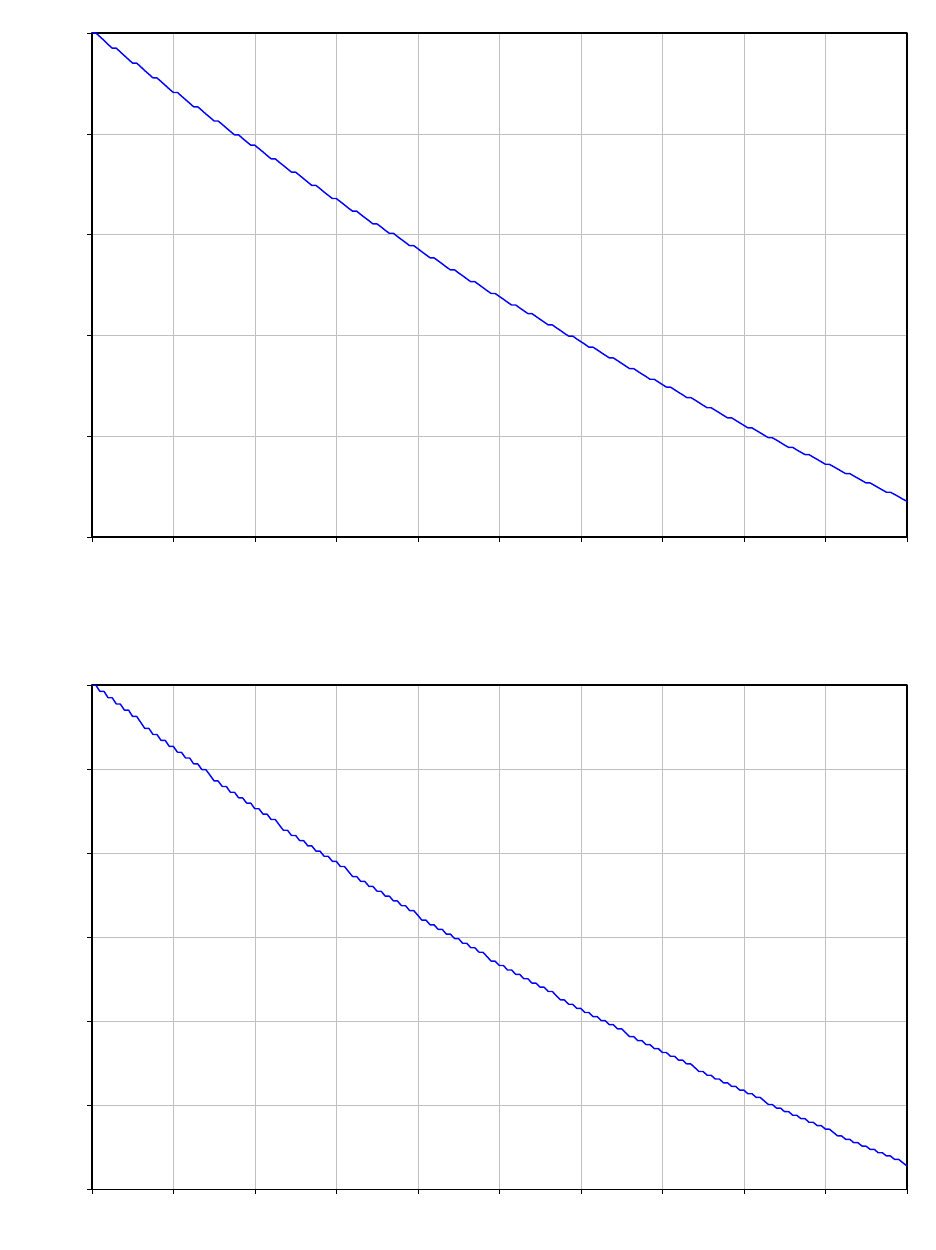
Chapter 3: System planning Data throughput capacity tables
Figure 60
Range adjustment for PTP 650, symmetry 1:1, optimization IP, bandwidth 30 MHz
Figure 61
Range adjustment for PTP 650, symmetry 1:1, optimization IP, bandwidth 20 MHz
0.75
0.80
0.85
0.90
0.95
1.00
020 40 60 80 100 120 140 160 180 200
Range factor
Range (km)
0.70
0.75
0.80
0.85
0.90
0.95
1.00
020 40 60 80 100 120 140 160 180 200
Range factor
Range (km)
UNDER DEVELOPMENT
Page 3-97
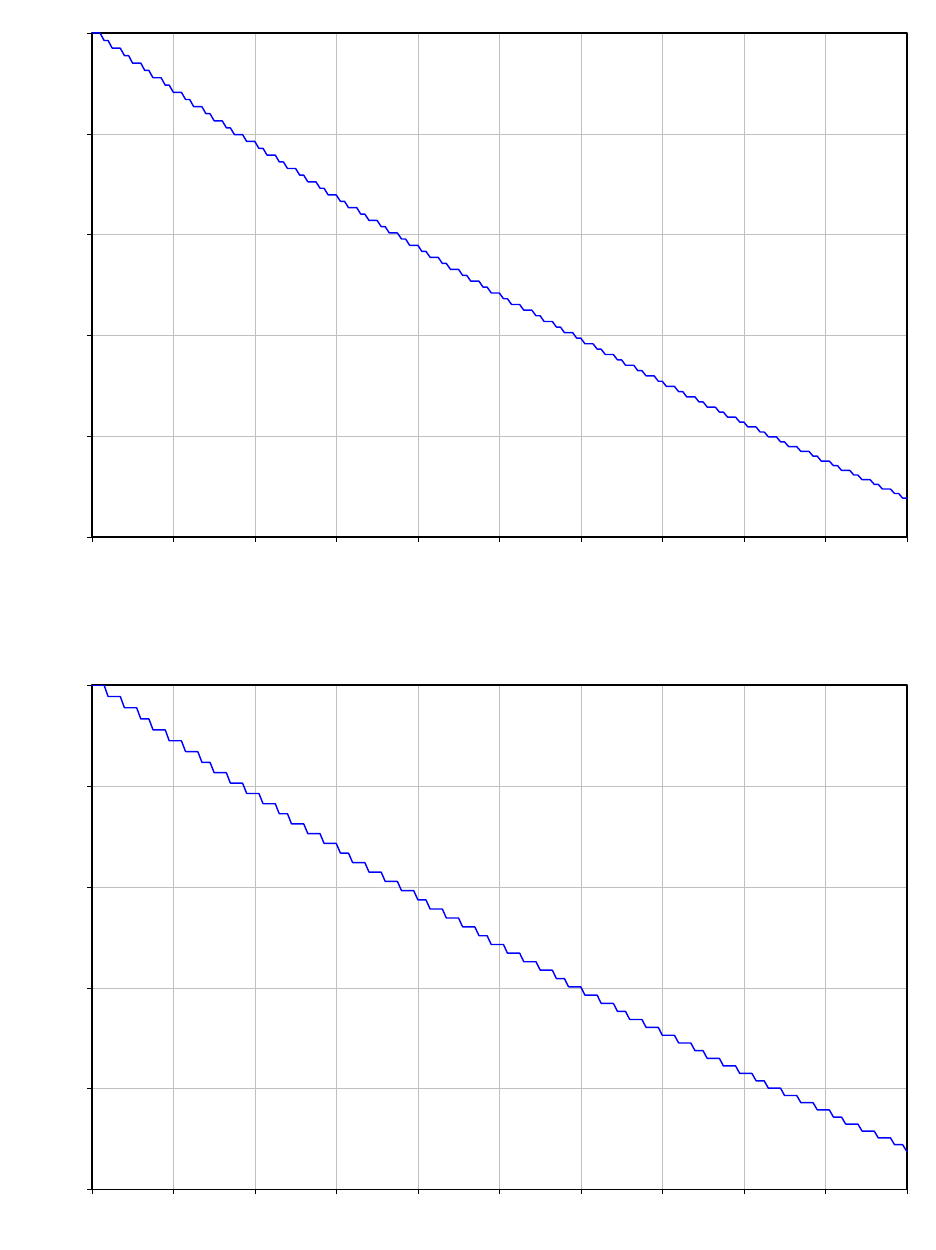
Chapter 3: System planning Data throughput capacity tables
Figure 62
Range adjustment for PTP 650, symmetry 1:1, optimization IP, bandwidth 15 MHz
Figure 63
Range adjustment for PTP 650, symmetry 1:1, optimization IP, bandwidth 10 MHz
0.75
0.80
0.85
0.90
0.95
1.00
020 40 60 80 100 120 140 160 180 200
Range factor
Range (km)
0.75
0.80
0.85
0.90
0.95
1.00
020 40 60 80 100 120 140 160 180 200
Range factor
Range (km)
UNDER DEVELOPMENT
Page 3-98
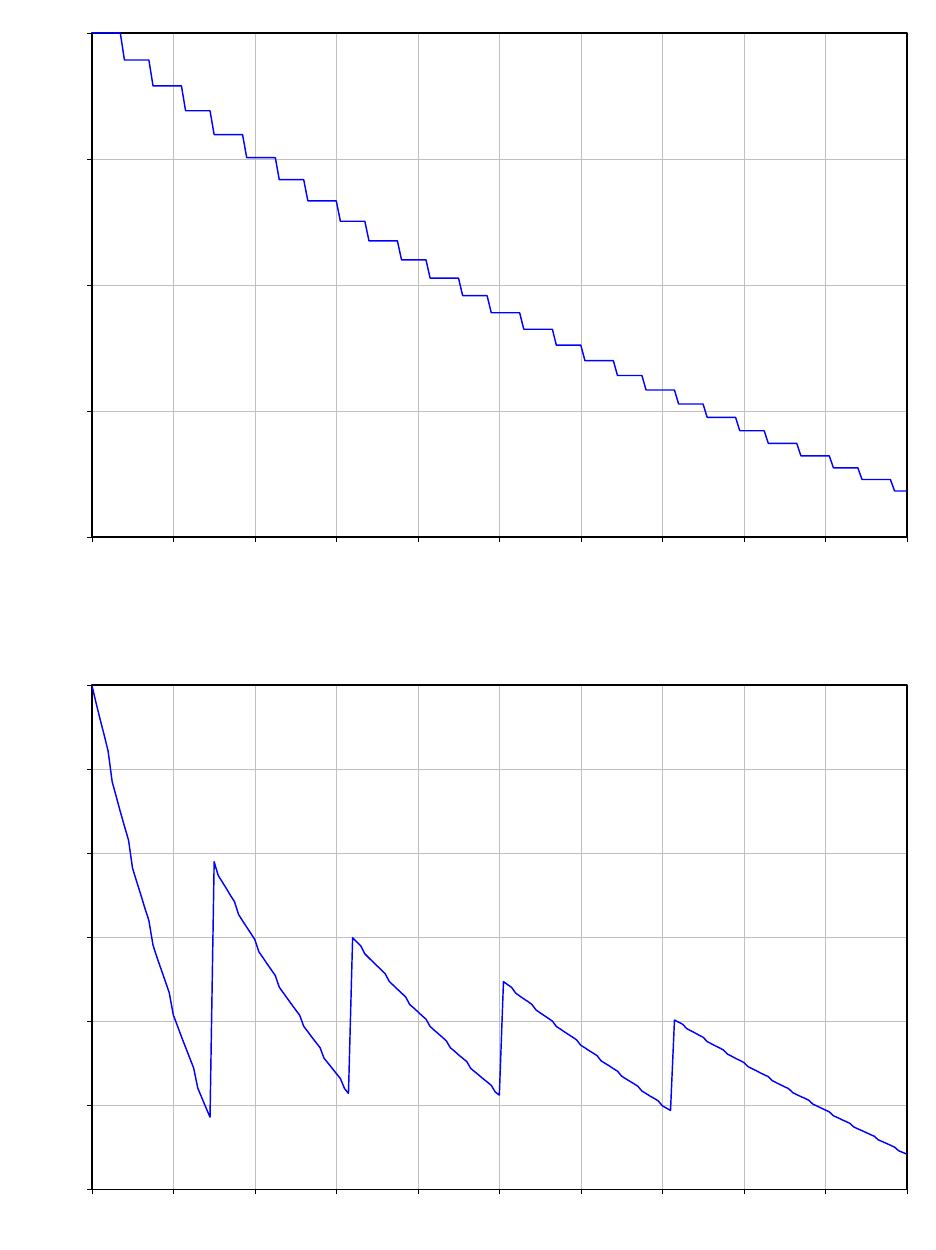
Chapter 3: System planning Data throughput capacity tables
Figure 64
Range adjustment for PTP 650, symmetry 1:1, optimization IP, bandwidth 5 MHz
Figure 65
Range adjustment for PTP 650, symmetry 1:1, optimization TDM, bandwidth 45 MHz
0.60
0.70
0.80
0.90
1.00
020 40 60 80 100 120 140 160 180 200
Range factor
Range (km)
0.70
0.75
0.80
0.85
0.90
0.95
1.00
020 40 60 80 100 120 140 160 180 200
Range factor
Range (km)
UNDER DEVELOPMENT
Page 3-99
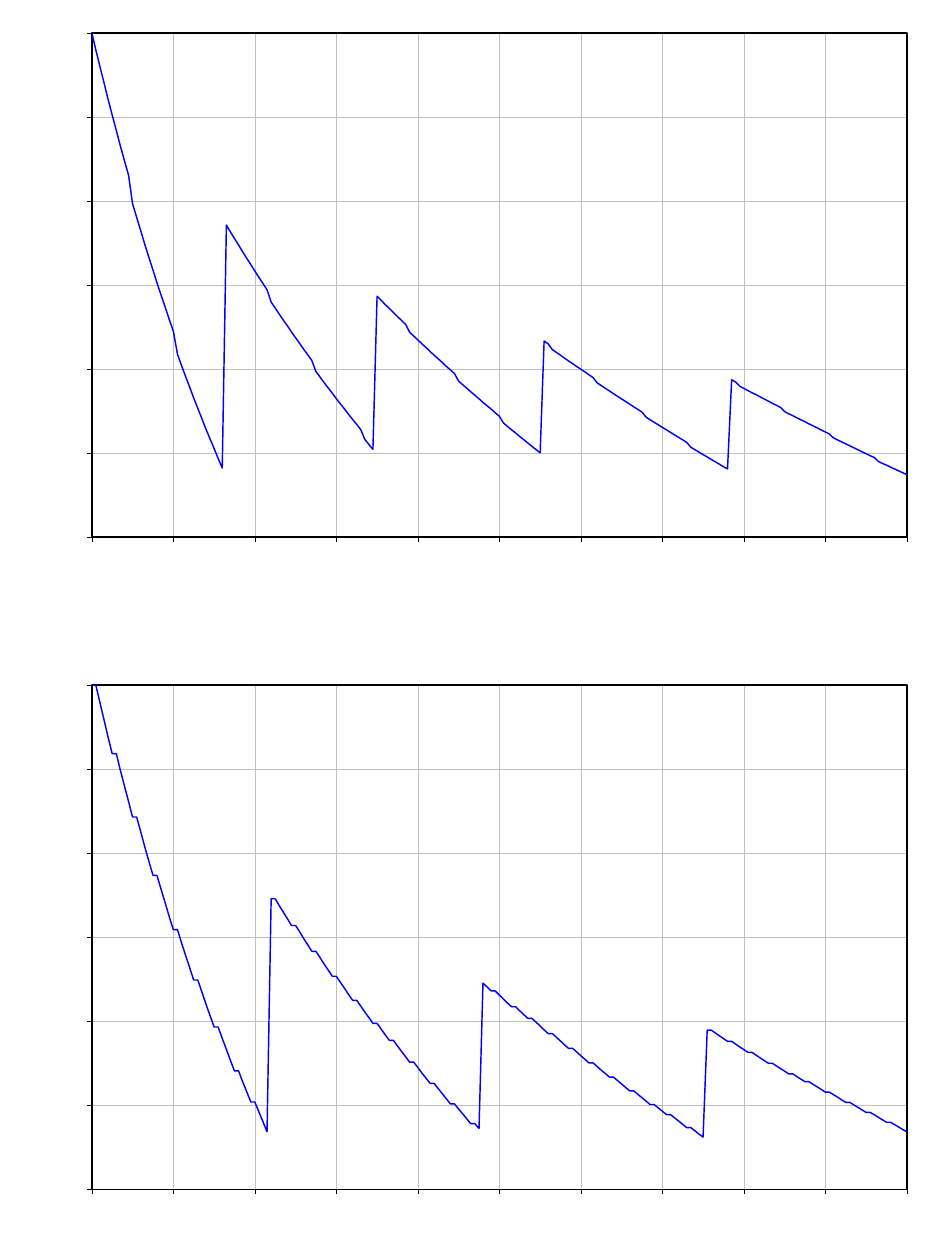
Chapter 3: System planning Data throughput capacity tables
Figure 66
Range adjustment for PTP 650, symmetry 1:1, optimization TDM, bandwidth 40 MHz
Figure 67
Range adjustment for PTP 650, symmetry 1:1, optimization TDM, bandwidth 30 MHz
0.70
0.75
0.80
0.85
0.90
0.95
1.00
020 40 60 80 100 120 140 160 180 200
Range factor
Range (km)
0.70
0.75
0.80
0.85
0.90
0.95
1.00
020 40 60 80 100 120 140 160 180 200
Range factor
Range (km)
UNDER DEVELOPMENT
Page 3-100
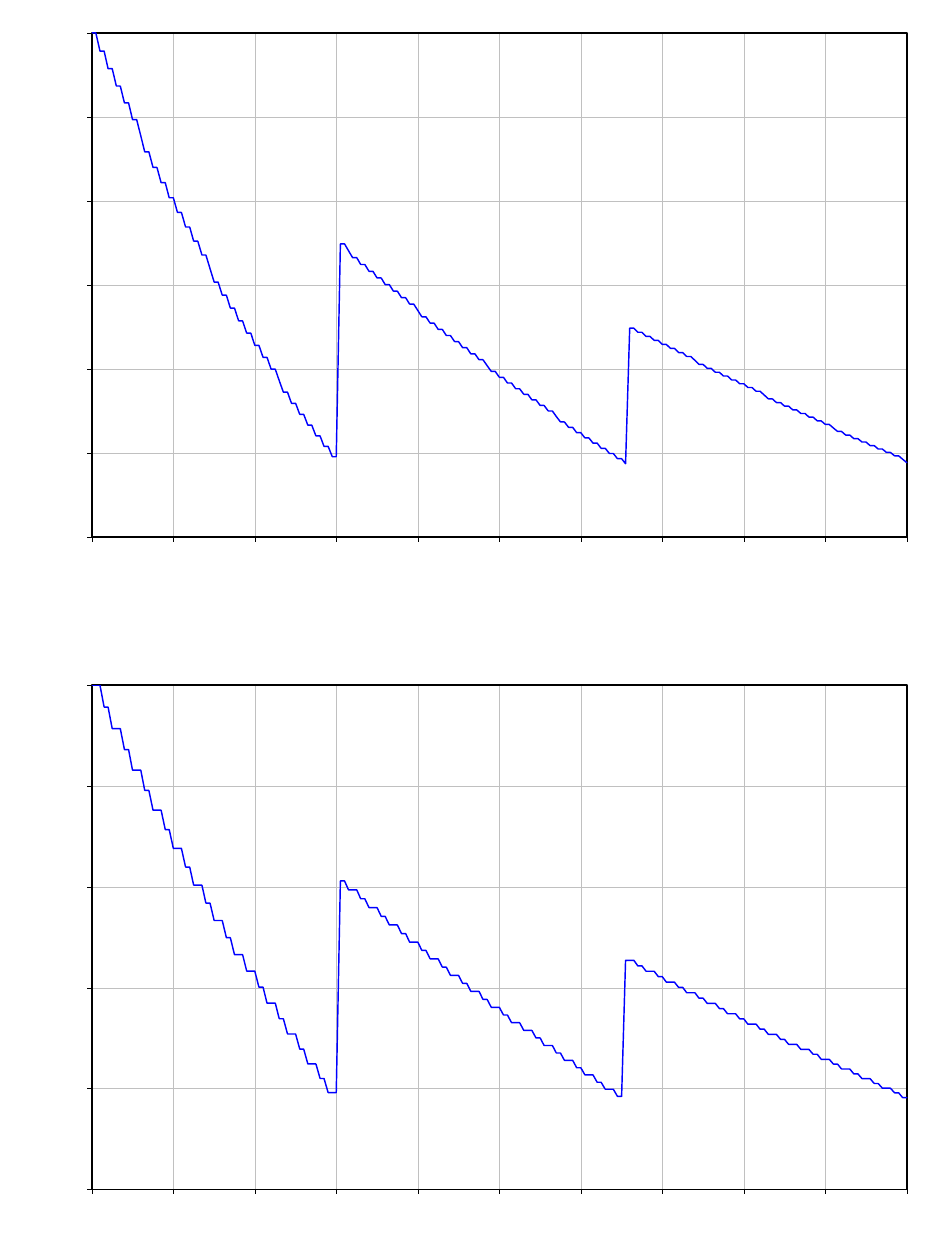
Chapter 3: System planning Data throughput capacity tables
Figure 68
Range adjustment for PTP 650, symmetry 1:1, optimization TDM, bandwidth 20 MHz
Figure 69
Range adjustment for PTP 650, symmetry 1:1, optimization TDM, bandwidth 15 MHz
0.70
0.75
0.80
0.85
0.90
0.95
1.00
020 40 60 80 100 120 140 160 180 200
Range factor
Range (km)
0.75
0.80
0.85
0.90
0.95
1.00
020 40 60 80 100 120 140 160 180 200
Range factor
Range (km)
UNDER DEVELOPMENT
Page 3-101
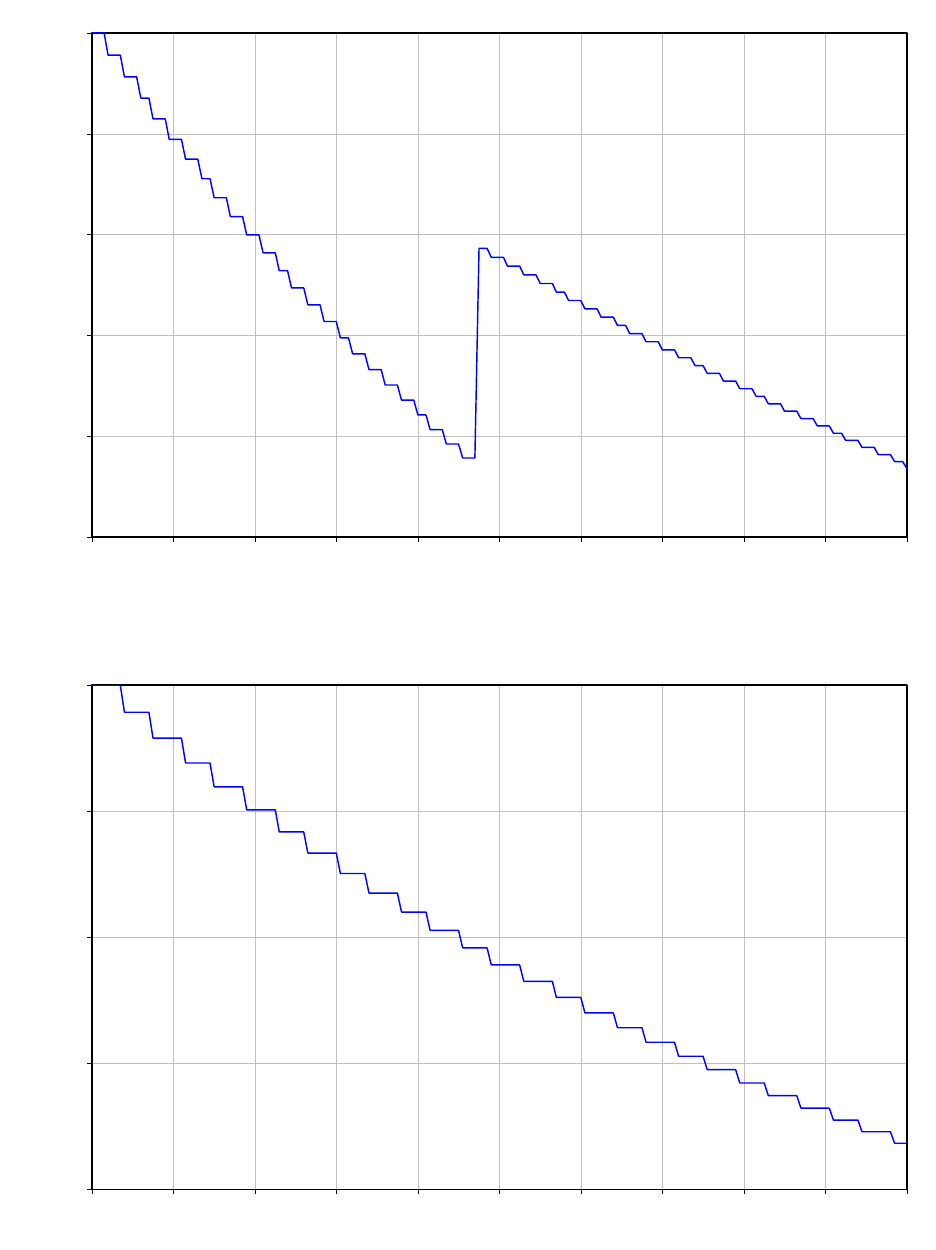
Chapter 3: System planning Data throughput capacity tables
Figure 70
Range adjustment for PTP 650, symmetry 1:1, optimization TDM, bandwidth 10 MHz
Figure 71
Range adjustment for PTP 650, symmetry 1:1, optimization TDM, bandwidth 5 MHz
0.75
0.80
0.85
0.90
0.95
1.00
020 40 60 80 100 120 140 160 180 200
Range factor
Range (km)
0.60
0.70
0.80
0.90
1.00
020 40 60 80 100 120 140 160 180 200
Range factor
Range (km)
UNDER DEVELOPMENT
Page 3-102

Chapter 3: System planning Data throughput capacity tables
Figure 72
Range adjustment for PTP 650, symmetry 2:1, optimization IP, bandwidth 45 MHz
Figure 73
Range adjustment for PTP 650, symmetry 2:1, optimization IP, bandwidth 40 MHz
0.80
0.85
0.90
0.95
1.00
020 40 60 80 100 120 140 160 180 200
Range factor
Range (km)
0.80
0.85
0.90
0.95
1.00
020 40 60 80 100 120 140 160 180 200
Range factor
Range (km)
UNDER DEVELOPMENT
Page 3-103
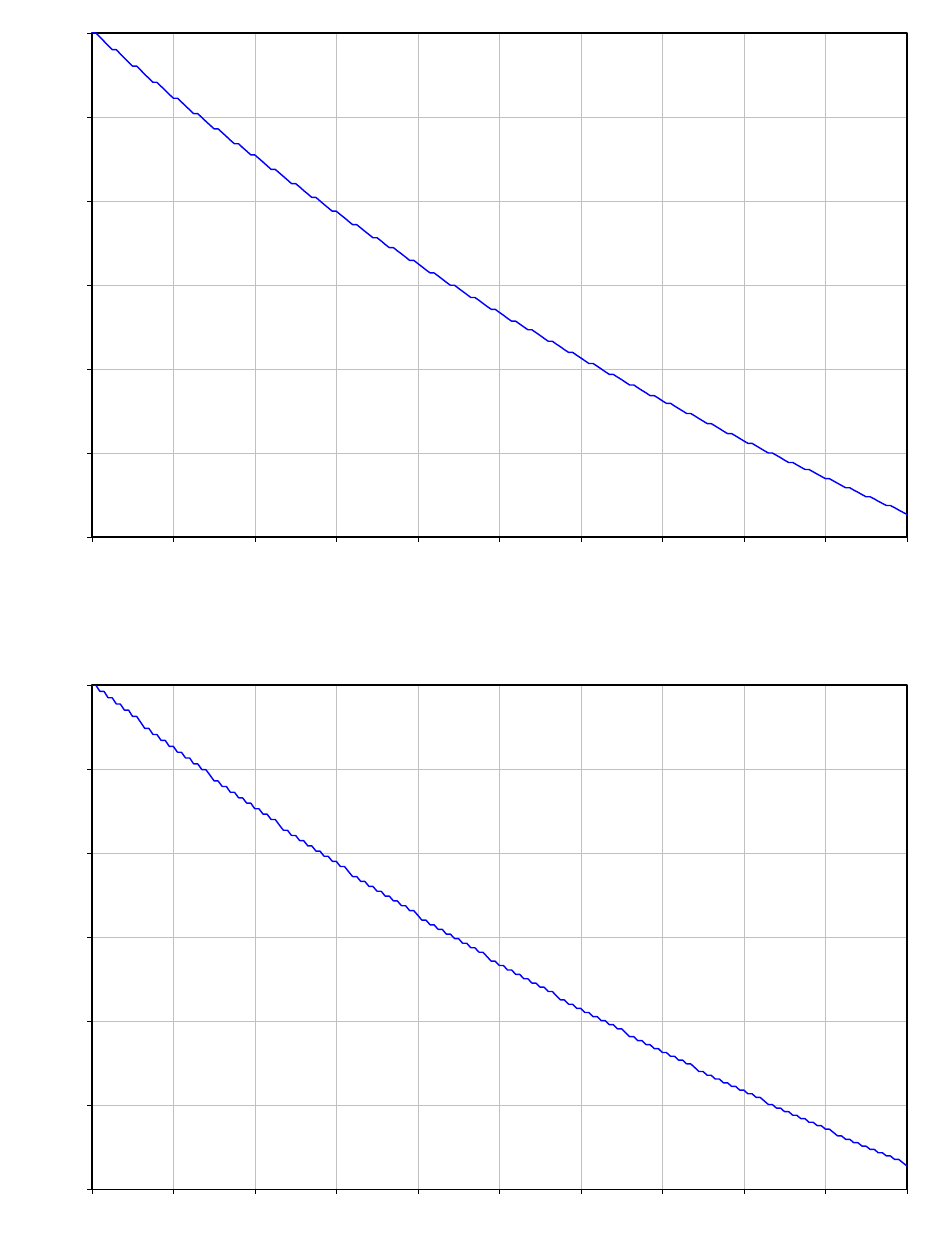
Chapter 3: System planning Data throughput capacity tables
Figure 74
Range adjustment for PTP 650, symmetry 2:1, optimization IP, bandwidth 30 MHz
Figure 75
Range adjustment for PTP 650, symmetry 2:1, optimization IP, bandwidth 20 MHz
0.70
0.75
0.80
0.85
0.90
0.95
1.00
020 40 60 80 100 120 140 160 180 200
Range factor
Range (km)
0.70
0.75
0.80
0.85
0.90
0.95
1.00
020 40 60 80 100 120 140 160 180 200
Range factor
Range (km)
UNDER DEVELOPMENT
Page 3-104
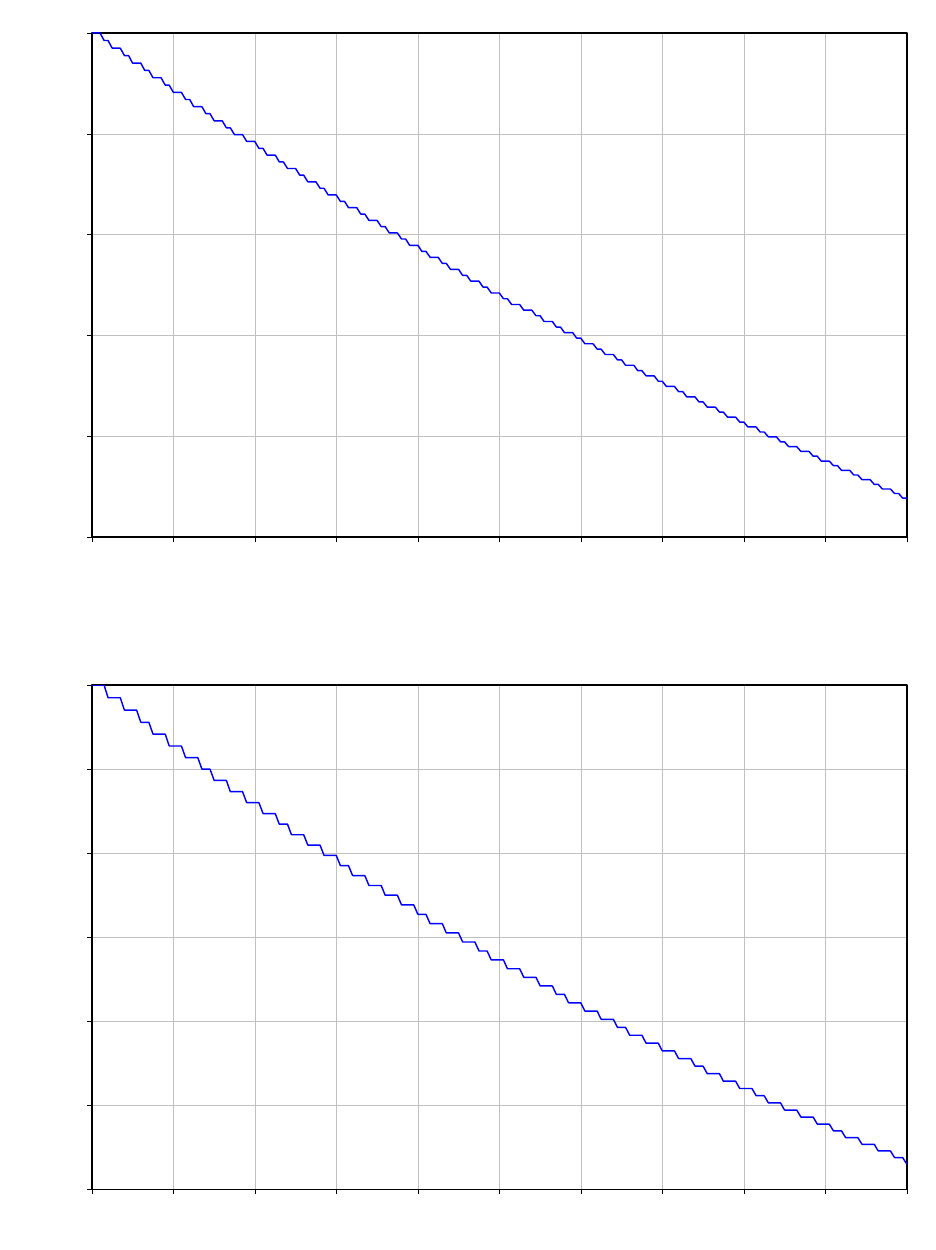
Chapter 3: System planning Data throughput capacity tables
Figure 76
Range adjustment for PTP 650, symmetry 2:1, optimization IP, bandwidth 15 MHz
Figure 77
Range adjustment for PTP 650, symmetry 2:1, optimization IP, bandwidth 10 MHz
0.75
0.80
0.85
0.90
0.95
1.00
020 40 60 80 100 120 140 160 180 200
Range factor
Range (km)
0.70
0.75
0.80
0.85
0.90
0.95
1.00
020 40 60 80 100 120 140 160 180 200
Range factor
Range (km)
UNDER DEVELOPMENT
Page 3-105
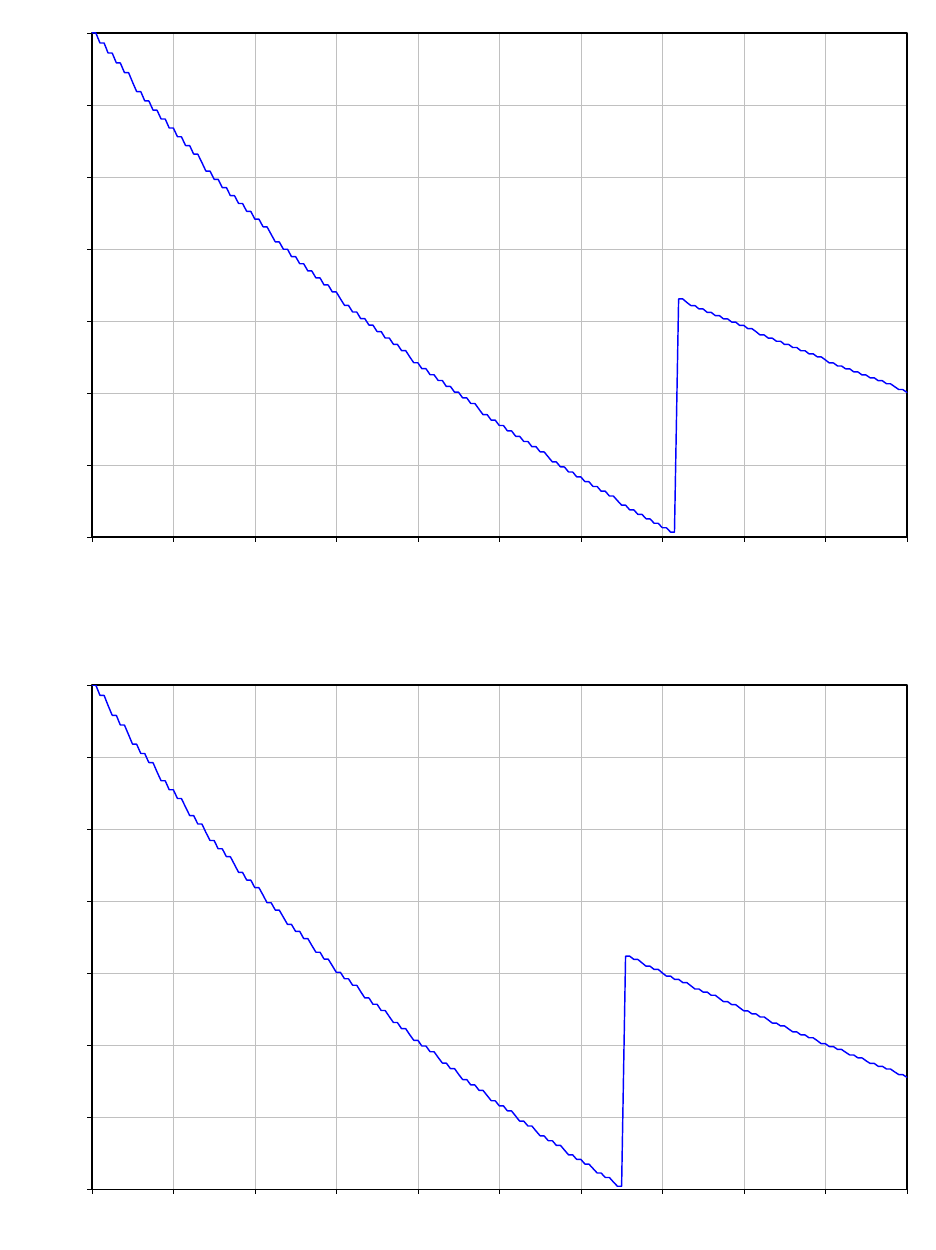
Chapter 3: System planning Data throughput capacity tables
Figure 78
Range adjustment for PTP 650, symmetry 2:1, optimization TDM, bandwidth 45 MHz
Figure 79
Range adjustment for PTP 650, symmetry 2:1, optimization TDM, bandwidth 40 MHz
0.65
0.70
0.75
0.80
0.85
0.90
0.95
1.00
020 40 60 80 100 120 140 160 180 200
Range factor
Range (km)
0.65
0.70
0.75
0.80
0.85
0.90
0.95
1.00
020 40 60 80 100 120 140 160 180 200
Range factor
Range (km)
UNDER DEVELOPMENT
Page 3-106
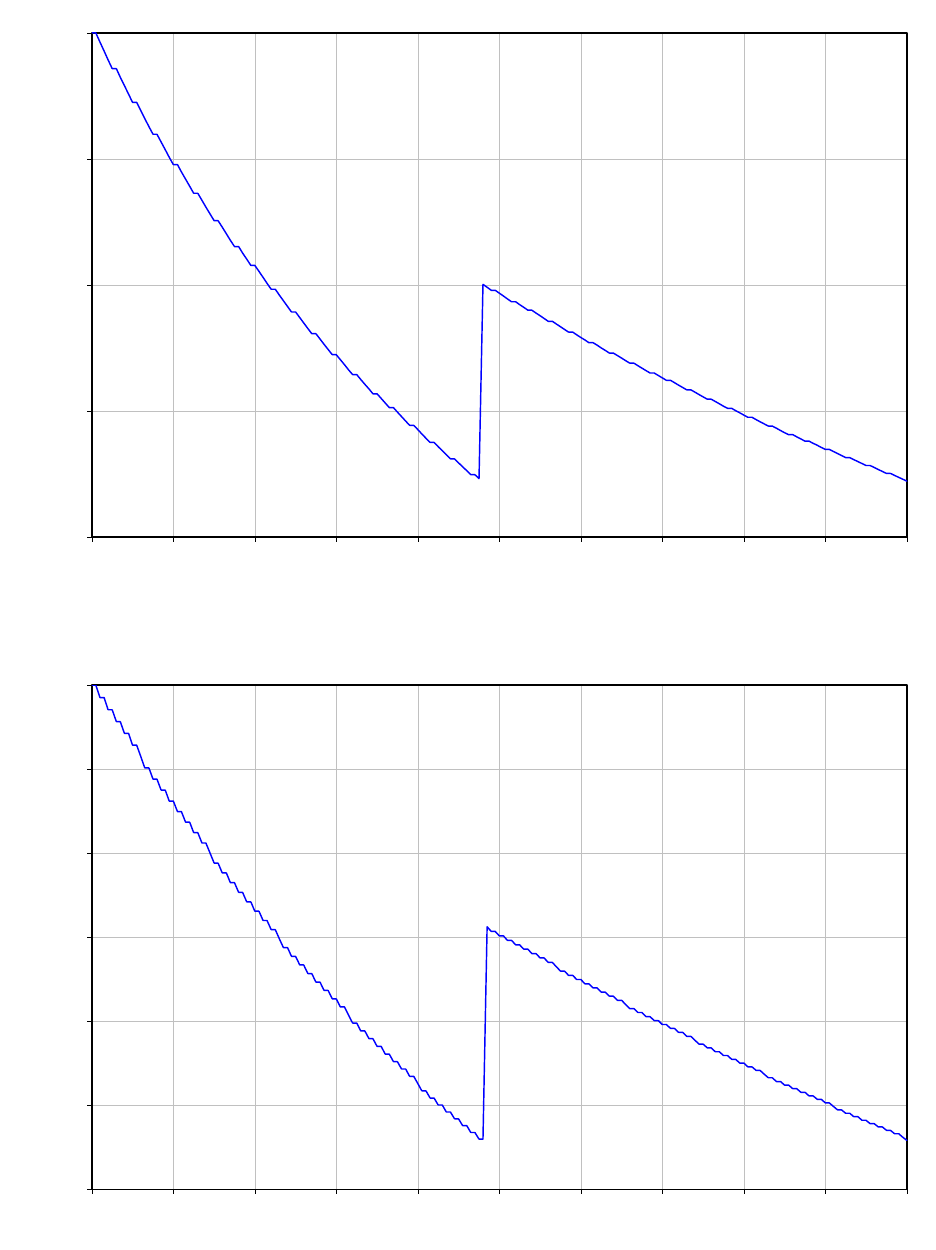
Chapter 3: System planning Data throughput capacity tables
Figure 80
Range adjustment for PTP 650, symmetry 2:1, optimization TDM, bandwidth 30 MHz
Figure 81
Range adjustment for PTP 650, symmetry 2:1, optimization TDM, bandwidth 20 MHz
0.60
0.70
0.80
0.90
1.00
020 40 60 80 100 120 140 160 180 200
Range factor
Range (km)
0.70
0.75
0.80
0.85
0.90
0.95
1.00
020 40 60 80 100 120 140 160 180 200
Range factor
Range (km)
UNDER DEVELOPMENT
Page 3-107
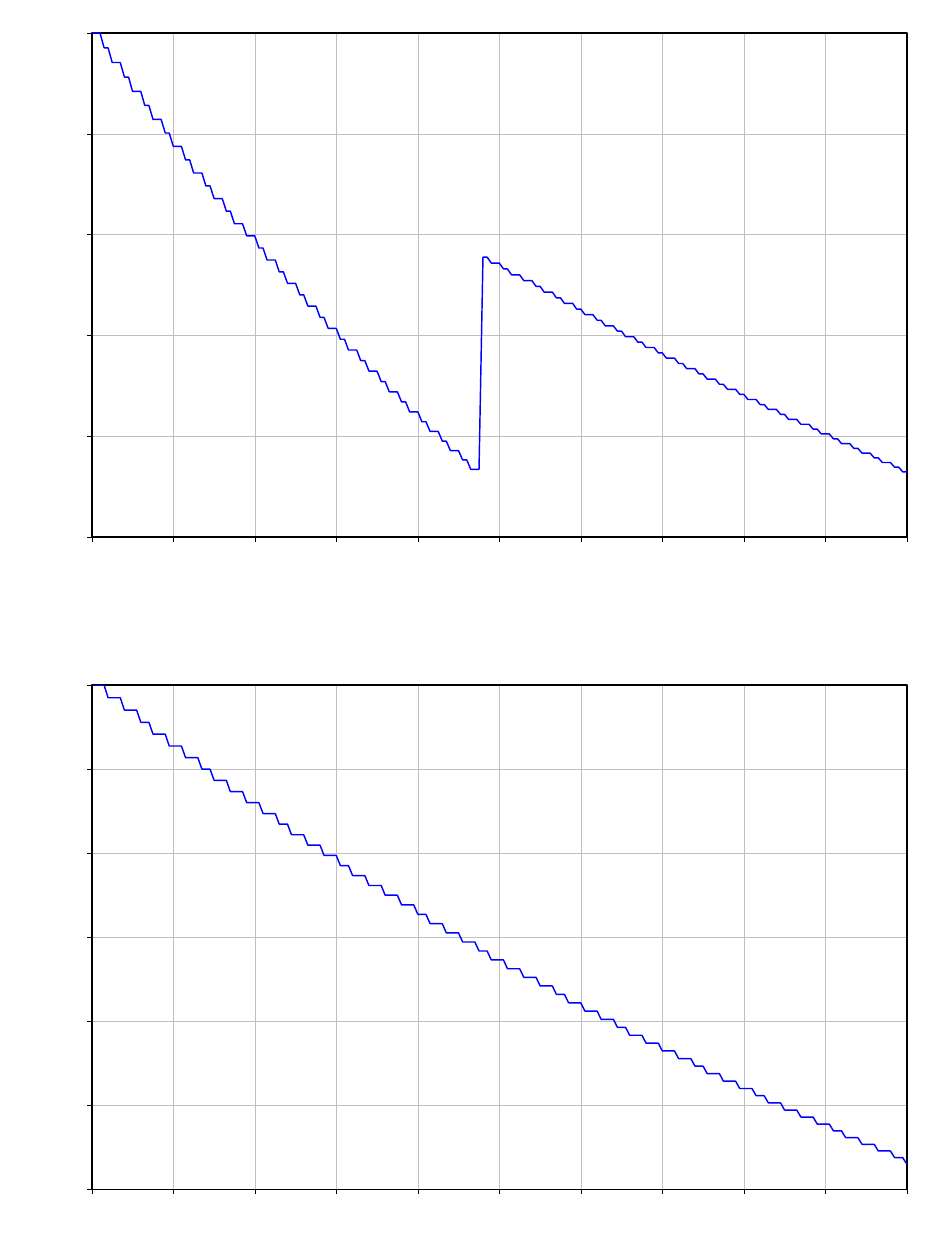
Chapter 3: System planning Data throughput capacity tables
Figure 82
Range adjustment for PTP 650, symmetry 2:1, optimization TDM, bandwidth 15 MHz
Figure 83
Range adjustment for PTP 650, symmetry 2:1, optimization TDM, bandwidth 10 MHz
0.75
0.80
0.85
0.90
0.95
1.00
020 40 60 80 100 120 140 160 180 200
Range factor
Range (km)
0.70
0.75
0.80
0.85
0.90
0.95
1.00
020 40 60 80 100 120 140 160 180 200
Range factor
Range (km)
UNDER DEVELOPMENT
Page 3-108
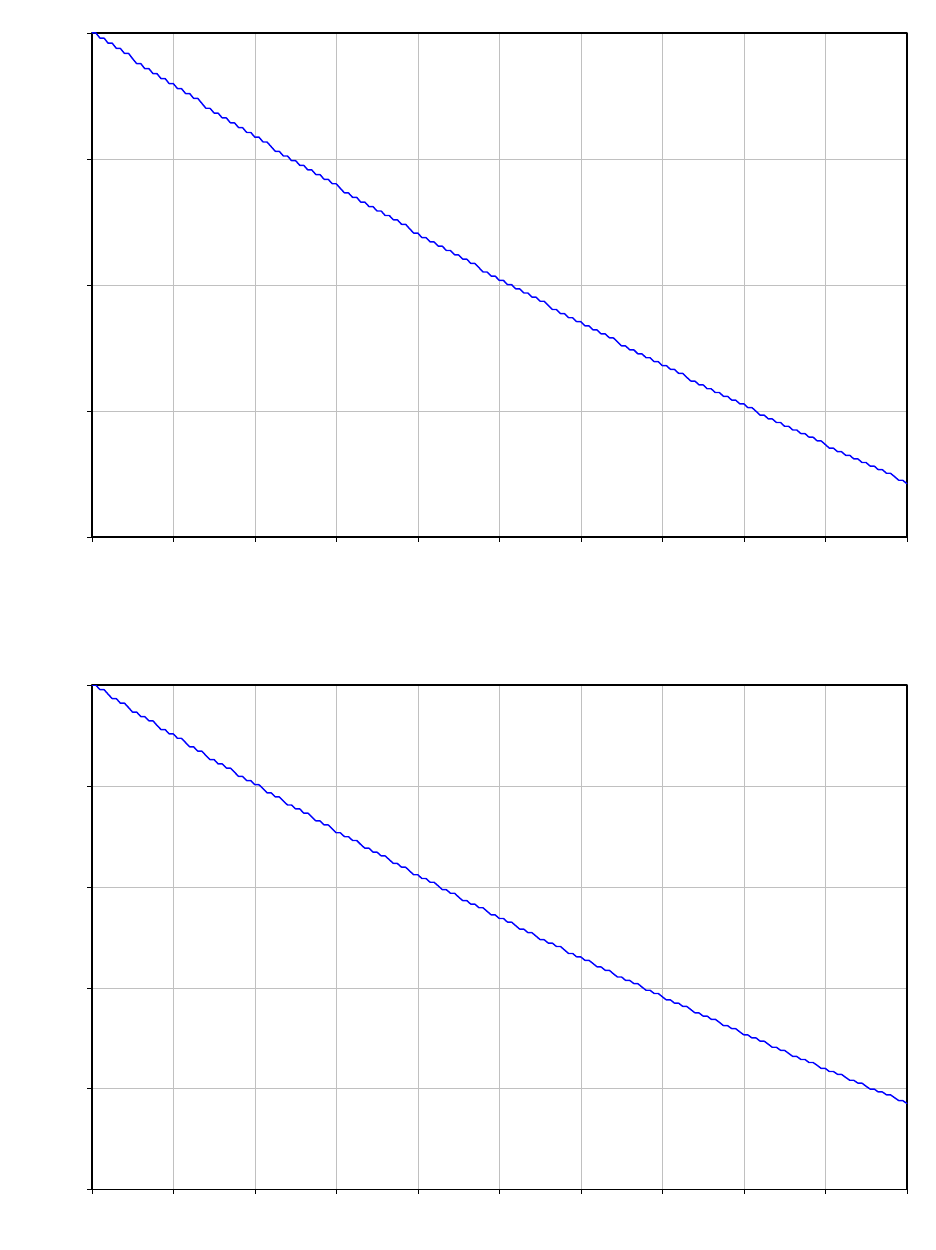
Chapter 3: System planning Data throughput capacity tables
Figure 84
Range adjustment for PTP 650, adaptive, optimization IP, bandwidth 45 MHz
Figure 85
Range adjustment for PTP 650, adaptive, optimization IP, bandwidth 40 MHz
0.80
0.85
0.90
0.95
1.00
020 40 60 80 100 120 140 160 180 200
Range factor
Range (km)
0.75
0.80
0.85
0.90
0.95
1.00
020 40 60 80 100 120 140 160 180 200
Range factor
Range (km)
UNDER DEVELOPMENT
Page 3-109
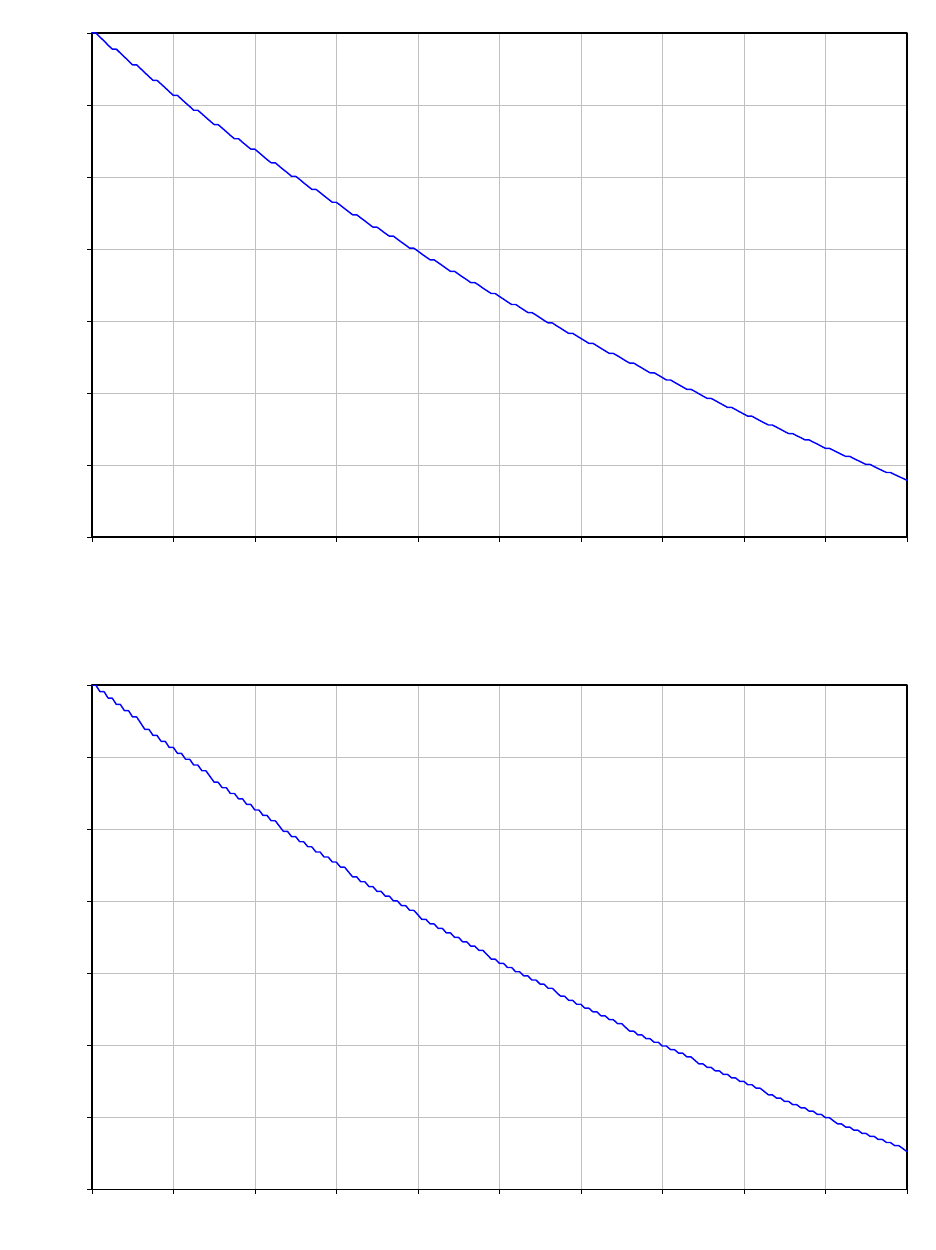
Chapter 3: System planning Data throughput capacity tables
Figure 86
Range adjustment for PTP 650, adaptive, optimization IP, bandwidth 30 MHz
Figure 87
Range adjustment for PTP 650, adaptive, optimization IP, bandwidth 20 MHz
0.65
0.70
0.75
0.80
0.85
0.90
0.95
1.00
020 40 60 80 100 120 140 160 180 200
Range factor
Range (km)
0.65
0.70
0.75
0.80
0.85
0.90
0.95
1.00
020 40 60 80 100 120 140 160 180 200
Range factor
Range (km)
UNDER DEVELOPMENT
Page 3-110
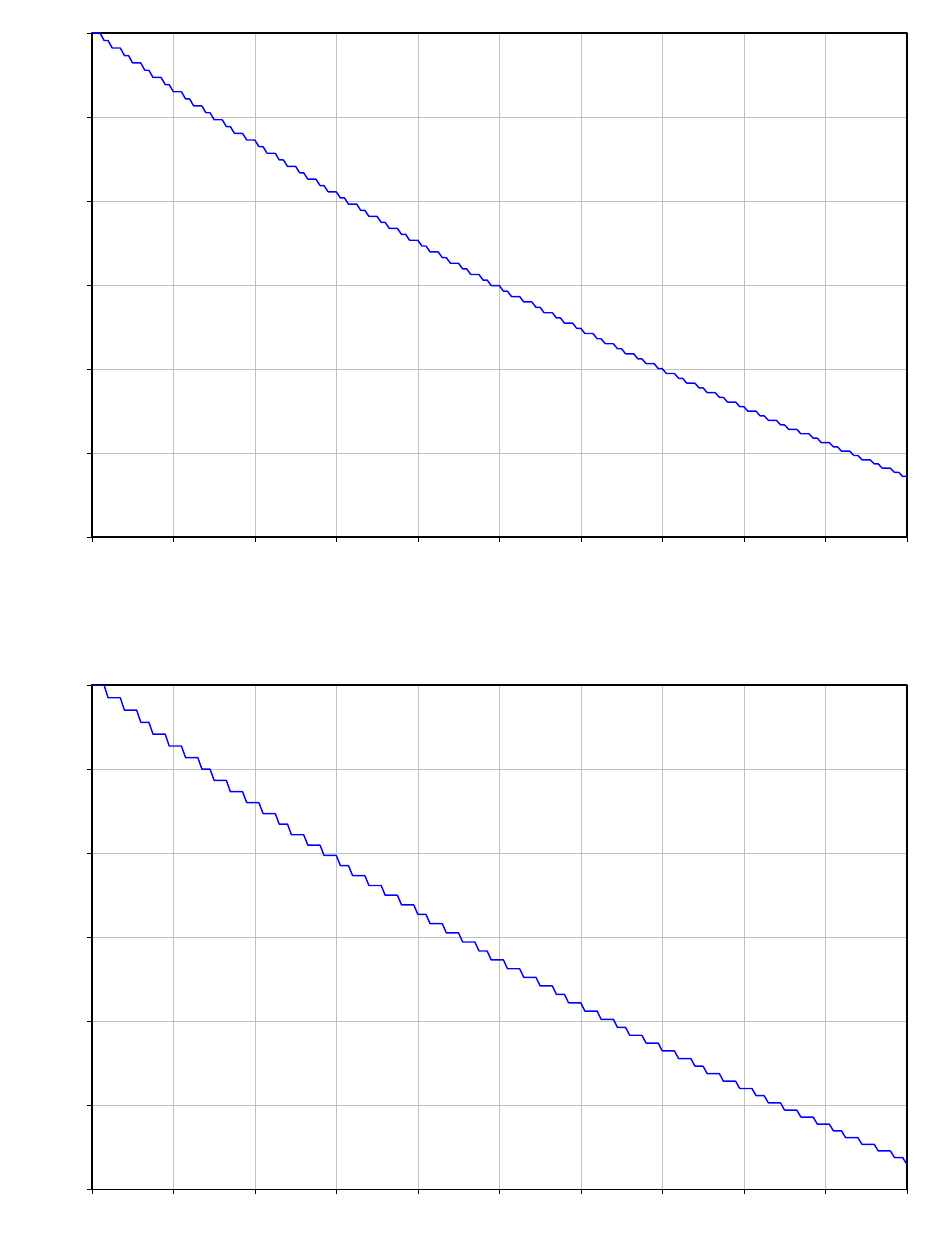
Chapter 3: System planning Data throughput capacity tables
Figure 88
Range adjustment for PTP 650, adaptive, optimization IP, bandwidth 15 MHz
Figure 89
Range adjustment for PTP 650, adaptive, optimization IP, bandwidth 10 MHz
0.70
0.75
0.80
0.85
0.90
0.95
1.00
020 40 60 80 100 120 140 160 180 200
Range factor
Range (km)
0.70
0.75
0.80
0.85
0.90
0.95
1.00
020 40 60 80 100 120 140 160 180 200
Range factor
Range (km)
UNDER DEVELOPMENT
Page 3-111

Chapter 3: System planning Data throughput capacity tables
TDM traffic load
Encapsulated data
The NIDU supports separate management and TDM data protocol interfaces. The management
interface is between the NIDU and a directly-connected ODU. The TDM data interface is between
peer NIDUs. The ODU does not interact with the TDM data protocol, except in as much as it
provides a separate high priority queue for encapsulated TDM data at the wireless interface.
The resulting traffic load for encapsulated TDM data is shown in Table 99.
Table 99
TDM traffic load
Channels
Octets per Ethernet frame
E1 data rate (Mbit/s)
T1 data rate (Mbit/s)
1 90 2.940 2.217
2 157 5.145 3.879
3 224 7.414 5.590
4 291 9.619 7.252
5 358 11.824 8.915
6 425 14.030 10.577
7 492 16.235 12.239
8 559 18.440 13.902
In the best case (eight channels) the encapsulation has an efficiency of 91.6%.
Timing only
The resulting TDM traffic load in timing-only operation is shown in Table 100.
Table 100
TDM traffic load in timing-only
Channels
Octets per Ethernet frame
E1 data rate (Mbit/s)
T1 data rate (Mbit/s)
1 64 0.512 0.386
2 64 0.512 0.386
3 64 0.512 0.386
4 64 0.512 0.386
5 64 0.512 0.386
6 64 0.512 0.386
7 65 0.520 0.392
8 71 0.568 0.428
UNDER DEVELOPMENT
Page 3-112
